

All Destinations , Asia , China , Overland Itineraries , Plan Your Trip
One month in china itinerary for first timers.
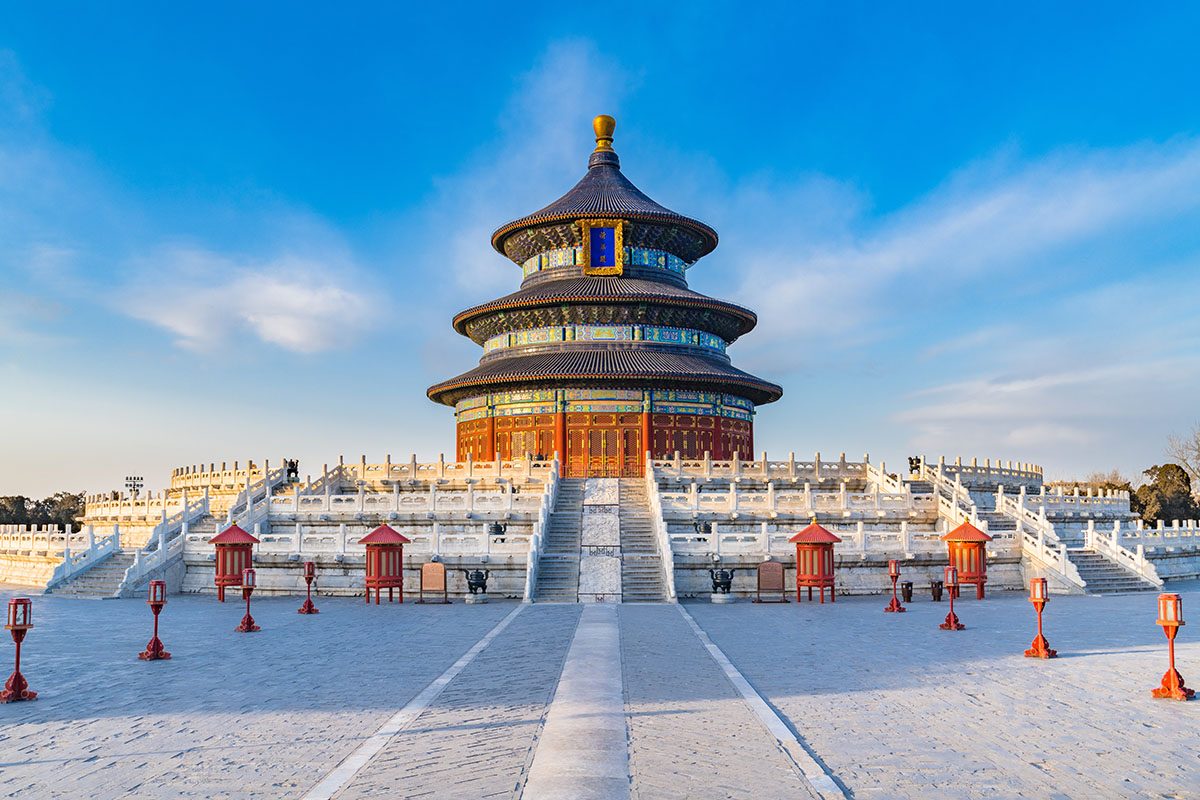
If you’re reading this China itinerary, I’m guessing you’re planning a trip to the country. China is one of my favourite countries to travel in. It’s brimming with history and culture, from the Terrcotta Warriors to its many, many temples, but it has the most dynamic modern scene in cities like Shanghai and Guangzhou. It has desert, beaches and mountains (lots of the latter!), as well as some of the most impressive megacities you’ll likely ever see. I’ve been to China four times now, so I know a thing or two about planning a China itinerary.
Planning Your China Itinerary
First up, don’t feel overwhelmed.
On my first time in China, I landed in Beijing with no guidebook, no phrasebook and I only knew how to say ‘ this is my foot’ , ‘ you are very beautiful ‘ and ‘ make me a cup of tea ‘ in Mandarin.
These phrases are probably only useful to a flirty shoe model with a caffeine addiction and didn’t help me at all when I was navigating the airport, buying a subway ticket and finding my way to my hostel. But I still made it, not only to my hostel but travelling around for two whole months.
I am lucky to have family from China – my stepmum was born here, and I did spend some of my first two months in China with her and her family (although I arrived alone).
I have had some help in that regard, but I’m going to pass on all that I’ve learnt about travel in China from my family in this post and others.
You don’t have to know Mandarin to spend 1 month in China, but I do recommend some forward planning.
First thing first – get your Chinese visa sorted. It’s a bit of a complicated process, but you can check out this handy guide on how to get a Chinese visa for some great pointers.
The second step is to think about the best places to visit in China and work out exactly where you want to go. Luckily for you, I’ve done all the hard work! Here’s a month’s China itinerary to see the main highlights of the country, including tips for travelling to each destination.

Travelling in China Essentials

(there’s a lot of long bus rides), a rain mac (it can rain at any time of year!), a good first aid kit, a bumbag to keep all of my valuables in and a good smartphone to download some useful apps for China.
One Month in China Itinerary
This one month in China itinerary includes every place that I visited in the country on my first trip, when I was keen on seeing all of China’s highlights. I have returned and visited other places since. On my first trip I also spent a week in Liaoyuan, a non-touristy city in China, visiting family. I loved visiting and would recommend that anyone add a trip to a non-touristy city to their China itinerary, but because this post discusses the highlights, I haven’t included it. But read this post to learn about why I think everyone should visit a non touristy city in China ! This China itinerary covers the following cities:
- Beijing (and the Great Wall of China)
- Xi’an (and Huashan Mountain)
- Guilin (and the rice terraces of Longsheng)
It’s a very packed one-month itinerary for China, but it is feasible. If you have more time in China, I’d also recommend the following places that I have since visited:
- Yunnan: Travel in Yunnan takes you through a diverse landscape that shifts from dramatic snow-capped mountains to sprawling rice terraces. The province is a mosaic of ethnic cultures, with the Naxi of Lijiang and the Bai of Dali offering rich traditions and vibrant festivals. Your trip isn’t complete without visiting the Stone Forest, a natural wonder of towering limestone formations. Plan to explore the ancient town of Lijiang, a UNESCO World Heritage Site, known for its maze-like streets and canals. When hunger strikes, indulge in local flavors like “Crossing the Bridge Noodles,” a must-try dish. .
- Chongqing : a popular layover destination, Chongqing has some attractions within the city, like the old quarter and various temples, and is also the gateway to the Yangtze River.
- Guangzhou : one of China’s crazy megacities, Guangzhou has modern architecture twinned with a compelling and multicultural history.
- Hangzhou : one of China’s most beautiful cities, Hangzhou has various scenic areas arranged around a beautiful lake.
- Nanning : again, a good jumping place if you’re travelling into/ out of South East Asia (you can take a direct train from Hanoi to Nanning), Nanning is a modern city with not all that much in the way of attractions – but it’s still quite interesting to check out local life.
- Erlian : right at the border of Mongolia in the Gobi Desert, Erlian is famed for prehistoric dinosaur history and is a great place to enjoy Mongolian culture without actually crossing over. If you are crossing into Mongolia, check out my guide to Ulaanbaatar , its capital.
- Zhangjiajie : famed for being the inspiration to Avatar, Zhangjiajie has beautiful mountains and some great hiking opportunities. You can check out my YouTube video below:
Below is a sample one-month China itinerary that I have put together from my four trips to the country and conversations with my Chinese relatives.
As you can see, this itinerary covers a lot of ground in a month.
It includes a fair amount of overnight trains that you might find very tiring.
That being said, I’d recommend thinking about your own travel style.
If you need to omit some of these places, then do so.
If you’re not sure what to omit and what to include, here’s my advice: on a first trip to China, Beijing, Shanghai and Xi’an are must-see cities to understand the nation’s culture and history.
Guilin is probably the most accessible place for nature, and from there it’s an easy jumping-point to Hong Kong.
Jiuzhaigou is my favourite nature spot in China, but you do need to go to Chengdu to get there.
Zhangjiajie is stunning, and worth seeing if you’ve got time.
Hangzhou is a really special Chinese city and worth seeing to prove that cities in China can be beautiful.
Nanjing has a lot of WW2 history, a very sombre but significant message from China’s dark past.
These are all destinations that are worth visiting in their own right.
However, if you think that your one month in China itinerary will be too rushed with all these destinations, it might be worth prioritizing what you want to see.
That being said, it’s entirely possible to do this China itinerary in one month, and even have a couple of days wiggle room!
So let’s get into this one month China itinerary.
Beijing and the Great Wall – 5 days
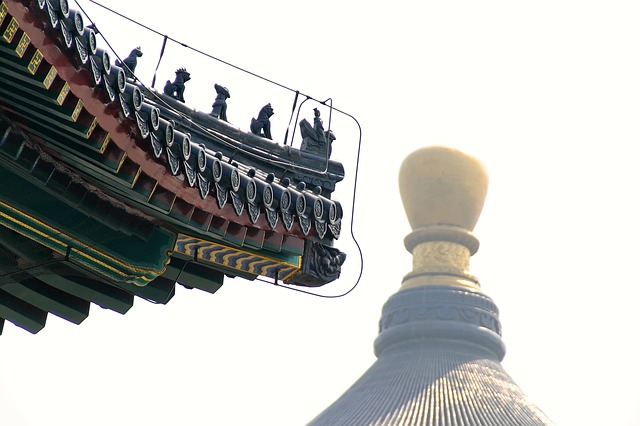
Start your China trip in its lively and chaotic capital. Beijing is perfect for China first-timers because it has all the conveniences of any large city but is still bursting with culture and history. From Beijing airport, you can take a metro all the way to the city centre, where a lot of hostels and hotels are located.
For the sake of this one month in China itinerary I’m recommending you spend three days in Beijing to see the highlights – but you could easily spend much longer. If you want to take your time to soak in the Chinese capital, 5 days in Beijing is perfect – if you want to take a more leisurely pace (which is a bit of an oxymoron in Beijing, but we’ll go with it), you could spend over a week here.
Day One: Tiananmen Square and the Forbidden City

Spend your first full day in China visiting two of its most famous attractions: Tiananmen Square and the Forbidden City.
Be amazed at the vastness of Tiananmen Square, and snap a photo of the famous gates which are looked over by a portrait of Mao Zedong.
You can even visit his Mausoleum if you arrive early enough! Then walk through to the Forbidden City, an area filled with magnificent architecture and grandeur. Spend your afternoon wandering around the National Museum of China, which will definitely inspire you to learn more about this compelling country!
Day Two: The Summer Palace and the Temple of Heaven

On day number 2 in Beijing, I’d recommend visiting the Summer Palace and the Temple of Heaven. If you thought the Forbidden City was grand, the Summer Palace will blow your mind away. Wander around this royal park and be amazed at both the enchanting pagodas and the stunning gardens. After a morning here, be transported to the equally compelling Temple of Heaven – one of the most instagrammable places in Beijing – a medieval religious site used by historic emperors. In the evening, check out the Beijing Opera – you can purchase tickets here.
Day Three: Historical and Cultural Beijing
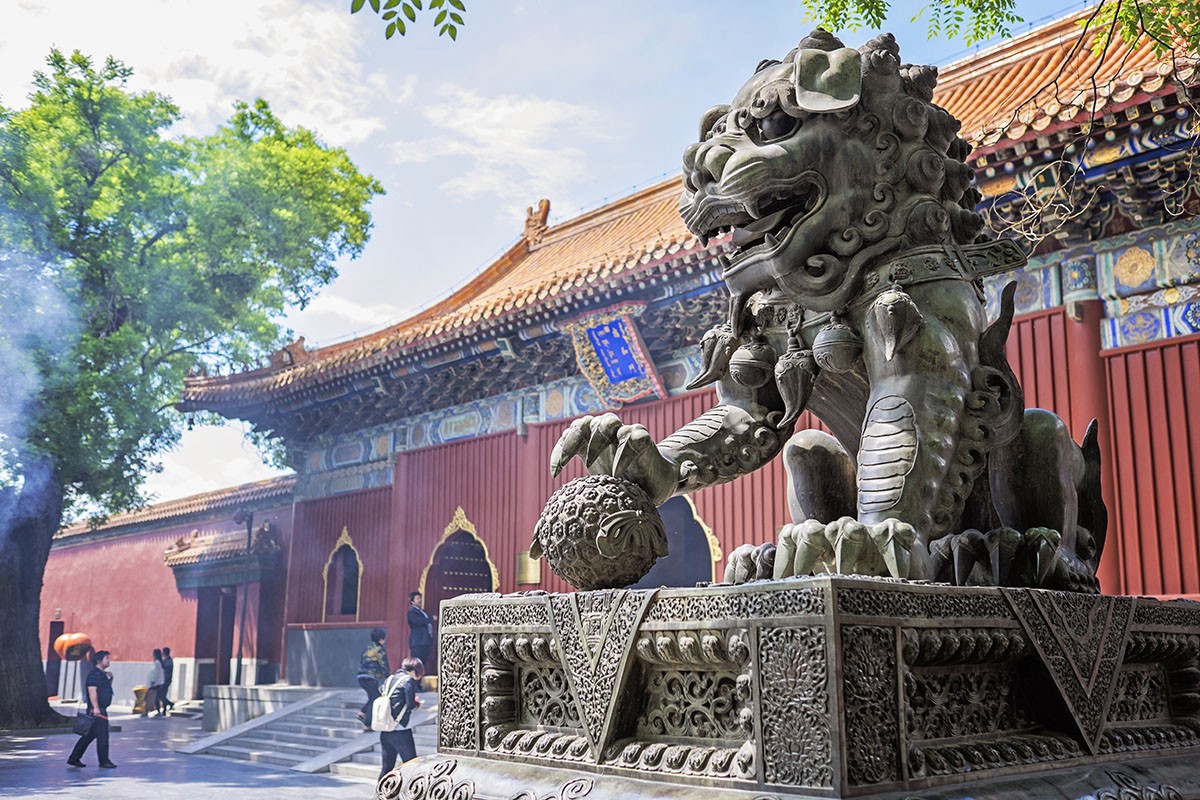
Start your day at the Silk Market, where you can see some of the finest examples of Chinese Silk – which caused all sorts of cultural connections throughout the 12th century including the establishment of the Silk Road in places like Uzbekistan and the introduction of Islam to Central Asia and Western China. It was largely down to this Chinese product that one of the best land routes was ever made. Here you can check out the silk products, and buy some for yourself if you want some souvenirs. Next, head to Lama Temple. This temple sees fewer tourists than the ones that you saw the day before, but it’s actually one of my favourites. Then you can spend the afternoon exploring Beijing’s hutongs, like Nanluoguxiang, and checking out its art scene at the 798 Art district.
I go into this itinerary in much more detail in my three days in Beijing post – check it out!
Where to Stay in Beijing
Day four and five: the great wall of china.
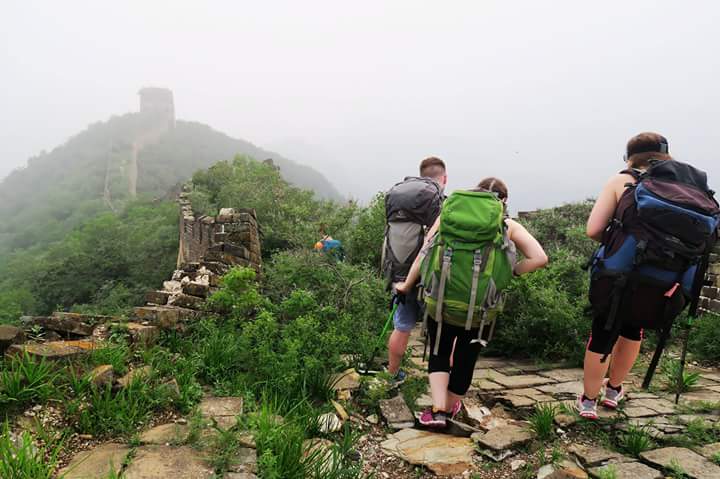
Visiting the Great Wall of China is a must on anyone’s Chinese wish list. But camping on the Great Wall is even more compelling, right? Take an overnight camping tour with China Hiking to Jiankou, a completely unrestored section of the Great Wall. Relish in the serenity that comes with being at such a quiet area of this wall, and enjoy the architectural marvel that so many people associate with this Asian country.
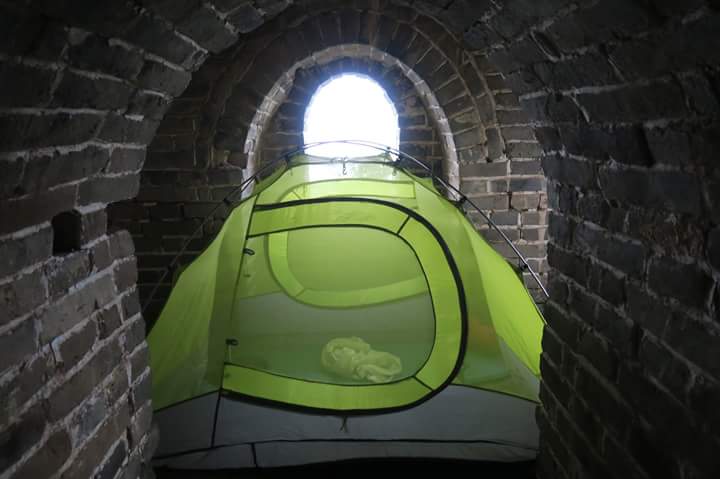
You will camp overnight on the Great Wall, and a transfer back to Beijing will be organized in the morning. Spend the rest of the day visiting some spots you’ve missed out, or just chilling out ready for your overnight train to Xi’an. Take an overnight train from Beijing – Xi’an. I’d definitely advise booking trains in advance for your first time in China – it is very daunting to try to negotiate buying tickets with no Chinese and they often sell out. Use this link to see the latest deals .
Xi’an – 3 days
Xi’an is probably my favourite Chinese city – I love the merge of cultures, the delicious street food, and the fairly compact layout of it all. It’s steeped in history – it’s one of the four ancient capitals of China, after all – and most of your China itinerary here will be spent exploring the stories that the city has to offer. Of course, there’s a trip out the city to see the world-famous Terracotta Warriors, and a day trip to Huashan Mountain as well.
Day Six: Xi’an City
Once upon a time all cities in China were walled. Xi’an is one of few cities whose walls have not been abolished and can be explored at your own leisure.
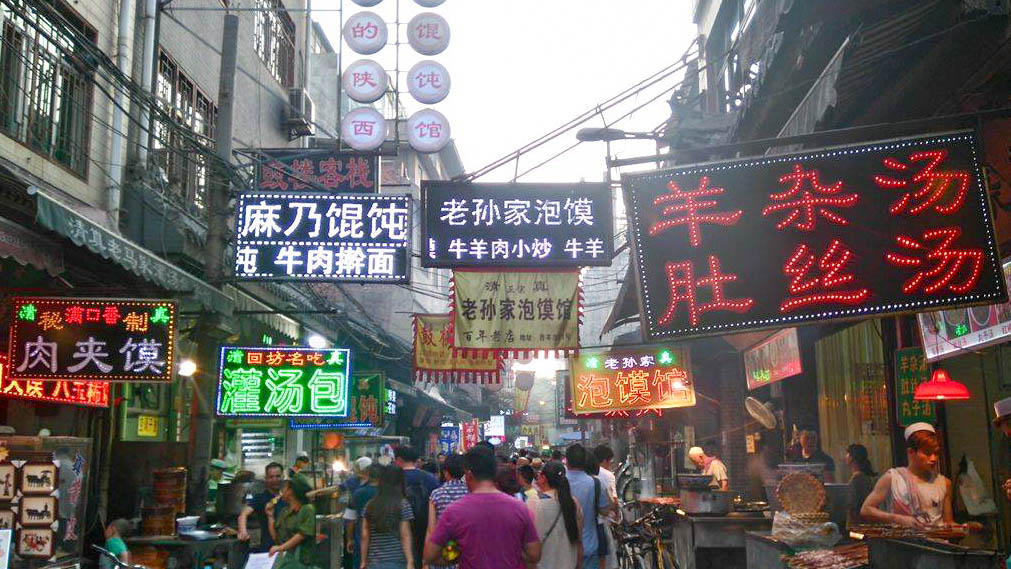
Spend the morning on top of these walls, either walking along them or exploring the walls by bike (they can be rented from the top of the walls), before descending into the city’s Muslim Quarter. Here you can enjoy the delicious and cheap street food and walk around Xi’an’s Great Mosque.
Day Seven: The Terracotta Warriors

On day two, take a transfer to the Terracotta Warriors, an ancient selection of soldiers that were made with the intention to protect an emperor after his death. The ensemble of figures is an amazing feat – be sure to snap lots of pictures before leaving! Spend the afternoon wandering around the Wild Goose Pagoda, an ancient building from the Tang Dynasty.
Day Eight: Huashan Mountain

For you last day in Xi’an, take an early transfer to Huashan Mountain, a sacred Daoist mountain (and thought by some to be the most dangerous mountain in China!). The path around it can be easily navigated and it offers some spectacular views. But be sure to descend to catch the last bus back to Xi’an that night at 7pm! Read my full guide on a day trip to Huashan Mountain and my thoughts on its safety here .
Where to Stay in Xi’an
Overnight train from Xi’an to Chengdu – use this link to see the latest deals .
Chengdu – 2 days
Day eleven: chengdu panda base.
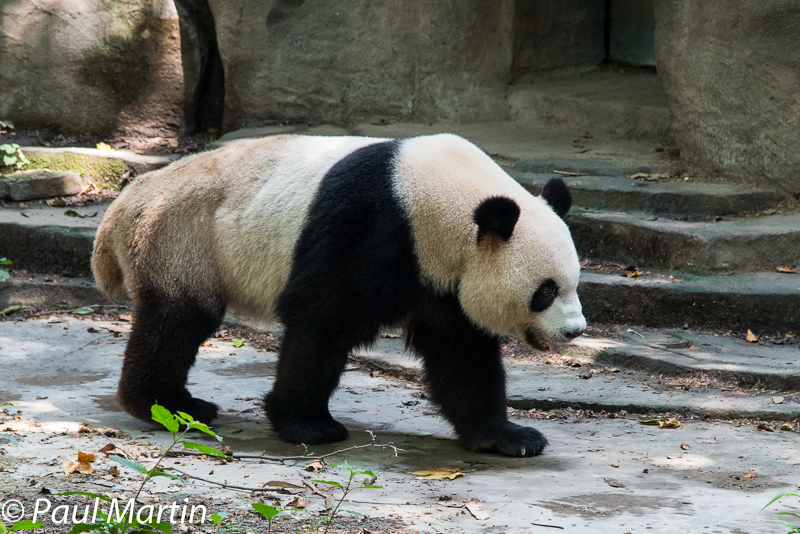
Day Twelve: Leshan Giant Buddha
The next day, you could visit the world’s largest Buddha at Leshan, which is 2 hours away. Spend the day exploring the scenic area and the many Buddhas it contains, as well as marvelling at the Big Buddha itself.
Where to Stay in Chengdu
Day thirteen: bus to jiuzhaigou.

Day Fourteen: Jiuzhaigou National Park

Spend the day exploring Jiuzhaigou National Park . With gorgeous waterfalls and outstandingly blue lakes, this park shows off the very best of China’s nature.
Day Fifteen: Exploring Jiuzhaigou’s Surroundings
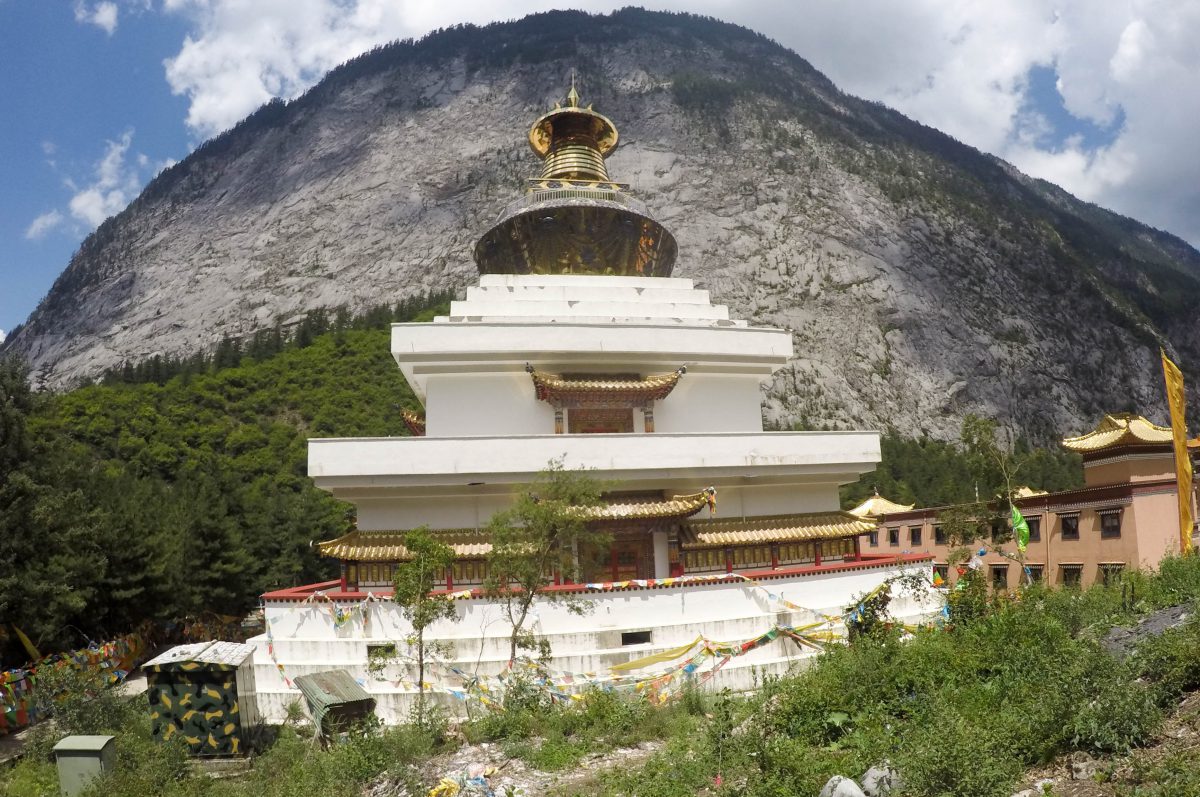
Jiuzhaigou isn’t technically in Tibet, but it’s culturally as close as you can get without a separate visa. Spend the day exploring the surroundings of Jiuzhaigou and enjoying the sub-Himalayan culture of this area of Asia. You can do so by hiring a driver (you’re unlikely to get an English-speaking driver, but if you ask your hotel/ hostel for someone to show you some local spots they will be happy to oblige and recommend places).
Where to Stay in Jiuzhaigou
Day sixteen: bus to chengdu.
Take the bus back from Jiuzhaigou to Chengdu. Once you’re off the bus, transfer to the train for an overnight journey from Chengdu to Nanjing. Use this link to find the best deals .
Nanjing – 1 day
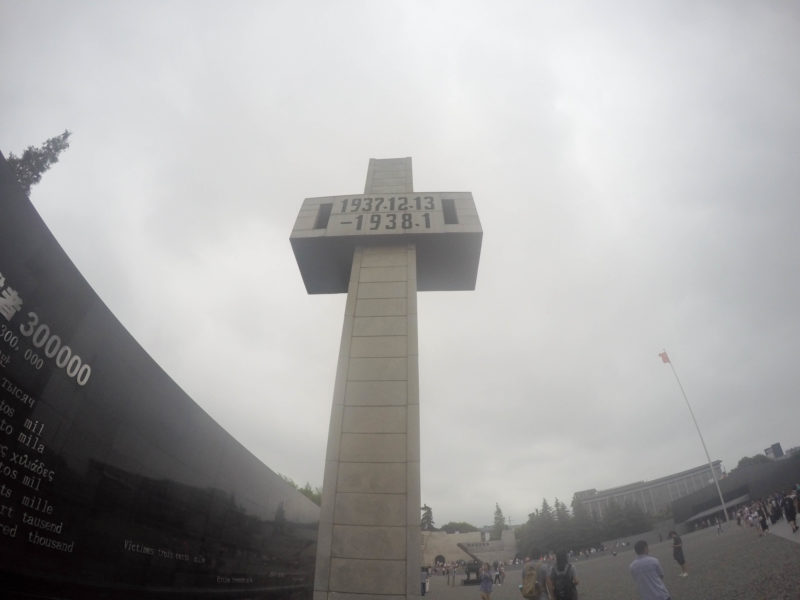
Day Ten: Nanjing Massacre Memorial
During your one day in Nanjing, the Nanjing Massacre Memorial . This is a difficult place to visit but a very important one. Here you will learn all about one of the most gruesome genocides of the Second World War, and the story of the war in Asia. The attached museum is fantastic and gives a real insight to WW2 in this part of the world, which is very important to learn about, especially if you only studied European WW2 history in school like most schools in Britain. Take an overnight train from Nanjing – Guilin. Use this link to purchase tickets .
Where to stay in Nanjing
Shanghai – 3 days.
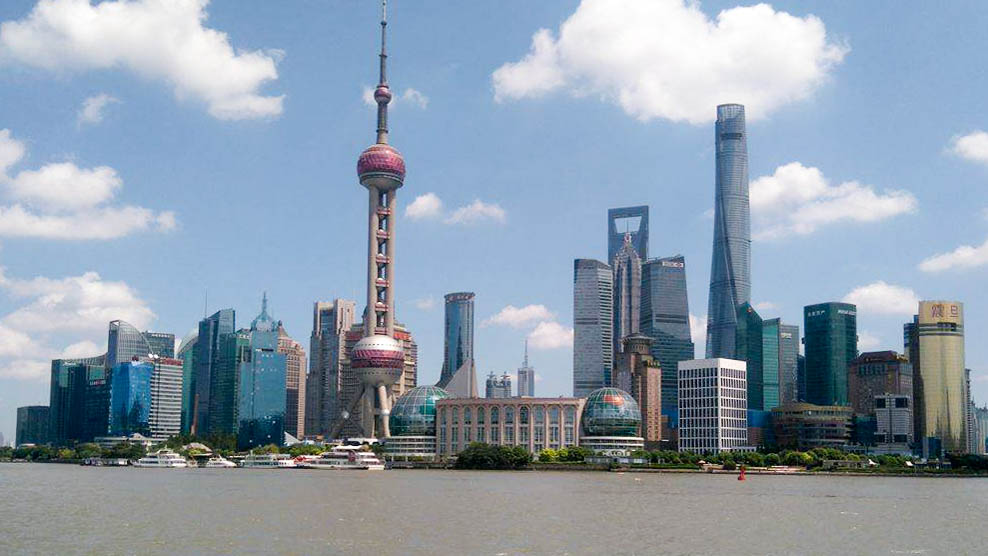
Shanghai is one of China’s most-visited cities, and the most western-friendly. The city is a huge, glittering, metropolis, with over 23 million inhabitants, but its land size, city planning and public transport make it relatively easy to both enjoy its urban attractions and green spaces – and there are also plenty of day trips from Shanghai that enjoy its nearby nature, that you can do if you have more time in the city.
Day Nine: Shanghai Highlights
Start your time in Shanghai by enjoying the intriguing skyline of The Bund. Even if you only have one day in Shanghai , this should be your first stop. A stark contrast to the ancient temples of Beijing, The Bund showcases futuristic China. After taking some snaps of this modern marvel, take a walk down East Nanjing Road, the busiest road in Shanghai. And if you want some serenity after the chaos, take a stroll down to Yuyuan Garden which is a calm oasis in the middle of the mad city.
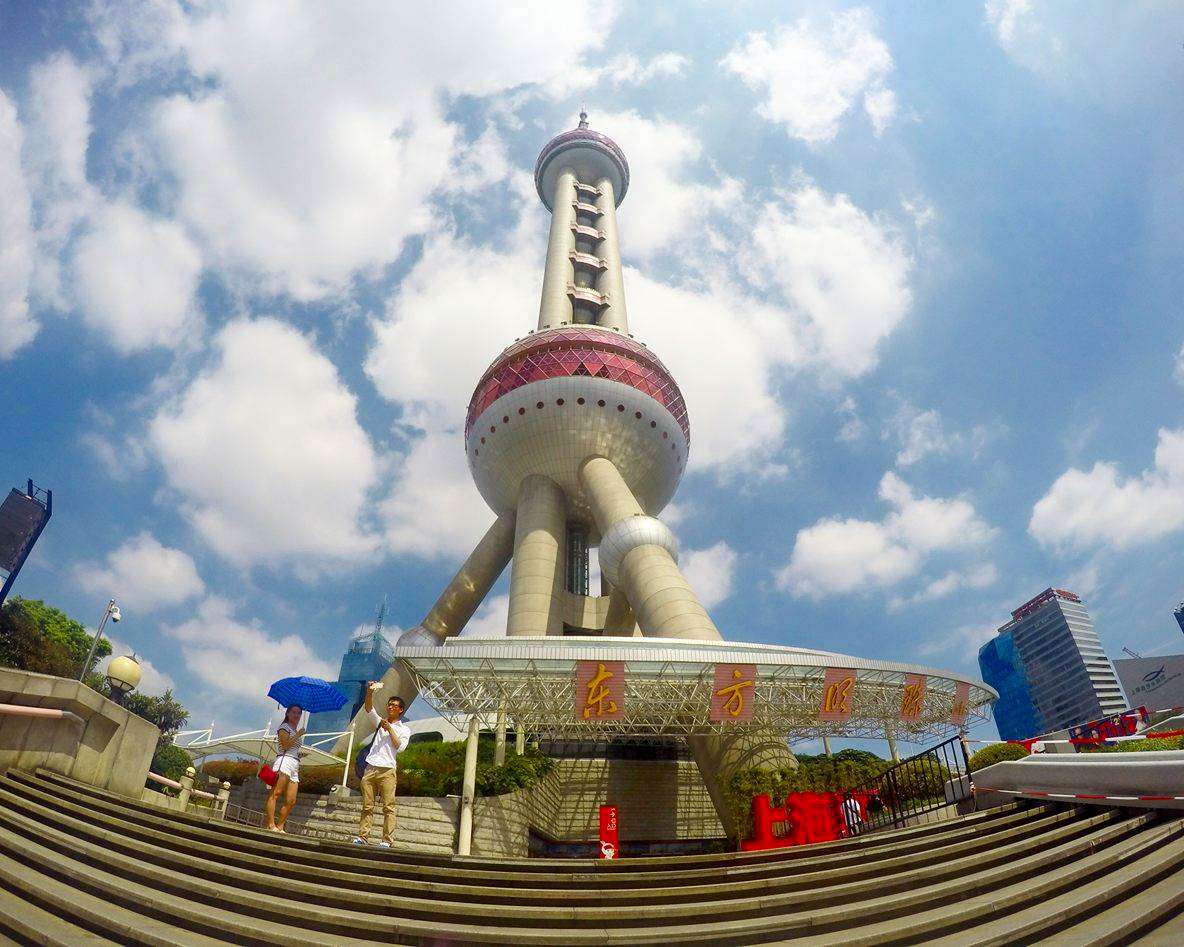
Day Eight: Alternative and Historical Shanghai
The next day, take a walk around the French Concession and visit the alleyways brimming with shops and restaurants of Tian Zi Fang. Then head out and explore one of the city’s most unusual museums – the Propaganda Poster Museum! Afterwards, learn all about China’s modern city at the Shanghai Museum. You can also ascend the TV tower for a great view over the city – this is best done at sunset, but do be aware that there are sometimes queues of an hour or more to reach the top of the TV tower.
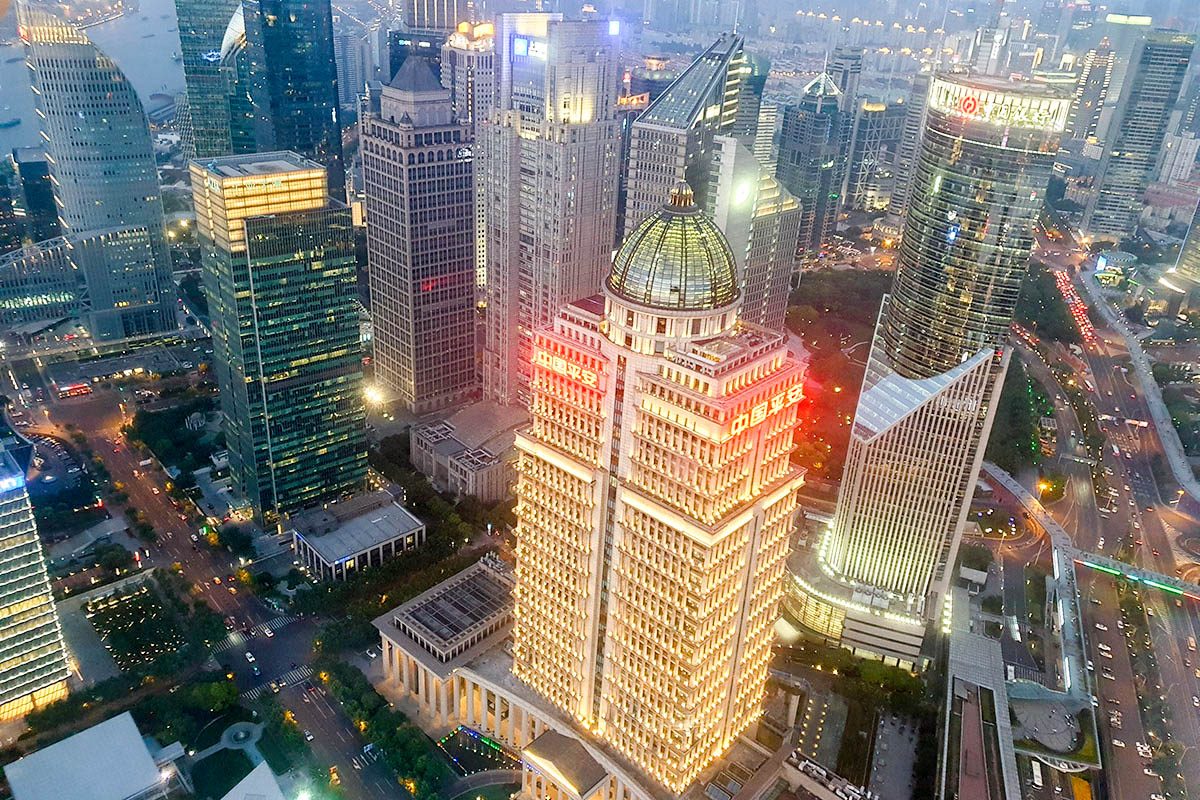
Day Nine: Zhujiajio Floating Village
On your last day in Shanghai, consider getting out of the city and exploring the water village of Zhujaijio, which is home to a network of scenic canals, as well as cute cafes and bars and authentic culture. Then head back to the city for an evening bullet train to Nanjing! You can check out my YouTube video to see what to expect from the bullet trains below and use this link to find some awesome deals .
Where to Stay in Shanghai
Mid-Range Hotel: San Want Hotel Shanghai is located in the Xujiahui commercial center close to metro line no. 9 (Guilin Road subway station) to easily roam around Shanghai. From standard to superior to suites, it has options for all type of budget travelers.
Complimentary mini-bar snacks and drinks, free broadband Internet, In – House Spa, 2 Authentic Chinese Dining places, Banquet hall to accommodate up to 600 people for conference or Marriage purpose. Grand Lobby, a separate tea room, special festival celebration keeps the guest engaged throughout the day. Being part of a Taiwanese Hotel Chain, the facilities and hospitality is uniform across the places of stay. Click here for rates and to book. By Chandresh from Family on the Wheels
Day Seventeen: Guilin City
Arrive in Guilin and spend the first day exploring the city, maybe doing a free walking tour . Visit the famous elephant trunk hill and walk around the varied and interesting food markets, enjoying some street food for dinner.

Day Eighteen: River Li and Yangshuo
The next day, get a transfer to the River Li and take a cruise around the river.
Afterwards, spend some time enjoying the natural scenery around Yangshuo . If you have some spare time on your China itinerary, consider staying here ofr a night to enjoy the scenery. Or if you’re in a rush, take a transfer back to Guilin for the evening.
Day Nineteen and Twenty: Longsheng
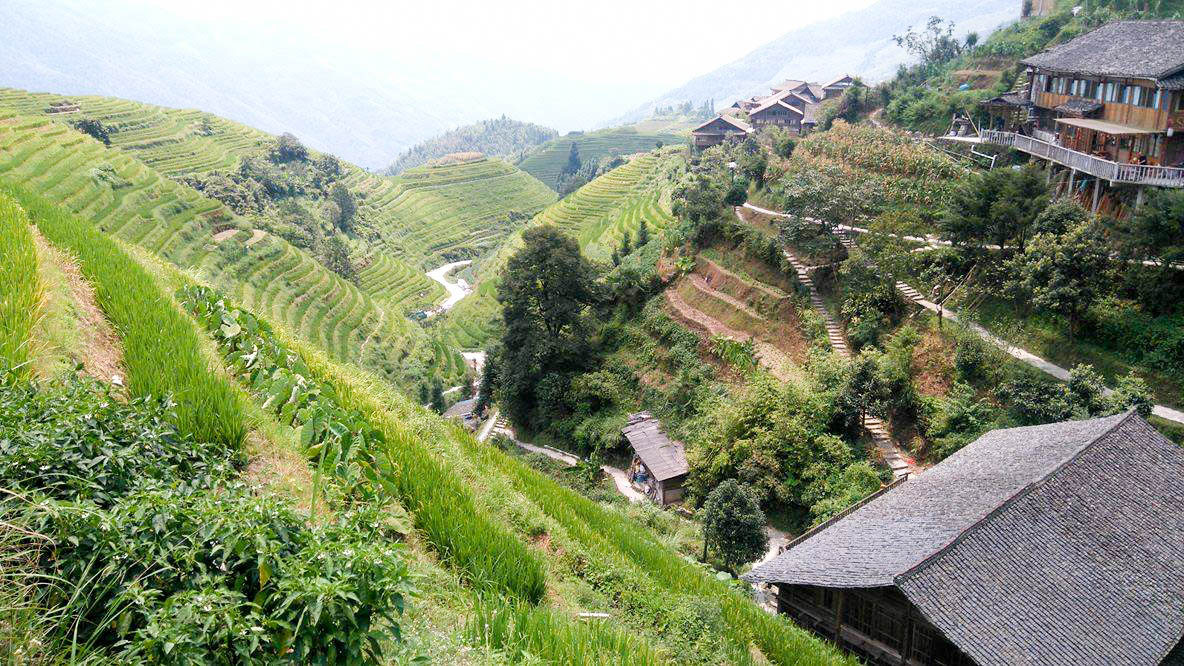
Take a bus to the Longji Rice Terraces and spend the day walking around the stunning area. Enjoy both the scenery and the rustic village atmosphere, and spend the night there for a sunrise over the picturesque rice terraces. Here are some reasons why you should favour staying in Yangshuo and Longsheng over Guilin!
Where to Stay in Longsheng
Day twenty one: hong kong.

Take a train from Guilin to Shenzhen in the morning – book tickets by clicking here – and then cross the border into Hong Kong (I personally couldn’t stand Shenzhen, but some travellers do spend time here).

Spend the first afternoon in the Kowloon area, visiting the Temple Markets as they open at night.
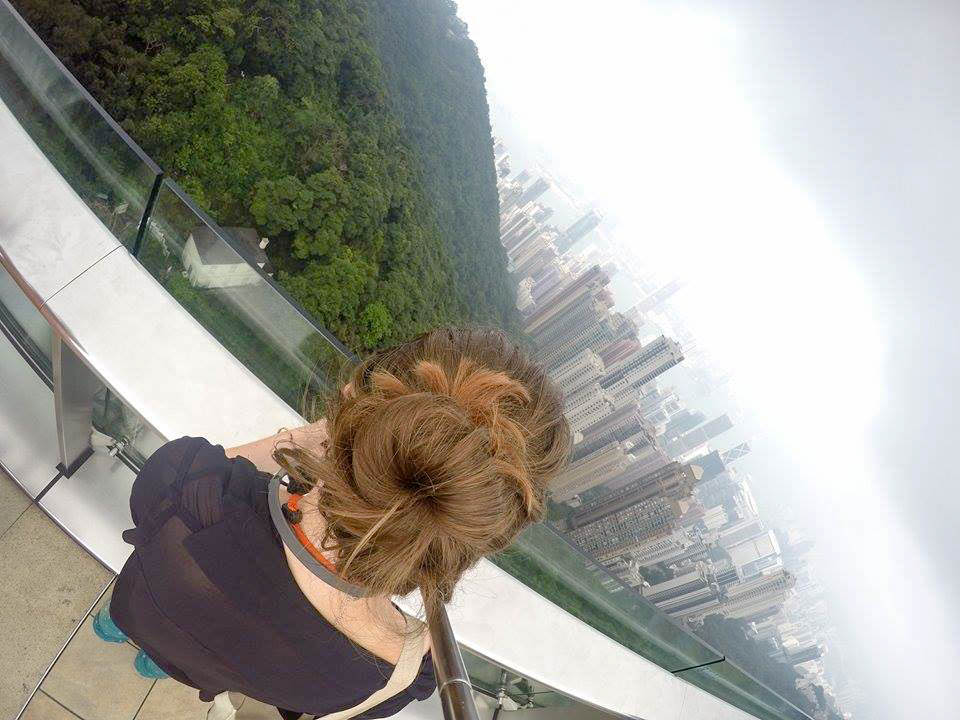
Day Twenty-Two: Hong Kong Highlights
The next day, take the Peak Tram up to Victoria Peak and enjoy the impressive cityscape of Hong Kong laid out in front of you. In the afternoon, take a trip to the Hong Kong museum to learn more about the city. And be sure to catch the Symphony of Lights at 8pm.
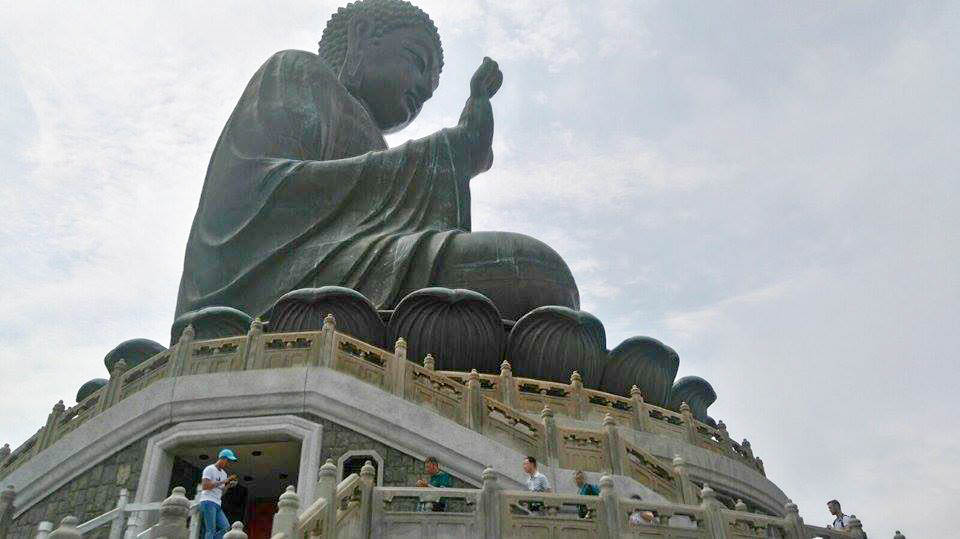
Day Twenty-Three: More Hong Kong
On your next day in Hong Kong, take the cable car up to the Hong Kong Buddha and visit the Po Lin Monastery. Spend your last afternoon in Hong Kong exploring the Tsim Sha Tsui area of the city. If you have a bit more time in Hong Kong and the surrounding areas, check out this detailed itinerary for Hong Kong and Macau .
Where to Stay in Hong Kong
Where to go from hong kong.
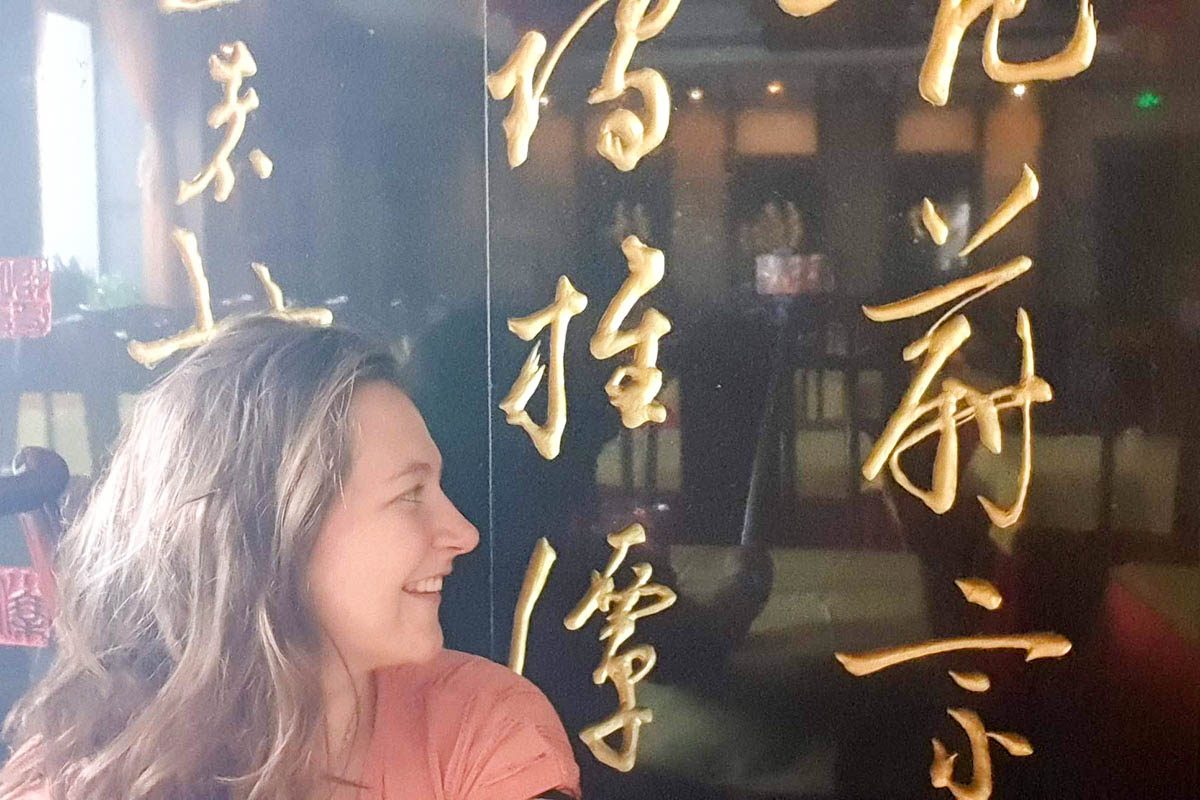
Your first time China trip ends today! Hong Kong has a very well connected airport that can take you to global destinations. Alternatively, cross back over into China (if you have a multiple entry visa) to explore more of the country, or have an overland adventure to South East Asia! Still have questions? Check out my other China posts…
- Solo Travel in China – tips on how to navigate the country if you’re travelling alone (also useful if you’re not!)
- Train Travel in China – taking the trains through China? Be sure to read this article to learn about everything you’ll need to know
I hope you found this China travel itinerary useful. I’ve got loads of deeper resources on each destination mentioned – click on the hyperlinks for more information! And please do not hesitate to contact me, either in the comments box below or over on Facebook if you have any China-related questions! Have you ever been to China? Wh at were your highlights if so? If not, what is the #1 thing you want to do in the country? If you liked this first time in China backpacking itinerary, please share it or follow me on Facebook!
10 thoughts on “ One Month in China Itinerary for First Timers ”
So many friends are packing to go on a China trip… and I still feel lost because I don’t know this beautiful country enough. Your article was such an interesting read, thank you for posting it!
China is quite high on the bucketlist, but there is so much to see. Hard to make a choice. This post is very useful.
China is on my bucket list as well! It has so many beautiful places to visit, but I also heard a lot about the communication and navigation problems. Your article gave me motivation to try it though! Thanks for sharing this!
China’s an amazing country to visit and it’s really not as tough as I thought it was going to be!
This post is brilliant. I am currently learning Mandarin with the dream of traveling to China and speaking with the locals. This was just the motivation boost I needed just now! I’ve set up a new blog, your welcome to check it out http://www.myputonghua.com Thanks
Nicely written Claire! I haven’t made it into China yet (as you said, it’s daunting) but this itinerary seems to lay everything out in a way that isn’t too rushed but still see’s a lot of a large country in a (relatively) short timeframe! Keep it up!!
Hopefully you’ll make it someday it’s an amazing country! Be sure to check back with this itinerary if you do! 🙂
Oh your camping on The Great Wall looks so interesting and strange. It might be the memory that we can’t forget in the lifetime. It seems that you miss a very beautiful part of China in this trip such as Yunnan. Or you want to combine it with the expedition to Vietnam & Laos? Anyways, thanks so much for the great post!
This was extremely helpful, thanks fro your advice !! Thanks
China has been one of most most favorite backpacking trips!! And a month definitely wasn’t long enough. And second trip is on top of my list!! Next time round I would organize a VPN for both my phone and iPad. And install wechat.
Comments are closed.
- New Zealand
- The Philippines
- The Netherlands
- United Kingdom
- Inspiration
- Overland Itineraries
- Packing Lists
- Travel Tips
- Working Abroad
- Accomodation Guides
- Overland Travel
- Preserving Cultures
- Protecting Animals
- Living Abroad

A backpacker’s guide to China: a one-month itinerary
The country’s epic scale adds further adventure to this route, which takes in historic villages, national parks and megacities while staying in budget accommodation
China’s vast size and expensive visas, coupled with the perceived difficulties of travelling there, means much of the country remains relatively unexplored by international visitors. Thanks to this though, with a little determination and time, it’s possible to wind up in places where locals will have rarely seen a foreign face, such as Cangpo village in Zheijang’s verdant bamboo-covered landscapes. Even in the big cities you will come across domestic tourists for whom foreigners are a novelty.
One-month itinerary
In Beijing , tick off the must-see sights of the Forbidden City and Tiananmen Square, and spend a few surreal minutes walking past the embalmed body of Mao Zedong in his mausoleum. Wander the narrow hutongs (alleyways) of the Wudaoying and Fangjia neighbourhoods, stumbling across hidden bars and restaurants. Visit the Simatai section of the Great Wall for fewer crowds, dizzying climbs and stunning views.
From Beijing, take the train to Xi’an (5-6 hours) or go via the ancient walled city of Pingyao (train, around 4 hours) and stay at Pingyao Jiaxin Guesthouse , an old courtyard building with traditional kang-heated beds (doubles from £11). Xi’an’s Terracotta Warriors are, quite simply, among the great archaeological wonders of the world. After jostling the crowds there, fuel up on some of China’s best food at the Muslim Quarter market.

From Xi’an take the train to Lanzhou (2-3 hours), a massive, industrial city home to the irresistible Lanzhou beef noodle soup – eat it for breakfast like the locals. Plan a long day trip to see the remote Buddhist sculptures at the Bingling Temple Grottoes, accessed by a speedboat across a vast lake.
If time allows, travel to Chengdu by bus (consult timetables locally) via Xiahe monastery town (staying at the nearby Nirvana Hotel , dorm bed from £7) or visit the Jiuzhaigou or Huanglong national parks for high-altitude hiking past dazzlingly blue natural pools. Alternatively, take an overnight train (around 11 hours) or fly (around 1½ hours).

Enjoy Chengdu’s teahouse culture at one of the hundreds across the city – keep a lookout for locals nursing hot flasks of boiling water and playing mahjong. Pay the pandas a visit at the Chengdu Research Base of Giant Panda Breeding – you can even sign up to be a keeper for a day (from £40pp). And be sure to spend a day visiting the Leshan Giant Buddha, the largest stone Buddha sculpture in the world.
From Chengdu fly to Lijiang (around 1½ hours). After a couple of days in beautiful but crowded Lijiang (the Garden Inn hostel in the old town has dorm beds from about £5), head to Tiger Leaping Gorge, one of the deepest canyons in the world, for hiking and spectacular scenery. Stay at Sean Spring Guesthouse (doubles from £8) right in the centre of the gorge.

From Lijiang fly to pretty Guilin (around 1½ hours) to travel up the Li River to Yangshuo for picture-perfect karst mountain scenery. Yangshuo is one of Asia’s best destinations for rock climbing. Return to Guilin and fly (1½ hours) or take the train (9½ hours) to Xiamen for some time on one of the city’s public beaches before heading inland to stay at Nanjing Qingdelou Inn , an earthen roundhouse (twins from £21) where you can experience the traditional lifestyle and food of the Hakka ethnic minority people.
From Xiamen, take the train to Shanghai (from £37, fastest train 5 hours). If time allows, stop off at the Wuyi mountain range to explore south-east China’s tea culture and hike through Unesco world heritage-listed scenery.
End your trip in cosmopolitan Shanghai, wandering the back streets of the former French Concession area and marvelling at the views over the river from The Bund. Captain Hostel (dorm beds from £9) is popular for its rooftop views and around the corner from the glamorous Waldorf Astoria hotel – treat yourself to a cocktail in its historic Long Bar.
Getting around

China is massive and getting anywhere will probably take much longer than anticipated, and it gets more time-consuming the further west you go. The comfortable high-speed trains can be a fast way to cover distances ( see our guide to travelling by train in China ), while the older long-distance sleeper trains make for an adventure. While quicker than trains, domestic flights can be expensive and plagued by delays. Coaches are a good option in places with no railway stations. In towns and cities, public transport is cheap, starting from around 10p for bus and metro journeys.
Accommodation
Youth hostels and guesthouses outside of the major cities are usually extremely cheap – just a few pounds for a bed in a dormitory. According to Hostelworld, the average price of a hostel bed is £10 in major cities and £6 in other areas, though breakfast isn’t always included. If you don’t mind haggling, it’s possible to negotiate a discounted walk-in price, especially outside the Chinese holidays. Expect firmer mattresses than you may be used to as Chinese people, especially the older generation, have a preference for hard beds.

Many guesthouses in more rural areas are run by families, often in the family home. These can be a wonderful way to meet local people, enjoy homemade food and stay in traditional-style buildings. Wherever you stay, however, make sure that the hotel is permitted to take foreign guests: in remote locations it is against the law for some cheaper places to do so, so there’s a risk of a visit from the local security bureau if they take you in.
Inside the Forbidden City. From the outside the enormous palace is impressive but inside there’s little sense of the fascinating and isolated lives its royal inhabitants must have experienced. Plus, it’s a major tourist attraction and the crowds can get boisterous.

Almost anywhere outside Beijing, Shanghai, Xi’an and Hong Kong but particularly the central western provinces of Sichuan, Gansu and Qinghai. Here, you can experience Tibetan culture without the hassle of getting a separate entry permit for Tibet.
Need to know
Many Chinese people have a fairly boisterous attitude to etiquette and there’s little the average traveller will do to offend. In restaurants, expect to receive your free glass of water boiling hot even on blisteringly hot days thanks to the belief that cold drinks are harmful. To access the usual apps and websites while travelling, be sure to subscribe to a decent Virtual Private Network (VPN) before arriving. Messaging app WeChat is handy for making local friends and for translation.
For inspiration

Book While it may be almost a decade old, Peter Hessler’s Country Driving: A Chinese Road Trip, remains an accurate, funny and moving portrayal of a country in transition. Hessler’s journey from behind the wheel of a car gives a perspective of China few travellers have a chance to experience.
Blog China Mike is an uncensored and irreverent resource for first-time China visitors, answering important questions such as: Is China safe? Does anyone speak English? and What kind of meat is this exactly?
Instagram @chinadestinations has stunning crowd-sourced images from around China.
If you eat or drink one thing
Forget the idea that Chinese food is all noodles and rice. Head to the busy food market in Xi’an’s Muslim Quarter and get your hands on a greasy, delicious roujiamo . Usually made from delicately spiced pulled pork (or lamb or beef from a Muslim food store) sandwiched in a round pitta-like bun, these “Chinese sandwiches” are a cheap, filling snack. Ingredients and taste vary from place to place, too, so you’ll never tire of sampling local versions.
Daily budget
While local food is cheap, major tourist attractions can be expensive (although many give discounts to students and seniors). Budget at least £35pp a day. There’s no tipping so this can help keep costs down.
Head to Taiwan to see what mainland China might have been without 60 years of Communist rule. There are flights to Taipei from most major mainland cities; popular airlines include Taiwanese carrier China Airlines and Shanghai-based China Eastern. In Taiwan, Mandarin Chinese is used so any words or phrases picked up on the mainland won’t go to waste. You’ll need to brush up on your traditional Chinese characters, though, rather than the simplified version used in mainland China.
- China holidays
- Backpacking holidays
- Budget travel
- Adventure travel
- Travelling solo
Most viewed

The Ultimate 1 month China Itinerary
C hina is the world’s most populous country and has become more and more popular amongst tourists, with so much to offer. My trip to China was my first ever time abroad ‘solo’. I backpacked China for around a month when I was 18 as part of this trip with The Dragon Trip . This one month itinerary is based off of that trip and includes the top things to do in Hong Kong,

Shanghai, Beijing and lots of other cool places.
Disclosure: This post may contain some affiliate links, meaning that if you click one and purchase/book something, at no additional cost to you, I will earn a little commission. Read more here .
When it comes to planning your one month China itinerary, don’t panic. I arrived in China with my HUGE yellow suitcase (don’t get me started), my excitement and being able to (just about) say “Hello”, “Thank you” and “Excuse me” in Mandarin.
Did it take me a few hours to find my hostel? Yes. But I made it. Here’s some top things to know for first timers to China:
Currency : The official currency of China is Renminbi (RMB) but is often referred to as Yuan (CNY). Hong Kong uses the Hong Kong Dollar and Macau’s currency is called the Pataca. Currently, £1 will get you 8.81 Yuan or 9.57 Hong Kong Dollar or 9.85 Pataca.
Language : The official language in China is Mandarin which is spoken by more than 70% of the Chinese population. However, there are many dialects that are used all over China. Cantonese is also widely spoken.
Weather : Because China is such a big country, the weather changes drastically between regions. The most popular time to go to China is between September and October. But watch out for typhoons in Southern China, these are particularly bad between July and September. Make sure to read up on the air quality too as that changes throughout the year.
Cash or Card? Similar to most places in Southeast Asia, I found that China mainly uses cash. Although big brands and fancy hotels are likely to accept cards, it is less likely in smaller cities and outside of touristy areas. So it is best to always carry cash on you.
Visa? As a UK citizen, I needed a visa for mainland China, but not for Hong Kong or Macau. A lot of people get their visas whilst staying in Hong Kong but I preferred to get mine beforehand. I think now you need to do it in person, so make sure you research.
My flight from the UK to Hong Kong was my first EVER flight by myself!! I managed to find the right taxi for the region I needed to get to and it took an hour or so to get to my hostel. Unfortunately I only spent one day in Hong Kong (due to jet lag) and I really regret this (but hey I have my whole life ahead of me to go), so I’d really recommend spending at least 5 days exploring this HUGE city!!
Where to stay in Hong Kong
Whilst in Hong Kong, I stayed at the YesInn At Causeway Bay. This was my first ever hostel that I stayed in! YesInn has a 9.1 rating for location on booking.com as it’s very close to the Causeway Bay Metro Station as well as the main buses. There is a rooftop bar and small common area inside which is always filled with other backpackers. Check out more info and prices here .
Cross the border by bus into Mainland China from Hong Kong and take the bullet train to Yangshuo.
Yangshuo isn’t really at the top of every backpacker’s bucket list, but it should be. Yangshuo is one of my all time favourite locations. Not only is it home to the infamous Li River boat trips, but it’s also the cutest town filled with the quirkiest little shops and restaurants.
On my first day in Yangshuo, I arrived in the evening & decided to explore the town a little more and discovered “Lucys Cafe” – which soon became my favourite place to eat. I had the banana pancakes every morning for breakfast!! They also had a lovely lab called yoyo who soon became my best friend!
Where to stay in Yangshuo
I stayed at The Hidden House which has an overall rating of 8.6 on booking.com, with a 9.2 rating for location – the hostel is just over the road from the heart of all the hustle and bustle. The dorm I stayed in here was one of the cleanest and comfiest I stayed in throughout my time in China. Check out prices and more info here .

To get to Chengdu from Yangshuo, take a bus to Guilin and then board a sleeper train to Chengdu. This journey was my first ever sleeper train, and also the longest one I’ve ever taken, being 25 hours.
Chengdu is one of the must-go places in China, due to the fact it is home to the Research Base of Giant panda breeding, one of the most popular things to see in China. Some tourists may not feel comfortable visiting the panda centre, and I too was quite skeptical at first but after I read this post, I decided to go and really enjoyed my time there but similarly to Claire, strongly advise AGAINST holding a baby panda for a photo.
Where to stay in Chengdu
So I stayed at the FlipFlop Backpacker Lounge whilst in Chengdu. It’s got a 9.2 star rating on booking.com and is one of the most popular choices for backpackers. Not only is this “Poshpacker hostel” a 5-minute walk from Chunxi Road Station, this hostel also offers the COOLEST social scene from things like dumpling parties to group trips to watch a Sichuan opera show. You can check out more info and rates here .

To get to Xi’an, take another sleeper train. Xi’an is one of my favourite places I visited in China. It’s filled with so many different cultures, and you can explore so much by foot. It’s most famous for the Terracotta Warriors. One of my favourite things was to explore Muslim Street! Where you’ll find quirky little bazaars and mouth-watering food stalls.
Where to stay in Xi’An
I stayed at International Party Hostel which was so cute. The bar here was awesome and there was such a great social scene, not to mention, drinking scene. It’s also right next to the train station and within walking distance of some of the top tourists attractions, so it’s in a really awesome location.

To get here, take a coach ride from Xi’an!
Dengfeng is famously known for being home to the Shaolin Temple. I only stayed for one night, which was a shame because it was such a beautiful little village. I stayed in a local villagers guesthouse, which was amazing! They cooked us 5 meals and they were absolutely delicious.

Beijing is the world’s most populous capital city, and is home to some of the most iconic and famous sights in China. Beijing is perfect for any traveler: from first time backpackers to families , there is so much to see and explore.
On your way to Beijing, make sure to take a break and visit the Olympic Park!
One of my highlights of Beijing was being lucky enough to camp on a private section of the Great Wall of China, owned by a local farmer.
Where to stay in Beijing
I stayed at the Leo Hostel which is really popular amongst backpackers. When I visited, there was travellers from all over the world staying and the social life was awesome. There’s a really fun bar and common area as well as there being some great restaurants nearby. Check out prices and more info here .

To get to Moganshan, take a sleeper train to Hangzhou and then take a bus ride to find Moganshan, deep in a forest of bamboo.
Although Moganshan is not your typical China bucketlist destination, it’s SO worth the visit. It is the perfect place to pause this hectic itinerary and relax.
Where to stay in Moganshan
There are a few different villages and towns in Moganhsan to visit, so pick your base carefully. I stayed in the beautiful village of Hou Wu, at the Moganshan Howoo Life Hostel. With a 9.1 review on booking.com and the beautiful surrounding bamboo forests, you’ll want to be checking this out. View prices and more info here .

Shanghai is China’s biggest city and a global financial hub. It’s one of the most visited cities in China. The best way to get to Shanghai is to take a bullet train. My favourite thing to do in Shanghai was exploring the artisan’s lane and taking iconic photos of the sky-line.
Where to stay in Shanghai
I stayed at the Blue Mountain LuWan Youth Hostel and this hostel was one of my favourites in China. Most likely because it was my first time in an all-female dorm and I loved being away from men for a few days. But seriously, this hostel was great. As well as only being a 15-minute walk from the Bund and People’s Square, this hostel had the COOLEST bar area and went on quite a few bar crawls whilst I stayed. AND it’s only a 5 minute walk from the metro station!! Check out prices and more info here .

To get to Fujian, take a bullet train from Shanghai to Nanjing and get a bus to Fujian!
In Fujian, I stayed in a tiny little place called Tianluokeng. I spent one night sleeping in a traditional round house (‘Fujian tulou’) and another at Mr. Liu’s Guesthouse.
Fujian is one of the most beautiful places I have visited and I fell in love with this little village so quickly.

Macau is very small and can easily be covered in a day trip from or on the way to Hong Kong but for this itinerary, I recommend taking some time to chill in Macau and enjoy yourself!
To get to Macau from Fujian, take a sleeper train to Guangzhou East and then hop on a bus to the Zhuhai border in order to go through the border into Macau.
Another popular option is to take a day trip from Hong Kong and hop on a return ferry to Macau – this costs about 360 HKD (£36). When you arrive at Macau ferry port, there are lots of FREE buses which will drop you off at numerous casinos – your best bet is to try and find the one that will take you nearest to your accommodation.
Where to stay in Macau
There isn’t really any hostels in Macau, but the Macau Hotel S is the most popular amongst backpackers and is one of the most funkiest hotels I’ve ever seen! As well as having a location rating of 8.3 on booking.com, the hotel itself has it’s own bar and restaurant. Check out some more info and rates here .

Save for later…

12 Comments
What an amazing itinerary this would be. I love how you formatted this post, makes it really easy to read and plan what I want to see!
Thanks so much for your kind comments!!
Your blog is beautiful! I’ve lived in China for a year and you’ve been to way more places than me! And I NEED to go to Yangshuo after reading this!
What an incredible place to live!! YESS – visit Yangshuo! It’s so amazing 🙂
Tiana Bantis
What a great quick read! China looks so diverse, would love to visit after reading this!
Thanks so much! I hope this helps to plan your trip whenever you go 🙂
Sandy Vyjay
China has some incredible experiences and it is a huge country. One month there must be a great experience. There is so much to see and experience. The culture and heritage of China is so colourful. Have never been to Mainland China, though have spent a few days in Hong Kong and Macau. It is was an awesome experience. Your post is a ready-reckoner for planning a trip to China.
Thanks so much for your comment! Indeed there is so much to see and experience and I feel like I only just touched on it!
Wow, I would love to spend 1 whole month traveling China. This post was so organized! Riding a bullet train sounds super fun. I will definitely be back to this post whenever I plan a trip to China.
Thanks so much for your comment! I really hope this helps you to plan an awesome trip!
What a great guide! I studied abroad in China. Pinning this post for if I ever get to go back.
Thanks so much! What an amazing experience to study abroad!!
Leave a Reply Cancel reply
Your email address will not be published. Required fields are marked *
Save my name, email, and website in this browser for the next time I comment.
Post Comment

Philippines 3 week Itinerary
The Philippines is a country in the West of Southeast Asia and is made up of more than 7,000 islands

How To Survive The Full Moon Party on Koh Phangan, Thailand
Although you’ll find loads of parties across Thailand, the most famous will be the one held on

Top Tips For First Timers To China
When I went to China over the summer of 2017, there were a lot of things that shocked me. I wish I
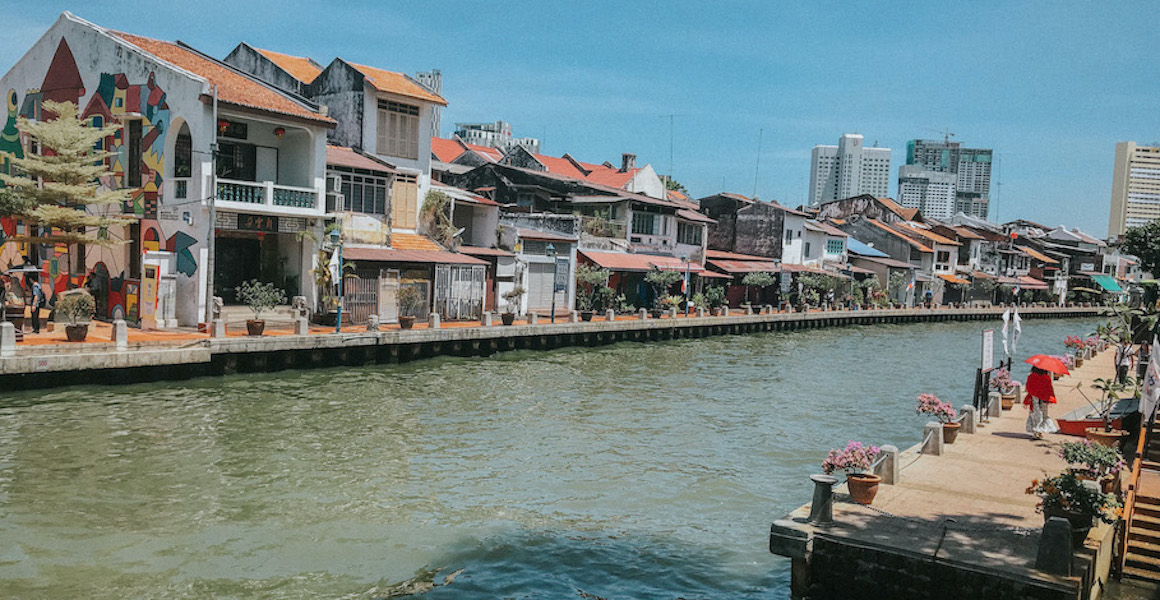
The Ultimate Tips For Travelling Southeast Asia
Southeast Asia is one of the most popular places to travel, and it’s not surprising why. From
- Skip to primary navigation
- Skip to main content
- Skip to primary sidebar

Destinations
Experiences.
- Photography
Plan Your Trip
China starts here.
Creating a China itinerary can be a trying experience, and I say that as someone who once lived there for a year. From curating the perfect list of destinations, to making sense of an ever-expanding network of high-speed trains, to getting your China visa and other pre-travel arrangements in order, planning a trip to China can seem as complicated as the millennia of history that went down here.
Deciding how long to spend in China is also difficult. While around one month in China might seem ideal, given the size of the country and array of experiences you’re going to want to have, the intensity of traveling in the Middle Kingdom can make this an unrealistic amount of time to be there. (To say nothing of the language barrier you’re going to encounter, or how frustrating it is to navigate around the so-called “Great Firewall.”)
The good news (again, keeping in mind that I lived and worked in China even before my many trips there) is that I’ve got your back. From a simple overview both of China tourist spots and the practical aspects of traveling there, to a sample China trip plan you can adapt to fit your own preferences, you’re only a few minutes away from sweet relief.
Practical Matters
When to visit china.
The best time to visit China is generally during the spring or autumn months, though some of this is a matter of preference. For example, while April sees the thaw of destinations in northern, central and western China, it can be a perilously wet time in the south. On the other hand, summer heat can be oppressive throughout much of China (to say nothing of how hazy and polluted cities like Beijing can be at this time), and even less pleasant to bear than the frigid winter months.
Where to Stay in China
Perhaps the most marked improvement I’ve noticed during my decade-plus of travel to the Middle Kingdom relates to accommodation in China. While just about every mainstream hotel brand has entered the market, with no shortage of high luxury, many boutique properties have opened throughout the country, many of them dripping in character and charm. Some recent favorites of mine have included Buddha Zen Hotel in Chengdu and Shichahai Shadow Art Performance Hotel in Beijing , though I can recommend dozens of others throughout the country.
How to Get Around in China
Whether you embark upon a China itinerary 1 month (or slightly shorter/longer), you’ll be aided by the world’s most rapidly modernizing transport system. Well, in terms of China trains anyway—flying domestically in China can be a hot mess, with massive delays and airport security procedures that make the American TSA seem highly competent by comparison. The majority of large Chinese cities have some kind of subway system, while smaller cities are replete with buses and taxis, and are in some cases walkable.
China Visas
Getting a China visa for US citizens is a somewhat tedious procedure, but the good news is that China visas are now good for 10 years. As far as how to get one you have a few options, with applying in Hong Kong or using a visa agency in your home country the most popular methods. If you’re planning on taking a very short trip to China (less than 72 hours, or in some cases 144), you can actually get a short-stay transit visa on arrival, provided China is your connection point—which is to say you’re flying in to one country, and flying out to a different country.
Money, Costs and Communication
Many travelers contact me with the question”is China expensive?”—and my answers is surprisingly complex. While China is affordable compared to many neighboring countries (most notably Japan ), it’s gotten much more expensive in recently years. I’d say most travelers will spend somewhere between 350-1,350 Chinese yuan (that’s ~50-200 USD) per person per day, with backpackers being on the low end, and the high-end representing travelers who stay in boutique hotels and dine in restaurants that require reservations. Credit card acceptance in China is not great, with most businesses preferring mobile payment systems like AliPay and WeChat, which are only available to people with Chinese bank accounts.
As far as communication, there’s good news and bad news. The good news is that Chinese SIM cards are relatively easy to get (though not super cheap) and Wi-Fi is basically everywhere. The bad news is that China’s internet is the most heavily censored in the world, and unless you find the best VPN to use in China , is more or less cut off from the rest of the planet’s internet.
Where to Go in China
Beijing and the great wall.
It’s a foregone conclusion that you’ll want to add Beijing to your one month China itinerary—or is it? Though I’ve always been a fan of China’s capital, and the way it blends thousands of years of history with the various trademarks of modern China, it’s definitely not a well-loved city, and not just because of the smog that frequently chokes it.
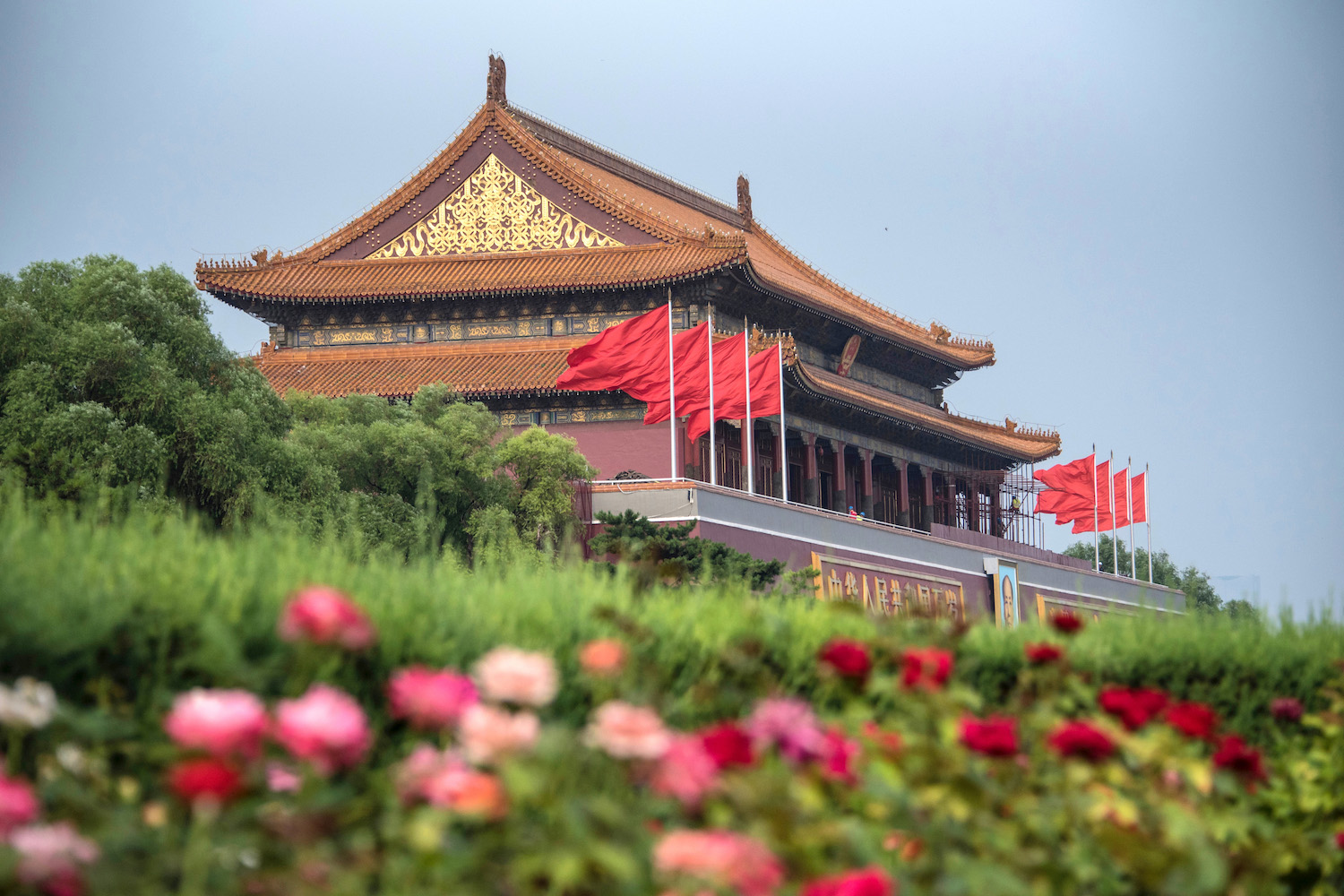
As far what to do in Beijing, should you decide to visit, that can also be difficult. While some travelers will simply tour the Forbidden City and Tian’anmen Square before taking a day trip to the Great Wall of China , others will traipse through the hutong water houses around Houhai Lake , explore sacred sites like Lama Temple and the Temple of Heaven or visit the sprawling Summer Palace just north of the city. (To say nothing of all the amazing food there is to eat in Beijing.)
READ MORE: The Secret to a Perfect Beijing Trip
Shanghai and Vicinity
Many travelers seem to express difficult planning a Shanghai itinerary, which surprises me—there simply isn’t a lot to do here, and I say that as someone who lived in Shanghai for years. After you’ve walked amid the skyscrapers of Lujiazui in Pudong , gotten wasted on the Bund , visited Yuyuan Gardens and snapped a picture of Jing’an Temple , you’ve pretty much sampled all of Shanghai’s attractions—this city was less than half its size just 20 years ago, after all.
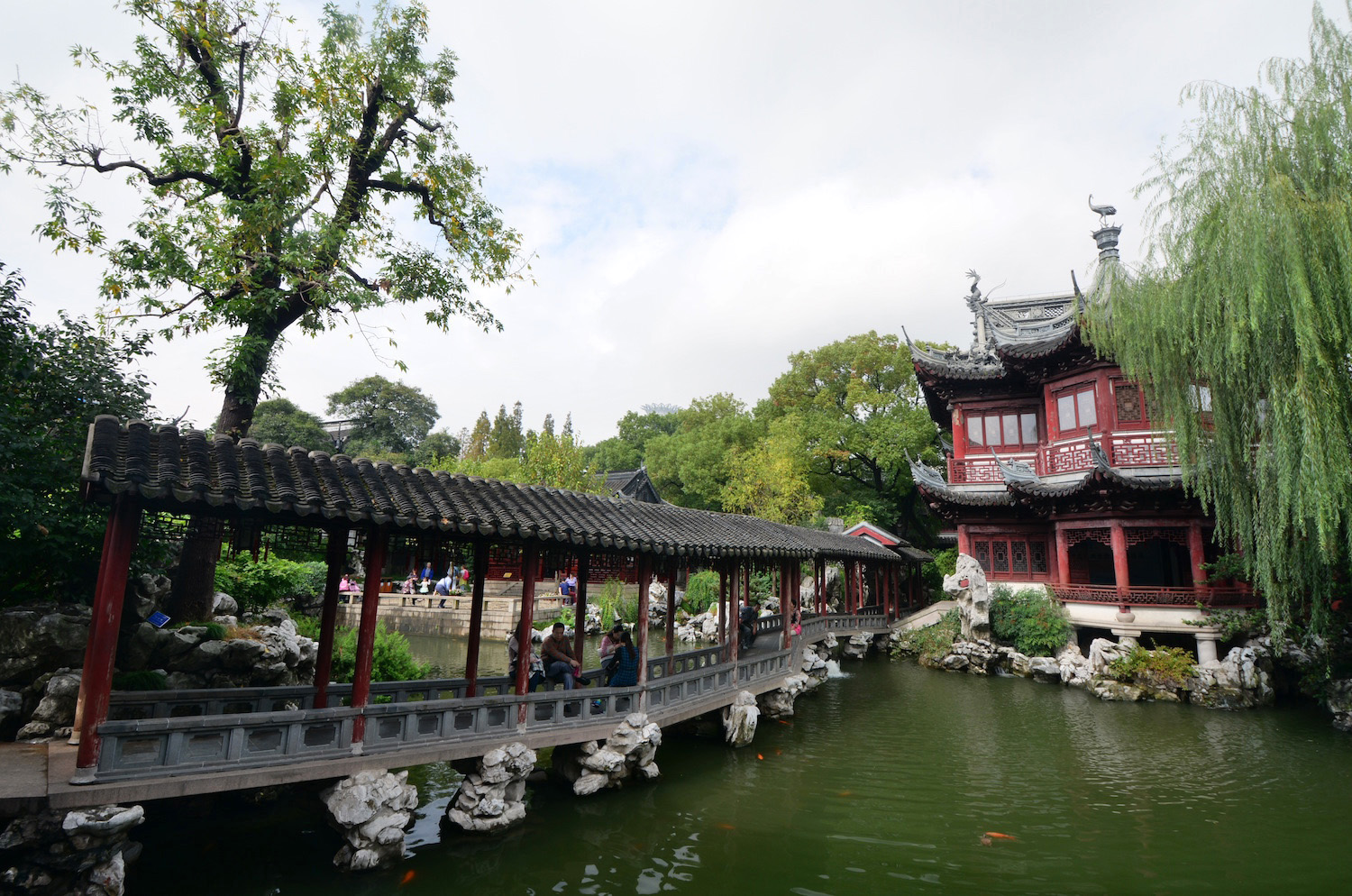
On the other hand, the reason Shanghai tends to occupy lots of space within your China 1 month itinerary is because of the places around it. Whether you spend a night at Anji Bamboo Forest (where “Crouching Tiger, Hidden Dragon” was filmed) or visit nearby cities like Hangzhou and Suzhou (or much smaller “water towns” like Zhujiajiao ), much of your time in the vicinity of Shanghai will be spent outside the city-proper.
READ MORE: Three Days in Shanghai
Hong Kong and the Pearl River Delta
Hong Kong is not really part of China—not administratively, and certainly not culturally or in the minds of its citizens. On the other hand, it would be foolish of me not to mention places to visit in Hong Kong within my 1 month China itinerary, since many of you probably want to visit the Special Administrative Region (SAR) as part of your larger trip to China.
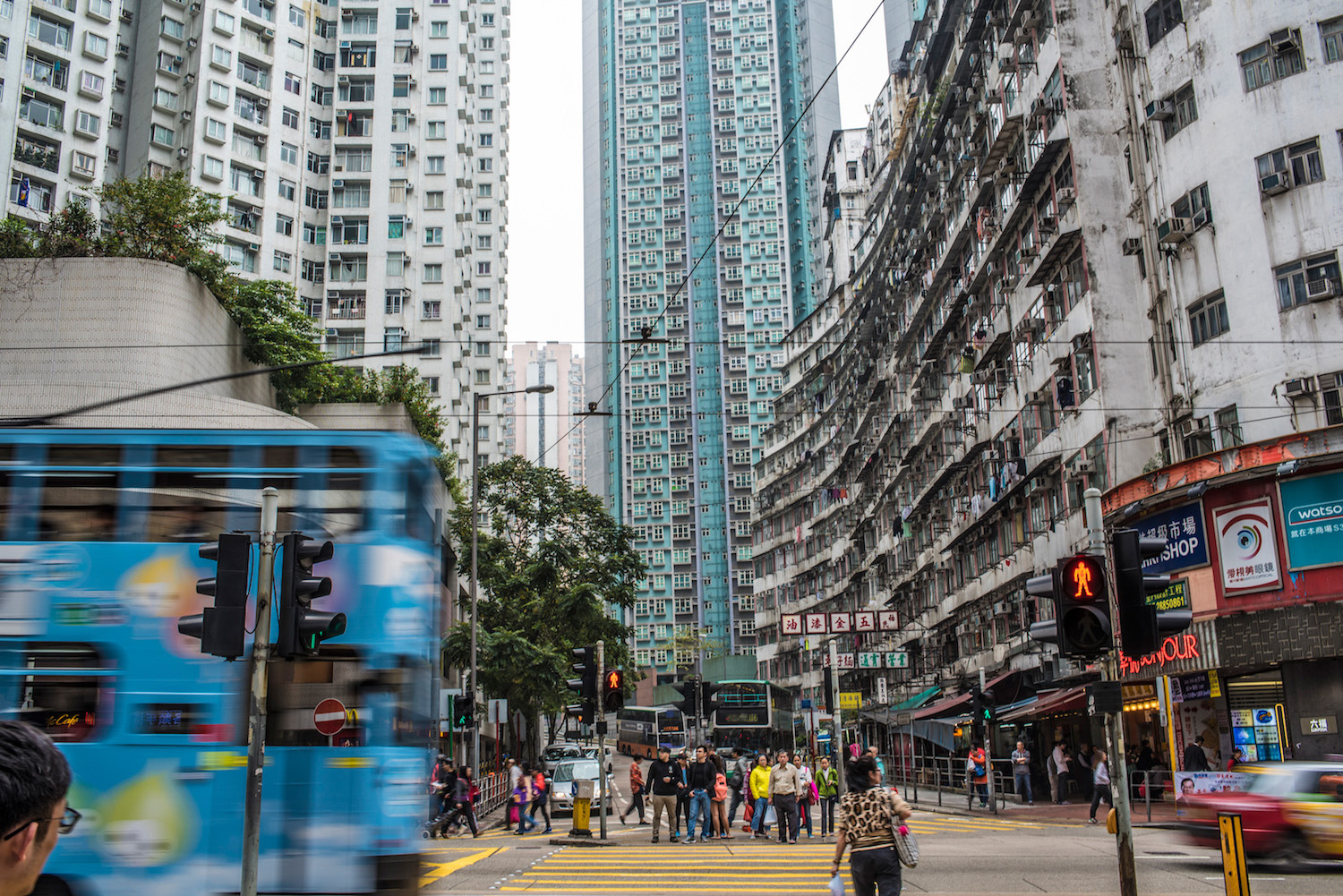
If anything, your experience therein will hammer home the point I’m trying to make. Whether you ride the Hong Kong to Guangzhou train (or the shorter one to Shenzhen ) after exploring the SAR, or travel to Hong Kong after spending some time in the other cities I’ve mentioned, the contrast of vibrant Kowloon and upmarket Hong Kong Island with just about anywhere on the mainland will be jarring, to say the least.
READ MORE: Heavenly Hong Kong
Chengdu, Chongqing and Sichuan
The next place to make sure to add to your 1 month China itinerary is Sichuan province, located in the country’s southwest. Famous, esoterically, as the home of the Chengdu Panda Base (not to mention China’s spiciest and, overall, tastiest food), Sichuan is a place that would be easy to miss if you didn’t know how essential it was to go there.
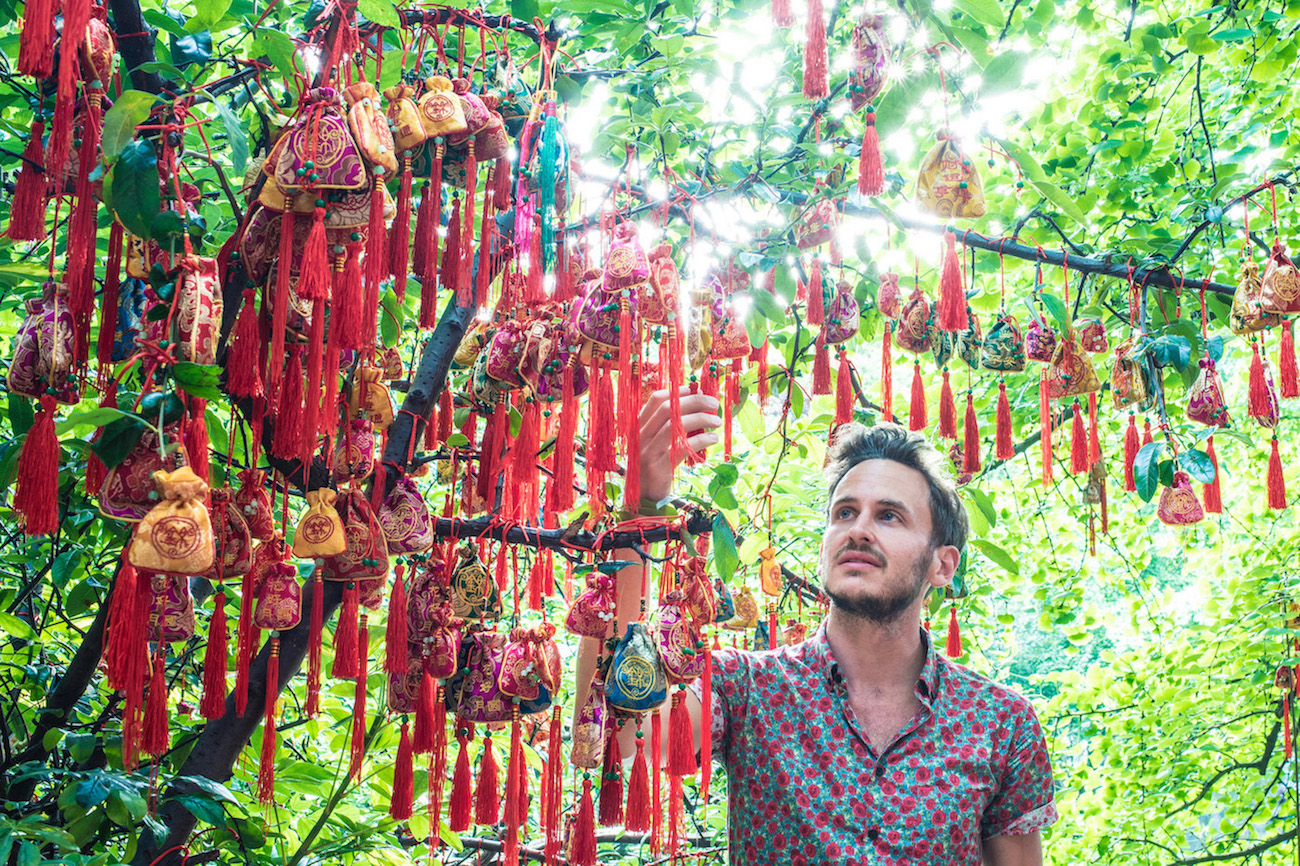
To say nothing of how enjoyable the provincial capital of Chengdu is—in addition to being what is perhaps the only laid-back major city in China, Chengdu is home to picturesque Jin Li Street , delectable food like sweet-and-spicy dan dan noodles, and is the gateway to Mt. Emei , among other amazing excursions. I’d further recommend traveling from Chengdu to Chongqing , a city that grew so massive so quickly that it became its own administrative region.
READ MORE: Three Days in Chengdu
Xi’an and Gansu
There are at least as many Xi’an attractions as what you’ll find in Beijing, Shanghai or any other city I’ve described, which is not surprising when you consider that this was China’s capital for a very long time. From the gorgeous Bell Tower in the middle of the city, to the Xi’an City Wall that surrounds it on all sides, to the vibrant Muslim Quarter , to the famous Terracotta Warriors , Xi’an is perhaps the most underrated city in mainland China.

Xi’an is also a convenient gateway to the region of Gansu , the final place I’m going to definitively recommend you add to your China itinerary— and not at all because a well-known travel publication did did . Indeed, while destinations such as the Tibetan city of Xiahe , Dunhuang at the entrance to the Gobi Desert and Zhangye (adjacent to the so-called Rainbow Mountains ) are outstanding, Gansu is in some ways the most difficult region of China to explore independently—don’t go in blind, as Lonely Planet would have you do in its crappy day to day China itinerary.
READ MORE: China’s Wild West
Other China Destinations
Excited about visiting Beijing, Xi’an and Sichuan, but still curious whether you’ll have time for a Tibet tour? The fact is that given China’s size, population and range of destinations, one trip (at least not one that lasts a month or less) is simply not enough to see everything—you’ve got to pick and choose.
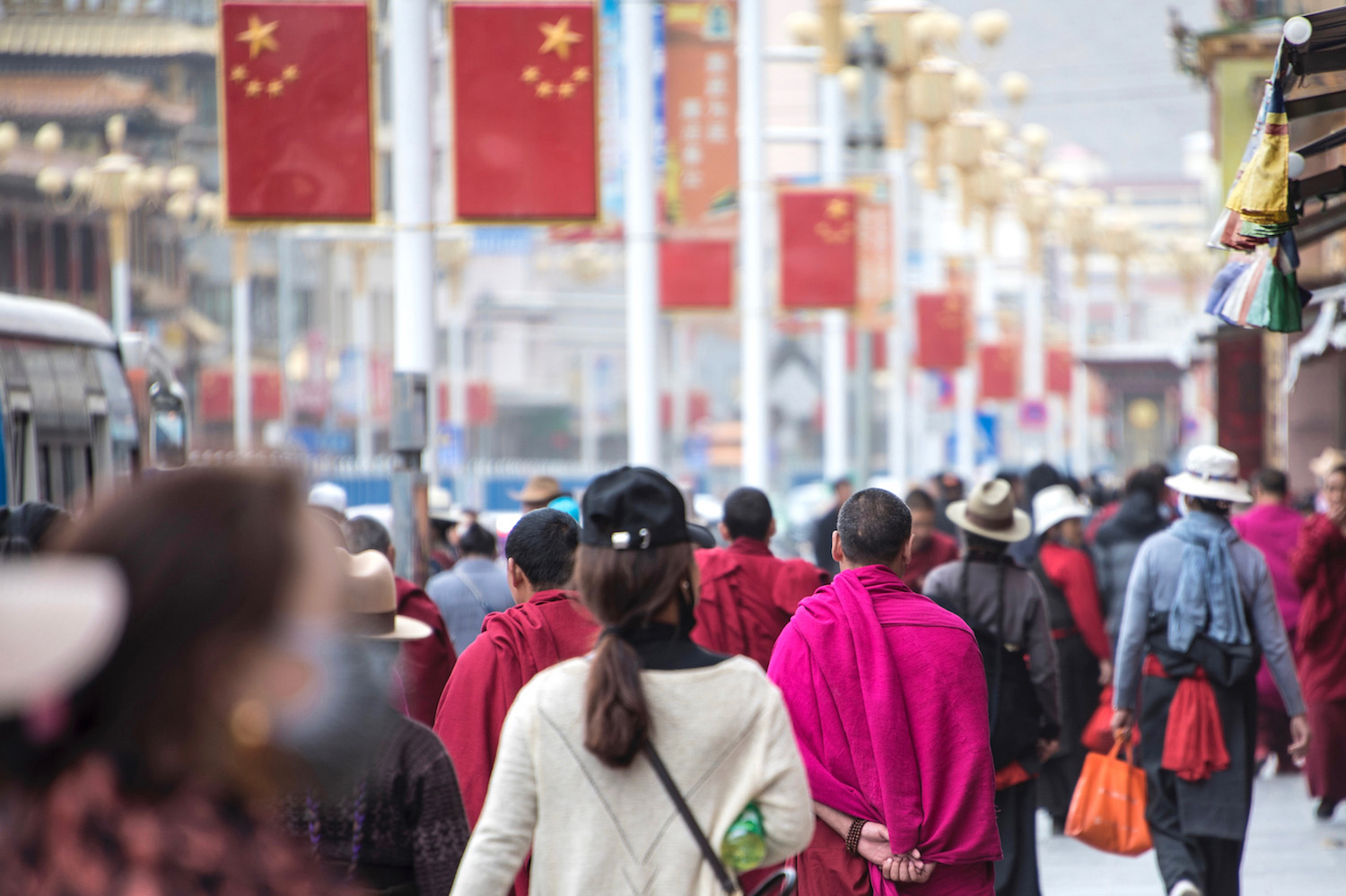
For example, if you do want to visit Tibet (which is a mixed bag at best, considering that you have to be with a guide 100% of the time), you’ll need to cut something else out your China travel itinerary, either your excursion to Gansu, or your time in one or more major cities, such as Shanghai or Hong Kong and the Pearl River Delta.
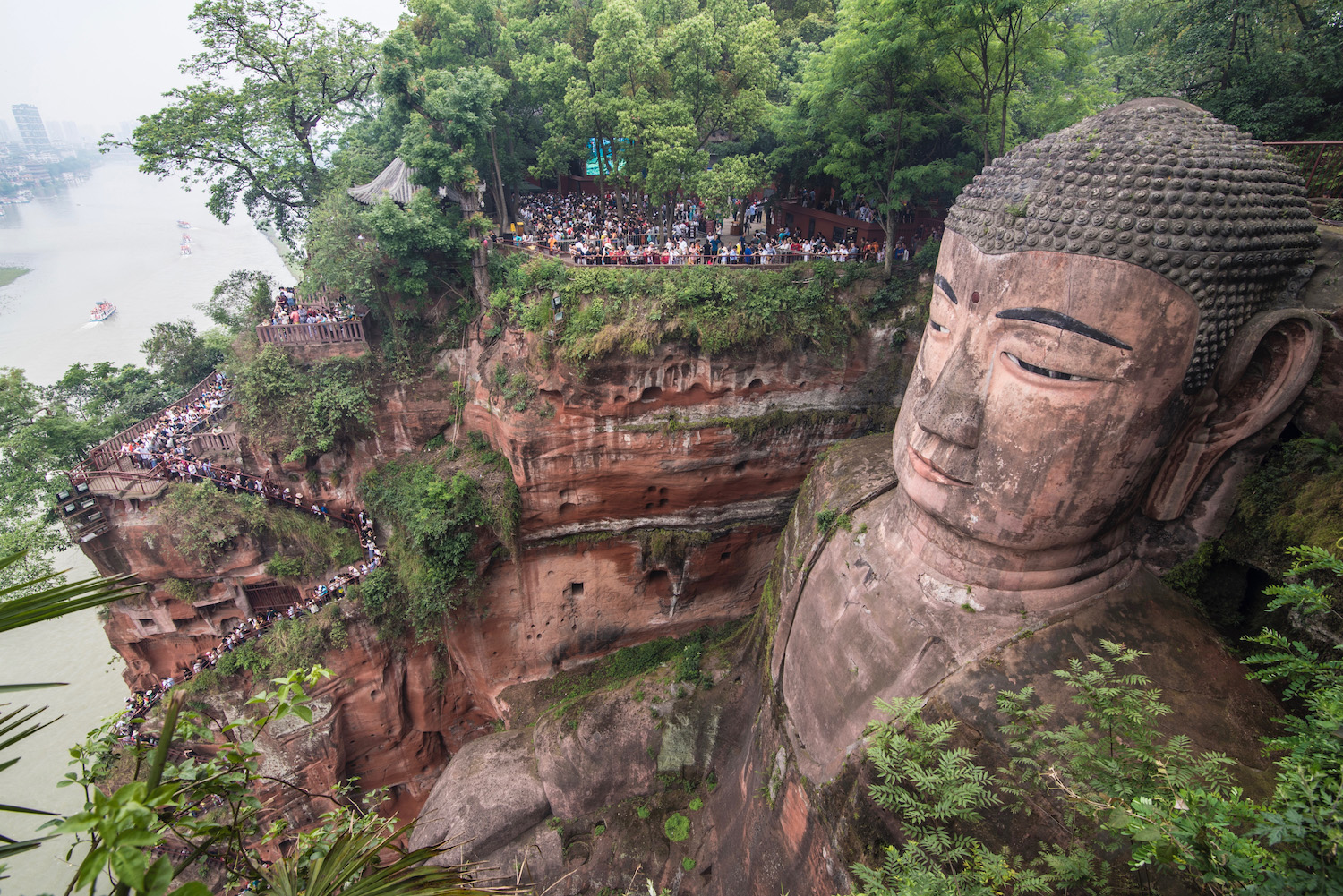
This is likewise the case for travel to regions like Yunnan or Xinjiang . Note that at the moment, you can visit both of these places independently, although there’s an argument to be made that Yunnan Tours will enhance your experience. If you are interested in visiting Muslim-majority Xinjiang province, meanwhile, you might want to head there sooner rather than later, as I can definitely see guided tours and travel permits being a requirement in the not-too-distant future).
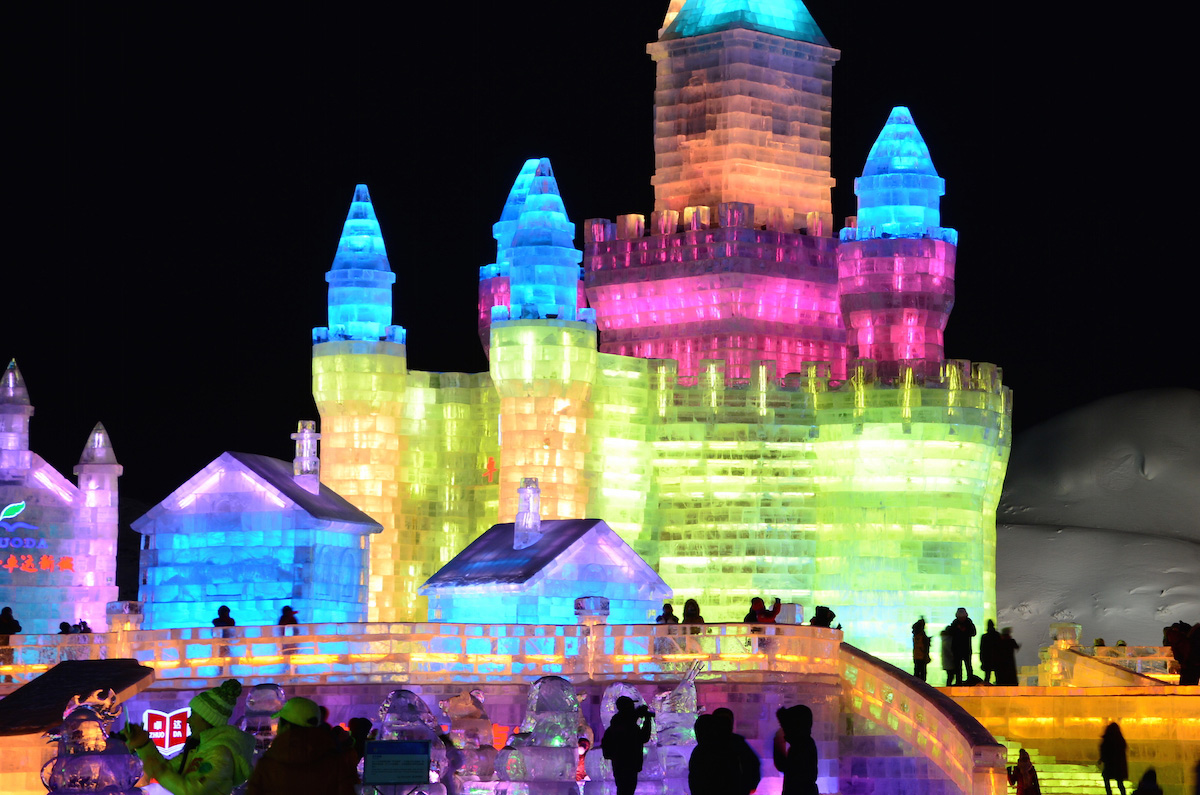
Other tertiary Chinese destinations and experiences are less disruptive to the rest of your trip. For example, if you don’t mind hopping a domestic flight, you can add a weekend at winter’s Harbin Ice Festival into the northern span of your visit to China. Likewise, destinations such as Guilin/Yangshuo (home to gorgeous riverine scenery) and lesser-visited cities like Tianjin and Xiamen aren’t necessarily massive excursions.
Sample 1 Month in China Itinerary
Assuming you spend about a month in China, the following would be a good place to start building out your trip:
- Beijing and the Great Wall (2-4 days)
- Shanghai and Vicinity (2-4 days)
- Hong Kong and the Pearl River Delta (3-5 days)
- Chengdu, Chongqing and Sichuan (5-7 days)
- Xi’an and Gansu (7-10 days)
In terms of other China destinations to add to your trip, this will depend greatly on how much time you have in total—or, if you’re spending one month, how much you have leftover after visiting major China tourist places.
Should You Visit China?
The Western media is extremely anti-China, though some of this is justified, especially after China allowed covid-19 to escape from Wuhan into the wider world. However, let’s start with the positive—if you’re asking “is China safe?,” it absolutely is. In addition to the fact that there’s essentially no crime in Chinese cities, the Chinese government has gone to great lengths to ameliorate many aspects of public safety in recent years, from infrastructural improvements, to higher standards of food sanitation, to cracking down on hacks who scam visitors. Though parts of China (especially in rural areas) are definitely still third-world, no other country I’ve visited has made as much progress in as short of time as China.
On the other hand, it would be irresponsible to ignore all the human rights abuses in China, and how they’re linked to the country’s advancement, in many instances. These include well-known cases like ethnic cleansing in Tibet and Xinjiang, to Chinese aggression toward sovereign Taiwan , to the forced relocations that preceded the 2008 Beijing Summer Olympics, to widespread censorship, to the fact that China doesn’t have a great record on LGBT rights, women’s rights or a whole host of other issues. I would be a hypocrite to recommend against traveling to China, given that I’d lived and traveled extensively there, but you need to travel with your eyes open.
Other FAQ About Visiting China
How much money do i need for 2 weeks in china.
A trip to China can be as cheap or expensive as you make it, but most travelers will spend around $100 per person, per day. Factoring in the cost of round-trip flights from the US or Europe, you can expect to spend around $2,000-3,000 for two weeks in China, assuming you stay in 3-star hotels and fly coach.
How long should you spend in China?
If it’s your first trip and you want to explore broadly, I recommend spending about a month in China. On the other hand, a properly calibrated shorter trip (say, two weeks in China split between Shanghai, Beijing and Chengdu, or focused on single regions like Gansu or Yunnan) can also work well.
What do I need to know before I go to China?
China deservedly evokes strong reactions from people, myself includes, but the reality is that such a large country—such an old civilization—is more complex than even the hottest hot takes. Among other things, realize that no matter what issues you have with the Chinese Communist Party, or the increasingly dystopian society they’ve built, Chinese people are kind and just as curious about you as you are about them!
The Bottom Line
If you haven’t hammered out your China itinerary by now, you’re a lot closer. I’ve not only just talked you through the most essential China destinations and experiences, but have clearly answered the practical questions you’ll have as you plan your China trip. I’ve even provided a sample China trip plan, which you can easily use as a basis for your own visit. Still need extra help planning your trip to China? Hire me as your Travel Coach, and allow me to build you a custom China itinerary.

Subscribe to email updates!
Words, images and design ©2009-2024 Robert Schrader, All rights reserved. Read Privacy Policy or view sitemap .
Exploring China: A One-Month Itinerary for the Ultimate Adventure
China is a land of contrasts, where ancient traditions coexist with modern developments. Its cities are bustling metropolises, while its countryside is dotted with picturesque villages and breathtaking natural landscapes. With a rich cultural heritage and a wide variety of things to see and do, China is a destination that offers something for everyone. If you’re planning a one-month trip to China, here’s an itinerary that will help you make the most of your time.
Day 1-5: Beijing Start your adventure in Beijing, the capital of China and one of the most historically and culturally rich cities in the world. Begin by visiting the iconic Forbidden City, a UNESCO World Heritage Site and the former imperial palace of the Ming and Qing dynasties. Next, take a stroll along the ancient hutongs, traditional alleyways that offer a glimpse into the city’s past. Don’t miss the Temple of Heaven, a complex of religious buildings where emperors of the Ming and Qing dynasties would offer sacrifices to the gods.

Day 6-8: Xian Fly to Xian, the ancient capital of China, where you’ll find some of the country’s most important historical sites. Visit the Terracotta Warriors, a collection of thousands of life-sized statues that were buried with the first emperor of China to protect him in the afterlife. Xian is also home to the ancient city walls, which offer great views of the city.
Day 9-12: Guilin Take a flight to Guilin, a beautiful city in southern China known for its karst landscapes and scenic rivers. Take a cruise along the Li River and admire the towering limestone peaks that rise up from the water. Visit the Reed Flute Cave, a limestone cave filled with colorful rock formations and stalactites.
Day 13-16: Shanghai Fly to Shanghai, the largest city in China and a major center of finance and culture. Take a walk along the Bund, a promenade that offers great views of the city’s skyline. Visit the Shanghai Museum, which has an extensive collection of Chinese art and artifacts.
Day 17-20: Chengdu Fly to Chengdu, a city in southwestern China that is known for its relaxed atmosphere and delicious food. Take a trip to the Chengdu Research Base of Giant Panda Breeding, where you can see giant pandas up close. Visit the Wenshu Monastery, the oldest and largest Buddhist temple in the city.
Day 21-24: Yangshuo Take a train to Yangshuo, a small town in southern China that is surrounded by stunning karst landscapes. Take a bike ride through the countryside and admire the limestone peaks that rise up from the rice paddies. Visit the Moon Hill, a natural arch that offers great views of the surrounding area.
Day 25-28: Hong Kong Take a flight to Hong Kong, a special administrative region of China that is known for its bustling city life and vibrant culture. Visit Victoria Peak, which offers great views of the city. Take a trip to the Big Buddha, a bronze statue of the Buddha that sits on top of Lantau Island.
Day 29-30: Macau Take a ferry to Macau, a former Portuguese colony that is now a special administrative region of China. Visit the ruins of St. Paul’s, a 17th-century church that is now a UNESCO World Heritage Site. Take a walk along the Senado Square, a paved square lined with colonial-style buildings.
This itinerary provides a great introduction to some of the most interesting and diverse places in China, from the ancient city of Xian to the modern metropolis of Shanghai, and from the scenic landscapes of Guilin and Yangshuo to the cultural melting pot of Hong Kong and Macau. Of course, there are many more places to explore in China, and this itinerary is just a starting point. Feel free to adjust it to suit your interests and budget. No matter what you choose to do and see, China is sure to leave a lasting impression on you.
Leave a Comment Cancel Reply
Your email address will not be published. Required fields are marked *
Save my name, email, and website in this browser for the next time I comment.

Anna Sherchand
Solo Female Travel Blog
Backpacking China itinerary for 1 month
If you are looking for the best backpacking China Itinerary for First-Timers, you have found it! I solo traveled to China for a month and absolutely loved it! In this article, I will cover what route I took and my suggested must-see places for you.
As the second-largest country in Asia, China has a lot to offer for each wandering soul. It is a country rich in biodiversity and cultural preservation. This country of approximately 1.438 billion people provides a tempting array of tourist destinations – mountains, rivers, rice terraces, historical sites, food hubs, floras and faunas, natural wonders, and man-made scenic spots.
If you are dreaming of spending your travel days in this giant country of the East, Here is your one-month backpacking China travel guide to the home of the red dragon!
- Backpacking China itinerary for First-Timers
Do I need a visa for travelling to China?
Is it safe to travel to china as a solo female traveler, one month backpacking china itinerary, week 1 – guilin, china, week 2 – longji, xingping, and yangshou, week 3 – hunan/yunnan or xian.
- Let me know in the comments:
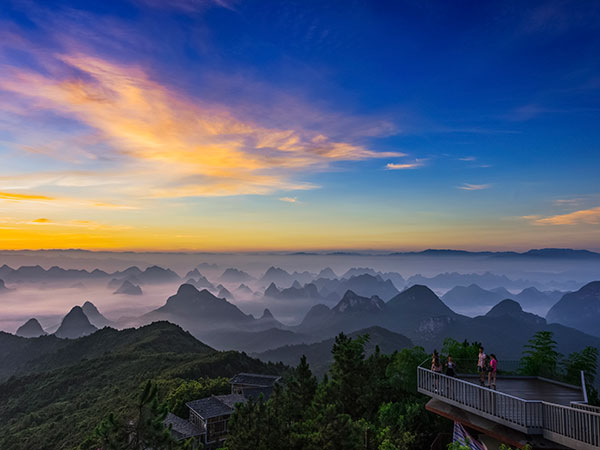
But first FAQs,
As an Australian passport holder, I needed a visa to enter China. I found the application process was straight forward- what I did was I went to the Chinese embassy, asked for the tourist visa form, came back home, filled it requesting for 1-month Chinese visa then went back the next morning with 1 passport size and visa money. They took my passport and said will notify me when it is ready to be picked up with the visa stamp on it. Please bear in mind, I applied for a Chinese visa when I was in Hanoi, Vietnam.
That being said, most nationalities need a visa to visit China. In fact, it is the first step, the application process is straightforward, just follow the requirements and you will get that done in no time. Also, the visa fee differs depending on the length of the visa you are applying for.
In my opinion and experience of traveling around China alone, I found it to be safe. I’ve never been shown anything but friendliness and curiosity by local Chinese people. Something worth adding here is, no matter where you travel in the world the same traveling rules still apply. ie: don’t walk alone at midnight or poorly lit area, don’t get too drunk, avoid talking about politics, or religion and just be respectful to people.
I am going to start with one of the stunning places I have ever seen. Guilin. The reason being is, I took the night train from Hanoi, Vietnam to Nanning followed by a bus to Guilin. It was a peaceful and budget trip. I stayed in hostels, and spend less than $5 per day eating street food and traditional Chinese food. Let me elaborate!
Guilin is a destination in China that will enthrall you with its scenic rivers, mountains, karsts, terraces, and caves. It is located in southern China and is popular because of its natural wonders.
How to go to Guilin from Nanning
I took a night train from Hanoi, Vietnam to Nanning, China. Then from Nanning a local bus to Guilin. Alternatively, you can fly to Nanning Airport, take a bus, which leaves every 30 minutes, and head to Nanning Station (Minhang Hotel). Walk for approximately 6 minutes to take the train from Nanning to Guilin. Travel time will take almost three hours.
What to see in Guilin?
Explore the city starting at Seven Star Park. It is called Seven Star Park because of the seven mountain peaks which form a big dipper. Walking to this park will only take you 20 minutes. You might want to consider strolling and enjoying scenic spots or dining areas as you head to the park.

• Seven Star Park This park, located on the eastern part side of the Li River, has several attractions to offer. It is the biggest park in the city and has a cave, a zoo, a flower bridge, and the seven hills.
• Reed Flute Cave The Reed Flute Cave’s name came from a type of reed that can be made into a flute, which is present everywhere outside the cave. You can find plenty of these plants outside the cave. A Japanese troop rediscovered this cave in 1940, and in 1962, it became a tourist attraction in Guilin. A considerable number of stalactites, stalagmites, and other rock formations fill the interior of the cave. One magical feature of this cave is the artificial rainbow reflection illuminating the cave’s interior.
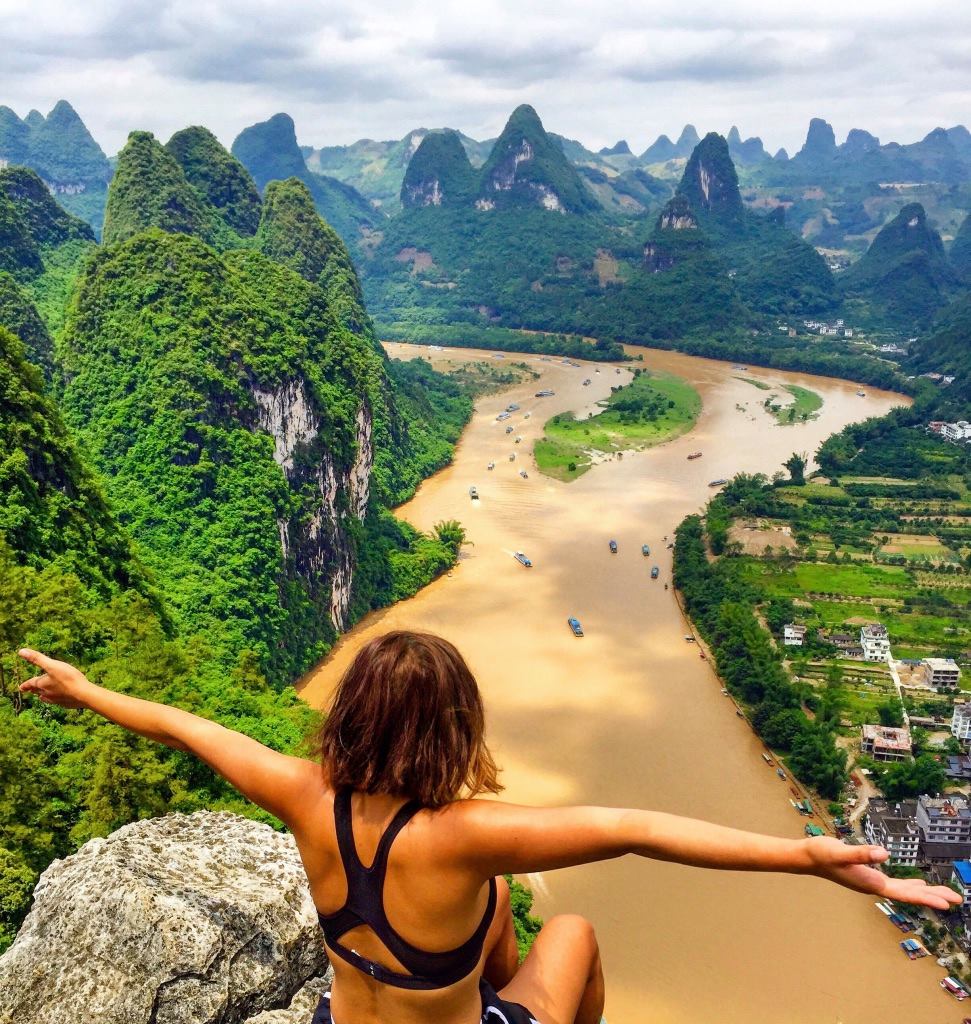
• Yao Mountain Your visit to Guilin is not complete without visiting the peak of the highest mountain in Guilin, the Yao Mountain. Once you’re on the mountain summit, your eyes will feast on the never-ending karst mountain ranges and the gentle-flowing Li River. The scenic view and the fresh air are unparalleled and precious memories you can bring back home.
• Sun and Star Pagoda An underwater 10-meter glass tunnel connects the twin pagodas, and it is best to visit them at night because of their beautiful colors. The Sun Pagoda, which has nine stories, is the world’s highest pagoda.
At night time, the silver and gold reflection of the two are marvels to behold. The view of Guilin from the top of the pagodas is genuinely relaxing and peaceful.
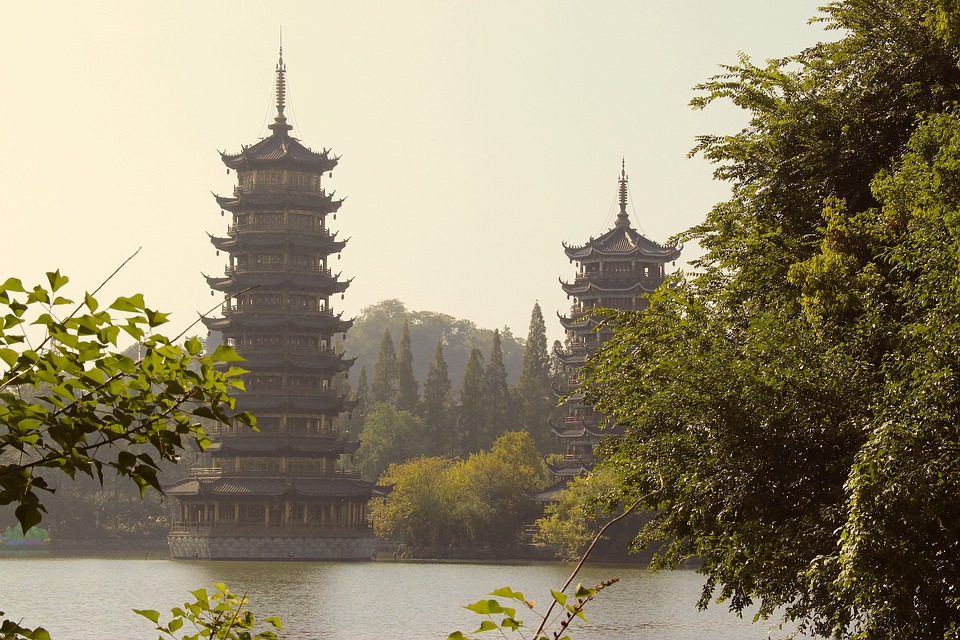
• Jingjiang Prince City A visit to Jingjiang Prince Palace or Jingjiang Prince City will let you travel back to olden times. This tourist attraction, located in the center of Guilin, is a one-of-a-kind tourist destination. The palace, surrounded by natural and human-made sceneries, was the residence of Prince Jingjiang of the Ming Dynasty.
• Elephant Trunk Hill Elephant Trunk Hill is Guilin’s symbol and landmark. The hill seems like an elephant drinking water from the river.
• Yubo Shan Climb to the top of the 700-feet tall Yubo Shan (伏波山 ‘Subduing Waves Hill’) and savor the irresistible scenic view of any poet, artist, and visitors.
There are two attractions at Yubo Shan: Returning Pearl Cave and the Thousand Buddha Crag.
One week Guilin itinerary
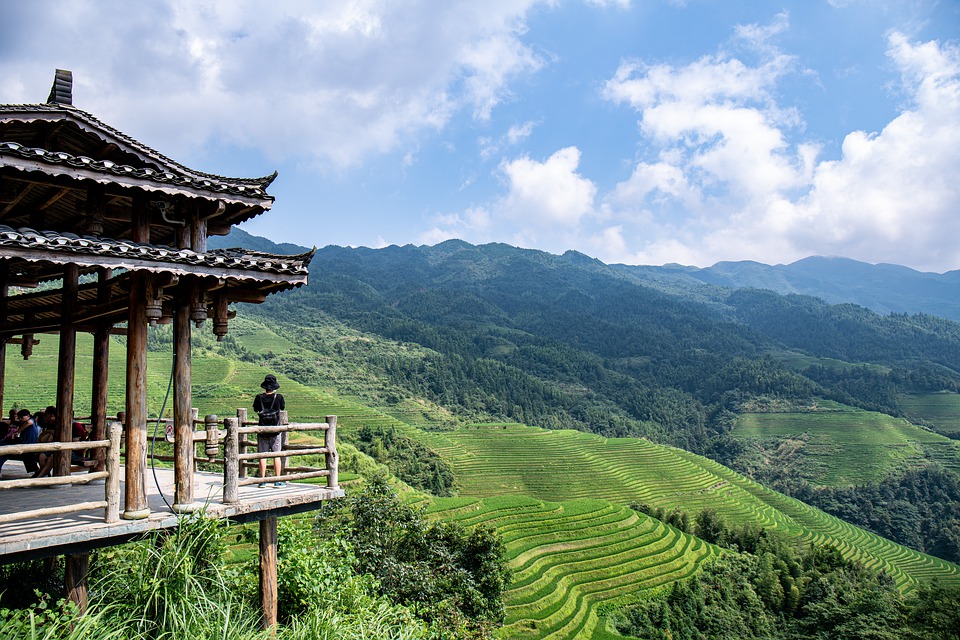
• Longji Rice Terraces It takes more than two hours to reach Longji Rice Terraces at Longsheng from Guilin. You may coordinate with your hotel to reserve bus tickets for you the day before to avoid hassles. There are two villages you can visit in Longsheng – the Ping’ an and Dazhai. You can start your cultural immersion and exploration at Dahzai, where you can stay overnight before heading to Ping’an the following day.
• Li River Cruise from Guilin to Xingping National Geographic dubs Li River or Li Jiang as one the “Ten Water Wonders of the World.” One traditional way to enjoy the view of Li River is to take a 2-hour bamboo raft ride from Yangdi pier.
The two-hour river cruise will give you the best view of the towering mountain karsts under the blue sky. Likewise, the verdant mountains surrounding the river never fail to capture every soul passing by the river.
• Xingpin Ancient Street Walking on the pavements of Xingping Ancient Street is like a travel back to ancient times. The locals have preserved their residences well, and this rustic view captivates their visitors’ hearts.

• Yellow Cloth Shoal The best place to take your picture of the panoramic view found in the 20 RMB banknote is to head to Yellow Cloth Shoal. This breath-taking reflection of the karst hill on the waters of Li River is worth more than 20 RMB.
• West Street West Street, located at the Yangshuo center, is another place to visit in the Yangshuo district. This street that stretches more than 500 meters is at the center of Yangshuo County. It is paved with marbles, and foreigners admire this rustic, country setting.
• Yangshou Park Walk for about 11 minutes from West Street and reach Yangshou Park. Yangshuo Park covers an area of approximately 230,000 sq m. Here, you can stroll under osmanthus trees and bamboos or rest for a while and watch locals exercising or playing chess.

• Moon Hill Moon Hill is one of the favorite destinations of mountain climbers since Yangshou is the venue of the Yangshuo Climbing Festival, attracting adventurers from all over the world. Also, the old town in Yanhshou is worth exploring and great for strolling and stopping for a drink surrounding with a great karst mountain view.
• Butterfly Spring Park There is a huge Monarch Butterfly model positioned on a cliff beside the gate to the Butterfly Spring Park. The 280 square meters model looks so real.
The major attraction in the park is the Butterfly Garden, where you can enjoy millions of colorful butterflies playing around the bushes.
• Ten-Mile Gallery The best way to enjoy the scenic views of the Ten-Mile Gallery is to riding a bike. Ten-Mile Gallery offers a long stretch of rolling hills, river views, and fields. You can see locals working in the fields, hear birds singing, and breathe fresh air.
On week 3 I decided to give you 3 options. So you can decide what you want to see the most.
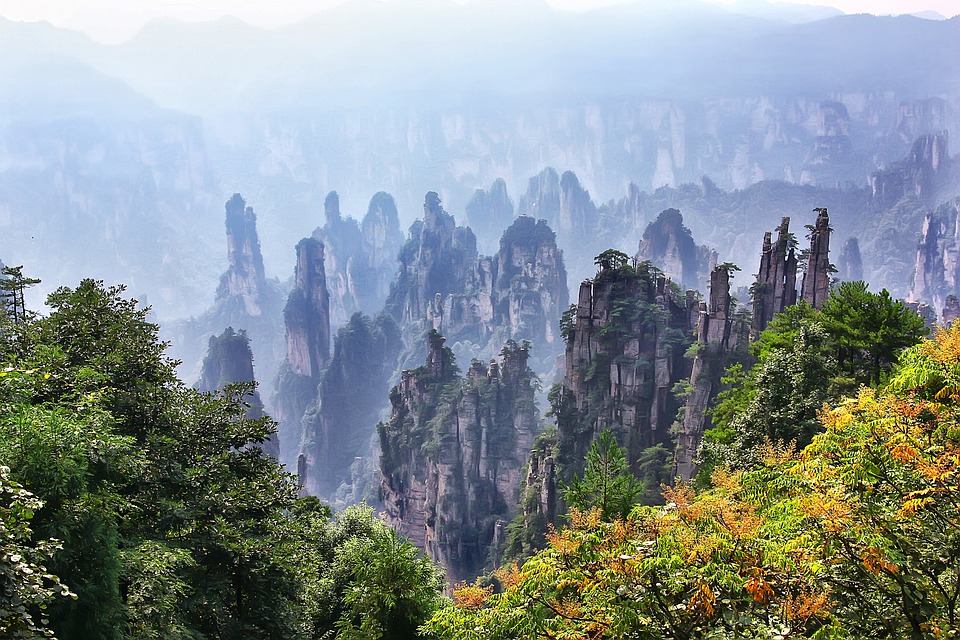
Option a . There are 8 ways to get from Guilin to Hunan by train, bus, taxi, car, or plane. The cheapest way is to train via Hengyang which costs $35 – $80 and takes 8h 24m. The quickest way is to taxi which costs $200 – $250 and takes 4h 48m. So within 5 hours, you could be exploring a completely different place! Such as Tianzi Mountain Clouds, the famous Avatar Zhangjiajie National Park, Tianmen National Park, Fenghuang Ancient City, Fenghuang, The Southern Great Wall, Fenghuang, Changsa.
Option b. There are 3 ways to get from Guilin to Xi’an by subway, plane, train, or car. The cheapest way is via train which costs $130 – $190 and takes 11h 36m. The quickest way is to line 2 subway and fly which costs $140 – $460 and takes 4h 39m. Must see in Xian is the giant panda breeding, emperor Qinshihuang’s Mausoleum Site Museum (The Terracotta Warriors), Giant Wild Goose Pagoda, Bell Tower of Xi’an, Fortifications of Xi’an, Shaanxi History Museum, Great Mosque of Xi’an and Huaqing Pool, Cuihua Mountain, and Mount Li for outdoors.

Option c. There are 4 ways to get from Guilin to Yunnan by train, car, plane, or taxi. The cheapest way is to get on the train which costs $45 – $90 and takes 22h 2m. The quickest way is to fly and train and taxi which costs $180 – $420 and takes 5h 7m. The highlights in Yunnan include Yuanyang Rice Terraces, tiger leaping gorge (Hutiao Xia), jade dragon snow mountain, Yulong Snow Mountain, and Glacier Park, Yunnan Shaxi Ancient Town, Lijiang Romance Park, Blue Moon Valley, Telugu lake and more.
Week 4 – Beijing
You have two options on how to reach the capital city of China, Beijing from Guilin – via train for 11 hours, or via plane for 3 hours.
What are the must-see in Beijing?
• Forbidden City Forbidden City or Palace Museum is the world’s largest palace complex. It is located at the center of Beijing, covers 74 hectares, and has 8,700 rooms. It was named Forbidden City in ancient times because nobody was allowed to enter without the emperor’s permission.
Since it is no longer a forbidden thing to explore to the palace, you can go around and be amazed by the architectural designs and royal treasures in every room.
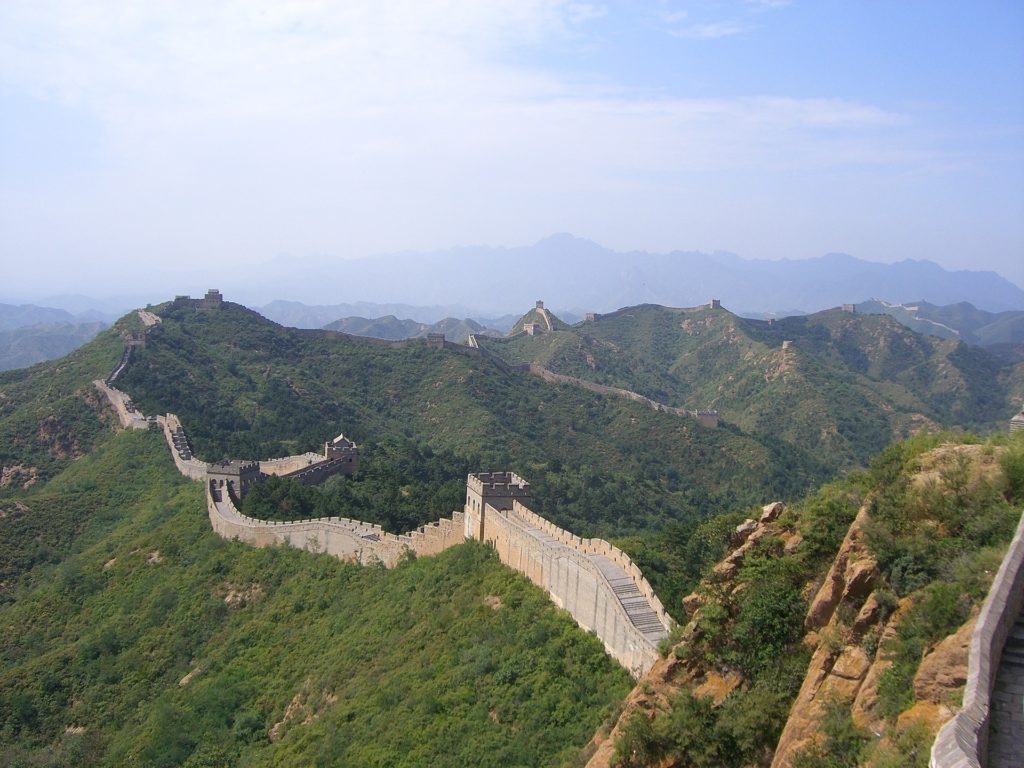
• Great Wall of China The Great Wall of China is one of the wonders of the ancient world and is the longest wall in the world. The Chinese built the wall as protection from invaders. Now, this 21,196-kilometer wall is one of the main attractions in the country.
• Prince Gong’s Mansion Like any ancient royal residences, Prince Gong’s Mansion boasts of Chinese architectural designs, royal emblems, and furniture. There are artificial hills, with stunning landscapes, outside the palace that will offer you a peaceful visit.
• Wuta Temple Five temples offered to Buddha consist of the Wuta Temple or Five Pagoda Temple in Bejing. Each of these temples fused Indian patterns with Chinese architectural designs.
The base of the temple has six stories. On top of this square foundation are the five temples. The four temples in each corner have 11 levels, while the middle one is higher by two.
• Tiananmen Tower Tiananmen Tower is famous for its five arches. The biggest archway at the center was explicitly for emperors, while the four smaller ones on the sides were for ministers. There are two columns carved with lion designs on both sides of the main entrance.
In front of the tower, you can see a bridge made of white marbles and delicate carvings.
• National Museum of China Near Tiananmen Tower is the National Museum of China, which houses relics, memorabilia, historical artifacts, and other exhibits.
The oldest display in the museum is the teeth of Yuanmou Man, which was from 1.7 million years ago!
I hope this one-month backpacking china itinerary helps you in your preparation to travel China. China is not only an economic tiger but a perfect tourist destination. Clear your one-month schedule and head to this giant and yet gentle dragon in the East!

Let me know in the comments :
- If you have any questions about this 1-month backpacking China itinerary?
- Interested in another Asian gem? 2 weeks Bali itinerary is here!
- How about Thailand itinerary for 10 days
- What to see in Sofia in 1 day
- What to do in Monaco for a day
- Find the best Sofia tours you can take
- Here are the 7 unusual things to do in Sofia
- Check out what to do in Prague in September next.
- Don’t miss the 10 must see instagrammable cafes in Hanoi
- Check out all the Australia travel guide (Everything you need to know about traveling to Sydney is here)
- Solo travel guide to Brisbane (Gold coast and Insta worthy places included!
- Exploring Adelaide the best way is a must-read
- Best Australia travel guide to Uluru trip
- Attractions in Perth, Western Australia
- Must see on the east coast of Australia is fun, it includes barrier reef, beautiful national park, and more exciting places and activities
- Here I blog about the Melbourne attractions
- If you need to book accommodations for your next travels, open a new Airbnb account with my link and use this $76 Airbnb discount for your first booking.
- Sign up to my e-mail list to receive travel Italy tips next!
- ← Best things to do in Thredbo, Australia
- 11 fun things to do when staying indoor →
You May Also Like

Dili Timor Leste solo travel itinerary
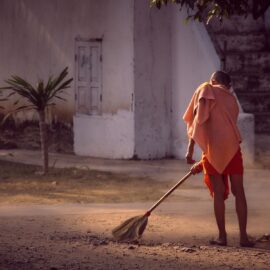
Top 5 Monasteries In Nepal For Meditation
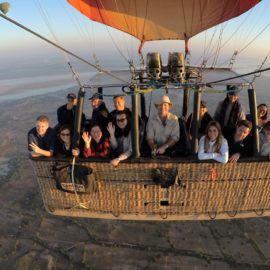
Balloons over Bagan review
Leave a reply cancel reply.
Your email address will not be published. Required fields are marked *

- Your cart is currently empty.
- The Ultimate China Travel Itinerary: Explore the Best of China in One Month!
Planning a trip to China? Look no further! In this comprehensive travel itinerary, we will guide you through an unforgettable month-long journey across the diverse landscapes and vibrant cities of this captivating country. Get ready to immerse yourself in ancient traditions, modern marvels, and breathtaking natural wonders as we unveil the best of China’s cultural treasures.
Must-Visit Destinations in China for a One-Month Travel Itinerary
China is a vast and diverse country, offering countless incredible destinations to explore. When planning a one-month trip to China, it’s important to choose the must-visit destinations that will give you a well-rounded experience of the country’s rich culture, history, and natural beauty.
No trip to China would be complete without a visit to its bustling capital city, Beijing. From iconic landmarks like the Great Wall of China and the Forbidden City to delicious street food and vibrant markets, Beijing has something for everyone. Spend a few days exploring the historic sites, such as the Temple of Heaven and Tiananmen Square, before diving into the city’s modern side with visits to art galleries and trendy neighborhoods like Sanlitun.
If you’re looking for a taste of modern China, Shanghai is the place to be. This cosmopolitan metropolis is known for its futuristic skyline, bustling shopping streets like Nanjing Road, and vibrant nightlife scene. Don’t miss out on visiting The Bund, where you can admire colonial-era architecture while taking in stunning views of Pudong’s skyscrapers across the Huangpu River.
Xi’an
To delve into China’s ancient history, head to Xi’an. This ancient capital was once the starting point of the Silk Road and is home to one of China’s most famous attractions – the Terracotta Army. Marvel at thousands of life-sized terracotta warriors buried with Emperor Qin Shi Huang over 2,000 years ago. Xi’an also offers beautiful mosques, traditional pagodas, and a vibrant Muslim Quarter filled with delicious street food stalls.
For breathtaking natural scenery, Guilin is a must-visit destination in China. Explore the stunning karst landscapes along the Li River, where you can take a leisurely boat cruise or go hiking and biking through picturesque rice terraces. Don’t miss out on visiting the nearby Longji Rice Terraces, known for their incredible beauty and unique farming practices.
If you’re a fan of adorable pandas, Chengdu is the place to be. Visit the Chengdu Research Base of Giant Panda Breeding to get up close and personal with these lovable creatures. Besides pandas, Chengdu is also famous for its spicy Sichuan cuisine, so make sure to indulge in some mouth-watering hotpot and mapo tofu while you’re there.
List of Must-Visit Destinations:
A one-month trip to China will allow you to explore these incredible destinations and more. Make sure to plan your itinerary carefully to make the most of your time in this fascinating country.
How to Make the Most of Your Time in Beijing on a One-Month Trip
Exploring historical sites.
Beijing, the capital of China, is rich in historical sites that are worth exploring during your one-month trip. Start by visiting the iconic Forbidden City, a vast palace complex that served as the imperial residence for centuries. Spend a day wandering through its opulent halls and beautifully landscaped gardens. Another must-visit historical site is the Temple of Heaven, where emperors used to pray for good harvests. Marvel at its unique architecture and serene atmosphere as you explore the various temples and pavilions within the complex.
Immersing in Local Culture
To truly make the most of your time in Beijing, immerse yourself in the local culture. Visit traditional hutong neighborhoods, such as Nanluoguxiang or Dashilar, where you can stroll along narrow alleyways lined with old courtyard houses. Experience traditional tea ceremonies or try your hand at calligraphy classes to gain insight into Chinese customs and traditions.
- Consider hiring a local guide who can provide deeper insights into Beijing’s history and culture.
- Avoid visiting popular attractions during weekends or national holidays to avoid crowds.
- Learn a few basic Mandarin phrases to enhance your interactions with locals.
Off-the-Beaten-Path Attractions in China for Your One-Month Travel Itinerary
In addition to popular tourist destinations, China offers numerous off-the-beaten-path attractions that will add depth to your one-month travel itinerary. Consider including these hidden gems:
Zhangjiajie National Forest Park
Located in Hunan province, Zhangjiajie is known for its breathtaking sandstone pillars that inspired the floating mountains in the movie “Avatar.” Explore its stunning landscapes by hiking along the various trails, taking a cable car ride, or admiring the panoramic views from the glass-bottomed Skywalk.
Jiuzhaigou Valley
Nestled in Sichuan province, Jiuzhaigou Valley is a UNESCO World Heritage site renowned for its colorful lakes, waterfalls, and snow-capped peaks. Take leisurely walks around the turquoise lakes or venture deeper into the valley to discover hidden waterfalls and alpine scenery.
- Plan ahead and check if any permits are required to visit these off-the-beaten-path attractions.
- Consider hiring local guides who can provide insights into the unique features and history of each location.
- Be prepared for varying weather conditions and pack appropriate clothing and gear.
Ideal Route for Traveling Across China in a Month, Starting from Beijing
If you have one month to travel across China starting from Beijing, consider following this ideal route:
Spend a few days exploring Beijing’s historical sites such as the Forbidden City, Temple of Heaven, and Great Wall of China. Immerse yourself in local culture by visiting traditional hutongs or attending cultural activities.
Take a high-speed train to Xi’an, where you can marvel at the Terracotta Army and explore ancient city walls. Don’t miss trying Xi’an’s famous street food like roujiamo (Chinese hamburger) or yangrou paomo (crumbled bread soaked in lamb soup).
Head southwest to Chengdu, known for its giant pandas and spicy Sichuan cuisine. Visit the Chengdu Research Base of Giant Panda Breeding to observe these adorable creatures up close. Indulge in a hot pot feast or explore the vibrant street food scene.
Travel east to Shanghai, China’s largest city and a global financial hub. Explore the iconic Bund waterfront area, visit traditional gardens like Yu Garden, and experience the bustling nightlife in areas like Nanjing Road and Xintiandi.
- Book train tickets in advance to secure seats on popular routes.
- Consider adding additional destinations based on your interests and preferences.
- Allocate enough time in each city to fully explore its attractions and immerse yourself in the local culture.
Allocating Time to Explore the Great Wall of China During Your One-Month Trip
The Great Wall of China is a must-visit attraction during your one-month trip. To allocate sufficient time for exploring this iconic landmark:
Mutianyu Section
Spend a full day at the Mutianyu section of the Great Wall, located about 70 kilometers northeast of Beijing. This section offers stunning views and is less crowded compared to other sections like Badaling. Take your time hiking along the wall, admiring its architectural marvels, and capturing memorable photos.
Jinshanling Section
If you have extra time, consider visiting the Jinshanling section of the Great Wall. Known for its well-preserved watchtowers and picturesque landscapes, this section offers a more challenging hike but rewards you with breathtaking views. Plan for a day trip or even an overnight stay in a nearby guesthouse to fully experience the beauty of this section.
- Wear comfortable shoes and clothing suitable for hiking.
- Bring water, snacks, and sunscreen as there may be limited facilities along the wall.
- Consider hiring a local guide who can provide historical and cultural insights during your visit.
Festivals and Events to Consider When Planning Your One-Month Itinerary in China
China is known for its vibrant festivals and events that showcase its rich cultural heritage. Consider including these festivals in your one-month itinerary:
Chinese New Year (Spring Festival)
Celebrated between late January and mid-February, Chinese New Year is the most important traditional festival in China. Experience colorful parades, dragon dances, fireworks, and indulge in traditional New Year’s feasts. Beijing, Shanghai, and Hong Kong are popular destinations to witness the festivities.
Duanwu Festival (Dragon Boat Festival)
Held on the fifth day of the fifth lunar month (usually June), the Dragon Boat Festival features exciting dragon boat races and the consumption of sticky rice dumplings called zongzi. Visit cities like Suzhou or Hangzhou to witness thrilling boat races on picturesque waterways.
- Check festival dates well in advance as they follow the lunar calendar.
- Book accommodations early as popular festival destinations tend to get crowded.
- Immerse yourself in local traditions by participating in festival activities or trying festive foods.
Recommended Cities and Regions to Visit Outside of Beijing on a One-Month Trip to China
While Beijing offers numerous attractions, exploring other cities and regions outside the capital can enhance your one-month trip to China. Consider including these recommended destinations:
Known for its modern skyline and vibrant atmosphere, Shanghai offers a stark contrast to Beijing’s historical charm. Explore the Bund, visit the Shanghai Museum, and indulge in world-class shopping and dining experiences.
Guilin and Yangshuo
Located in southern China, Guilin and Yangshuo are famous for their karst landscapes and picturesque scenery. Take a cruise along the Li River, explore the Reed Flute Cave, or cycle through the stunning countryside of Yangshuo.
- Consider domestic flights or high-speed trains for efficient travel between cities.
- Research local specialties or unique attractions in each destination to make the most of your visit.
- Allot enough time in each city or region to fully experience its highlights without feeling rushed.
Budget-Friendly Accommodation Options for Long-Term Stays During a Month-Long Trip to China
If you’re planning a month-long trip to China on a budget, consider these budget-friendly accommodation options:
Hostels are a popular choice among budget travelers as they offer affordable dormitory-style rooms or private rooms at lower prices compared to hotels. They often provide communal areas where you can socialize with fellow travelers.
Airbnb or Vacation Rentals
Renting an apartment or room through Airbnb or other vacation rental platforms can be more cost-effective for long-term stays. It allows you to have a home-like experience and access to kitchen facilities, which can help save money on meals.
- Read reviews and check the location of accommodations to ensure they meet your needs.
- Consider staying in less touristy areas for lower prices.
- Book accommodations well in advance, especially during peak travel seasons.
Visa Requirements and Restrictions for a One-Month Trip to China
Before planning your one-month trip to China, it’s important to understand the visa requirements and restrictions:
Tourist Visa (L Visa)
Most travelers will need a tourist visa (L visa) to enter China. The application process typically requires a valid passport, completed application form, recent passport-sized photo, round-trip flight itinerary, and proof of accommodation.
Duration of Stay
The standard duration of stay for a tourist visa is 30 days. However, it’s essential to check the specific entry requirements based on your nationality as some countries may have different agreements with China regarding visa durations.
- Contact the nearest Chinese embassy or consulate in your country for up-to-date information on visa requirements.
- Apply for your tourist visa well in advance of your planned trip to allow sufficient processing time.
- Ensure your passport has at least six months’ validity beyond your intended departure date from China.
Including Tibet in Your One-Month Travel Itinerary through China: How Much Time to Allocate?
If you wish to include Tibet in your one-month travel itinerary through China, it’s important to allocate enough time to fully experience this unique region:
Plan to spend at least three to four days in Lhasa, the capital of Tibet. Explore iconic attractions such as the Potala Palace, Jokhang Temple, and Barkhor Street. Take your time acclimatizing to the high altitude and immerse yourself in Tibetan Buddhist culture.
Mount Everest Base Camp
If you’re up for an adventure, consider allocating additional days for a trip to the Mount Everest Base Camp. The journey from Lhasa can take around five days, including stops at scenic spots like Gyantse and Shigatse.
- Obtain the necessary permits for traveling to Tibet well in advance through a reputable travel agency or tour operator.
- Be aware of altitude sickness symptoms and take proper precautions during your visit.
- Respect local customs and traditions while visiting monasteries or religious sites in Tibet.
Unique Cultural Experiences and Activities during Your Month-Long Stay in China
Immerse yourself in unique cultural experiences and activities during your month-long stay in China:
Kung Fu Training
Enroll in a short-term Kung Fu training program where you can learn basic martial arts techniques from experienced masters. This allows you to gain insight into Chinese martial arts culture while improving physical fitness.
Cooking Classes
Participate in cooking classes where you can learn how to prepare traditional Chinese dishes like dumplings, noodles, or Peking duck. These classes often include visits to local markets to select fresh ingredients.
- Research and book cultural experiences or classes in advance to secure your spot.
- Check reviews and credentials of instructors or schools offering cultural activities.
- Engage with locals and fellow travelers to learn more about Chinese culture and traditions.
Health and Safety Precautions While Traveling Around China for a Month
While traveling around China for a month, it’s important to take health and safety precautions:
Food and Water Safety
Be cautious when consuming street food or eating at local establishments. Stick to cooked foods, avoid tap water, and opt for bottled water or boiled water. Wash your hands frequently or use hand sanitizers to prevent the spread of germs.
Travel Insurance
Purchase comprehensive travel insurance that covers medical expenses, trip cancellation, lost luggage, and other unforeseen circumstances. Ensure the policy includes coverage for activities you plan to engage in during your trip.
- Carry a basic first aid kit with essential medications, bandages, and any necessary prescriptions.
- Stay updated on travel advisories and follow local laws and regulations.
- Avoid crowded places during peak hours to minimize the risk of theft or pickpocketing.
Reputable Tour Operators or Travel Agencies Specializing in Customized Itineraries for a Month-Long Trip to China
1. china highlights.
China Highlights is a highly reputable tour operator that specializes in creating customized itineraries for travelers visiting China. With over 20 years of experience, they have a team of knowledgeable experts who can help plan a month-long trip tailored to your interests and preferences. They offer a wide range of services, including booking accommodations, arranging transportation, and organizing guided tours to popular attractions like the Great Wall, Terracotta Army, and the Forbidden City.
2. Wendy Wu Tours
Wendy Wu Tours is another well-known travel agency that focuses on providing personalized itineraries for trips to China. They have been operating since 1998 and have established strong relationships with local suppliers and guides throughout the country. Their team of specialists can assist in creating a month-long itinerary that combines must-see destinations with off-the-beaten-path experiences. Whether you’re interested in exploring ancient cities or immersing yourself in rural landscapes, Wendy Wu Tours can cater to your needs.
Tips for Choosing a Tour Operator:
- Read reviews and testimonials from previous customers to gauge their satisfaction levels.
- Inquire about the level of customization offered by the tour operator.
- Check if they provide support during the trip, such as local guides or assistance with any unforeseen circumstances.
- Compare prices and included services among different operators to ensure you’re getting value for your money.
Navigating Public Transportation Systems within Major Cities like Shanghai and Xi’an during a Month-Long Stay in China
1. shanghai metro.
The Shanghai Metro is a convenient and efficient way to get around the city. With an extensive network of subway lines, it covers most major attractions and neighborhoods. The metro system is well-maintained, clean, and easy to navigate, with signs and announcements in both Chinese and English. It’s recommended to purchase a rechargeable transportation card (such as the Shanghai Public Transportation Card) for seamless travel on the metro.
2. Xi’an Bus System
In Xi’an, the bus system is a popular mode of transportation for both locals and tourists. The city has an extensive bus network that connects various parts of the city, including major tourist sites like the Terracotta Army and the City Wall. It’s advisable to carry small denominations of cash as most buses only accept exact change. Bus routes are usually displayed in Mandarin characters at each bus stop, so it’s helpful to have a translation app or map handy.
Tips for Navigating Public Transportation:
- Download local transportation apps like “ExploreMetro” or “Xi’an Metro” for real-time information on routes, schedules, and fares.
- Carry a pocket-sized map or use GPS navigation on your smartphone to track your location and plan your route.
- During peak hours, avoid crowded subway cars or buses by opting for slightly earlier or later travel times.
- If unsure about directions or which line/bus to take, don’t hesitate to ask station staff or fellow passengers for assistance.
In conclusion, planning a one-month travel itinerary in China can be an exciting and fulfilling experience. With its rich history, diverse culture, and breathtaking landscapes, there is so much to explore and discover in this amazing country. From iconic landmarks like the Great Wall and the Terracotta Army to vibrant cities like Beijing and Shanghai, you’ll be captivated by the beauty and charm of China.
To make your trip even more memorable, don’t forget to immerse yourself in the local customs, try delicious authentic cuisine, and interact with friendly locals. And when you’re done exploring China’s wonders, why not take a break from your adventures and check out our Anime wiki? It’s a great way to relax and indulge in some entertainment that Japan has to offer. So pack your bags, embark on this incredible journey across China, and don’t forget to enjoy every moment!
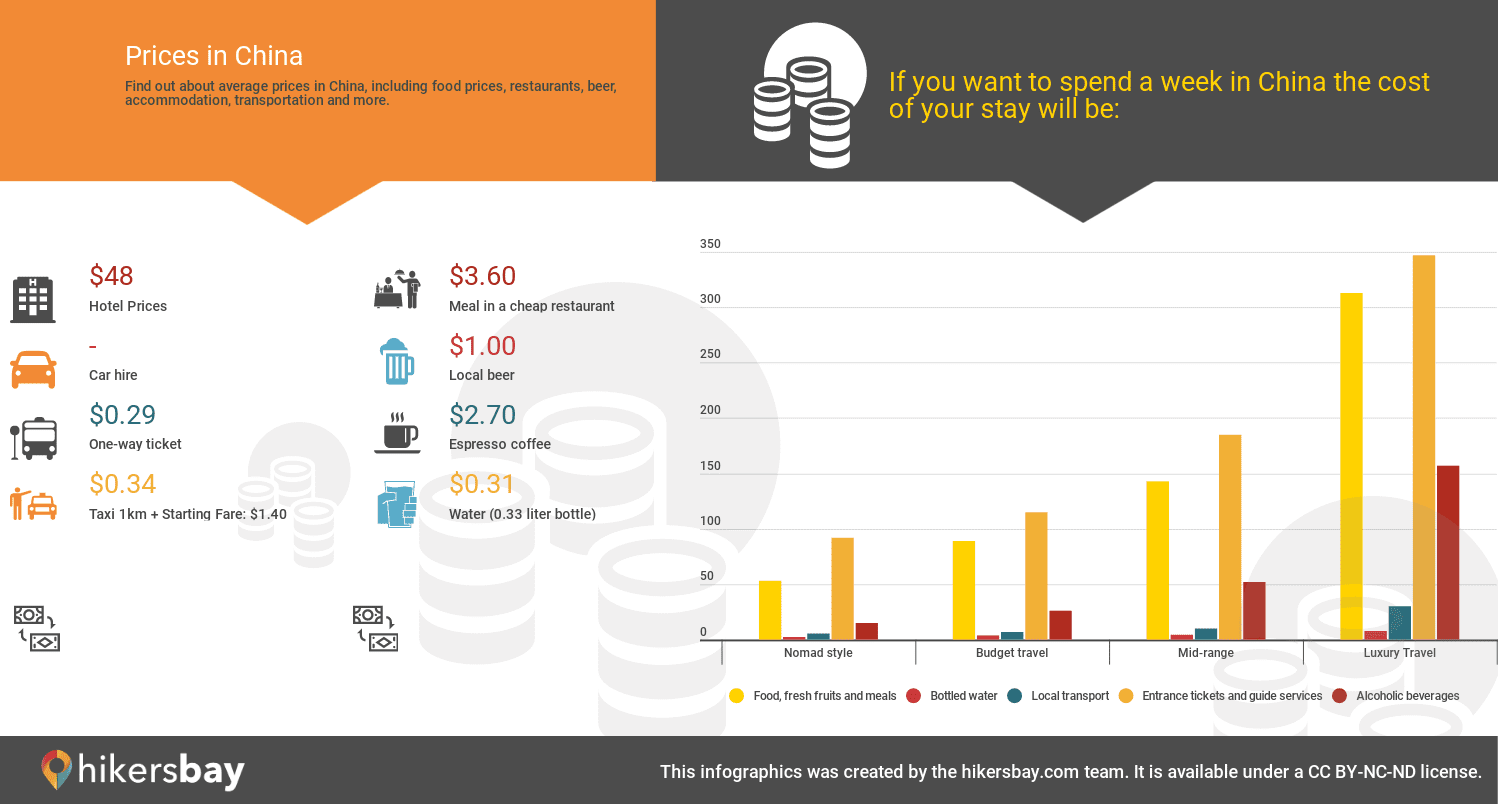
How long should you visit China for?
If possible, we suggest allocating approximately two weeks for your visit to China. This duration allows you to explore popular attractions like the Great Wall, as well as discover lesser-known treasures like the Leshan Giant Buddha. Additionally, it gives you ample time to fully absorb and appreciate everything you encounter, and to leisurely wander through the sights at a relaxed pace.
Is 3 weeks enough for China?
Spending three weeks in China is a sufficient amount of time to visit the major attractions in both Northern and Southwestern regions. However, if you also wish to explore Southern China and Hong Kong, you should plan for an additional week to 10 days.

What time of year is cheapest to go to China?
The off-season months of January, February, June, and December are the optimal time to book flights to China. During these months, flight prices are generally lower as there is less demand for air travel.
What is the nicest month in China?
The most ideal times to travel to China are during the spring (March-May) and autumn (September and October) due to the pleasant climate. August is a popular time for families to visit China, but be prepared for hot and humid weather and crowded attractions.
Is China tourist friendly?
China is generally considered a safe destination for travelers, as long as they have a good understanding of their surroundings and remain vigilant. It is a popular tourist destination for people from various countries and poses no threat to individuals who respect the local customs and abide by the laws.
How many days can a US citizen stay in China?
The length of permitted stay can vary from 7 to 180 days depending on the type of visa. Transit visas allow for a stay of 7 to 10 days, while single-entry tourist visas typically allow for a stay of 30 days. The X2, S2, Q2, and J2 visas have the longest permitted durations of stay, which is up to 180 days. This information is valid until May 25, 2023.
- Meet the Team
- Work with Us
- Czech Republic
- Netherlands
- Switzerland
- Scandinavia
- Philippines
- South Korea
- New Zealand
- South Africa
- Budget Travel
- Work & Travel
- The Broke Backpacker Manifesto
- Travel Resources
- How to Travel on $10/day
Home » Asia » China » Backpacking Guide
Backpacking China Travel Guide (Tips + Secrets for 2024)
Backpacking China is an attack on the senses. From the unbelievable sight of the Great Wall stretching off to infinity to the mouth-numbing sensation of hot pot, to the soothing sounds of an old man playing an erhu in the park. Get ready for sensory overload on any visit to China.
China is a country of vast contrasts. It’s one of the oldest civilizations on the planet and at the same time one of the most rapidly developing countries. Here you’ll find ancient temples right down the street from megamalls and shiny skyscrapers towering above traditional courtyard homes.
While China is a fascinating country to explore, it’s definitely not the easiest place to visit. Having lived in the country and traveled extensively for six years, I can definitely attest to this.
But successfully making it through an extended backpacking trip in China feels like a massive accomplishment. You will have traveled in one of the largest and most intimidating countries in the world and seen some truly unique sights along the way.
I’m here to help you do just that: visit China like a pro! I’ve written this epic travel guide to China in hopes that it will help you, my fellow broke backpacker, ace this country. Read this guide closely and sure to have an excellent time in this country.
Why Go Backpacking in China?
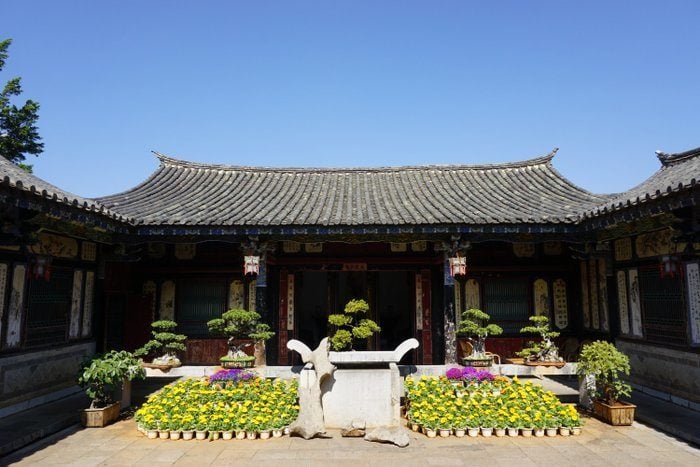
China is an absolutely massive country with just about every environment imaginable. The country is full of mega-cities, epic mountains, barren deserts, lush forests, and sandy beaches. When backpacking China, you’re definitely spoiled for choices.
In a country so huge, it’s best to stick to a specific region if you’re strapped for time. You could spend an entire lifetime exploring China and not see it all. Trust me – I lived there for 6 years and traveled extensively, but still only scratched the surface.
Best Travel Itineraries for Backpacking China
Places to visit in china, top things to do in china, backpacker accommodation in china, china backpacking costs, best time to travel to china, staying safe in china, how to get into china, how to get around china, working in china, what to eat in china, chinese culture, some unique experiences in china, final advice before visiting china.
Below I have highlighted the best travel itineraries for traveling around China. It’s no secret how massive China is, so don’t even try to see most of the country in one trip. Instead, check out my 5 itineraries below for some inspiration!
Backpacking China 7 Day Itinerary #1: Beijing to Chengdu
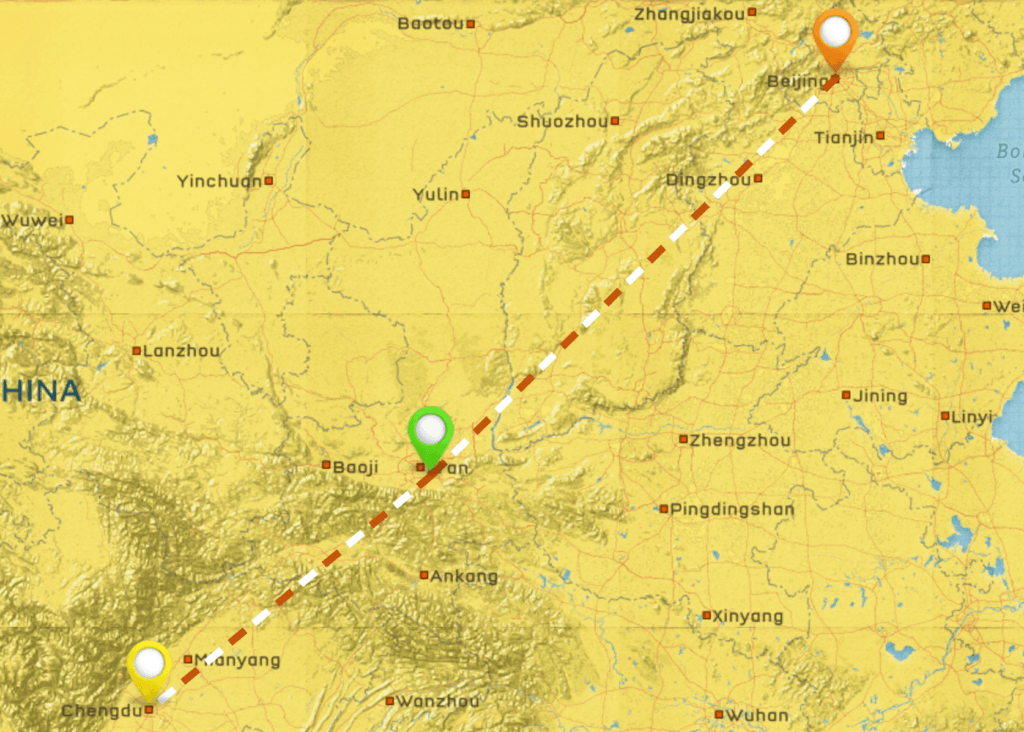
Let’s start by acknowledging that one week in China definitely is not enough time to explore this country. That being said, you can still hit some of the highlights of the country with just seven days.
You’ll want to fly into Beijing and spend a few days taking in the famous sights such as the Great Wall and Forbidden City. Hop on an overnight train to save time and head to the historical city of Xi’an to see the Terracotta Warriors.
From there, make a beeline for Chengdu to visit the giant panda reserve and eat the mouth-numbingly spicy hot pot. You can catch a flight out of the country from Chengdu, most likely to Southeast Asia.
Backpacking China 10 Day Itinerary #2: Beijing to Huanglong
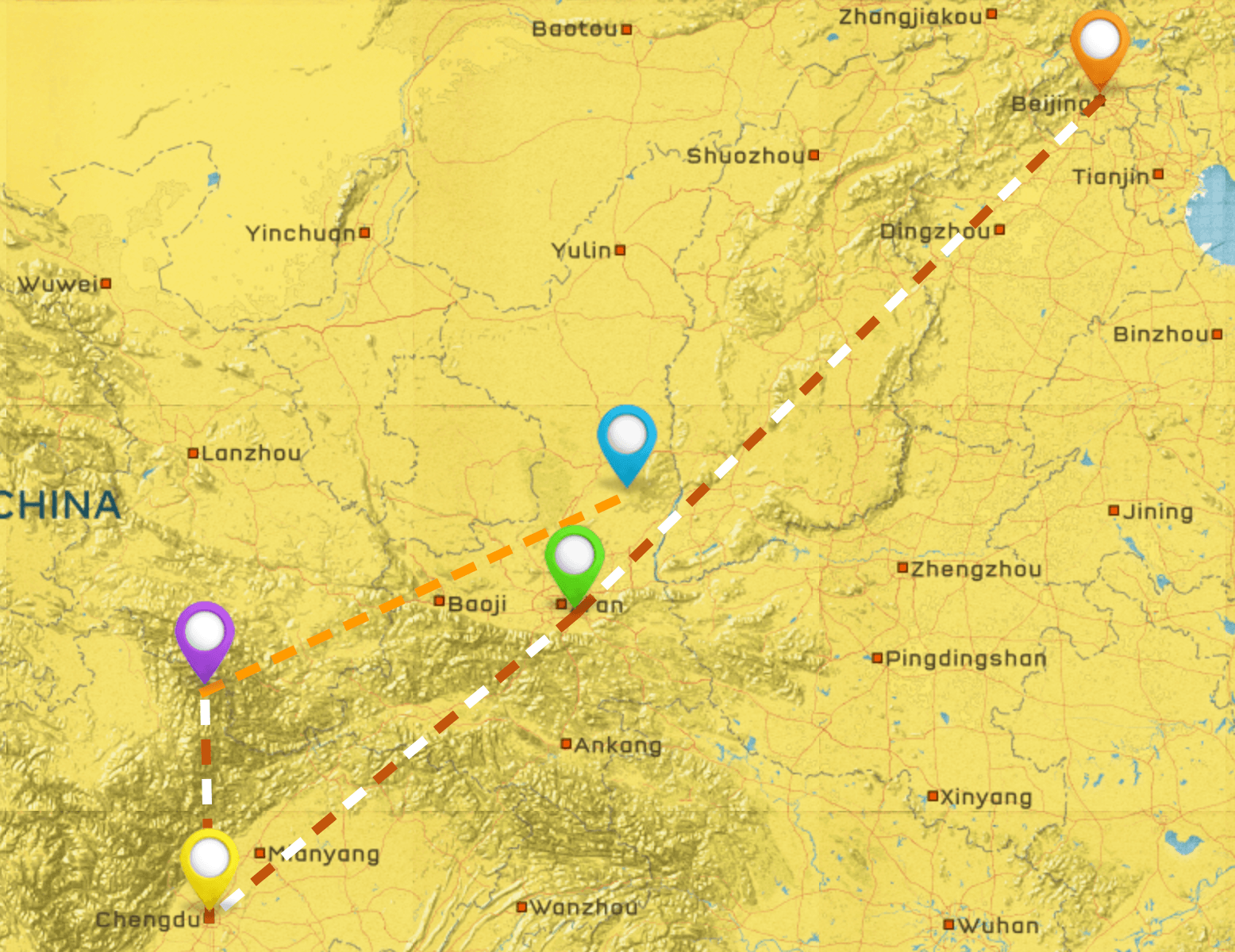
With ten days, you can follow the above itinerary (Beijing, Xi’an, and Chengdu) but add a visit to some of Sichuan’s magnificent national parks. A short flight from Chengdu will get you to the dreamlike Jiuzhaigou , where you can spend a day exploring the stunning landscapes and taking in the Tibetan culture .
Pay a visit to Huanglong (Yellow Dragon) the next day to see the incredible terraces that are said to resemble a dragon coming down the mountain.
Backpacking China 2 Week Itinerary #3: Yunnan and Guangxi
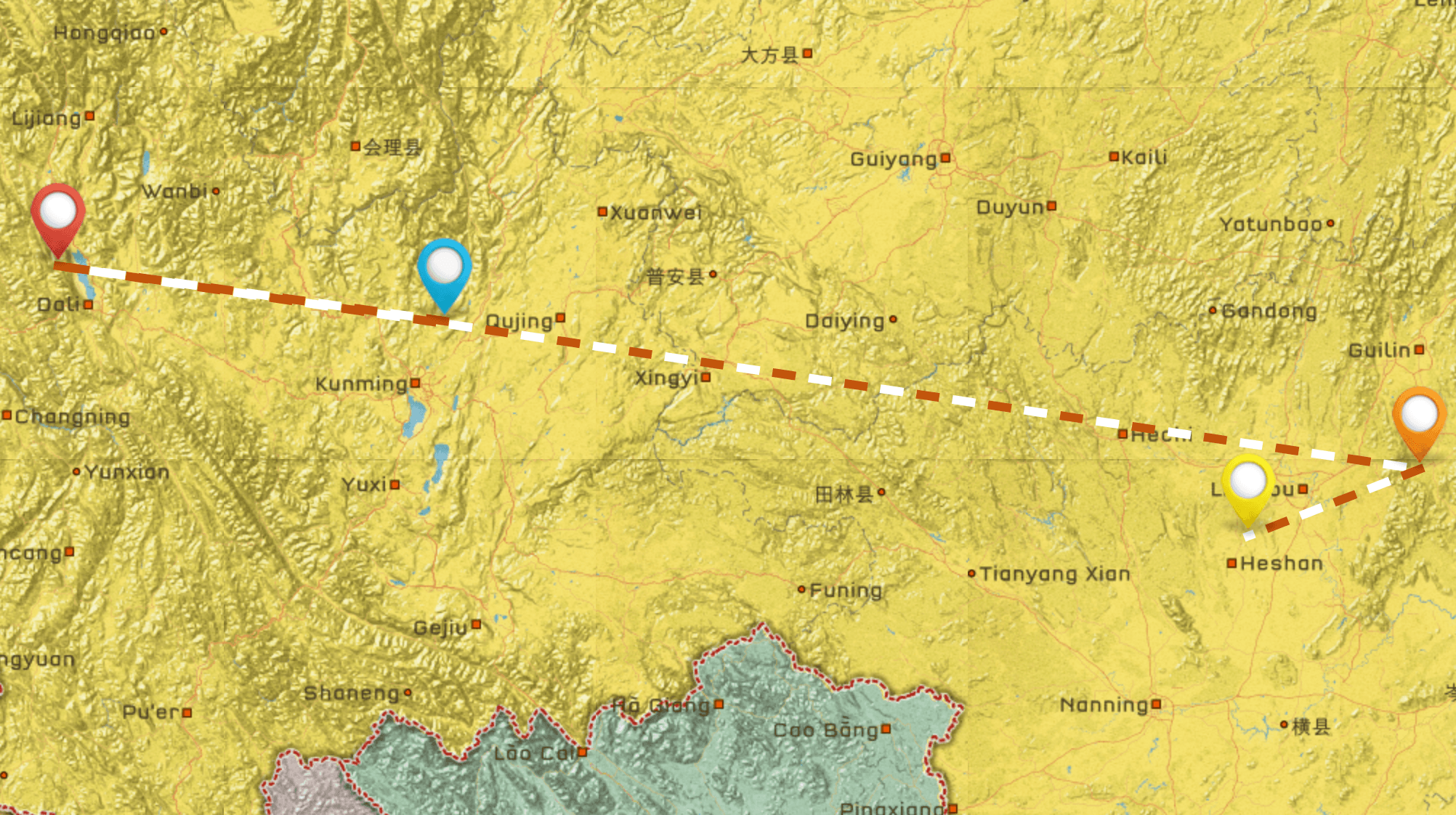
If you have two weeks to spare in China, I highly recommend you spend a majority of your time in the southwest part of the country. Yunnan province alone offers enough to fill two weeks. Start in the provincial capital of Kunming , which is known as the Spring City for its pleasant weather.
The city is great, but you’ll want to venture out quickly to dedicate more time to places like Dali , Lijiang , and Shangri-la . Spend your days cycling around massive lakes or trekking around snow-capped mountains.
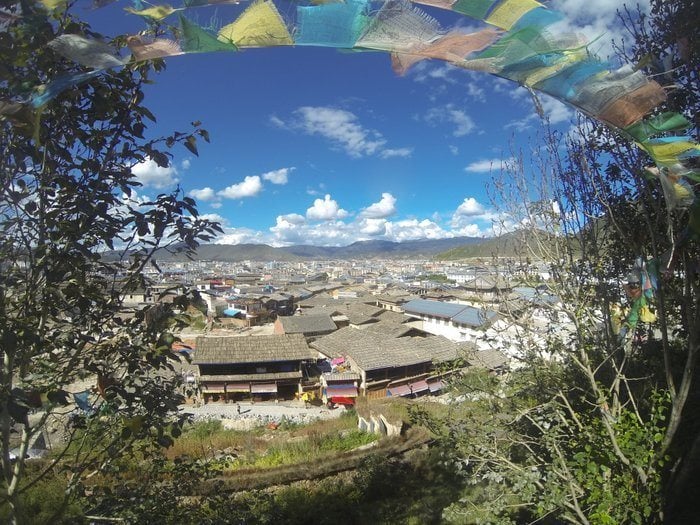
From Yunnan, you can catch a flight or overnight train to Guilin , the capital of Guangxi . A short bus ride will take you to the backpacker haven of Yanghsuo , where you can cruise on a bamboo raft down the Li River past majestic karst mountain peaks. There’s also cycling, hiking, and rock climbing on tap here, in addition to some seriously wild nightlife.
Backpacking China 1 Month Itinerary #4: The Full Loop
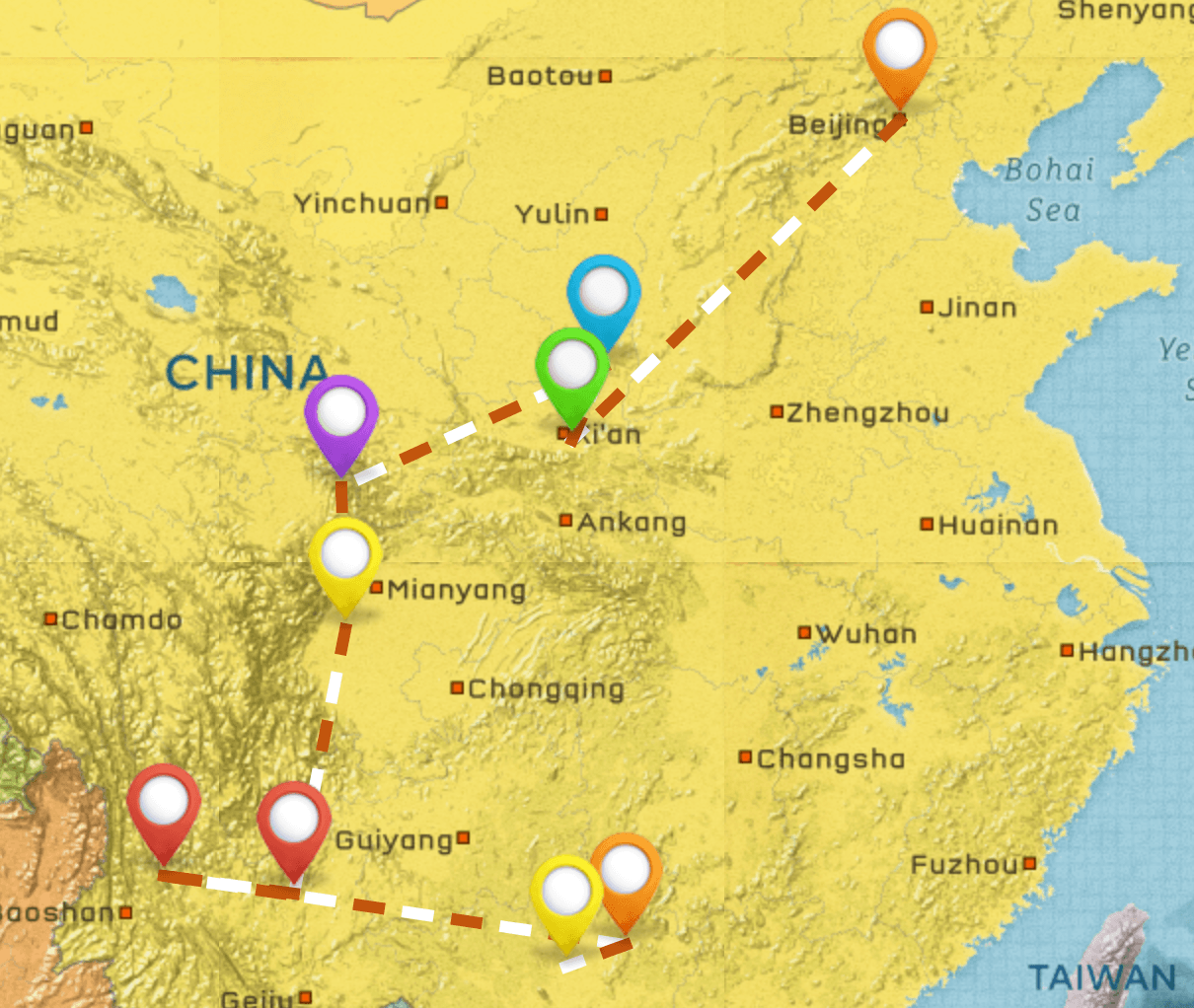
So you have a whole month in China, do you? That’s great news, as you’ll be able to cover some serious ground thanks to the country’s extensive rail network. Based on my experiences traveling all over the country, I’d combine the above-mentioned itineraries and add a bit more.
In addition to Beijing, Xi’an, Sichuan, Yunnan, and Guangxi, you can tack on a backpacking trip to Hong Kong , which is technically part of China but feels worlds apart. From here, you’ve got unlimited options for onward travel.
You could also travel to Macau as well. That’s super close to Hong Kong and a whole other adventure.

Backpacking China 1 Month Itinerary #5: Beijing to Hong Kong
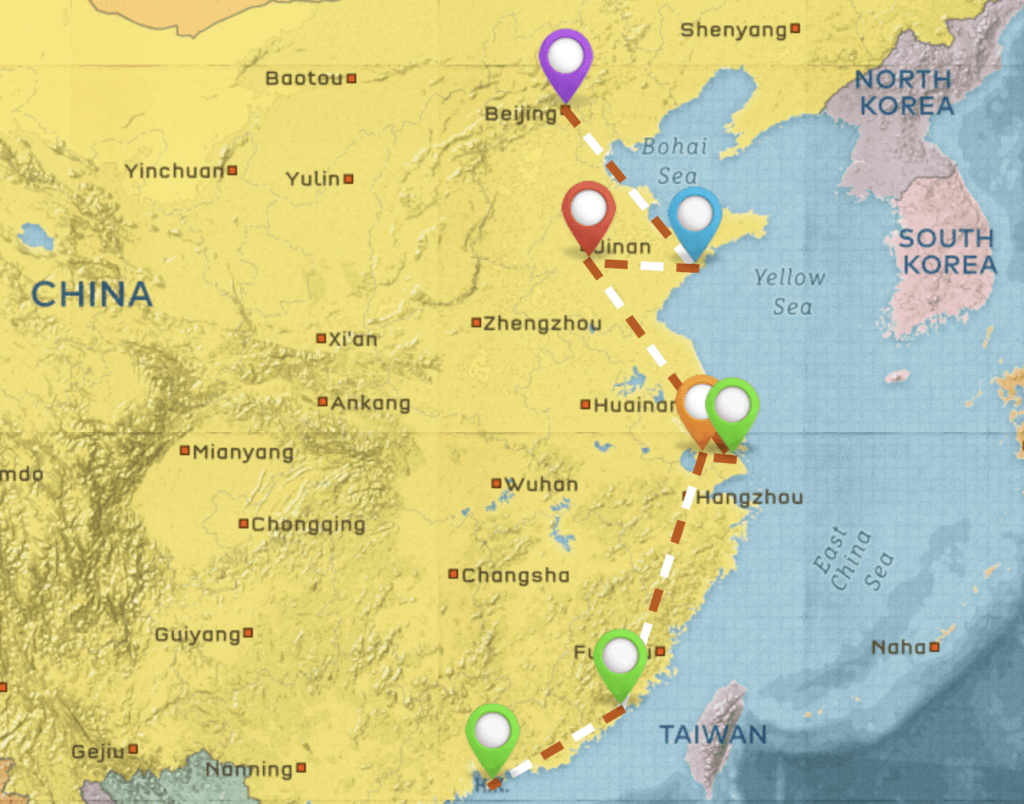
Backpacking Beijing
To say that Beijing is a mega-city is an understatement. This sprawling metropolis has a population of around 25 million and seems to go on forever and there are just so many epic places to visit in Beijing . Here you’ll see the clash between ancient and modern China up close, as ancient landmarks such as the Forbidden City are contrasted with futuristic high-rises.
As with much of China, Beijing seems to have one foot firmly planted in the past and the other in the future, resulting in a bit of confusion as to what exactly the present is.
When backpacking China, you should definitely start your adventure here in the capital. Beijing offers so much that you could easily spend an entire month here and not do it all. Chances are you aren’t blessed with that much time to spend in one city, though.
Never fear, as I’ve put together an epic guide on what to do with 72 hours in Beijing . This itinerary takes you to most of the major landmarks and also has some solid recommendations for dining and nightlife.
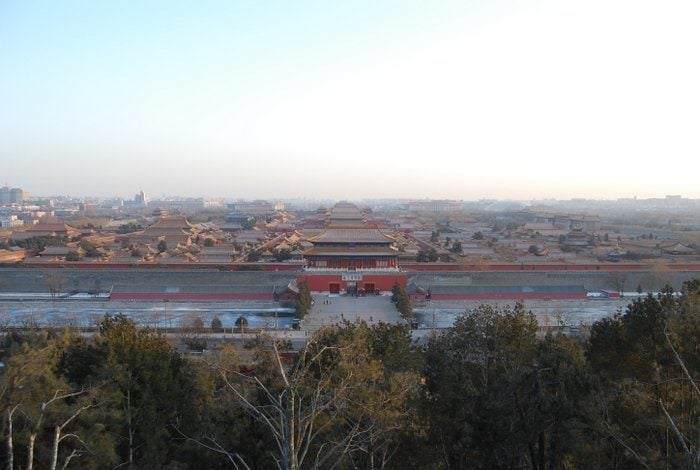
While you can fill your days in Beijing by sticking to the well-trodden tourist path, there are lots of great side adventures that you can add to make your trip a bit more interesting. Taking a bus for 1-2 hours in any direction can lead you out of the urban sprawl and to some pretty incredible places.
You can go rafting and bungee jumping out at Shidu, hike up to a serene Buddhist temple in the mountains, or hike on the wild Great Wall .
A major highlight of any visit to Beijing is indulging in the culinary and nightlife scenes. Beijingers know how to eat, and they sure know how to party. Whether you’re sampling the legendary Beijing roast duck or just eating weird shit on sticks at the Wangfujing night market, you’ll never go hungry in the ‘Jing.
If you’re looking to party, you’ve got several choices as well. With cheap drinks and good times abound in the student haunt of Wudaokou, there are more bars than you can count in the trendy Sanlitun district, or you can dance all night at the clubs around Worker’s Stadium. After a big night out, you can even hit a 24-hour dim sum restaurant to soak up some of that booze.
Need help deciding between Shanghai and Beijing ? Check out our helpful guide.
Backpacking Yunnan
The name of this province in southwest China literally translates to “South of the Clouds,” and you’ll quickly see why if you choose to visit Yunnan. Home to many stunning mountain ranges that literally touch the clouds, it’s a very appropriate name. If you’re into adventure travel, nature, and unique local culture, you’ve come to the right place.
Most trips to Yunnan will start and end in Kunming, a “small” city of 6 million. There’s enough to do here to keep you busy for a few days, such as strolling around the central Green Lake Park, hiking in the Western Hills, or visiting the quirky Bird & Flower Market.
Kunming is home to a sizeable expat population, and it’s one of your best bets if you’re thinking of sticking around a while to teach English in China or study Chinese.
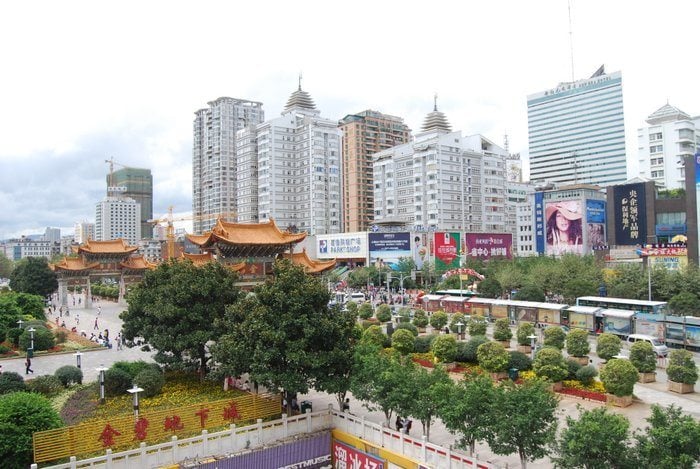
There’s a very established backpacker route through Yunnan that goes from Kunming to Dali , Lijiang , the Tiger Leaping Gorge , and Shangri-la . This is far and away one of the most beautiful areas of China , full of towering mountains and rushing rivers.
Forget those images you may have of giant cities full of traffic and smog. This is the reason backpacking China is such an incredible experience.
While each of these towns can seem overwhelmingly crowded and touristy, rest assured that it’s never that hard to escape. Chinese tourists tend to follow a herd mentality and stick to their tour bus.
Simply jump on a bicycle and start pedaling or skip the cable car and hike up that mountain and you’ll find yourself in near solitude. Check out our comprehensive guide to backpacking Yunnan to plan an epic trip to this corner of China.
Backpacking Sichuan
If you’ve ever eaten in a Chinese restaurant, you’ve probably had something labeled as Szechuan. That’s the old spelling of this province that’s famous worldwide for its cuisine.
The common flavor here is known as ma la in Chinese, meaning “numb and spicy.” Set your taste buds ablaze with classic Sichuanese dishes such as Kung Pao chicken, Mapo tofu, and of course, hot pot.
In the provincial capital of Chengdu, you can pay a visit to the massive giant panda base. This is far from a zoo, as it’s a fully functioning research facility and conservation center. It’s best to visit early in the morning when the cute and cuddly “bear cats” (the literal translation of their Chinese name) are munching away on bamboo.
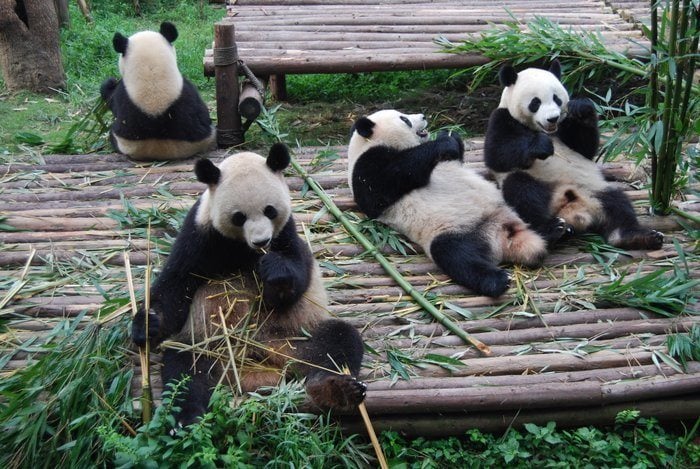
Chengdu is one of the coolest cities in China, so you might as well stick around a few days and explore. The people here are known to be super laid-back and friendly. Head to the People’s Park to soak up the local culture, which includes lots of tea sipping and group dancing. There are plenty of great hostels and bars here, so you’ll meet lots of fellow backpackers during your stay.
Sichuan is home to some of China’s most famous national parks . Jiuzhaigou is one of most picturesque places in the country, with turquoise lakes, epic mountain peaks, and massive waterfalls . Those looking for a serious adventure here will want to sign up for an eco-tourism trek in the nearby Zharu Valley . On this 3-day trip, you’ll reach the summit of a sacred Tibetan mountain at 4,200 meters. It’s one of the most challenging and rewarding adventures I’ve ever had in China and something I’d highly recommend.
Backpacking Guangxi
When it comes to backpacking China, it’s hard to beat the town of Yangshuo. Just a few decades ago, this was a sleepy rural Chinese town with little to no tourism infrastructure. When long-haired backpackers started showing up looking to scale the town’s beautiful karst mountains, a new industry was born.
Yangshuo is now one of the most popular backpacker destinations in the country, with a ton of hostels, restaurants, bars, and travel agents. It has also become a hot spot for domestic tourists, who flock here by the tour bus-load to crowd the West Street. Don’t be discouraged, though, as once again it’s very easy to escape the crowds. Just rent a bicycle or a motorbike, and you’ll find yourself out in some of the most unreal landscapes you’ve ever seen without a tour group in sight.
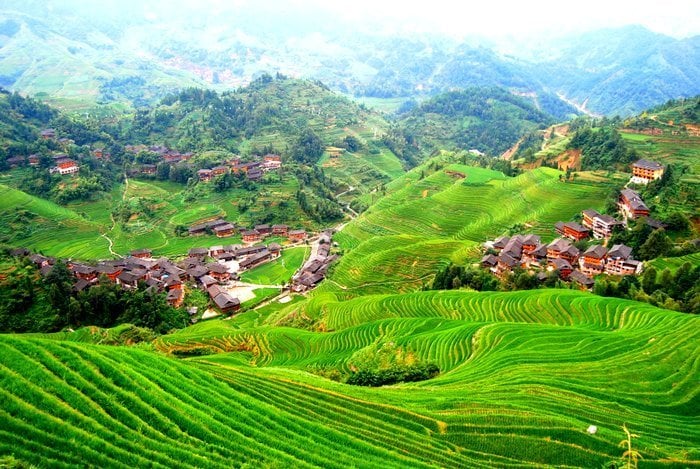
Another spot worth visiting is the area known as the Longji Rice Terraces . The name means “Dragon’s Backbone,” as the terraced rice paddies are said to resemble exactly that. Unfortunately, they decided to put a hideous cable car in here. Chinese tourists tend to be lazy and avoid hiking at all costs, so it’s not surprising. Despite this eyesore, it’s still a great place for a few days of casual hiking.
Backpacking Shaanxi
Shaanxi Province is home to one of the most famous sights in all of China – the Terracotta Warriors. As a matter of fact, this UNESCO World Heritage Site is said to be the most impressive archaeological discovery of the 20th century. This is the mausoleum of Qin Shi Huang, the first emperor of a unified China. As with many things in China, there’s a fascinating story behind it.
Qin Shi Huang survived three assassination attempts and was justifiably fearing for his life. The emperor became obsessed with finding an “elixir of life” in search of immortality. He also had a gigantic mausoleum constructed and had it surrounded by thousands of life-like statues of warriors and chariots to protect him in the afterlife. This was later discovered by workers who were digging a well in 1974, and it quickly drew international attention.
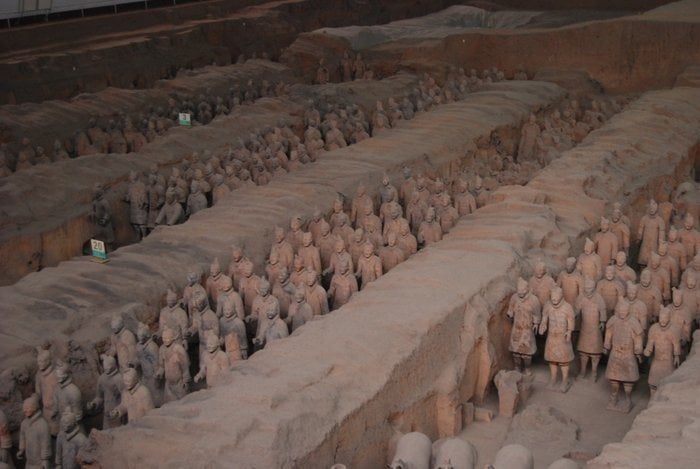
To visit the Terracotta Warriors, you’ll want to base yourself in the provincial capital of Xi’an. Set aside a day to explore the impressive site, and at least 1-2 more to see what Xi’an has to offer. Here you can rent a bicycle and ride around the entire length of the ancient City Wall.
Be sure to visit the Muslim Quarter in the evening, where you can find tons of delicious street food . Xi’an is famous for a few dishes, such as the yang rou pao mo lamb stew and rou jia mo , which are basically Chinese pulled pork sandwiches.
Backpacking China is all about adventure, and that’s precisely what you’ll find at Mt. Huashan. Proclaimed to be “the world’s most dangerous hike,” this one isn’t for the faint of heart.
Here you’ll walk along narrow pathways with precipitous drops off to the side. You’re strapped in for safety, but that doesn’t make it any less terrifying. If you survive, you’ll be able to say you conquered one of the Five Great Mountains in China.
Getting Off the Beaten Path in China
Those looking to skip out on matching hat-wearing, flag-following, selfie-snapping hordes of Chinese tourists will want to head straight for northwest China. Perhaps no place in China is more off the beaten path than the autonomous region of Xinjiang .
The area is home to numerous ethnic groups, including Uygurs, Kazakhs, and Mongols. It’s been the sight of some serious unrest in recent years, meaning most tourists stay far away.
While many in China will try to convince you that Xinjiang is far too dangerous, you just need to exercise some caution and patience and you can have a perfectly fine trip here. In addition to some of the most mesmerizing landscapes in the country, Xinjiang also has some of the most delicious food in all of China. It’s pretty hard to beat some spicy grilled lamb with a nice piece of naan. Despite their bad reputation across China, the Uyghur people are known to be incredibly hospitable and welcoming to visitors (unless you’re Han Chinese, that is).
While we’re talking about lesser-visited parts of China, we can’t leave out Inner Mongolia . If you can’t make it to actual Mongolia, this is a pretty decent backup. You can still sleep in a yurt in the desert and then go horseback riding in the seemingly endless grasslands. All of this can easily be arranged from one of the hostels in the capital of Hohot .
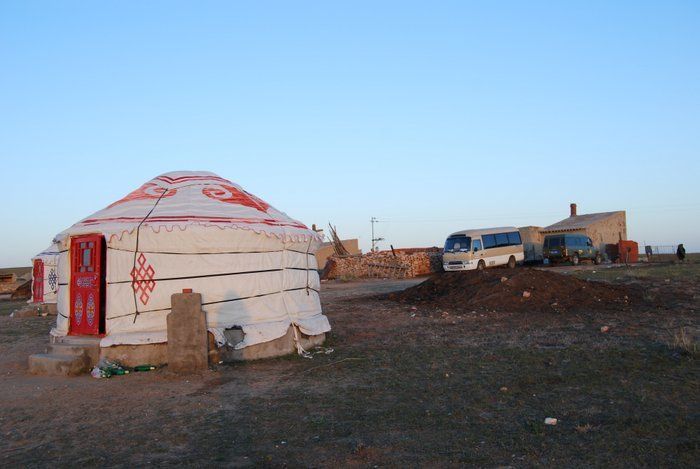
Another great spot for some off the beaten path adventures is Qinghai Province . This is one of the most sparsely populated regions of China, meaning you won’t have to share the stunning landscapes with a bunch of tourists. Here you can soak up the Tibetan culture without the added hassle of traveling to Tibet. You can also visit the largest lake in all of China.
It should be noted that by just being in China, you’re already sort of off the beaten path. Sure, the country gets a whole bunch of international visitors every year, but you’re still very much a novelty here.
Even in the big cities of Beijing and Shanghai , don’t be surprised to hear people shout “ Laowai ! (Foreigner!)” and point at you. They might even try to take a picture with you. Such is life when you’re traveling in China. Even though the country has been open for several decades, foreigners are still surprising to most locals.

We’ve tested countless backpacks over the years, but there’s one that has always been the best and remains the best buy for adventurers: the broke backpacker-approved Osprey Aether and Ariel series.
Want more deetz on why these packs are so damn perfect? Then read our comprehensive review for the inside scoop!
China is a country that’s so rich in experiences that it’s really tough to whittle them down to a Top 10 list. The country is full of historic sites, amazing nature, bustling cities, and some of the most delicious food in the world.
I personally love Top 10 lists, though, so I’m going to do my best! Here’s my top 10 things to to while backpacking in China!
1. Hike on the Great Wall
Chairman Mao once said that you aren’t a real man until you climb the Great Wall. While his famous remark may need to be adjusted for the modern PC era, you get the gist.
You simply cannot go to China without hiking on the Great Wall, one of the New Seven Wonders of the World. There are plenty of options for visiting the wall from Beijing, but they are definitely not all great.
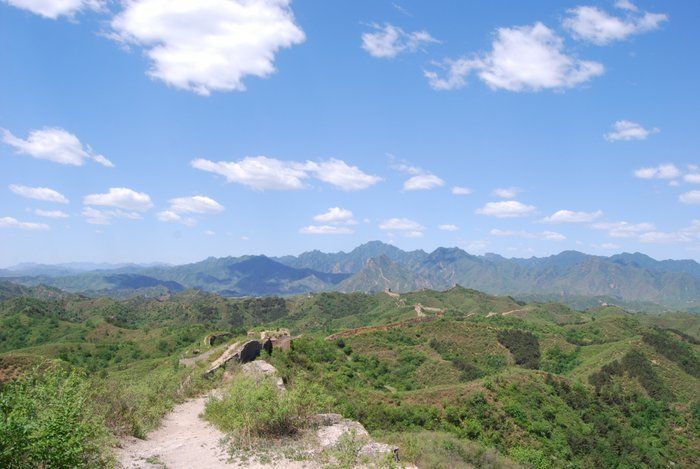
Whatever you do, stay far, far away from the Badaling section. That is unless you want to see what a Disneyland version of the Great Wall looks like. This restored part of the wall comes complete with a cable car and a neverending stream of tourists.
You’re better off visiting more remote sections such as Jinshanling or Jiankou. Better yet, why not bring your tent and camp on the Great Wall ? In my six years of living and traveling in China, nothing even comes close to that.
Perhaps it had something to do with the bag of ‘shrooms and bottle of wine we brought, but it’ll be an unforgettable experience even without psychedelics and booze.
2. Visit Jiuzhaigou National Park
It’s already been mentioned a few times in this guide, but that’s just how good Jiuzhaigou is. After years of living in the chaotic, polluted capital of Beijing, I couldn’t believe my eyes when I visited Jiuzhaigou. This massive national park in Sichuan is without a doubt the most beautiful place I’ve been in China.
Of course, it’s also one of the most popular. While the hordes of pushy tourists can diminish the experience a bit, all you have to do is venture off on one of the trails to escape them.
3. Harbin Ice and Snow Festival
If you’re planning on backpacking China in the winter months, be sure to schedule a trip to the northeastern city of Harbin . China’s Ice City is home to the biggest ice and snow festival in the world, and it’s absolutely incredible.
Artists from all over the world flock here to craft massive sculptures out of the ice and snow. In typical Chinese fashion, the ice sculptures are packed with plenty of neon lights to make for quite the trippy experience.
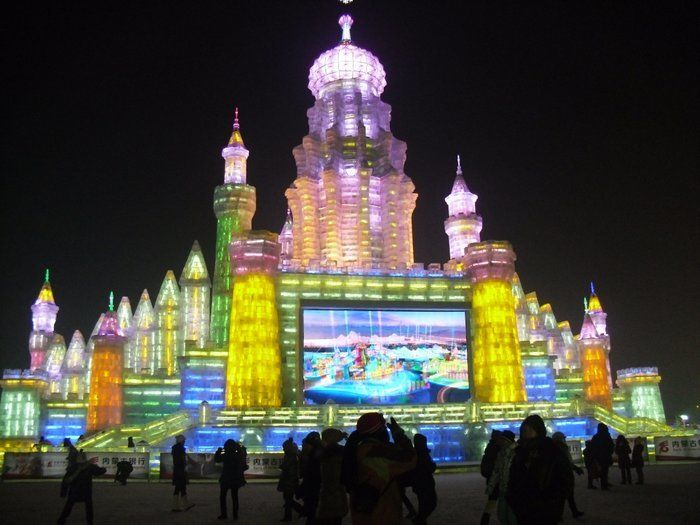
4. Visit the Fujian Tulou
The southeastern province of Fujian is home to the amazing tulou compounds. These massive circular structures are basically an entire village. On the lower floor, you’ll find common rooms and ancestral worshipping halls, while the upper floors are full of individual residences.
During World War II, the US government mistakenly thought these traditional compounds were missile silos. Fewer and fewer people are living in them today, as the rush to modernize has led many to move into bland high-rise buildings.
There are several you can visit, though, and a few days exploring them by bicycle is an experience you won’t soon forget.
5. Hike Tiger Leaping Gorge
If you’re backpacking in China, chances are you’ll end up hiking the Tiger Leaping Gorge at some point. This world-class hiking trail weaves high above the Yangtze River in the mountains of Yunnan is a can’t-miss experience. The hike takes 2-3 days depending on your speed, and it passes by some of the most stunning scenery China has to offer.
There are plenty of guest houses along the way, including the aptly named Halfway House, which has what just might be the most scenic toilet you’ve ever used. You’ll just have to go there and see for yourself.
If you smell something funky along the trail, that’s not your Grateful Dead t-shirt that you forgot to wash. It’s the wild weed growing high up here in the mountains of Yunnan. If you care for a toke, you can pick up a bag from the nice grannies along the trail. They even have bananas and Snickers for when you inevitably get the munchies.
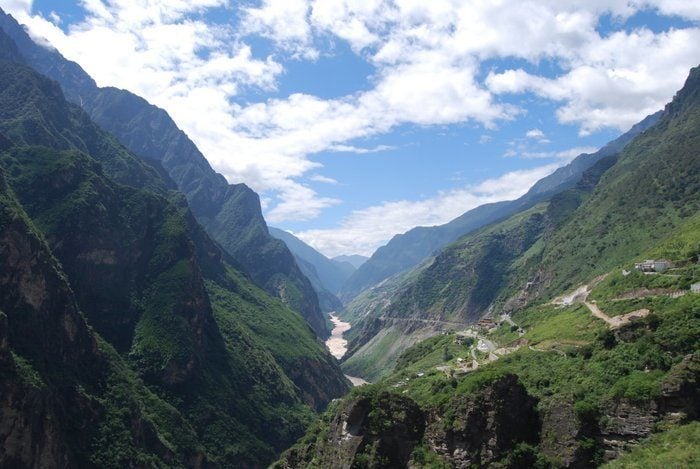
6. Take a High-Speed Train
Few countries can compete with China when it comes to train travel. The country is building high-speed rail lines at a rapid pace, adding more and more connections with each passing month. Take the lightning-fast train from Beijing to Shanghai, and it’ll make the US look like a 3rd world country.
These bad boys reach speeds of up to 350 km/h and will get you from one city to the next in just 4.5 hours. If you’re backpacking China, there’s really no need to buy flights. Forget making the trek out to airports on the outskirts of the cities, and stick to the impressive rail network.
7. Check Out Ancient Buddhist Grottoes
China is home to three different Buddhist grottoes – Longmen , Yungang , and Mogao . Visit one of these sites to see the impressive Buddhist carvings in the caves. These are considered to be some of the finest examples of Chinese Buddhist art, and they really are an incredible sight to behold.
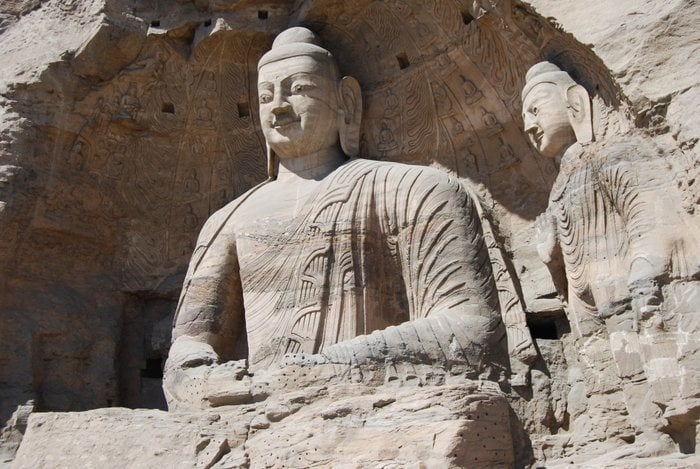
By visiting the Yungang Grottoes in Datong , you can also check out the awe-inspiring Hanging Monastery to make for an awesome short trip. A trip to the Longmen Grottoes in Luoyang is easily combined with a visit to X’ian, so you can cross two items off the list.
8. See the Pandas in Chengdu
The giant panda is known as China’s national treasure, and there’s no better place to get up close to these adorable bears than in Chengdu. The city is home to a massive giant panda research base, where you’ll see dozens of them snacking on bamboo and wrestling with each other. Just don’t expect any of them to start doing kung fu.
It’s super easy to arrange a tour here from your hostel and a visit only takes half a day. There’s all kinds of panda swag available in Chengdu as well if you’re looking for that perfect souvenir.
9. See the Terracotta Warriors
Yes, this is one of the most touristy places in China. Yes, it can kind of be a pain in the ass getting there. None of that matters. You can’t go backpacking in China and skip out on this amazing archaeological site.
Just imagine how much effort went into the construction of this massive tomb full of life-sized warriors and chariots, all of which was done to appease the first emperor of China as he neared the end of his life.
10. Outdoor Adventures in Yangshuo
Backpacking is all about adventure , and that’s exactly what you’ll find in this scenic town in Guangxi. Whether you’re into rock climbing, hiking, cycling, or simply jumping on a motorbike and exploring, Yangshuo has got you covered.
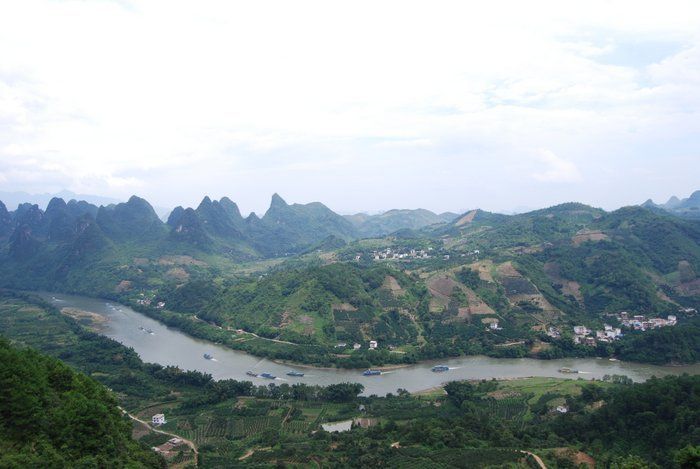
Sure the center of town is packed full of package tour groups, but this is still a backpacker’s paradise in China. However you spend your day, be sure to visit the legendary Monkey Jane’s at night for a rousing game of beer pong. Tell her the Grateful Gypsies sent you.

Wanna know how to pack like a pro? Well for a start you need the right gear….
These are packing cubes for the globetrotters and compression sacks for the real adventurers – these babies are a traveller’s best kept secret. They organise yo’ packing and minimise volume too so you can pack MORE.
Or, y’know… you can stick to just chucking it all in your backpack…
You may be surprised to hear it, but there are a lot of kickass hostels in China. While it may not be as popular as places like Thailand or Indonesia, China has enough domestic backpackers to support a thriving hostel scene. Even in random cities that draw very few foreign travelers, it’s possible to find a bed in a dorm in a cool hostel.
You’ve got tons of choices for hostels in cities like Shanghai and Beijing. Many of them can help arrange tours and have special events such as dumpling parties or movie nights.
Prices for hostels in China vary depending on where you are. It’s possible to get a bed in a dorm for anywhere from $10-20 a night, while private rooms tend to go from $30-50.
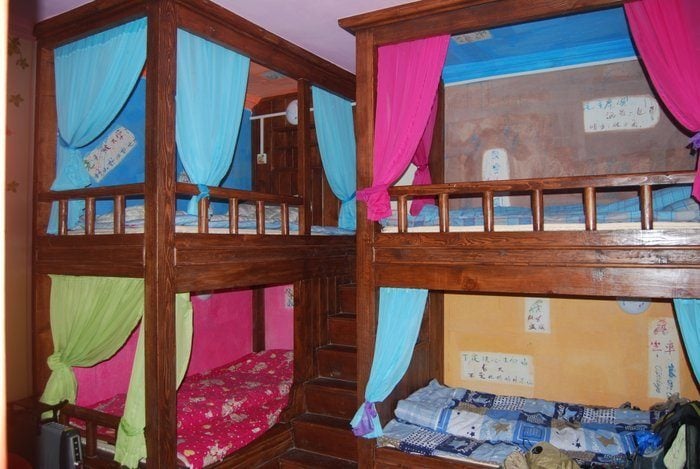
If you’re really looking to save on accommodation, Couchsurfing is also quite big in China. It’s possible to find both local and foreign hosts, especially in the big cities where you have lots of foreigners working and studying. We hosted upwards of 100 guests between our apartments in Beijing and Kunming and know of a few Chinese friends who also open their doors to Couchsurfers.
The Best Places to Stay in China
Your budget for backpacking in China will depend on a lot of things, namely how many places you go to and what level of comfort you need. Obviously, your budget will go up if you visit a ton of destinations and have to buy several plane and train tickets. Which type of ticket you choose will impact your budget as well, as soft sleeper train tickets are far more expensive than the dreaded hard seats.
The good news is that even in China’s big cities, it’s possible to get by on a budget of $40-50 a day. Public transport is cheap (around $0.50 to $2 for bus and subway tickets), and you can easily find a bed in a dorm for $10-15.
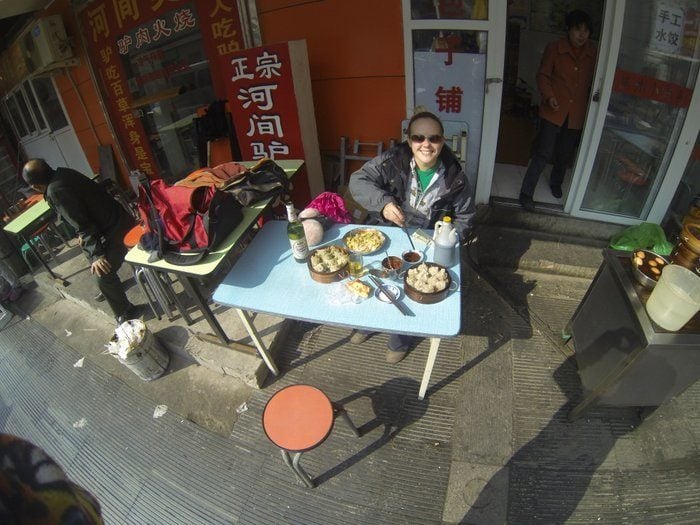
If you don’t mind eating like a local, your money will go a long way in China. Street food is readily available and is both delicious and cheap.
One of my favorites is a jian bing – this Chinese crepe with egg, green onion, chili sauce and a fried wonton only costs about $0.50 and will keep you going for a few hours. You can always find a bowl of noodles, a plate of dumplings, or a common dish like eggs & tomatoes on rice for $2-3.
One of the biggest expenses on your backpacking trip to China trip will definitely be entrance tickets. Entrance to the Forbidden City costs around $10, the Terracotta Warriors will set you back about $24, and a one-day pass to Jiuzhaigou plus the bus ticket runs almost $50. Be sure to do a bit of research into ticket prices so you can decide which places you can and can’t visit.
Thankfully, there are several free or cheap things to do in China as well. One of my favorite activities is finding a local park, such as Bei Hai in Beijing or Green Lake in Kunming. These are the best places to soak up the local culture and you can easily spend a few hours of your day without burning a hole in your wallet.
A Daily Budget in China
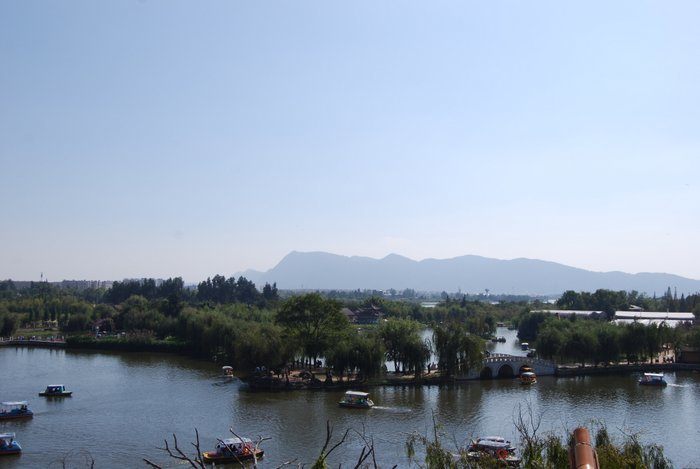
Money in China
China’s currency is the Renminbi (RMB). The current exchange rate is $1 = 6.3 RMB (April 2018). When talking prices with people, they’ll rarely say renminbi . The preferred terms are yuan or the slang kuai .
It’s not hard to find ATMs in China, but you may be charged a fee by both the local bank and your bank. If you’re American, you can sign up for a Charles Schwab checking account and have ATM fees reimbursed at the end of the month.
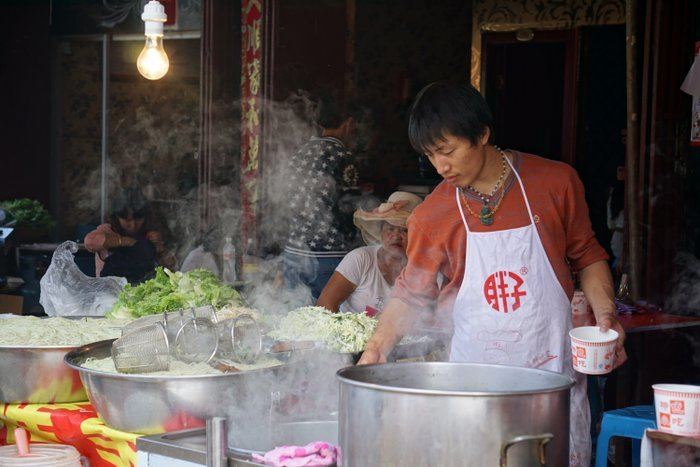
While cash was king in China for a long time, it’s all about the e-pay now. People in China prefer using WeChat to pay for just about everything these days. Sadly, you’ll need a Chinese bank account to be able to join them. Never fear, as it’s also very easy to pay with a credit card for most things in China.
Travel Tips – China on a Budget
- Camp : Camping in China can be a great option in rural areas, or even on the Great Wall! Wild camping in China is definitely in a grey area. It can be legal and it can be illegal. They are purposely vague on this subject in order to give authorities the freedom to choose what to do. As long as you stay under the radar, you should be fine. Check out our expert’s roundup of the best backpacking gear to get equppied for some outdoor adventures.
- Cook your own food: If you are on a tight budget, you can save money by cooking your own food – I recommend bringing a portable backpacking stove.
- Book your transportation early: Both plane and train tickets are much cheaper if you purchase them in advance.
- Couchsurf: Especially in the big cities in China, it’s not too hard to find a host whose couch you can crash on. They might be expats who are working there or locals. We hosted tons of Couchsurfers when we lived in China and always had a good time. Travelling with Couchsurfing is an amazing way to make some real friendships and see this country from the perspective of locals.
- Pack a travel water bottle : and save money every day!
Why You Should Travel to China with a Water Bottle
Plastic washes up on even the most pristine beaches… so do your part and keep the Big Blue beautiful
You aren’t going to save the world overnight, but you might as well be part of the solution and not the problem. When you travel to some of the world’s most remote places, you come to realise the full extent of the plastic problem. And I hope you become more inspired to continue being a responsible traveller .
Plus, now you won’t be buying overpriced bottles of water from the supermarkets either! Travel with a filtered water bottle instead and never waste a cent nor a turtle’s life again.

Drink water from ANYWHERE. The Grayl Geopress is the worlds leading filtered water bottle protecting you from all manner of waterborne nasties.
Single-use plastic bottles are a MASSIVE threat to marine life. Be a part of the solution and travel with a filter water bottle. Save money and the environment!
We’ve tested the Geopress rigorously from the icy heights of Pakistan to the tropical jungles of Bali, and can confirm: it’s the best water bottle you’ll ever buy!
Since China is such a massive country, the best time to visit China really depends on where you’re going. Generally speaking, the spring and autumn months are the most pleasant . In places like Beijing, Xi’an, and Shanghai winter can be painfully cold while summer can be hot and muggy. Weather is less of a concern in places like Kunming (it is called the Spring City after all) and Hong Kong (it’s always warm there).
As far as crowds go, they are definitely bigger in the summer months. Another thing to keep in mind is China’s holiday schedule.
Backpacking China during the Spring Festival (Chinese New Year) should be avoided unless you can plan things out super far in advance. Everything sells out and it’s absolute chaos as 1.7 billion people try to make it home for the country’s most important holiday. You could also always plan one of China’s many festivals into your backpacking trip if desired, with anything from cultural celebrations to dance parties, you’re bound to find something. It’s based on the lunar calendar, so be sure to look it up before planning your trip.
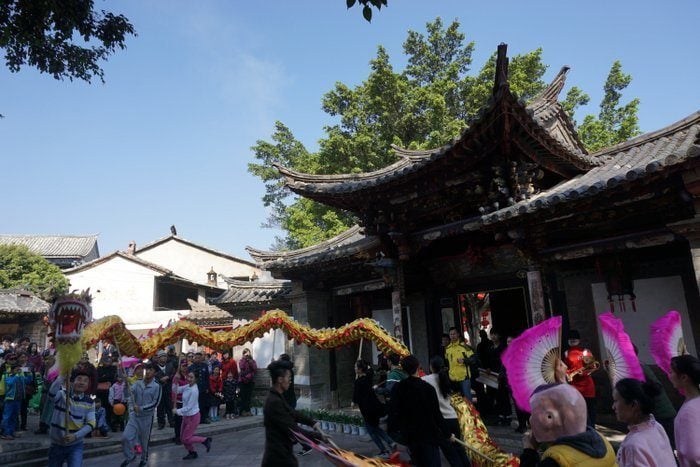
Other busy holidays in China include Labor Day (May 1st) and National Day (October 1st) . Labor Day isn’t so bad as far as crowds go, but it’s still a good idea to book things like train tickets well in advance. National Day is a “Golden Week” where people get a long holiday, so it’s quite crazy at that time as well.
In my humble opinion, the best time to go to China would be a few weeks before National Day or right after. The weather is pretty good across most of the country at this time, and you can just miss the crowds by going before or after the major holiday.
You could even stick around during National Day and soak up the patriotic atmosphere in Beijing. Just don’t expect to be able to get a train ticket out until after the holiday week.
Festivals in China
When it comes to Chinese holidays, nothing comes close to the Spring Festival . Also commonly called Chinese New Year , this festival lasts for 15 days in celebration of the Lunar New Year. It’s a fascinating and chaotic time in China, as everyone tries to get home to spend the holiday with loved ones. If your trip to China coincides with Spring Festival, be aware that transportation will be hard to come by, and that most businesses will be closed for a day or two.
China has many other traditional festivals throughout the year. One of the most interesting for visitors is the Dragon Boat Festival, which takes place sometime in June. There are several places where you can watch the amazing dragon boat races.
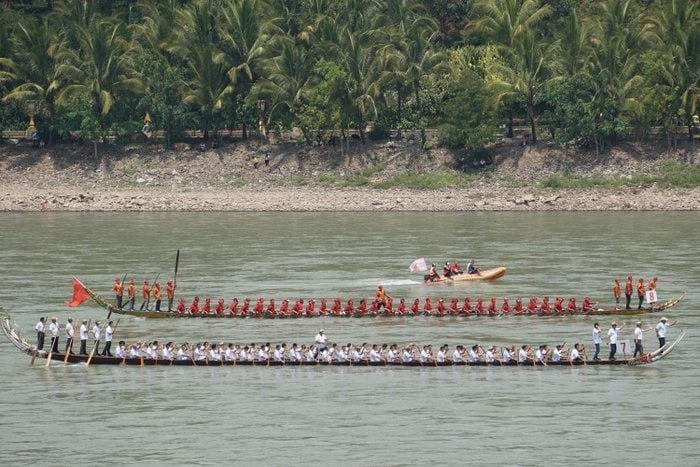
China loves drinking beer, so it should come as no surprise that there are several beer festivals. The biggest and most famous is the Qingdao Beer Festival in August. It’s a raucous affair with tons of food, carnival rides, live music, and of course a shit ton of beer. Those more into quality over quantity can find craft beer festivals in the big cities of Beijing, Shanghai, and Shenzhen.
Music festivals are catching on in a big way in China, with more and more being added every year. There are jazz festivals, rock festivals, and even psytrance festivals such as Spirit Tribe in Yunnan. Some festivals are in a city park while others are out in the countryside and include camping. Having been to several music festivals in China, I can say that it’s usually a good time.
What to Pack for China
What you pack for China travel really depends on where you’re going and what time of year it is. Definitely be sure to bring a good pair of hiking boots and some activewear for your adventures on the Great Wall and Tiger Leaping Gorge.
For regular sightseeing days, it’s nice to have some comfortable walking shoes and a hat/sunglasses. I also like to carry a small backpack to keep things like my water bottle, raincoat/umbrella, phone charger, and camera bag.
If you’re going to be spending time in the big cities and plan on going out, bring some decent clothes as well. Don’t worry if you forget something, as shopping for clothes is super cheap and quite fun in China.
My friend Claire also put together this great female packing list for China post – check it out!

Snoring dorm-mates can ruin your nights rest and seriously damage the hostel experience. This is why I always travel with a pack of decent ear plugs.

Hanging Laundry Bag
Trust us, this is an absolute game changer. Super compact, a hanging mesh laundry bag stops your dirty clothes from stinking, you don’t know how much you need one of these… so just get it, thank us later.

Sea To Summit Micro Towel
Hostel towels are scummy and take forever to dry. Microfibre towels dry quickly, are compact, lightweight, and can be used as a blanket or yoga mat if need be.

Monopoly Deal
Forget about Poker! Monopoly Deal is the single best travel card game that we have ever played. Works with 2-5 players and guarantees happy days.

Grayl Geopress Water Bottle
Always travel with a water bottle! They save you money and reduce your plastic footprint on our planet. The Grayl Geopress acts as a purifier AND temperature regulator. Boom!
Generally speaking, China is a very safe country to travel in. My wife always likes to comment to people that she felt safer stumbling down the streets of Beijing alone and drunk at 3AM than she does going downtown in my hometown of Detroit for a concert. Fair point, Rachel.
Of course, you have to exercise a bit of common sense when backpacking China just like any country.
Despite what my wife says, bad shit definitely can and will happen in the middle of the night, especially in bar districts. One of the biggest safety concerns in China is drunk locals trying to pick a fight. For some reason, Chinese men love to try and show off their drinking prowess (which they most certainly don’t have) in front of foreigners. Sadly, this sometimes leads to confrontations.
If you find yourself in such a situation, it’s best to just walk away. It’s never a one-on-one fight here, as the mob mentality always takes over. Plus, as a foreigner, you will immediately receive the blame and be the one who spends the night in a cold, miserable jail cell.
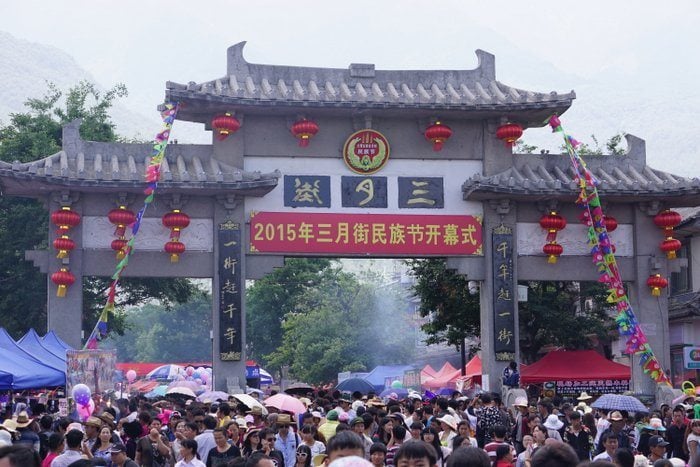
Just like many places around the world, pickpocketing is a huge concern when backpacking China. Be mindful of your things on public transportation and at crowded tourist sights. I once had a guy pick my wallet, grab the cash, and drop it on the ground in the blink of an eye when stepping off a bamboo raft in Yangshuo. These people are pros, so you have to be vigilant at all times.
For many travelers to China, the air pollution is a major concern. While you won’t have to worry about this when you’re out trekking in the mountains, it’s definitely a problem in the big cities.
It’s not a bad idea to invest in a good facemask with a filtration system if you’re going to spend a lot of time in the cities. Take it from me – I moved out of Beijing after 5 years because I couldn’t take the pollution anymore.
Extra Travel Tips for Safety in China
- For more information and safety tips, check out Backpacker Safety 101 for tips and tricks to stay safe whilst backpacking China.
- Pick yourself up a backpacker security belt to keep your cash safe on the road.
- I strongly recommend travelling with a headlamp whilst in China (or anywhere really – every backpacker should have a good headtorch!) – check out my post for a breakdown of the best value backpacking headlamps to take travelling.
Sex, Drugs & Rock ‘N Roll in China
While the Chinese like their booze, they really aren’t that good at making the stuff. Chinese beer is watered down and tasteless, and most of it is only 3-4%. Their wine is absolutely atrocious, so don’t even bother with it.
When it comes to strong stuff, China is all about baijiu . This spirit that is distilled from sorghum tastes somewhat like rocket fuel, and it could probably power your car if you ran out of gas. Some dude said you have to try the stuff 300 times or so to finally acquire a taste for it. I never made it that far and I doubt you will, either.
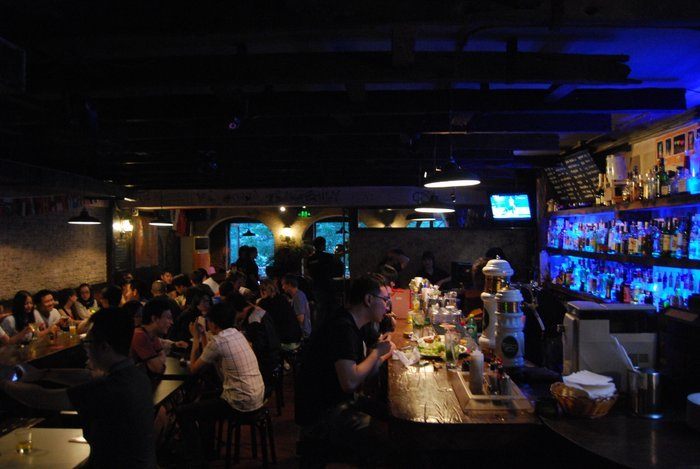
One thing about drinking in China is that things tend to escalate quickly (think the news team battle in Anchorman ). Drinking is somewhat a competitive sport in China, as men love to go glass for glass until one of them inevitably passes out. The concept of grabbing a casual drink at the bar is pretty foreign here, so you’ll have to go to the expat haunts if that’s what you’re looking for.
Drugs in China is definitely a grey area. When we lived in China, people back home were always so surprised to hear that we still puffed tough. “Don’t they have the death penalty there!?” was a common reaction.
While drugs are most definitely illegal in China, this isn’t Indonesia. If you’re caught with a bit of weed, the worst that will probably happen is that you’ll be forced to pay a fine and get deported.
As far as getting the goods goes, it’s not that difficult in the big cities of China. You name it, they got it. I won’t go into details here (my mom might be reading!), but we had some pretty wild nights while backpacking in China. From all night raves in the clubs of Beijing, to day “trips” in the mountains outside of Kunming. Our 3rd eyes were opened once or twice in China.
When walking around the alleyways of Beijing or Shanghai, you’ll most certainly notice several “hairdressers” with red lights in the window. Just like Amsterdam, you ain’t going to these places to get your hair cut. Prostitution is another grey area in China, but chances are nobody is going to bust in and arrest you if you go for a cheeky “haircut.”
Travel Insurance for China
Traveling without insurance would be risky so do consider getting good backpacker insurance sorted before you head off on an adventure.
ALWAYS sort out your backpacker insurance before your trip. There’s plenty to choose from in that department, but a good place to start is Safety Wing .
They offer month-to-month payments, no lock-in contracts, and require absolutely no itineraries: that’s the exact kind of insurance long-term travellers and digital nomads need.

SafetyWing is cheap, easy, and admin-free: just sign up lickety-split so you can get back to it!
Click the button below to learn more about SafetyWing’s setup or read our insider review for the full tasty scoop.
China has tons of international airports, meaning you have plenty of choices to start your trip. Your best bets for flying into China are definitely the bigger cities like Beijing, Shanghai, Guangzhou, or Shenzhen. There are direct flights from these cities to Europe, and North America.
In this section, we’ll take a look at entry requirements for China and how to travel around the country.
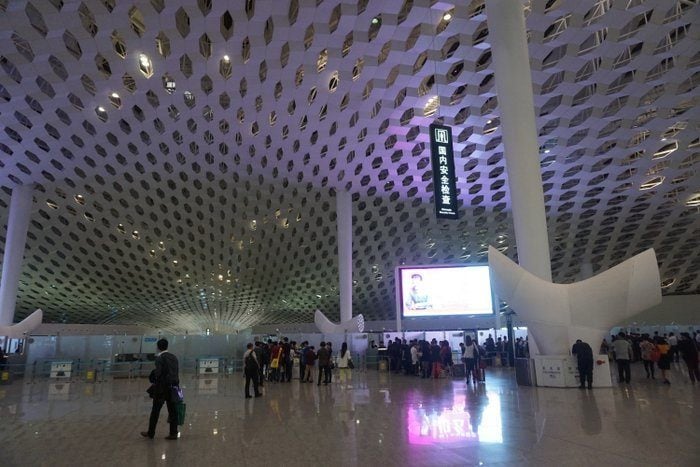
Entry Requirements for China
The visa policy of China is quite complicated. Your best bet is to study the Wikipedia page carefully to see if you need a visa and what kind you should apply for. You’ll want to arrange your visa beforehand at a Chinese consulate or embassy. Be sure to have all the necessary paperwork, as they tend to be very picky and look for any reason to send you out the door to a print or copy shop.
When applying for your Chinese visa, be sure to ask for the maximum amount of time and multiple entries. For example, Americans can now get tourist visas that are valid for ten years with multiple entries of up to 90 days each.
Even if you’ve only got a month-long trip planned, you might as well go ahead and ask for this visa. That way you won’t need to go through the painful process again!
If you’re just passing through China, the good news is that there are several cities you can now visit visa-free if just in transit. Big cities like Beijing and Shanghai now offer 144-hour visa-free visits, while several others give you 72 hours. This isn’t enough time to see much of China, but it does allow you to check out the highlights of a city before catching a connecting flight.

Get 15% OFF when you book through our link — and support the site you love so dearly 😉
Booking.com is quickly becoming our go-to for accommodation. From cheap hostels to stylish homestays and nice hotels, they’ve got it all!
Most major cities in China have an airport and tickets aren’t too expensive if you book in advance.
A word of warning on domestic air travel – China is notorious for long and unexpected flight delays. That’s because the military controls the airspace. I once sat on a plane for 3 hours waiting to take off for no apparent reason. Thankfully, you shouldn’t have to fly much in the country.
Traveling by Public Transport in China
As I’ve previously mentioned, the rail network in China is absolutely epic. There are now high-speed trains linking most of the major cities in the country. For example, taking a train from Beijing to Shanghai will take about the same amount of time as a flight (unless of course the flight is inevitably delayed) and it’s much more enjoyable. For checking train times and booking tickets, I highly recommend Travel China Guide .
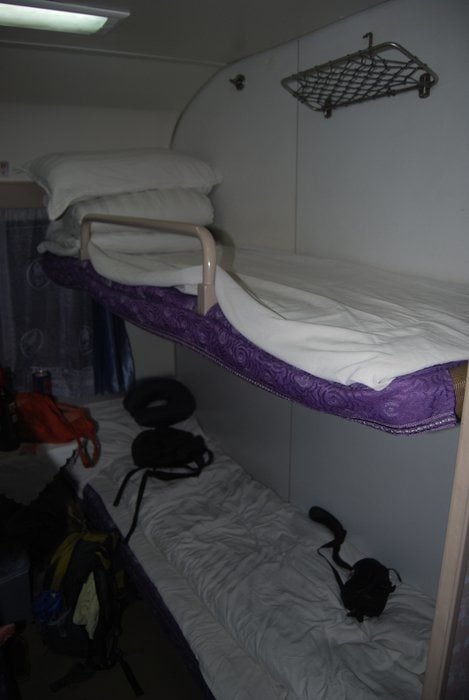
When it comes to buying train tickets, you usually have several choices.
The cheapest option is a hard seat (not just a clever name – these are not at all comfortable). A step up from this is a soft seat. On longer journeys, you can also buy a sleeper ticket. Hard sleeper means six beds to a cabin, while soft sleeper means four. In my experience, hard sleeper is usually the way to go. It’s much cheaper than the soft sleepers and way better than the seats.
Of course, you can always catch a bus to get from point A to point B in China. That’s one of the things I love most about backpacking China – no matter where you’re going, you can get there cheaply via public transportation. We even managed to get to a friend’s village way out in the mountains of Yunnan by a combination of train and bus!
Rather than just rocking up at the bus stop in the hope they will have space to fit you on, you can now book tickets in advance for most of Asia using Bookaway – I love Bookaway and use it myself pretty often when backpacking around Asia.
Hitchhiking in China
If you have patience, it’s definitely a viable option to hitchhike in China . That being said, you’ll definitely want to have a sign in Chinese and hopefully at least a beginner level of Chinese. Don’t expect that truck driver driving outside of Xi’an to speak any English.
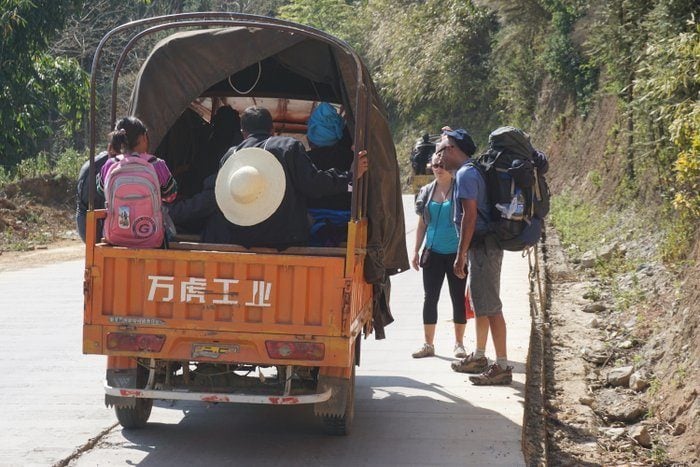
We never tried hitchhiking in China – I’d much rather take the train to guarantee I’m getting to where I’m going on time – but some Couchsurfers who stayed with us managed to get all the way from Beijing to Xinjiang in just ten days by hitchhiking. I thought they were nuts, but they pulled it off!
For more hitchhiking tips, check out our Hitchhiking 101 Post .
Onwards Travel from China
You’ve got nearly unlimited options for backpacking through China and onwards. If travelling by air, the country’s several international airports offer connections to just about anywhere in the world. Thanks to budget airlines like AirAsia, you can even get from Beijing to the Maldives for just $150!
If you’re looking to travel by land or sea, you’ve got plenty of choices as well. Those looking to go backpacking in Southeast Asia next can get from Yunnan or Guangxi to Vietnam by train or bus. You could also catch a 24-hour bus from Kunming all the way to Luang Prabang in Laos.
As for sea crossings, you could board a ferry in Tianjin or Qingdao travelling to South Korea .
One of the great train journeys in the world can bring you from Beijing all the way to Moscow. You can choose between the Trans-Siberian or Trans-Mongolian if you’d like to add a stop in Mongolia. There are tons of options for this trip, which you can plan online or with a travel agent in Beijing.
China has the largest and fastest growing economy on earth. As such, job opportunities are out there for all comers. Loads of multi nationals have operations in China and do need English speaking staff – however, to really exist in China’s economy a degree of fluency in Mandarin will be advantageous.
One notable exception is teaching English. China is crying out for native English speakers and fluency in Mandarin is usually not a requirement. Many ex-pat teachers have a very positive experience in China. Note that some institutions prefer American teachers, others English, and there have sadly been some reported instances of native speakers of colour being given low priority.

A new country, a new contract, a new piece of plastic – booooring. Instead, buy an eSIM!
An eSIM works just like an app: you buy it, you download it, and BOOM! You’re connected the minute you land. It’s that easy.
Is your phone eSIM ready? Read about how e-Sims work or click below to see one of the top eSIM providers on the market and ditch the plastic .
Work Visa’s in China
China Work visa (Z Visa) can be issued to those who have first obtained an employment permit, and intend to work in China. A Chinese government issued working permit or employment license is required. Z visa is usually issued for one entry.
It is normal for would be workers to China to arrange Visa’ through their employer prior to leaving home.
Au Pairing in China
If you have a way with children and don’t fancy teaching, being an Au Pair is a viable option. Global Work and Travel offer an au pair program, where you’ll be given a trip coordinator to support you throughout your stay. They even assist with VISA processing and an online au pair course should you need it.

Teaching English in China
Speaking English is a highly-valued skill all over the world. For locals, it opens up whole new worlds of employment opportunities and travel.
Perhaps one of the best options for backpackers wanting to explore China long-term and experience living in this truly incredible country is to get a Teaching English as a Foreign Language certificate online.

TEFL courses open up a huge range of opportunities and you can find teaching work all over the world. Broke Backpacker readers get a 50% discount on TEFL courses with MyTEFL (simply enter the code PACK50 ).
To find out more about TEFL courses and how you can teach English around the world, read our in-depth report on teaching English abroad .
Au Pair in China
Volunteer in china.
Volunteering overseas is a great way to experience a culture whilst doing some good in the world. There are lots of different volunteer projects in China which you can join ranging from teaching, to animal care, to agriculture to pretty much anything!
China may be an economic powerhouse, but there are still areas where backpackers can donate some time and skills and make a big difference to smaller communities. English teaching is in high demand all over the country, as is help in hospitality and online marketing. You’ll need to apply for an F-visa to volunteer in China, which lets you stay for up to 90 days.
Want to find some awesome volunteering opportunities in China ? Then signup for Worldpackers , a platform that connects local hosts with volunteer travelers. As a Broke Backpacker reader, you’ll also get a special discount of $10. Just use the discount code BROKEBACKPACKER and your membership is discounted from $49 a year to only $39.
Programs run through reputable work exchange programs, like Worldpackers, are generally very well-managed and highly reputable. However, whenever you are volunteering do stay vigilant especially when working with animals or children.
So, so much. It doesn’t matter how long your trip to China is, eat everything! The food is mind-blowing.
- Lanzhou Pulled Beef Noodles – As McDonald’s is to the US, Lanzhou Pulled Beef Noodles are to China. Apparently, there are over 20,000 shops selling it. It really seems like there’s one on every corner. A bowl of these delicious noodles will fill you up and only cost $1-2
- Hot Pot – This is one of the most fun dining experiences you can have. You order up a pot of spiced broth and it boils right there on your table. Then you can choose from a variety of meat, fish, and veggies to toss in the pot. Hot pot restaurants can be found all over China, but the best are in Sichuan and Chongqing.
- Dumplings – On the Chinese New Year’s Eve, families all around China make hundreds of dumplings to eat together. They’re filled with all sorts of things – pork and cabbage, eggs and leeks, lamb and carrot – the list goes on and on. A big plate of dumplings never disappoints!
- Kung Pao Chicken – This is one of the only items on Western Chinese restaurants that’s actually in China. Of course, it’s way better in the country where it’s from! A plate of kung pao chicken with some rice is always a good choice for lunch.
- Beijing Roast Duck – If you’re travelling in the capital, you just can’t miss out on a dinner of roast duck. The best places to eat it are Da Dong or Quan Ju De. This is a culinary experience you’ll never forget! That crispy duck will be one of the best things you eat on your trip for sure.
- Dim Sum – This is technically a Hong Kong dish, but then again Hong Kong is technically China. You can find dim sum restaurants in most Chinese cities, but nothing beats having it in Guangdong or Hong Kong. Come hungry so you can try everything.
- Street Food – There is so much delicious street food in China. From the awesome breakfast crepes known as jian bing , to the sticks of grilled lamb called chuan , it’s not hard to eat well in the street. Pull up a plastic stool and join the locals!
- Bai Jiu – If you’re in China, chances are someone will eventually offer you some bai jiu . I like to call it Chinese rocket fuel, because that’s exactly what it tastes like. This liquor distilled from sorghum is China’s favorite booze and can be found everywhere. It doesn’t taste very good, but when in Rome…
For Chinese cooking classes, check out this site for awesome deals.
It’s not hard to meet the locals in China. With a population of over 1.3 billion, it’s the most populous country on Earth. While everyone from China is considered Chinese, there are actually 56 different ethnic groups.
A vast majority of the people are Han (around 90%), but there are 55 other ethnic minority groups. Great places to experience ethnic minority cultures include Yunnan, Guangxi, Ningxia, Sichuan, and Xinjiang.
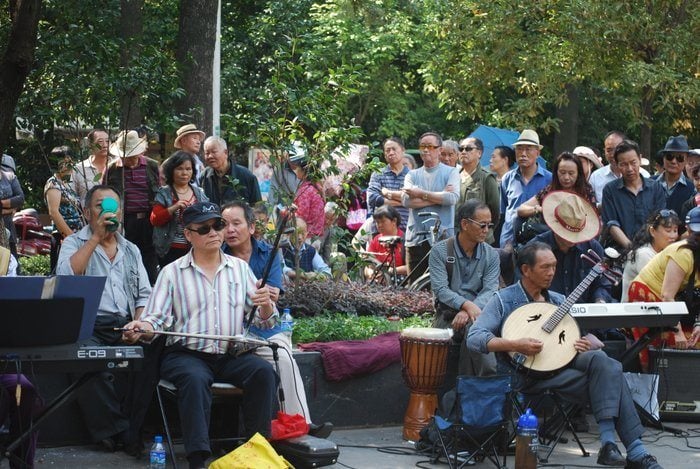
No matter where you are in China, the best place to meet people is in the local park. People love gathering at parks to do things like practice tai chi, dance, fly a kite, play chess, or just drink tea and chat. Sure, there will be a big language barrier if you don’t speak Chinese, but that shouldn’t stop you from interacting with locals. After all, they’ll probably stop you to take your picture anyways!
While people in China may seem a bit cold and standoffish at first, it’s usually just because they really aren’t that used to interacting with foreigners. A smile and a simple “Ni hao” really goes a long way here.
Learn a few phrases in Chinese and you’ll be making friends in no time. Don’t be surprised if people invite you to join them at a restaurant or bar and proceed to force-feed you tons of food and beer!
Dating in China
A common sight in the big cities of China is a local girl with a lao wai (foreigner) dude. The place is practically a gold mine for single foreign men. I once had a buddy who would wait until about 2AM and go down into the clubs in the Wudaokou area in Beijing in his pajamas to pick up girls. “Like shooting fish in a barrel,” he would say. He did pretty well, too.
My yellow fever was only temporary, so I can’t speak much on the subject. One thing I will say is that Chinese men get incredibly jealous and pissed off when they see foreign dudes picking up local girls. The ratio really sucks for them, so it’s hard enough as it is. That’s why I imported my American girl and gave up on the whole scene.
While far less common, you’ll definitely see foreign girls dating Chinese men. Cultural differences tend to get in the way, though, so many of these romances are short-term.
A Brief History of China
We might as well start the recent history of China lesson with the founding of the modern-day People’s Republic of China. After a long Civil War and years of Japanese occupation, the PRC was founded on October 1, 1949 by Mao Zedong. His Communist Party had won the war, and he took over as the new leader of a new China.
Although he’s still revered in China – his face is on every bill, after all – Mao put the country through hell. His disastrous policies during the Cultural Revolution and Great Leap Forward caused millions to starve and die, setting China back several decades. The official policy on Mao is that he was right 70% of the time, which makes you wonder who did that math.
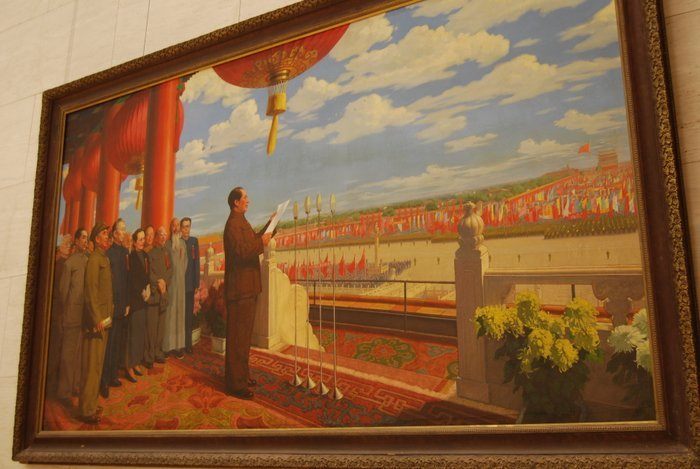
Things started to change in China during the time of Deng Xiaoping. His Reform and Opening policy ushered in a new era for China. The Chinese economy began opening up to the outside world and private enterprises finally started to spring up.
Deng was much more of a pragmatist than Mao, as he famously said, “ It matters not whether the cat is black or white, as long as it catches mice.” And this new Chinese economy most certainly caught some mice.
Over the next few decades, the Chinese economy boomed. The population also grew, breaking one billion by the 1982 census. Tourism finally started to open up, and foreign businesses began moving into China as well. The drab Maoist era seemed long gone as the Chinese started driving Audis, eating KFC, and dancing to jazz.
While much had improved for the people of China, many still wanted more reforms. In 1989, students protested in Tiananmen Square calling for democracy and more freedoms. Eventually, the government stepped in and declared martial law. Armed military officials and tanks were sent into the square to suppress the protests. In what came to be known as the Tiananmen Square Massacre, hundreds to thousands of people were killed (there are no official figures on the death toll). A dark cloud would hang over China for years as a result.
China in Modern Times
Under president Jiang Zemin, China continued to enjoy substantial growth. While many people still wish for a change in the government, they remained quiet after witnessing what had happened in 1989. The country did experience change in the 90s, as Hong Kong and Macau were both peacefully returned to China.

The next president of China was Hu Jintao, who served from 2003 to 2013. During his tenure, China’s economy continued to grow rapidly, eventually surpassing Japan to become 2nd in the world. While much of the developed world struggled to recover from the global financial crisis, China made it through relatively unscathed. During this time, China also began to extend its influence around the globe.
Next in line was Xi Jinping, who remains the president of China. While his predecessors have stuck to the two 5-year term limit, Xi recently passed reforms that removed this limit. It appears as if he is setting himself up for a long run as China’s head of state.
In borrowing a popular phrase from the US, he has been focused on achieving the “Chinese Dream” for the people of China. Only time will tell how things will work out.
Useful Travel Phrases for China
With its four tones and thousands upon thousands of characters, Chinese is definitely an intimidating language to learn . You’ll definitely need a bit of the language when backpacking China though, as English is not exactly prevalent there.
Here are some useful Chinese travel phrases to get you started:
Hello = Ni hao
How are you? = Ni hao ma?
I’m fine = Wo hen hao
Please = Qing
Thank you = Xiè xiè
You’re welcome = Bù kè qì
Goodbye = Zài jiàn
I’m sorry = Duì bù qi
No plastic bag – Wú sùliào dài
No straw please – Bùyòng x?gu?n
No plastic cutlery please – Q?ng bùyào sh?yòng sùliào c?njù
Where is the bathroom? = Xi shou jian zài na l??
What’s this? = Zhè shì shén me?
I want a beer = Wo yào yi ge pí jiu?
How much is it? = Duo shao qián?
If you’re interested in learning Chinese, you should follow the Chinese Language Blog . There are tons of articles on vocabulary and grammar as well as Chinese culture.
Books to Read about China
- Lonely Planet China Travel Guide : The OG of guidebooks, Lonely Planet’s China guide is packed full of useful information to get you through your trip backpacking China.
- River Town : Peter Hessler’s memoir about his time as a Peace Corps volunteer in rural Sichuan is one of the best books on China I’ve ever read. If you dig his style, he’s got a few other books set in China you can pick up as well.
- Factory Girls : If you’re going to read Hessler’s books, you might as well read his wife’s as well. Leslie Chang’s story of the lives of girls toiling away in China’s boomtown factories is an eye-opening read that will make you think twice every time you see that “Made in China” tag.
- Lost on Planet China : When I first moved to China in 2008, my mom bought me this book as a going away present. J. Maarten Troost’s hilarious tale of his misadventures in China perfectly sums up what it’s like traveling in this unpredictable country.
Internet in China
The internet in China sucks, plain and simple. This isn’t because of a lack of access or speed, but because of censorship.
These are the things you won’t be able to freely access in China – Facebook, Twitter, Instagram, YouTube, Google, and yes, it’s sad but true, porn as well. If you need these things in your life, you’ll want to get a VPN before heading to China. I always used Astrill when I lived there and found it to be the most reliable.
In the past few years, many companies have brought to market a plethora of VPN products and China is for sure a big market because of the reasons stated above. Depending on your budget, you can find VPNs starting from only $3/month, many will give you a 30 day free trial and much more. To find the right one for you and your needs, check this VPN list.
When you can actually get on the websites you want to use, the internet is just fine. Chinese people are absolutely obsessed with being online (who isn’t these days?), and you can find WiFi just about everywhere. Internet bars are also huge in China, that is if you want to join chain-smoking teenagers playing RPG games.
Oh, you may also find this SIM card For China post helpful.
When it comes to must try experiences while backpacking China, nothing tops camping out on the Great Wall. This isn’t possible on every section, but there are a few where you can get away with it. I’ve camped out on both the Jinshanling and Gubeikou sections of the Wall with no issues and would highly recommend giving it a shot.
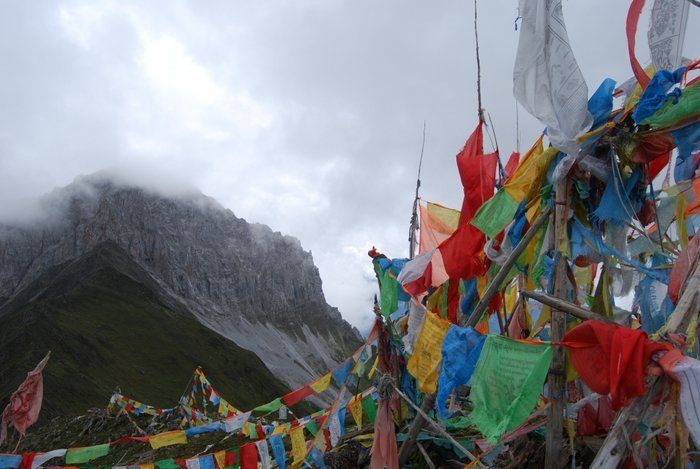
Other excellent hiking opportunities include the Tiger Leaping Gorge in Yunnan and the Zharu Valley eco-trek just outside of Jiuzhaigou National Park in Sichuan. You can do the Tiger Leaping Gorge on your own but will need to sign up for a trip with a local guide for Zharu Valley.
Yangshuo is one of the top backpacker towns in China and is full of must-try experiences. It’s also one of the only places in China where you can rent a motorbike. Get some wheels and explore the stunning countryside full of karst mountains, stopping to try some rock climbing or enjoy a bamboo rafting trip on the river.

Things go wrong on the road ALL THE TIME. Be prepared for what life throws at you.
Buy an AMK Travel Medical Kit before you head out on your next adventure – don’t be daft!
Trekking in China
I’ve already mentioned several of the best treks in China in other sections of the guide, but I’ll repeat myself in case you passed over them. Your best bets for trekking include the Tiger Leaping Gorge in Yunnan, the Zharu Valley in Sichuan, and the Longji rice terraces in Guangxi.
There are several mountains you can “climb” in China as well. I put climb in quotes because the Chinese way to climb a mountain is by walking up several thousand stairs. Not quite as adventurous as actually climbing a mountain…
On your first time visiting China, it may seem like an absolute free-for-all. People drive like maniacs. There’s litter everywhere. People spit on the sidewalk. Men binge drink and yell at their waitresses in restaurants. This may seem like an invitation for you to do the same, but you’re better than that.
As a foreigner in China, you’re representing all of us (they tend to group us all together). Perhaps by witnessing more civil behavior from tourists, these less than ideal habits in China may start to disappear.
That being said, a great thing about travelling in China is that there aren’t a ton of social norms you have to worry about. You can pretty much dress however you want, you can loudly slurp your noodles, and you can get blackout drunk at a bar and they’ll still serve you.
You can also pretty much say whatever you want since English is generally very lacking in China. However, there are a few things to consider.
When in China, you want to avoid talking about the “3 Ts” – Tiananmen, Tibet, and Taiwan. These are very sensitive topics and can easily cause a huge argument. You may have strong feelings on Tibetan independence, but mainland China is not the place to voice those. Having said that, if you’re looking to continue your travels after China, we highly recommend you go backpacking through Taiwan (Just don’t speak too much about it when you’re in China!)
Also, be sure to be respectful in important historical and cultural sights. This is especially true in places like the Forbidden City and Tiananmen Square. You’ll see tons of armed guards there, and they’re not messing around. Don’t go in areas that are blocked off, don’t take offensive photos… you know the drill.
It’s Time to Go Backpacking in China
China may not be on the top of many backpacking lists, which is understandable. The visa process can be time-consuming and expensive depending on where you’re from. It’s true that the pollution in the big cities can be pretty awful. And yes, the people in China can be a bit… shall we say, intense. However, the juice is definitely worth the squeeze if you put forth the time and effort for a massive backpacking trip.
Once you get home and reflect on all those amazing experiences – hiking on the Great Wall, eating some mouth-watering Sichuan cuisine, seeing the Terracotta Warriors, cycling amongst karst mountains – you’ll realize it was absolutely worth it. Hell, you’ll probably start scheming up a way to get back to China to do some of the things you inevitably missed on your first trip.
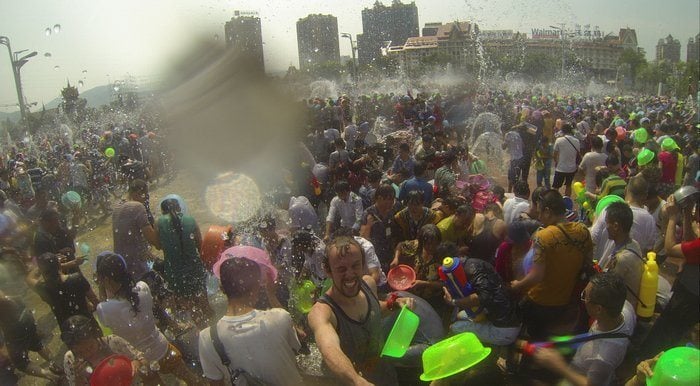
When I first moved to China, I thought I would stay a year and give teaching English a try. Then something happened. I fell in love with learning about other cultures and languages. I also fell in love with backpacking, which is great because those interests go hand-in-hand. For the next several years, I was fortunate enough to travel extensively around China, all the while trying the food, experiencing the holidays, and trying my best not to butcher Chinese.
Almost a decade later, and I’ve now lived in three countries and done extensive backpacking trips across South America and Southeast Asia. For me, it all started in China.
I know there are more glamorous places to visit in the region. I’m aware you can go visa-free to several others. I also know that there’s no place in the world quite like China and that you can’t really say you’ve traveled the world until you’ve visited her most populous country. So go ahead and apply for that visa, because trust me when I say it’s well worth it.
- Buying a sim card for China
- Most beautiful places in China to visit
- Backpacking South Korea
- Backpacking Japan guide

And for transparency’s sake, please know that some of the links in our content are affiliate links . That means that if you book your accommodation, buy your gear, or sort your insurance through our link, we earn a small commission (at no extra cost to you). That said, we only link to the gear we trust and never recommend services we don’t believe are up to scratch. Again, thank you!
Share or save this post

Hi there, there’s a brand new train line connecting Kunming, China to Vientiane, Laos!
Yeah, when traveling to China I would choose new VPN providers as their servers are not blocked yet there. I used Surfshark during my last trip to China. It worked alright, speed was good enough and stable. Plus, with one account I could use it for a couple of devices I could use social media channel wherever I go. If someone is interested here is the code that I used: (Surf24) it still should work I guess.
Leave a Reply Cancel reply
Your email address will not be published. Required fields are marked *
Save my name, email, and website in this browser for the next time I comment.
Notify me of followup comments via e-mail.
An Awesome 2 to 4-Week China Itinerary
January 23, 2020.
Welcome to China – one of my favourite countries on Earth.
China is an extremely beautiful and diverse country, and you could spend years travelling around it and still not see everything.
I’ve spent over 3 months total backpacking around China, and have learned a lot about the country.
In this post, I’ve created an awesome 2 to 4-week travel itinerary for China to help you plan your trip. Let’s get right into it!
- 1.1 Beijing (Days 1 to 4)
- 1.2 Xi’an (Days 5 to 7)
- 1.3 Chengdu (Days 8 to 10)
- 1.4 Yangshuo (Days 11 to 14)
- 2.1 Beijing – Xi’an – Chengdu (Days 1-10)
- 2.2 Shangri-La (Days 11 and 12)
- 2.3 Tiger Leaping Gorge (Days 13 and 14)
- 2.4 Dali (Days 15 and 16)
- 2.5 Travel to Yangshuo (Day 17)
- 2.6 Yangshuo (Days 18-21)
- 3.1 Days 1 to 21: Same as above
- 3.2 Hong Kong (Days 22-25)
- 3.3 Shanghai (Days 26 to 28)
- 4 Other China Travel Destinations
- 5 China Travel Itinerary Wrap-up
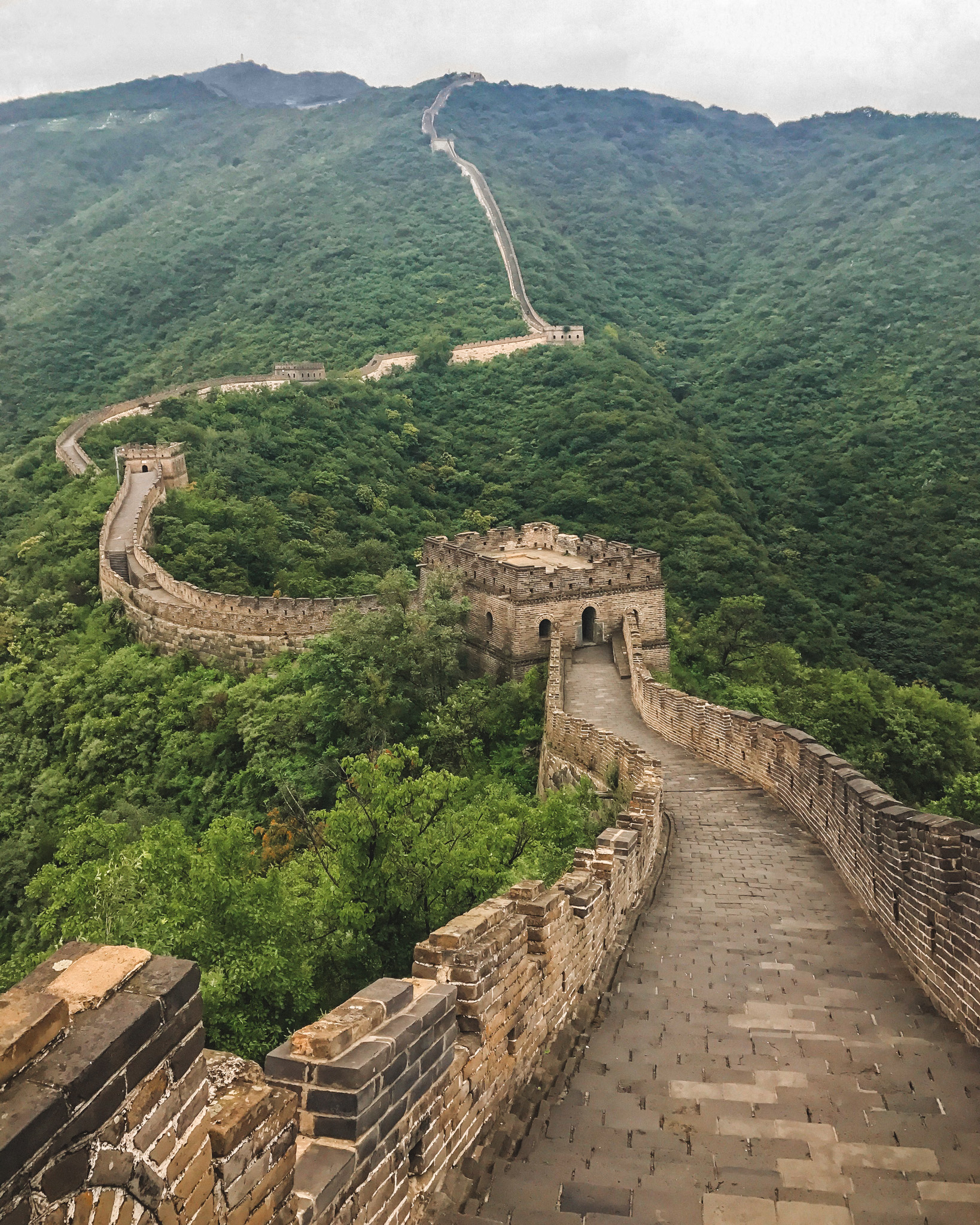
A 2-Week China Itinerary
Beijing (days 1 to 4).
Beijing is a city full of interesting history and delicious food making it the perfect place to start off your China itinerary.
With four days in Beijing, you’ll have time to check out the Forbidden City and Tiananmen Square, the Summer Palace, and even make it out for a trip to the nearby Great Wall. If you really want to be adventurous, you can even try camping on the great wall .
Be sure to try out some Peking duck and spend some time exploring the city’s hutongs.
Where to stay in Beijing
There are countless hostels and hotels in Beijing. I stayed at the Leo Hostel and highly recommend it. It’s in a great location, and has a nice common area to meet other travellers.
Getting around Beijing
Beijing has an extensive metro system, and I used it to get everywhere. Many of the main tourist sites are located within walking distance of Tiananmen Square.
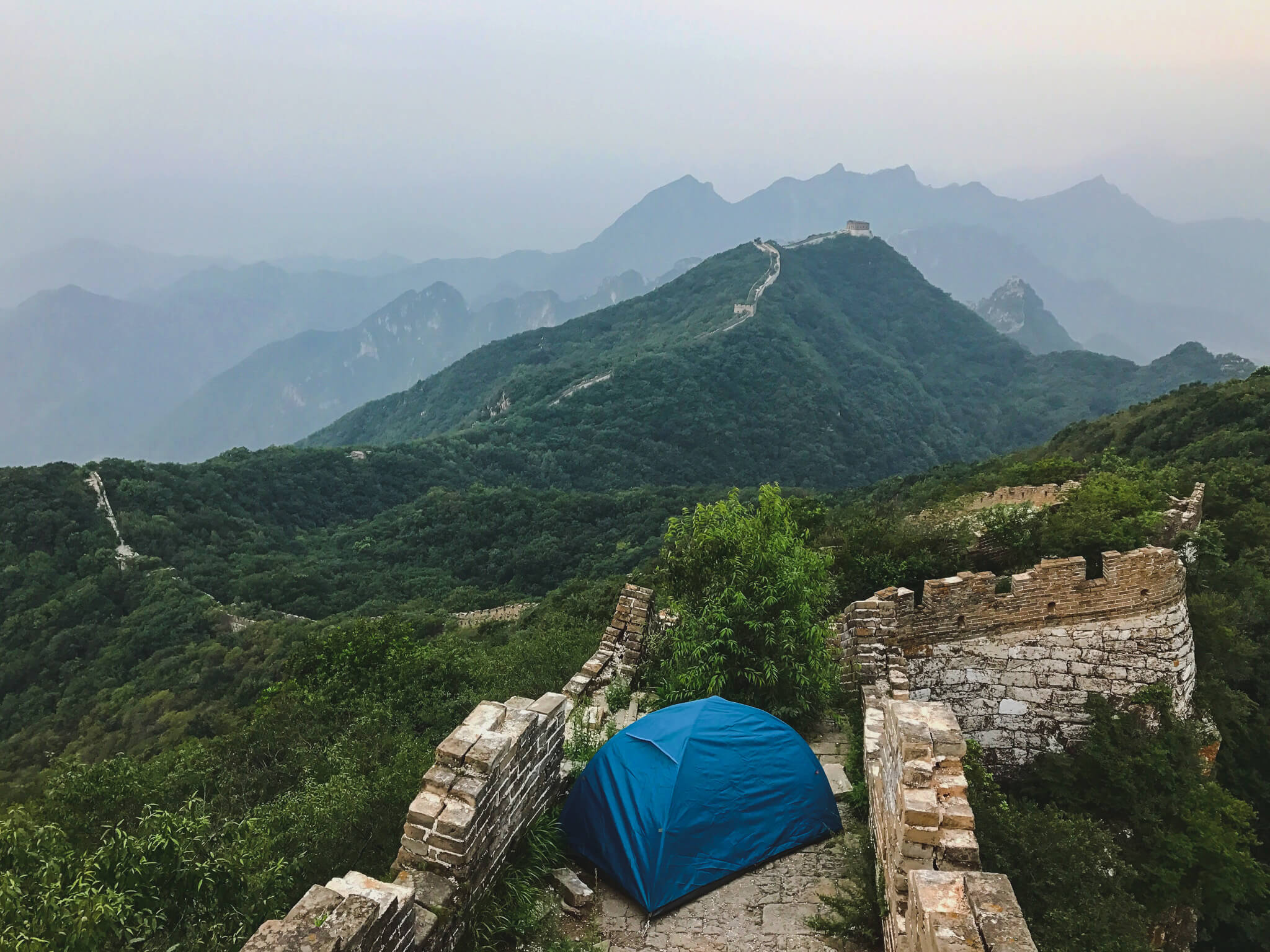
Xi’an (Days 5 to 7)
Xi’an is the Eastern end of the Silk Road and home of the famous Terracotta Warriors .
The city is also home to a large Muslim Quarter that’s filled with delicious street food. You seriously can’t miss the food here, it’s some of the best in all of China. I recommend visiting in the evening, it’ll be packed with vendors and people and you’ll definitely have a good time.
Xi’an also has a 13.7-kilometre city wall surrounding the city center, and biking around it was a highlight of my time there. You can rent bikes at booths on the wall for 45¥ per 3 hours.
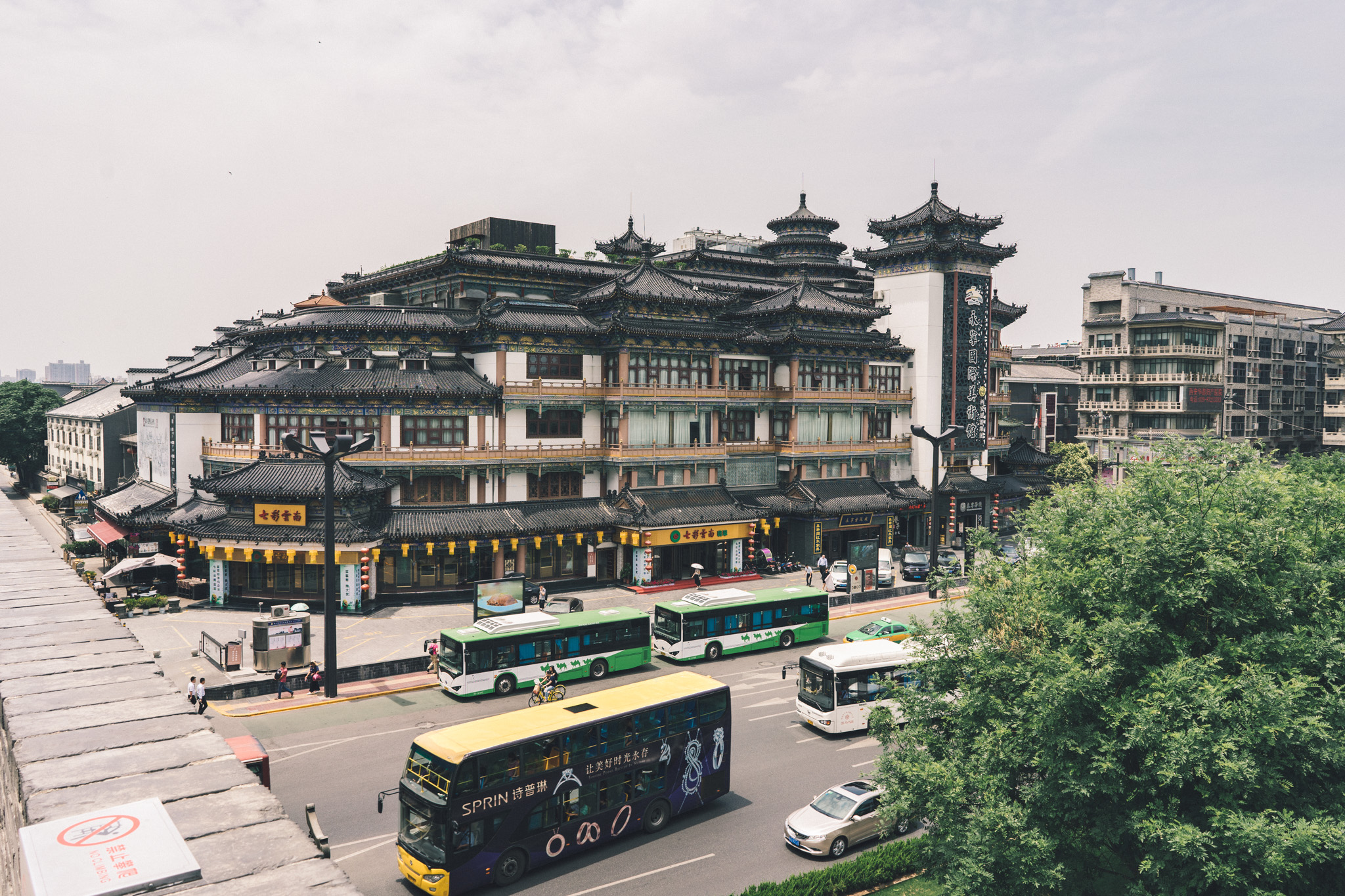
Getting to Xi’an from Beijing
China has the world’s largest high-speed rail network, so why not check it out? A ride between Beijing and Xi’an on the HSR will take 5 or 6 hours. If you want to save some cash, take an overnight hard sleeper train.
Where to stay in Xi’an
Most of the main sites (other than the terracotta warriors) are inside the city walls, so choose a place to stay located inside the walls. I stayed at the Hantang Inn and loved it. There’s a delicious and cheap BBQ restaurant right across the street that I ate at a few too many times 🙂
Getting around Xi’an
Most attractions are located inside the city walls, so walking is the best way to get around. To visit the terracotta warriors, you’ll need to take a one hour ride on tourist bus line 5 from the east square of the Xi’an Railway Station. The city also has a metro system that can be useful for getting to certain places.
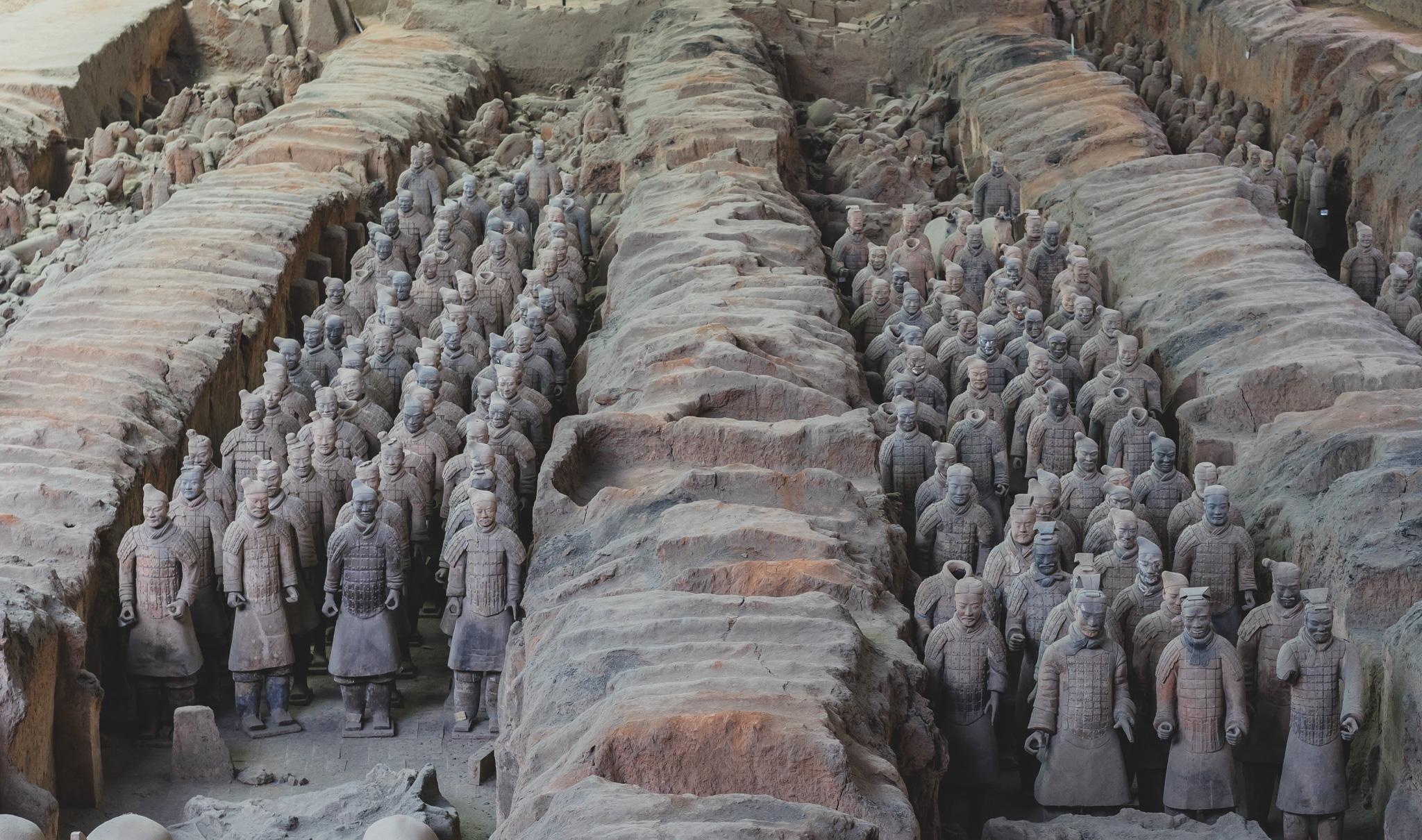
Chengdu (Days 8 to 10)
Chengdu is my favourite city in China – you definitely can’t miss it.
It’s known for two things – pandas and spicy food. But, Chengdu is also just a pleasant city to hang out in. People in Chengdu are a bit more “chill” than the rest of China, and the city has growing cafe and art scenes.
The Panda Research Base is accessible by a short metro and bus ride combo. You should try to visit early in the morning, as that is when the pandas are most active. Another good day trip is the Leshan Buddha, which is only 1 hour away by high-speed rail. Make sure to try hot pot while you are in Chengdu.
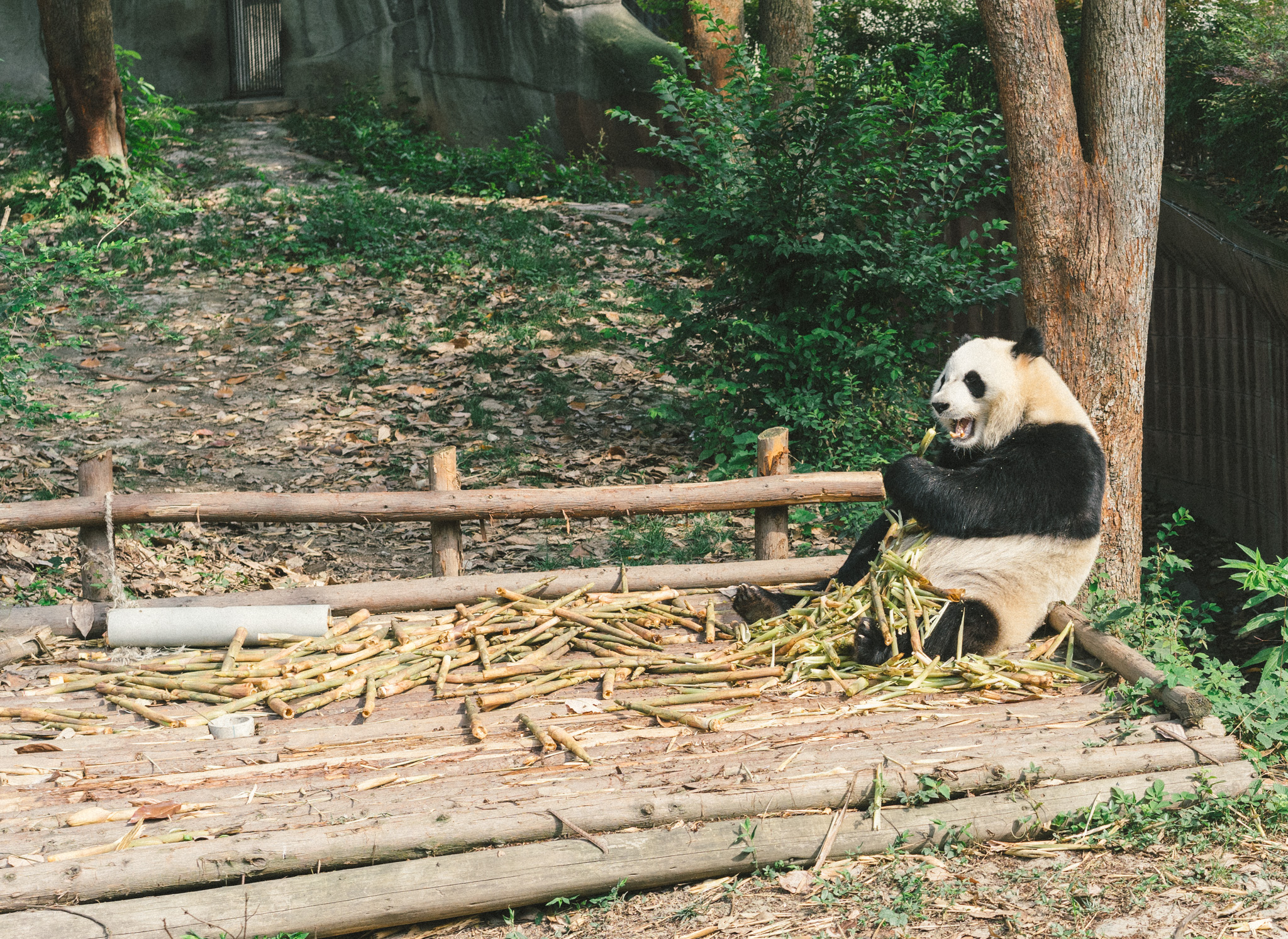
Getting from Xi’an to Chengdu
I recommend taking the train. You can take a 3-4 hour high-speed train for about $40.
Where to stay in Chengdu
I recommend the Flipflop Hostel – it has a great downtown location and friendly staff. I made some great friends here!
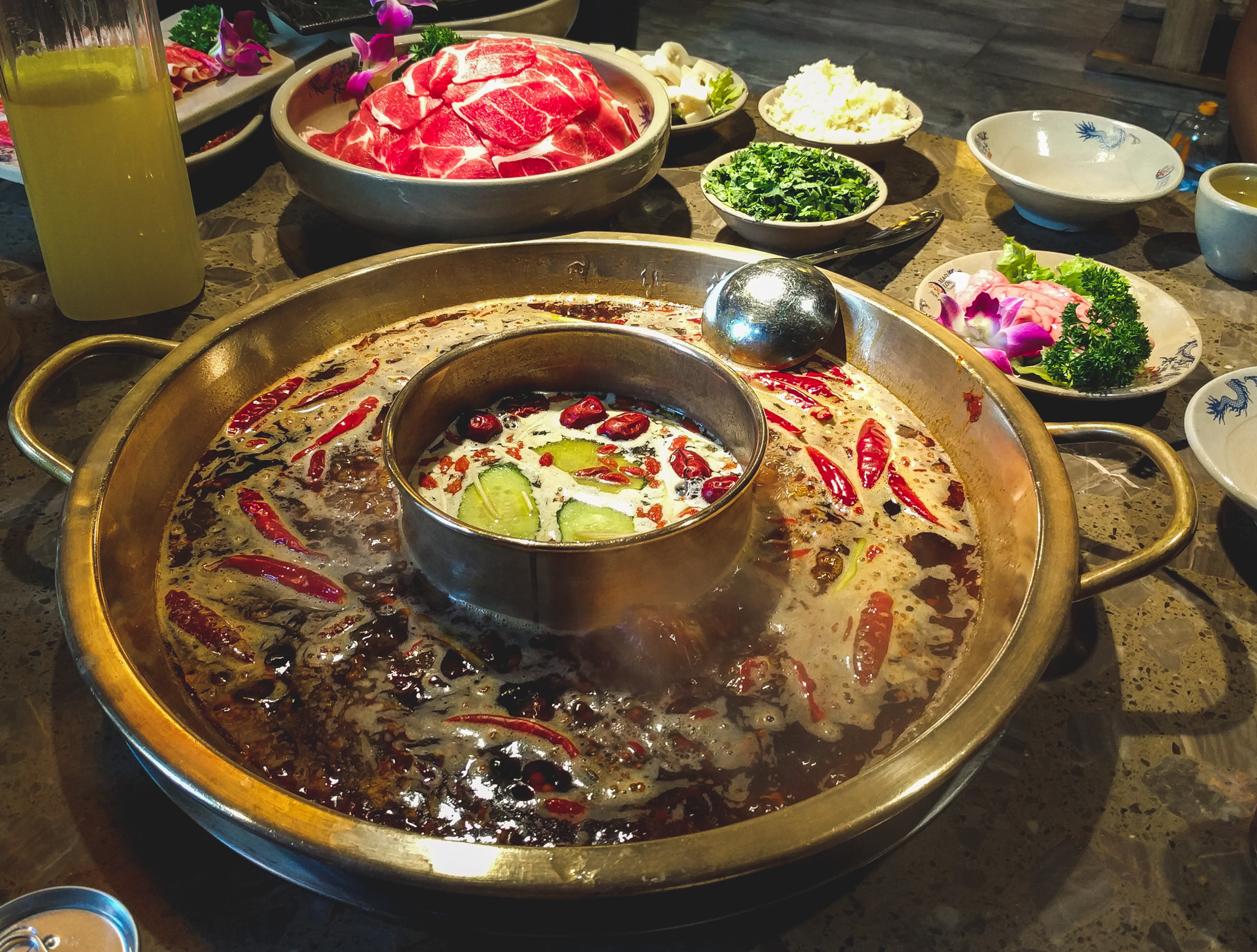
Yangshuo (Days 11 to 14)
Yangshuo is a stunning destination and a must-have on any China backpacking itinerary. It’s a very popular destination for both domestic and foreign travellers, so there’s a ton of tourist infrastructure that makes visiting easy. Yangshuo itself is a pretty big and busy town now, so if you’re looking for a more relaxing time, check out the nearby Xingping village.
In Yangshuo, rent a bicycle or electric scooter and do some riding around the beautiful countryside, take a boat ride on the incredible Li River, and climb one of the karst pillars for incredible views of the area.
Getting to Yangshuo from Chengdu
Getting to Yangshuo from Chengdu is pretty simple. Yangshuo now has an HSR station, and there are direct trains there from Chengdu. The journey will take about 7 hours, and there are a number of different trains per day.
Where to stay in Yangshuo
I stayed at the Wada Hostel and enjoyed its very central location. Consider also checking out the rooftop bar at Monkey Jane’s hostel while you’re in Yangshuo.
Things to do in Yangshuo
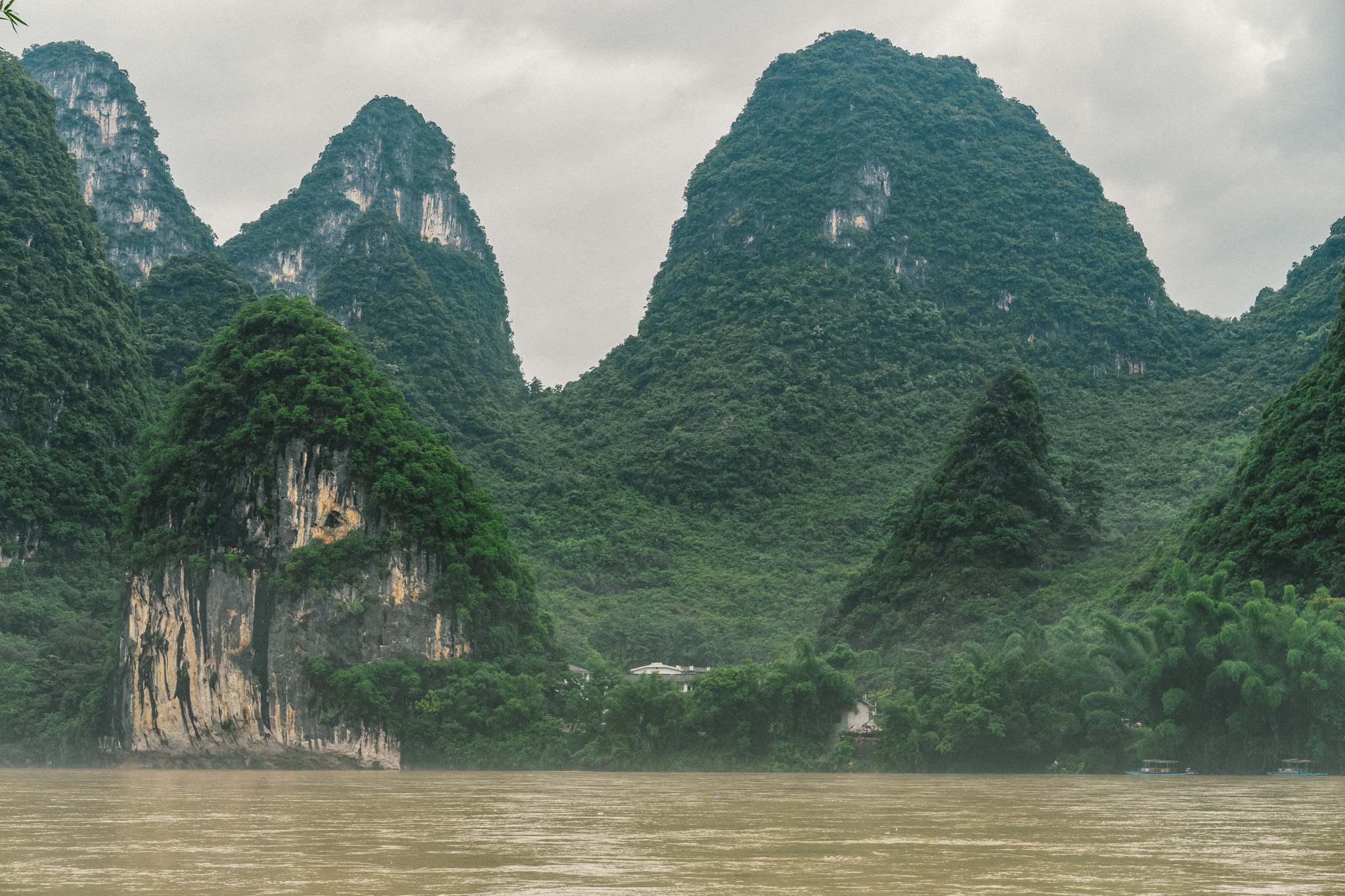
A 3-Week China Itinerary
Beijing – xi’an – chengdu (days 1-10).
The first 10 days of this itinerary are the same as the 2-week itinerary outlined above. Check it out for the details.
Shangri-La (Days 11 and 12)
Shangri-La is a historically Tibetan town located in northwestern Yunnan. The town has a beautiful monastery and an old town that’s been mostly rebuilt after a devastating fire in 2014. At a little over 3000 meters in altitude, you’ll definitely feel a bit short of breath walking around town.
Check out my post on travelling in the Tibetan parts of China without a tour for some more info on the Tibetan parts of China that are easily accessible.
Getting to Shangri-La from Chengdu
With a short amount of time, the only way to get between the two is by plane. There are daily flights with both China Eastern and Tibet Airlines, taking about 2 hours. I would fly to Shangri-La on day 11 and spend the afternoon of day 11 and all of day 12 visiting the sites.
There is an alternative overland route from Chengdu to Shangri-La, that takes you through some seriously remote Tibetan parts of Sichuan. Unfortunately, this route takes a little more time than we have, but if you’re able to give yourself an extra week in China, I highly recommend checking out my guide to travelling overland from Chengdu to Shangri-La .
Where to stay in Shangri-La
Tavern 47 was a nice hostel. They have cool Tibetan-style decor and great breakfasts.
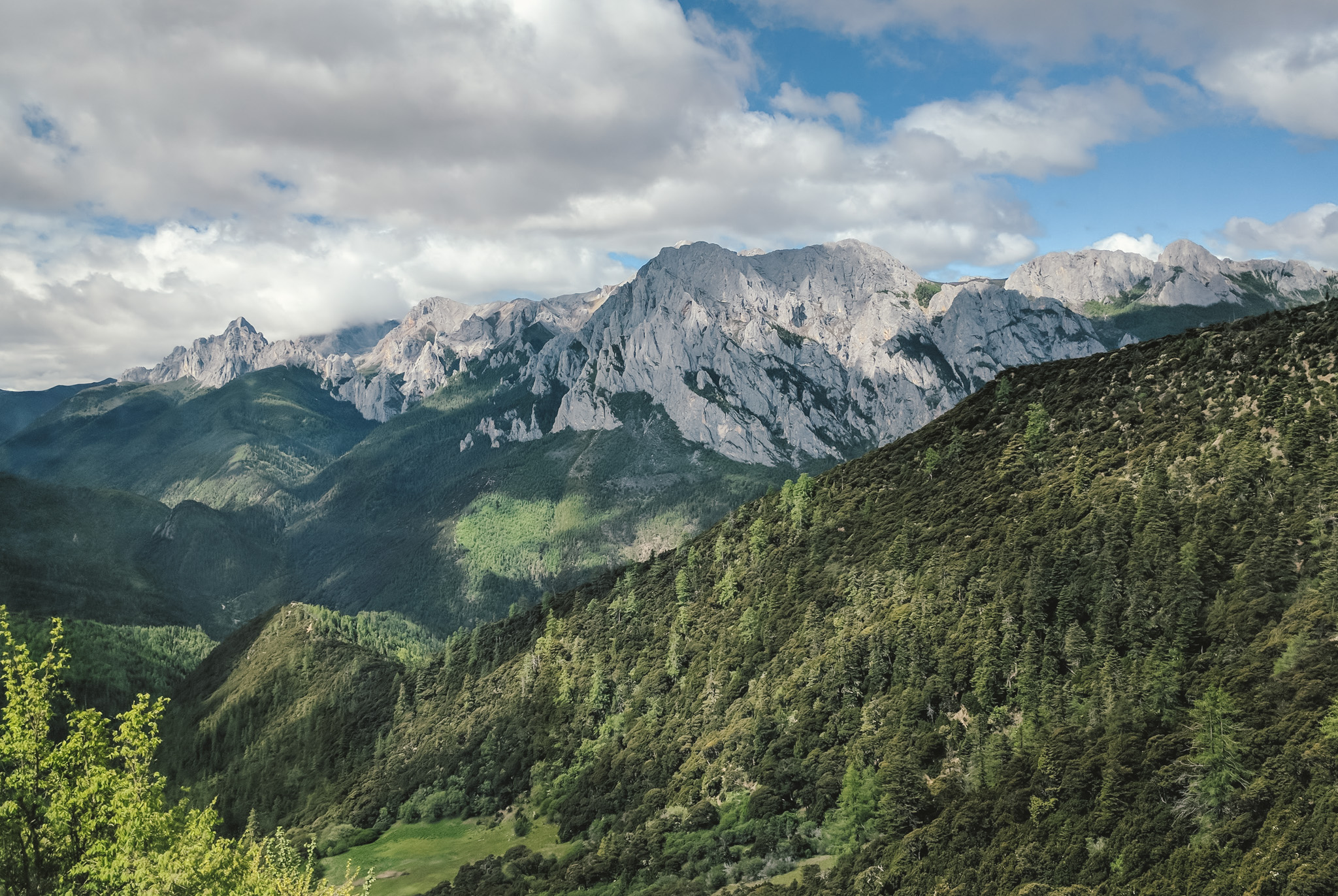
Tiger Leaping Gorge (Days 13 and 14)
Tiger Leaping Gorge is one of the most insane landscapes in China. There’s a trail running along the northern side of the gorge that typically takes two days to complete. Check out this page on WikiVoyage for more info on the Tiger Leaping Gorge hike.
Getting to Tiger Leaping Gorge from Shangri-La
The hike starts in Qiaotou, which is 3 hours by bus from Shangri-La. Leave Shangri-La early enough so you are able to hike to the halfway guesthouse that same day.
Where to stay in Tiger Leaping Gorge
You’ll need to spend one night in the gorge if you choose to do the two-day hike, but don’t worry, there are plenty of comfortable guesthouses near the middle of the hike. The Halfway Guesthouse is the most popular, and it’s got one of the most incredible squat toilet views you’ll ever have the pleasure of seeing 😉
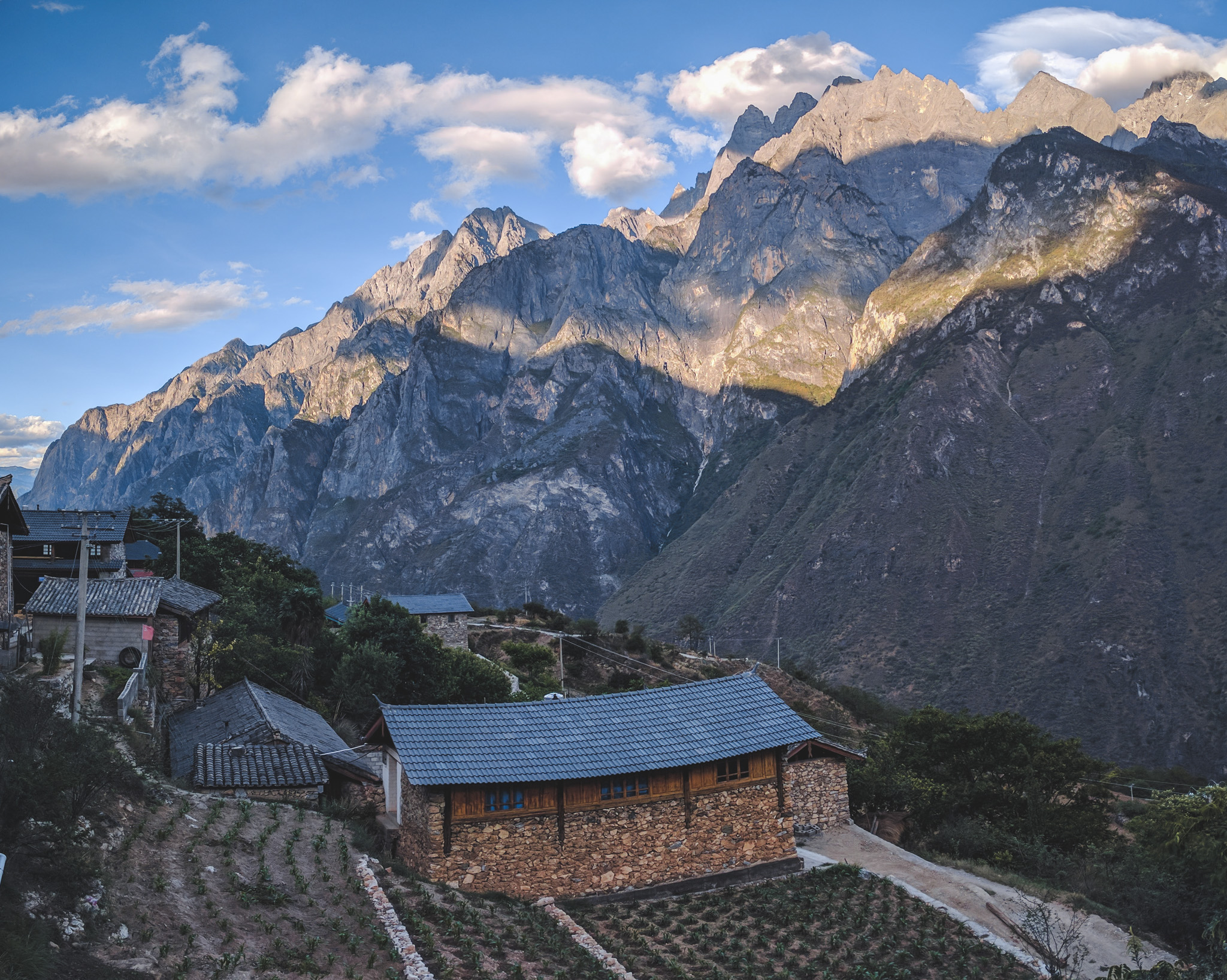
Dali (Days 15 and 16)
There are very few places in China that have a real South East Asia ‘backpacker vibe’, and Dali is one of them. It’s home to an impressive old town, countless cafes and bars, and beautiful natural surroundings. In Dali, I recommend visiting the Three Pagodas and renting an electric scooter to ride the road along Erhai Lake (but please wear a helmet).
Getting to Dali from Tiger Leaping Gorge
Getting to Dali will require a quick transfer in Lijiang (another popular destination, but very touristy). From Tiger Leaping Gorge to Lijiang, it’s a three-hour bus ride. Lijiang to Dali can be done via bus or train – your choice. The train will be slightly faster, but since you’re getting to Lijiang by bus, it may be easier to just take another bus. The train will take about two hours, whereas the bus will take three.
Where to stay in Dali
The Jade Emu is an awesome place to stay. They have a great common area with a pool table, ping pong, foosball, and darts. There’s even a bookshop next door that sells books in English!
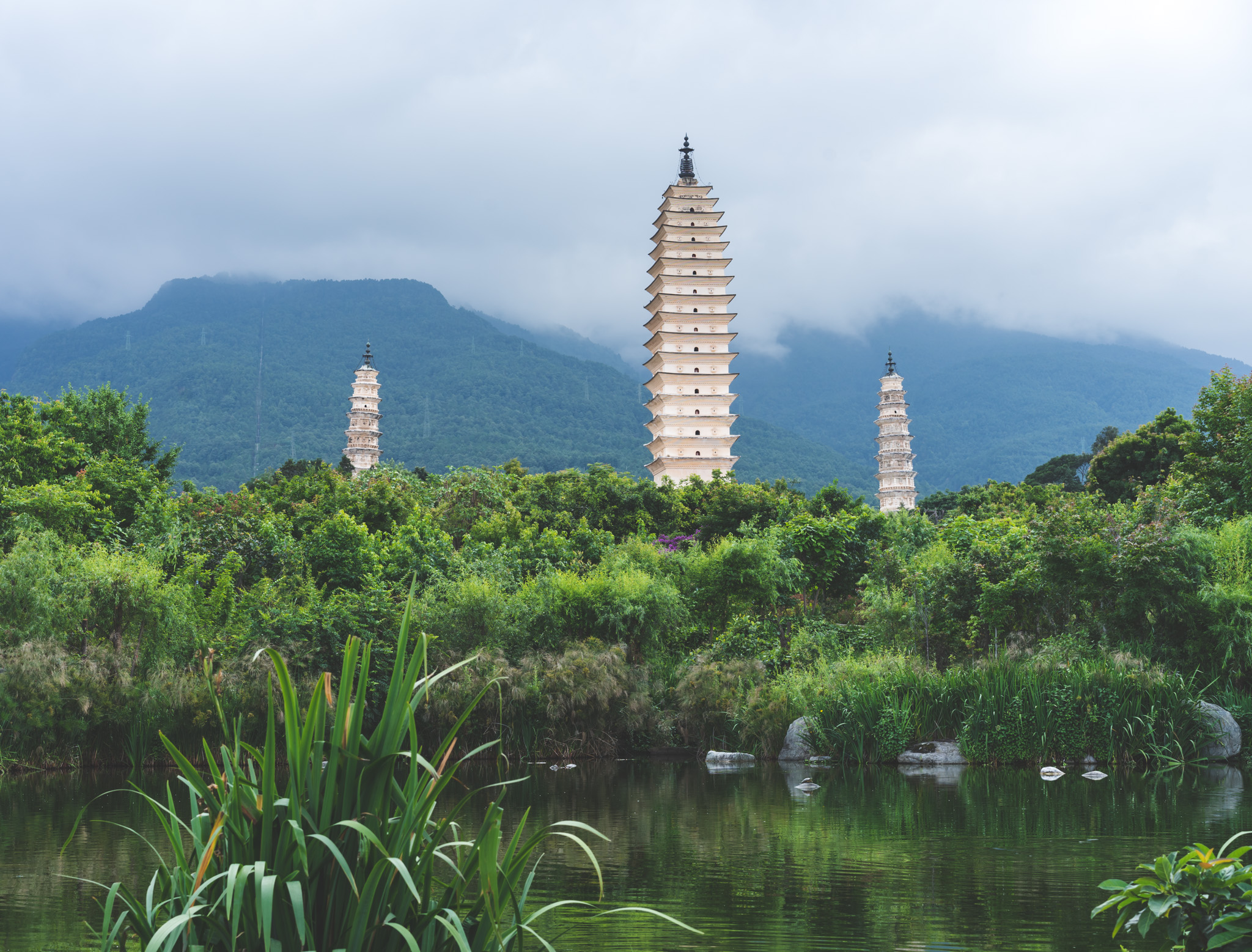
Travel to Yangshuo (Day 17)
From Dali, it’s a bit of a trek to Yangshuo, but it’s doable in a single long day if you’re up for it. You’ll need to transfer in Guilin.
Getting from Dali to Guilin
In the morning, take a two-hour high-speed train to Kunming. Next take an early afternoon high-speed train from Kunming to Guilin, which will take four and a half hours. Spend the night in Guilin, or continue onto Yangshuo if you’re up for it.
Getting to Yangshuo from Guilin
Getting to Yangshuo from Guilin is very easy – there are extremely frequent busses and the ride is only one hour. You can also take a river cruise for more money, but I didn’t bother. The river cruises are popular amongst domestic tourists.
Yangshuo (Days 18-21)
Wrap up your 3 weeks in China with a few days in Yangshuo! See the 2-week itinerary for more details on where to stay and things to do in Yangshuo.
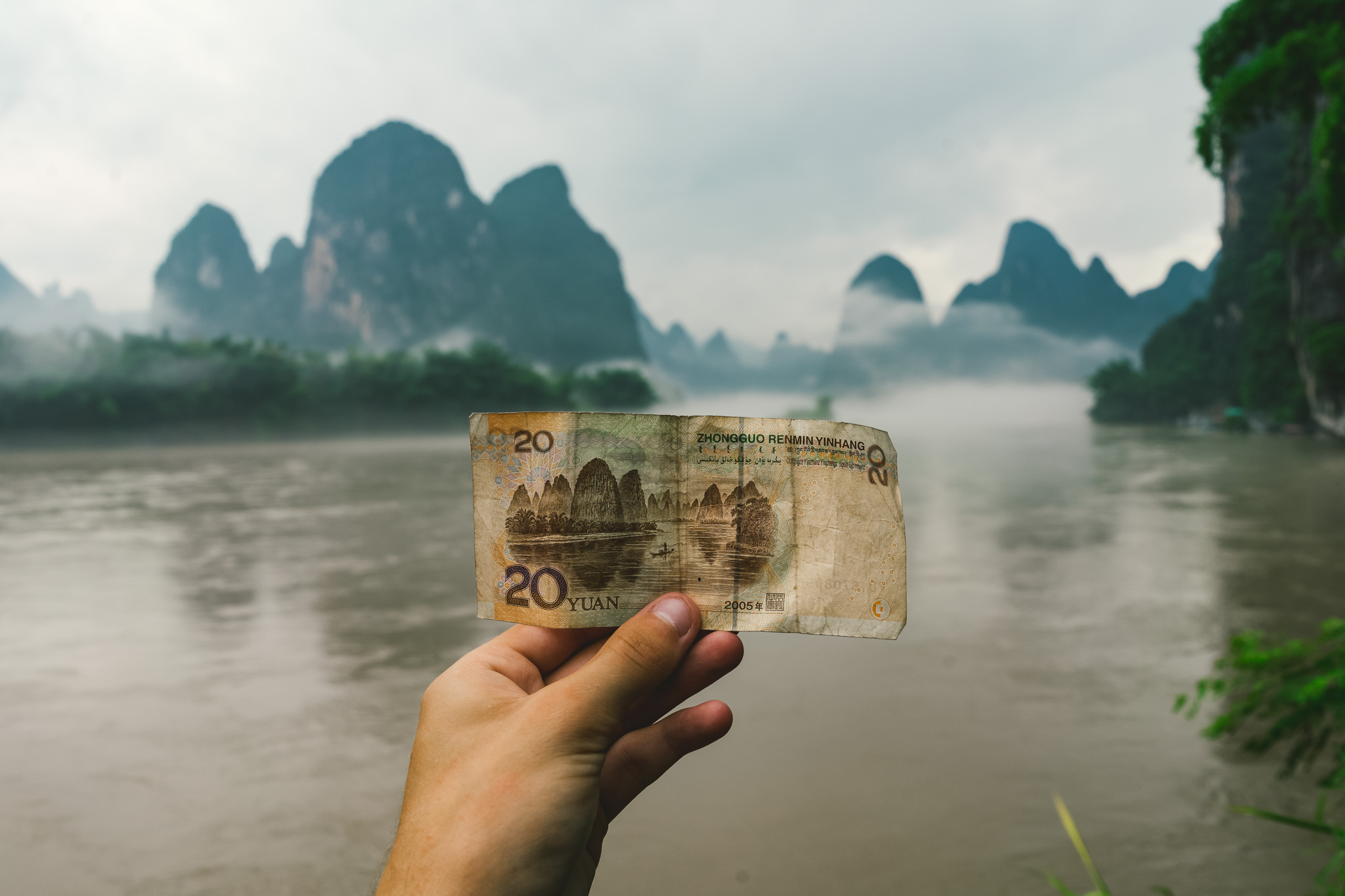
A 4-Week China Itinerary
Days 1 to 21: same as above.
Follow the 3-Week itinerary for the first part of your month in China.
Hong Kong (Days 22-25)
Hong Kong needs no introduction – it’s a massive, globalized city that one could spend a lifetime in and not finish exploring it. Hong Kong feels very different from the rest of China due to its history. Clerks in 7/11 speak English, and everything costs a whole lot more. Hong Kong is definitely worth visiting if you haven’t been before, but if you have, consider checking out the nearby Chinese megacities of Guangzhou and Shenzhen.
Visa note: To enter Hong Kong, you have to “leave” China (on your passport). This means that if you have a single-entry Chinese visa, you won’t be able to enter again without getting a new one. If you still want to spend more time in China, consider skipping Hong Kong and visiting Guangzhou and Shenzhen.
Getting to Hong Kong from Yangshuo
With the recent opening of the Hong Kong – Guangzhou high-speed rail line, getting between Yangshuo and Hong Kong has never been easier. Simply take a high-speed train from Yangshuo to Guangzhou and then transfer onto another train from Guangzhou to Hong Kong. The overall travel time will be about four and a half hours. Check out Travel China Guide for a detailed schedule.
Where to stay in Hong Kong
I stayed at the Causeway Bay Yesinn hostel, it’s a nice hostel located right downtown. It’s located only two minutes from a metro station, and there are so many restaurants and shops around.
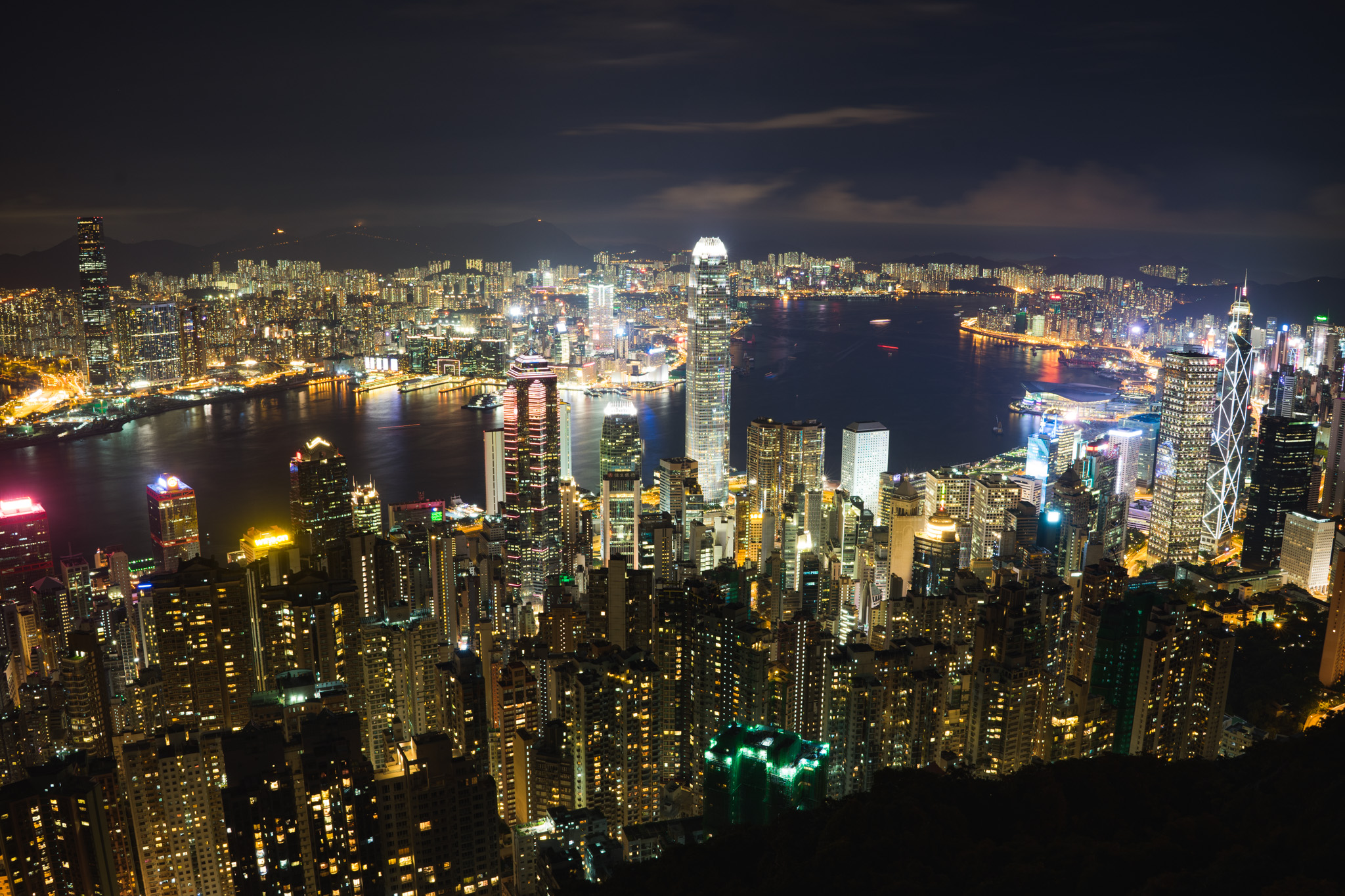
Shanghai (Days 26 to 28)
The last stop on this itinerary is my favourite Chinese city. Shanghai has an endless amount of things to do, foods to eat, and people to meet. Not including Hong Kong, Shanghai is by far the most westernized Chinese city, and people living in Shanghai are open-minded. When in Shanghai, spend some time checking out its cool art scene, nightlife, and parks. Take a trip to the top of the Shanghai Tower (world’s second tallest building) for some insane views of the city.
Also consider a day trip to one of Hangzhou, Suzhou, or even Nanjing. They’re all incredible cities and are very accessible from Shanghai via high-speed rail.
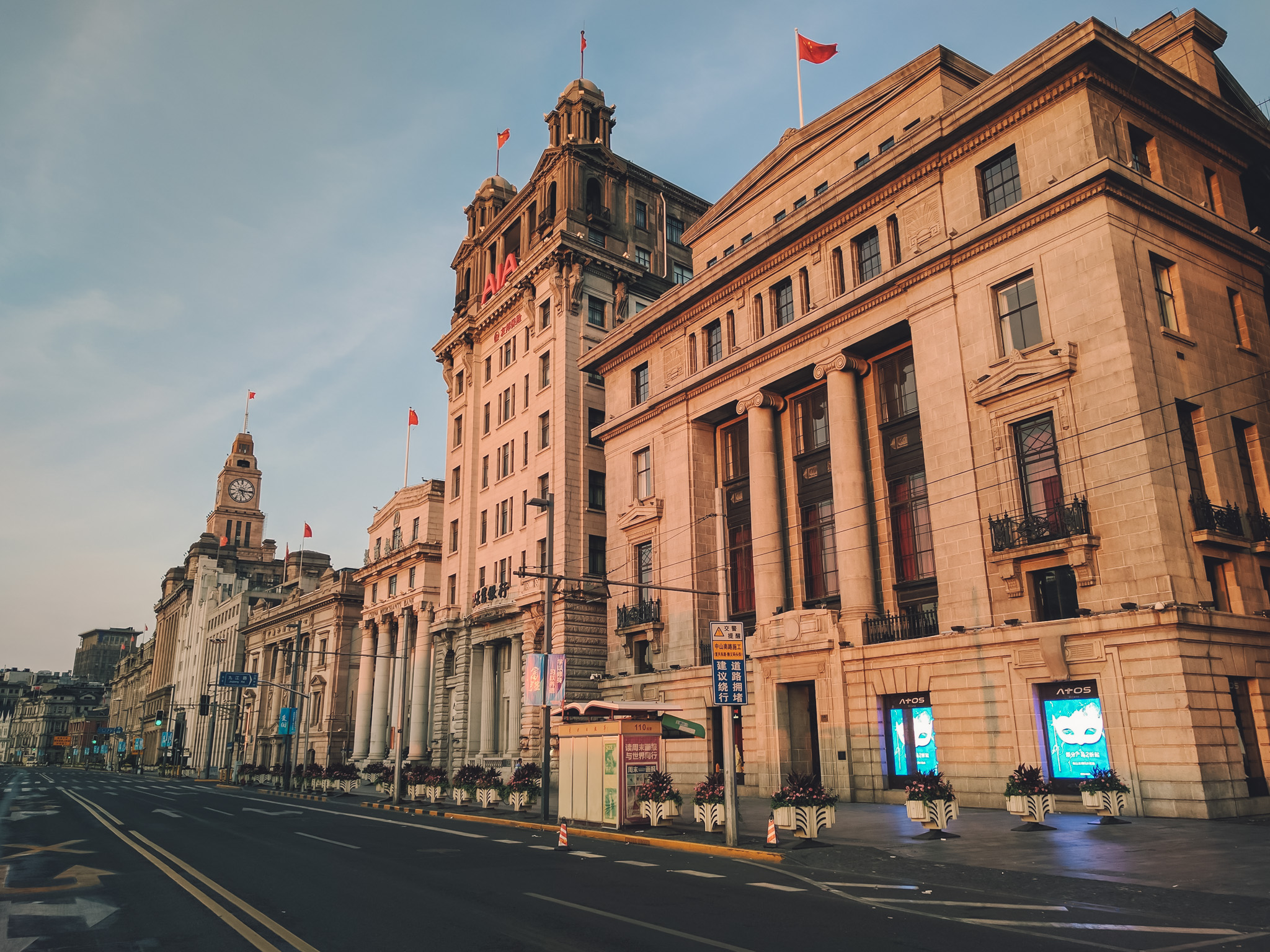

Getting to Shanghai from Hong Kong
There’s a decent amount of distance between these two cities, so flying is something to consider. You can take the high-speed train, but the trip will take over eight hours and cost about $150 USD for a second class seat.
Where to stay in Shanghai
I stayed at the Blue Mountain International Youth Hostel for its location. East Nanjing Road and the Bund are the most popular tourist areas in Shanghai, and the hostel is less than a ten minute walk from both.
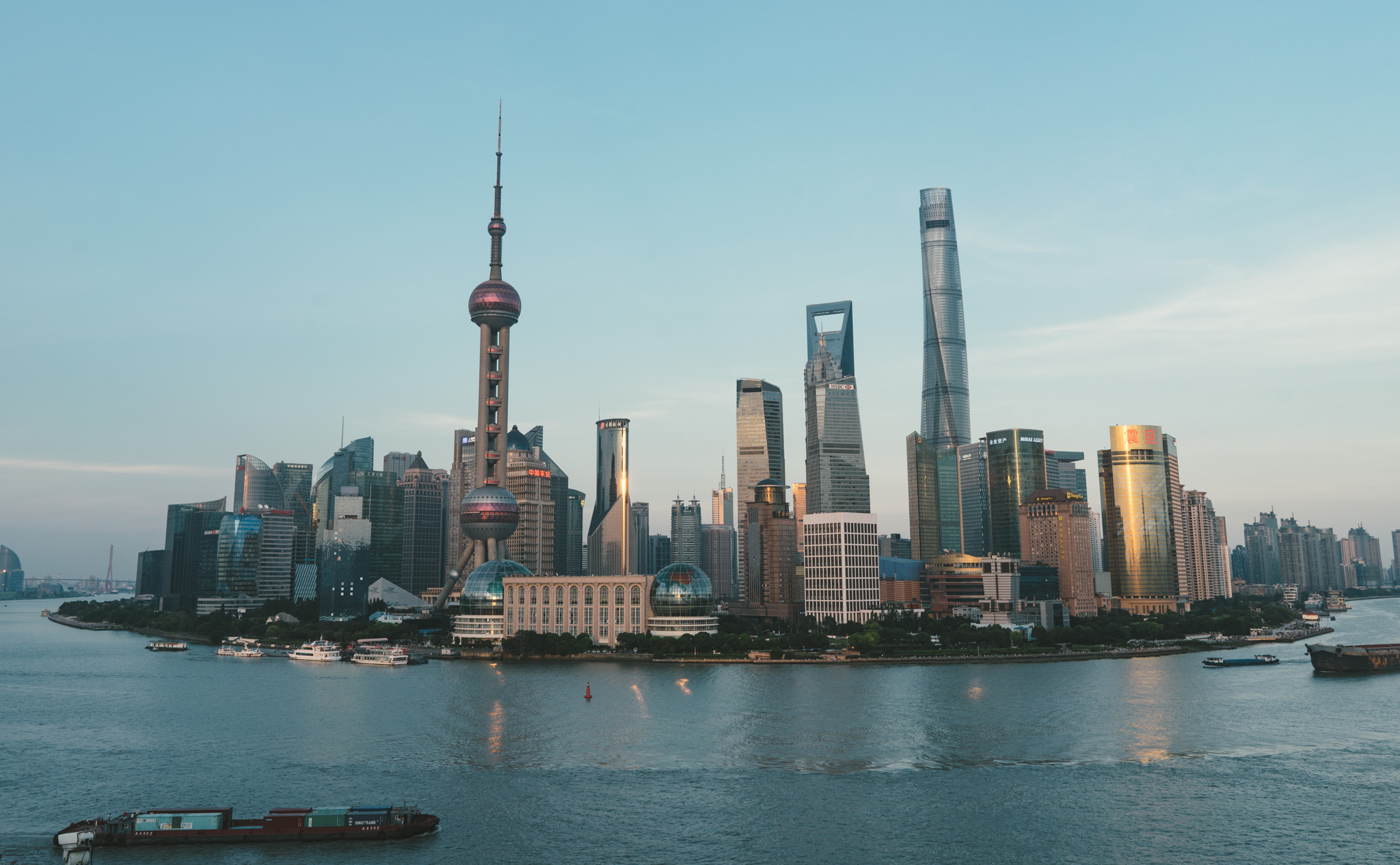
Other China Travel Destinations
If you want to skip certain parts of this itinerary for something different, or have more than four weeks to travel around China, consider some of the following destinations.
Jiuzhaigou and Huanglong
Beautiful Tibetan scenery located north of Chengdu. From Chengdu, you’ll need four days to get a good taste of both parks (including travel time).
Longji Rice Terraces
If you want to spend more time in the Yangshuo area, I highly recommend visiting the Longji Rice Terraces. They’re only two hours north of Guilin and are some of the finest terraces in Asia. Check out my guide to hiking in the Longji Rice Terraces for more details.
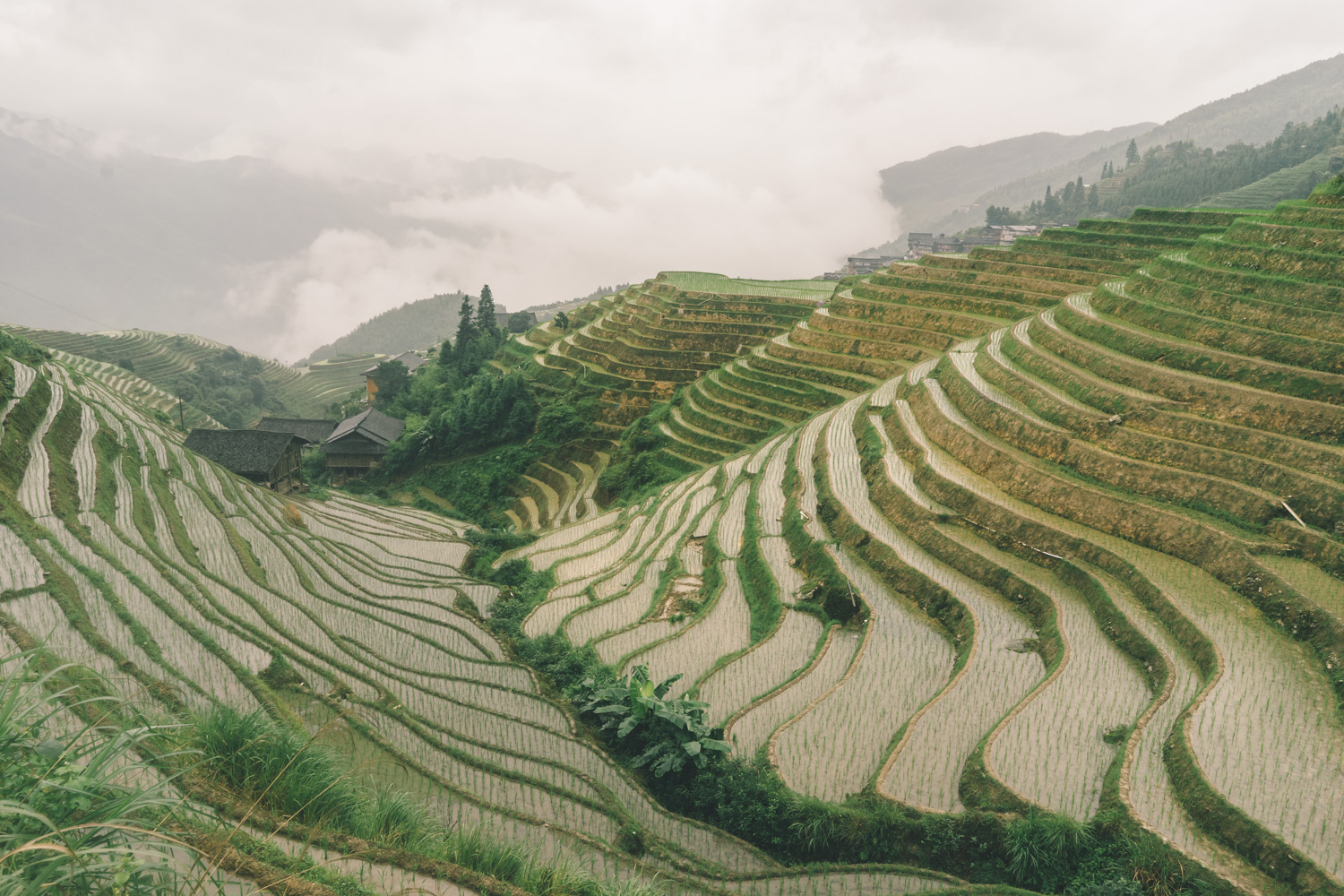
Western Sichuan
Rather than flying between Chengdu and Shangri-La, there’s an overland route you can take between the two cities. The route goes through some seriously remote parts of Tibetan Sichuan. I wrote a detailed post on how to travel the route .
Zhangjiajie
This is where Avatar got the inspiration for its incredible landscapes. Zhangjiajie is a great place to visit for a few days but is a bit out of the way from other destinations.
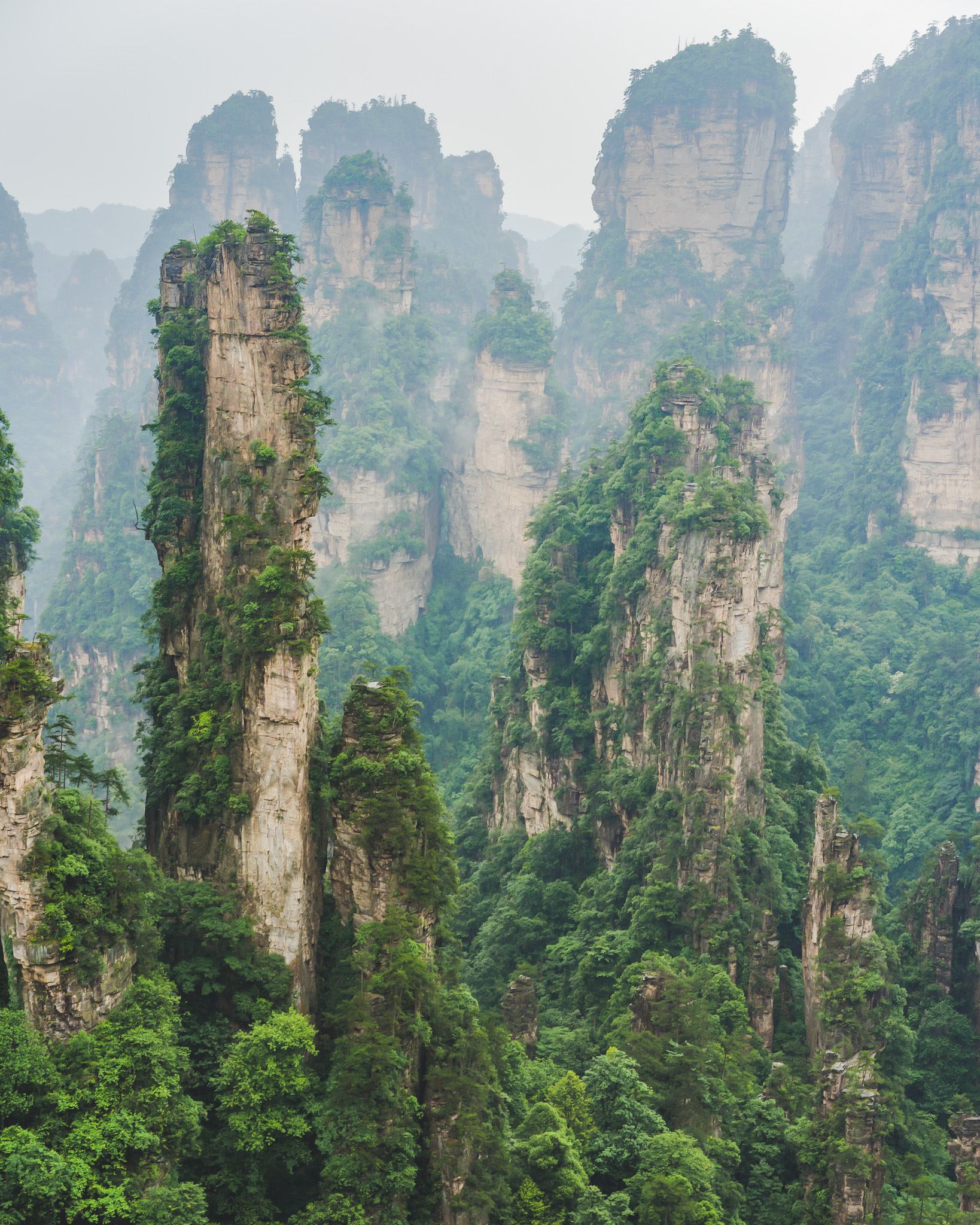
Tibetan Autonomous Region
Unfortunately, to visit Tibet as a foreigner you must be on a guided tour. I decided to take one and enjoyed it, although it was expensive. If you’re into amazing mountains and Tibetan culture, consider visiting.
I’ve been to parts of Xinjiang (Kashgar and Tashkurgan), and honestly can’t recommend it at the moment. Unless you’ve got an interest in seeing what a modern police state looks like, I’d recommend sticking to other parts of China for now.
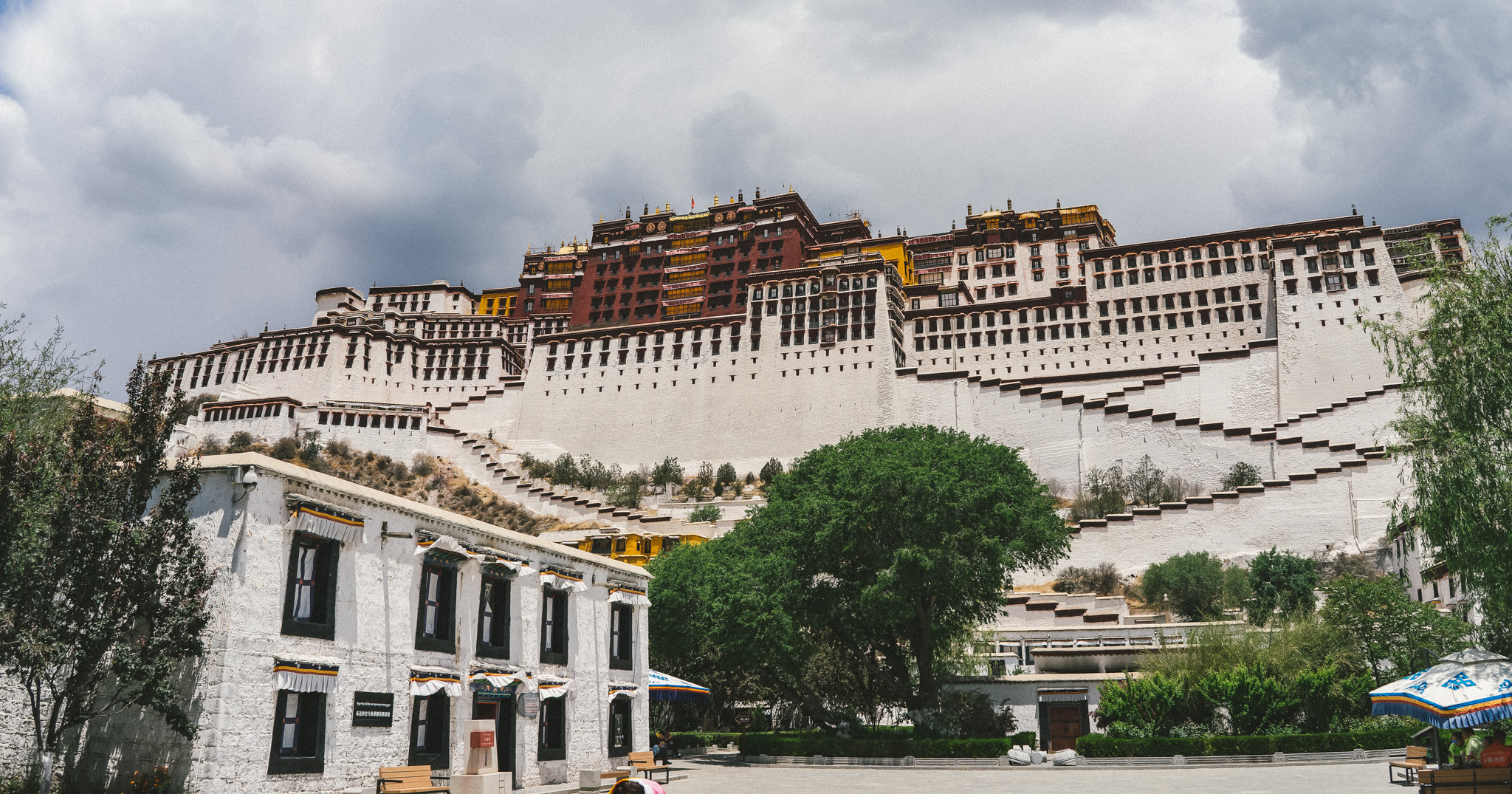
China Travel Itinerary Wrap-up
I hope this itinerary has helped you better plan your China backpacking adventure. You’ll have a great time no matter where you choose to visit, it’s an awesome country.
Feel free to contact me with any other questions and I’ll get back to you. If you liked this post, consider sharing it!
Subscribe to my mailing list to be notified of my future posts. I’ll be travelling a ton in 2019, and will have a lot of great content coming out.
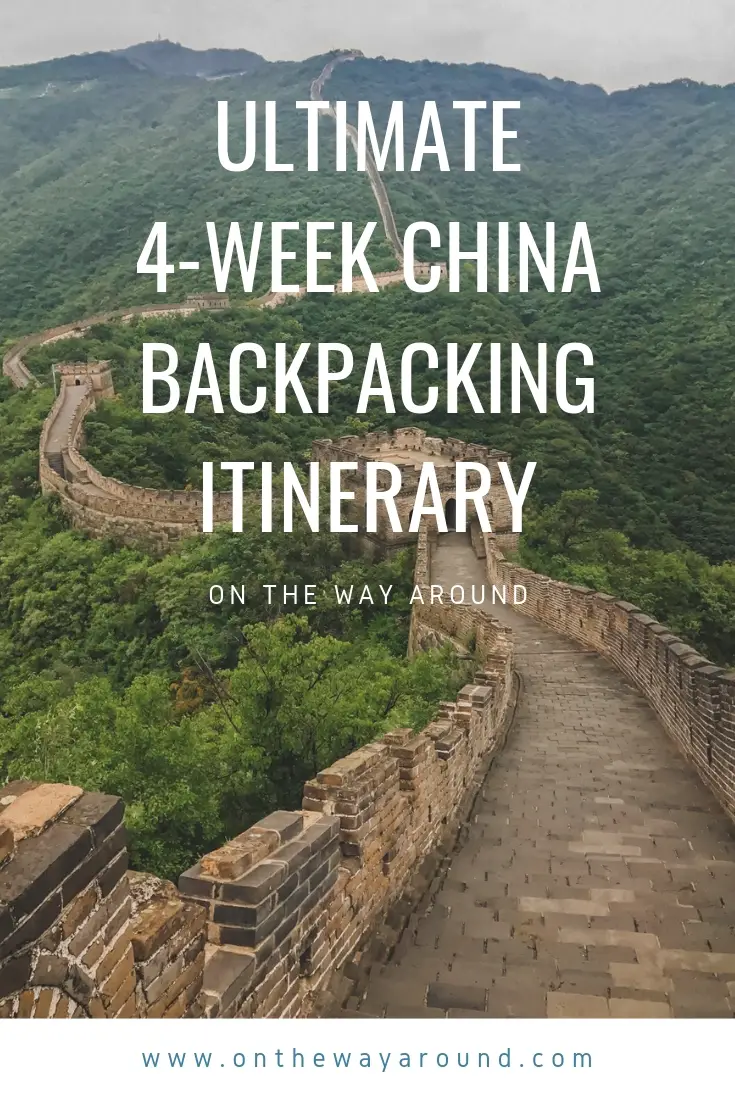
Yay transparency! There are affiliate links in this guide. If you book or buy something using my links, I’ll make a bit of money at no extra cost to you.

21-year old Canadian dude who loves to visit off-the-beaten-path places, climb tall mountains, and try delicious foods.
Read more about me
Want more like this?

One thought on “ An Awesome 2 to 4-Week China Itinerary ”
Having lived and travelled 4+ years in China, I can only say these are great itineraries. If you haven’t seen China yet, by all means start from here. Zhangjiajie is unbelievable so you should try to squeeze it in, and if you can you should also really visit an ancient small town like Pingyao (en route to Xi’an) or Fenghuang (en route to Yangshuo).
Leave a Reply Cancel reply
Your email address will not be published. Required fields are marked *
- How it began
- Where I’ve been
- About Franz Explorer
- Contact & Public Relations
- Who helped me on the journey
- Itineraries
- Transportation
- Accommodation
- Work & Volunteer
- Travel Stories
- Netherlands
- Czech Republic
- Switzerland
- French Guiana
- El Salvador
- New Zealand
- South Africa
- United Arab Emirates
- Philippines
- South Korea
How to travel around the world for less
One month Itinerary in China
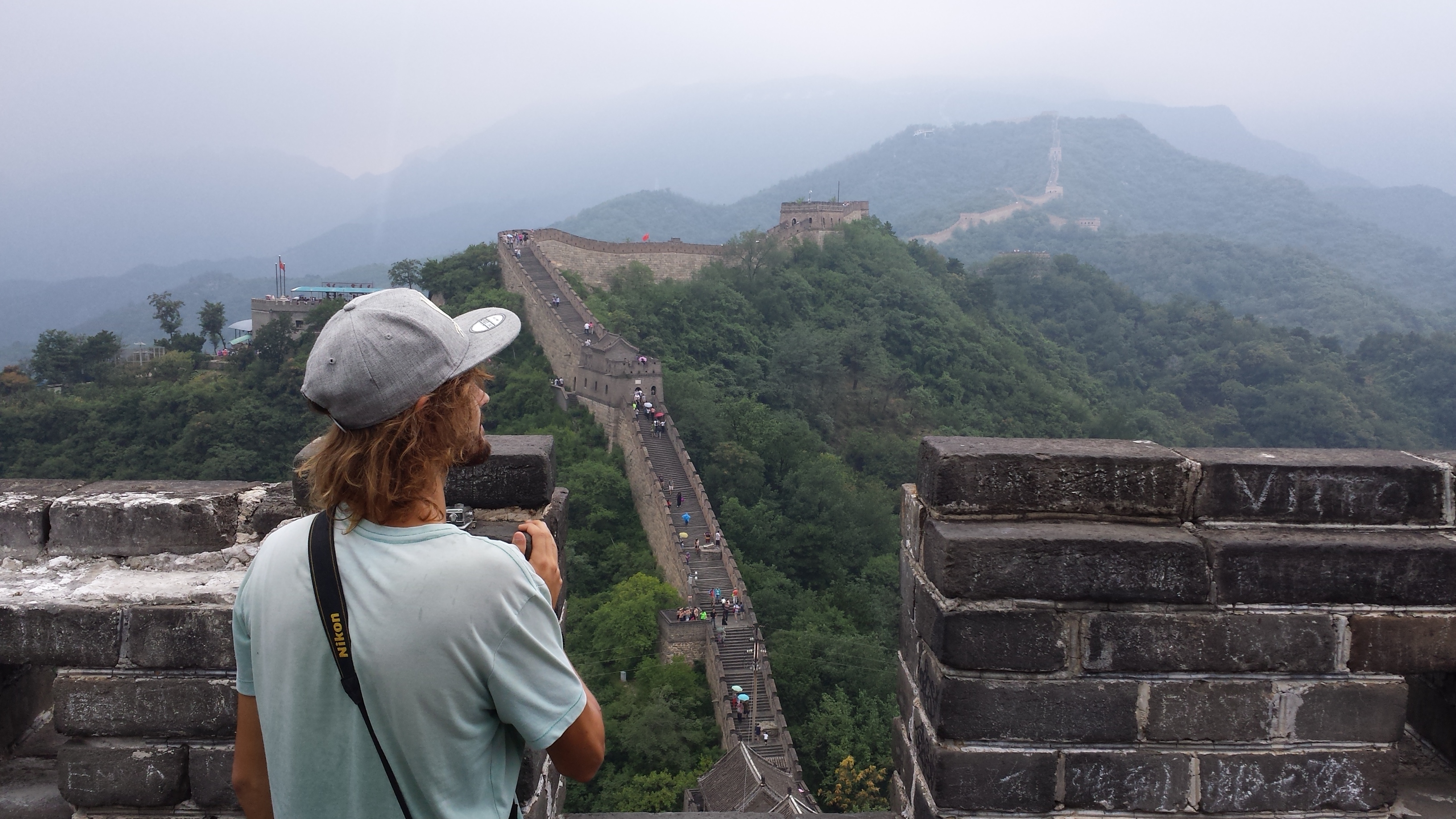
China is a huge country and you need at least one month to experience the main sights from it. I mostly travelled by train, that is the fastest and cheapest way to move around in long distances. I flew in into Shanghai and flew out from Hong Kong. I payed 90 USD in a low cost flight from Osaka (Japan) to Shanghai (China) with Spring Airlines, that I strongly DO NOT recommend
In my route I visited: Shanghai, Suzhou, Beijing, Zhenghzou, DengFeng, Xian, Chengdu, Kangding, Tagong, Guilin, Yangshuo and Guangzhou.
Shanghai (4 days)
Shanghai is the financial capital of China, where most of business men and skyscrapers are. The pollution is so hard that rarely you are going to see a blue and clear sky. I stayed in Captain Hostel , pretty close to the Bund , a 1,500-meter-long waterside promenade showcasing distinctive modern & colonial buildings.
The hostel had a nice rooftop for the night view.
Yu Garden or Yuyuan Garden is an extensive Chinese garden located beside the City God Temple in the northeast of the Old City of Shanghai, China. The district is now incorporated under the name Yuyuan Tourist Mart and plenty of local shops and tourists can be seen around.
The Longhua Temple is a Buddhist Temple dedicated to the Maitreya Buddha located in Shanghai, China.
The nightlife in Shanghai is intense. Here you can check 12 of The Best Party Spots in the city .
While in Shanghai its a great opportunity to do a day trip to the city of Suzhou , considered the Venice of china. Located 100km from Shanghai it is a major economic center and focal point of trade and commerce, and the largest city in the province of Jiangsu.
Beijing (4 days)
The bullet train from Shanghai to Beijing was very expensive, but still cheaper than flying. I payed 102 USD using the services of the Fast Train G18 (2nd class). I booked 3 nights in Beijing Sanlitum Hostel for 80 USD.
The hostel organized a tour to the Great Wall of China . Currently there are 8 official locations of the Great Wall around Beijing open to visitors, but most of the hostels and agencies will try to sell you one of the 2 main packages, either Badaling or Mutianyu. The first one is extremely touristic since public buses reach this location and is the closer to Beijing. I booked with my hostel for about 500 RMB the Mutianyu tour including a transfer round-trip and lunch.
In the UNESCO world heritage list since 1998, the Summer Palace is a vast ensemble of lakes, gardens and palaces and was an imperial garden in Qing Dynasty. The same week I was in Beijing there was a presidential parade, and factories were closed for the entire previous week. It was the first time in many years It could be possible to see blue sky. It was featured in the main newspapers worldwide .
The Forbidden City was the Chinese imperial palace from the Ming dynasty to the end of the Qing dynasty—the years 1420 to 1912. It is in the center of Beijing, China, and now houses the Palace Museum.
Do not miss to try some unique food such as scorpions in the stick, found in local markets.
Zhengshou & Deng Feng (2 days)
From Beijing to Zhengshou I payed 40 USD in a normal train 1303, hard sleep. I have payed 25 euros for one night in Jinjiang INN because there was no hostel available in town. I added those two cities because I use to fight Kung Fu and this is where Shaolin Kung Fu was born.
Located in the city of Deng Feng, the Shaolin Monastery , also known as the Shaolin Temple , is a Buddhist temple founded by Fang Lu-Hao, and also used today as school of Buddhism and Kung Fu. The Monastery and its Pagoda Forest are part of UNESCO world heritage list since 2010.
Xian (2 days)
From Zhengshou to Xian I payed 25 USD for a normal train K1131, hard seat. I slept in Alley Youth Hostel and payed 150 yuan for 2 nights. Xian is famous for the Terracotta Warriors , a collection of terracotta sculptures depicting the armies of Qin Shi Huang, the first Emperor of China.
Chengdu (3 days)
From Xian to Chengdu I took the Express train T7, hard seat, and payed 20 USD. I only stayed one night in Chengdu Mix Hostel for 54 yuan and headed to the tibet. On my way back I spend 2 night in the five star hotel Fraser Suites a gift from the parents of my ex-girlfriend.
You can not visit China and miss the most adorable creatures in their natural habitat, the pandas. Chengdu Research Base of Giant Panda Breeding , or simply Chengdu Panda Base, is a non-profit research and breeding facility for giant pandas and other rare animals founded in 1987.
Kangding & Tagong (Tibet) (3 days)
From Chengdu to Kangding I took a local bus in Xiamen Station for 140 yuan. I stayed one night in Kangding in, Konka hostel that I have payed 25 yuan and headed early morning the next day to Tagong. The region of Sichuan has similarities with Tibet but can be visited without a permission. I stayed two nights in Tagong in Jya Drolma & Gayla’s Guesthouse , this lovely house in the picture.
The interaction with local people was pretty special. No English and not even Mandarim, they were speaking the local dialect, same spoken in Tibet. Beautiful temples with gold praying wheels were part of the historical sights.
Tagong is a small town in the Tibetan prefecture of Ganzi. Its altitude is at 3700m and is located half way between Kangding and Litang. It is known for senic grasslands and local Tibetan Buddhist culture
Guilin & Yanghsuo (6 days)
From tibet I headed back to Chengdu to get a direct train to Guilin, the hard sleep cost me 350 yuan. In Guilin I did couchsurfing. Both cities are known for its dramatic landscape of limestone karst hills.
Boats travel through lakes via connected rivers. On Cedar Lake’s shore, twin pagodas, the Sun and Moon, light up the sky at night.
Do not miss the natural mud bath and hot spring!
Guangzhou (1 day)
From Guilin to Guangzhou I payed 140 yuan in another train. Over there I took a last train to Zhuhai and crossed the border to Hong Kong.
- China Tours
- Tailor-made
+86 015977325784 [email protected] Mon-Fri 9am - 6pm China Time
- Destinations
- Seniors Pace
- World Heritage
- Zhangjiajie
- Inner Mongolia
- Plan My Asia Trip
- Travel Itinerary
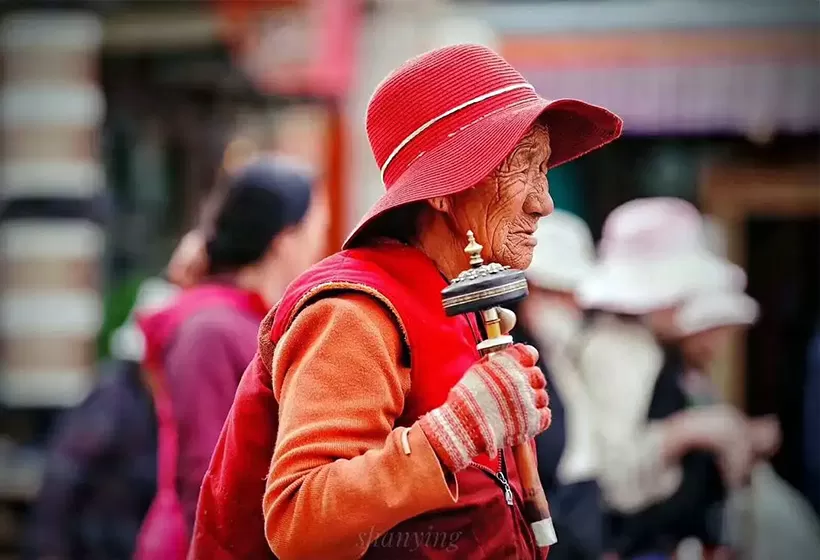
China Itinerary 1 Month , Plan a 30 Days Tour of China
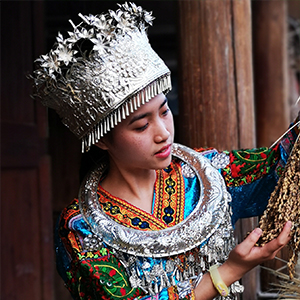
- 01. Step 1: Where to go in China
- 02. Step 2: When to go in China
- 03. Step 3: How to Visit Tibet in 2021 — Suggestions and
What our travelers say about the China itinerary 1 month
Dear Grace(Wang Yu 王瑜),
"First, thank you for organizing our first trip to China. We loved it! You did a great job and we would be more than happy to recommend your services to others. Meanwhile, here are some general and specific comments about our first trip that might help plan our next one... " More about this 30 Days China tour feedback >>
Robert and Claude January tailored a 30 days itinerary from US

30 Days in China with China Culture Tour
This review is long overdue as my wife and I traveled for one month in China in October 2016(not 2017 as noted below.) The trip was flawless. Grace is the epitome of a wonderful host and we had the great pleasure of having dinner with her when we were in Guilin ... More Details >>
Abelson's 30 days China itinerary from US
1 Month China World Heritage Itinerary
Beijing shanxi luoyang xian sichuan tibet yunnan guilin and shanghai.
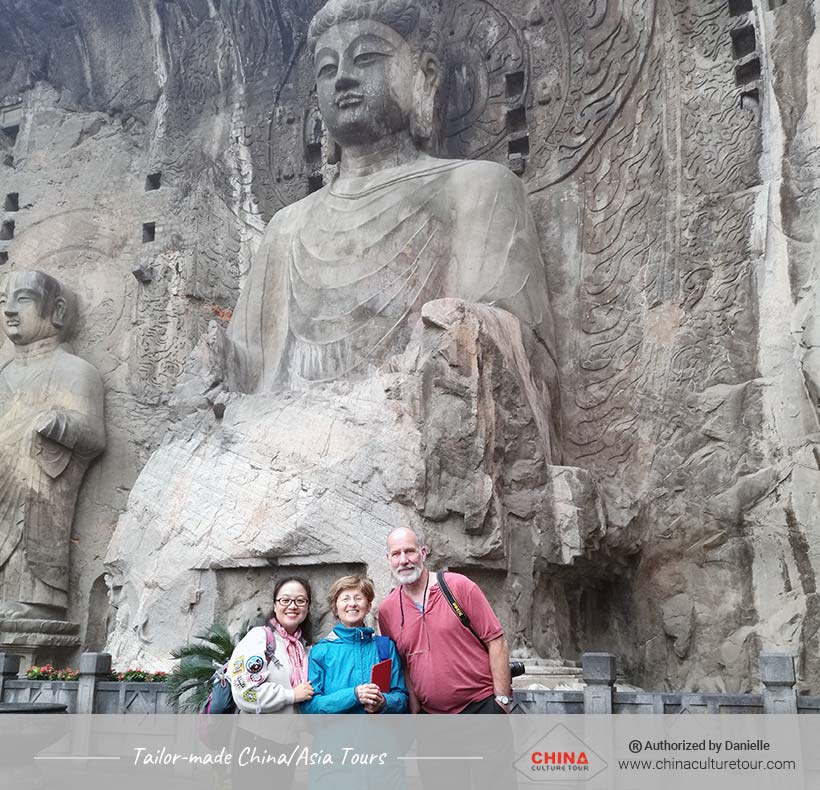
Day 1 : Arrive in Beijing - Airport to hotel transfer.
Day 2 : Beijing - Tiananmen Square, Forbidden City, Jingshan Park, Hutong Tour.
Day 3 : Beijing - Temple of Heaven, Mutianyu Great Wall, Peking Duck for dinner.
Day 4 : Beijing - Summer Palace, Lama Temple, and Confucius Temple.
Day 5 : Beijing to Datong by flight, visit Yungang Grottoes and Huayan Temple.
Day 6 : Datong to Wutai Mountain (about 3.5 hours’ drive) – Hanging Temple and drive to Wutai Mountain
Day 7 : Wutai Mountain – Temple complex
Day 8 : Wutai Mountain to Pingyao (about 4 hours’ drive) - Jinci Temple in Taiyuan
Day 9 : Pingyao - Rishengchang, City Wall, Ming Qing Street, the Officials’ Office of Pingyao County, Town House, and Shuanglin Temple.
Day 10 : Pingyao to Luoyang by overnight train - Wang’s Compound and Mian Mountain.
Day 11 : Luoyang – Longmen Grottoes in the afternoon.
Day 12 : Luoyang – Old City, Shaolin Temple, and bullet train to Xian.
Day 13 : Xian - Terra-cotta Warriors and Soldiers, Muslim Street, local market.
Day 14 : Xian - Big Wild Goose Pagoda, Shaanxi History Museum, Xian City Wall and the Great Mosque, Dumpling Dinner.
Day 15 : Xian to Chengdu - Transfers between hotels and airport, Panda tour in the afternoon.
Day 16 : Chengdu to Jiuzhai Valley - Huanglong and Jiuzhai Valley.
Day 17 : Jiuzhai Valley - Shuzheng valley
Day 18 : Jiuzhai Valley - Rize Valley and Zaru Valley.
Day 19 : Jiuzhai Valley to Chengdu, Chengdu to Leshan, Leshan Big Buddha to Emei Mountain

Day 20 : Emei Mountain to Chengdu
Day 21 : Chengdu to Lhasa
Day 22 : Lhasa - Sera Monastery, Norbulinka, and Tibet Museum.
Day 23 : Lhasa - Potala Palace, Barkhor Street, and Jokhang Temple.
Day 24 : Lhasa to Shangri La - Old City and Songzanlin Monastery.
Day 25 : Shangri La - Pudacuo National Park, Village visiting.
Day 26 : Shangri La to Lijiang - Tiger Leaping Gorge and Yangtze’s first bend.
Day 27 : Lijiang - Sites in the Lijiang ancient town.
Day 28 : Lijiang - Jade Dragon Snow Mountain.
Day 29 : Lijiang to Dali - Shaxi ancient town for its market and temples.
Day 30 : Dali - Chongsheng Temple and the Three Pagodas, Cangshan Mountain and Erhai Lake.
Day 31 : Dali to Kunming and Kunming to Guilin
Day 32 : Guilin - Reed Flute Cave, Elephant Trunk Hill, Seven Star Park, and a local market.
Day 33 : Guilin to Yangshuo - Li River cruise, Xinping Ancient Town, Fuli Ancient Town.
Day 34 : Yangshuo: Cooking class, Chinese kungfu class, Countryside tour, Bamboo rafting.
Day 35 : Yangshuo to Longji Dragon's Backbone - Ping An village, ethnic villages, rice terraced fields.
Day 36 : Longji to Guilin airport to Shanghai - Half day free.
Day 37 : Shanghai - The Bund, Nanjing Road, Yuyuan Garden, French Concession, Shanghai World Financial Center.
Day 38 : Shanghai to your city - Hotel to airport transfer.
If you are interested in tailor-making a similar itinerary, please feel free to contact us and customize your own 1 month itinerary >>
China itinerary from 30 to 35 days to Northern China
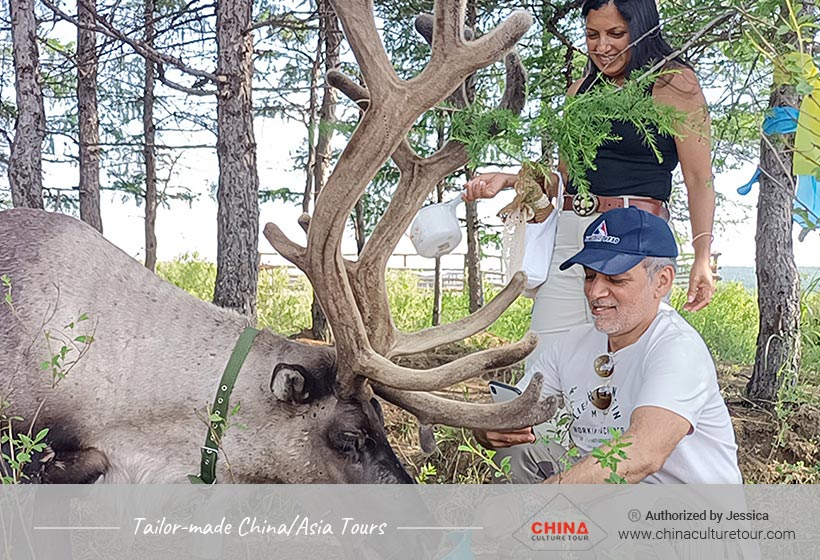
Beijing, Inner Mongolia, Gansu, Qinghai, Tibet, Sichuan, Guilin, and Hong Kong
Day 1-4: beijing.
Explore iconic landmarks like the Forbidden City, Tiananmen Square, and the Great Wall of China, Visit the Temple of Heaven and the Summer Palace, Wander around the Hutongs, experience local culture, and Enjoy the famous Peking Duck and other local cuisines.
Day 5-10: Inner Mongolia
Take a flight to Hohhot, the capital city of Inner Mongolia, Visit the Inner Mongolia Museum to learn about the history and culture of the region, Go horseback riding and explore the grasslands, Visit the Mausoleum of Genghis Khan, visit the Wudangzhao Monastery and explore the stunning natural scenery, Experience local culture by staying in a traditional yurt.
Day 11-14: Gansu
Take a train to Lanzhou, the capital city of Gansu, Visit the Bingling Temple Grottoes, a series of Buddhist caves carved into the cliffs along the Yellow River, and Explore the Labrang Monastery, one of the six great monasteries of the Gelug school of Tibetan Buddhism, Visit the Mogao Caves, a UNESCO World Heritage site filled with ancient Buddhist art, Visit Xiahe and explore the Labrang Monastery, a major Tibetan monastery in Gansu, Explore the Mingsha Shan and Crescent Moon Lake in Dunhuang.
Day 15-17: Qinghai
Take a train to Xining, the capital city of Qinghai, Visit Qinghai Lake, the largest saltwater lake in China, Explore Kumbum Monastery, one of the most important Tibetan Buddhist monasteries in China, Visit the Dongguan Mosque, one of the largest and most important mosques in China.
Day 18-23: Tibet
Take a flight to Lhasa, the capital city of Tibet, and Visit the Potala Palace, the most iconic landmark of Tibet and a UNESCO World Heritage site, Explore Jokhang Temple, one of the most sacred temples in Tibet, Wander around Barkhor Street and experience the local culture, Visit the Sera Monastery and watch the monks debate, Take a day trip to visit Namtso Lake, one of the highest saltwater lakes in the world, Explore the Yamdrok Lake and Karola Glacier.
Day 24-29: Sichuan
Take a flight to Chengdu, the capital city of Sichuan, Visit the Chengdu Research Base of Giant Panda Breeding and see the adorable pandas, Explore the Leshan Giant Buddha, the largest Buddha statue in the world, Try the famous Sichuan cuisine, including spicy hotpot and map tofu, Visit the Jiuzhaigou National Park, a UNESCO World Heritage site known for its stunning natural scenery, Explore the Huanglong Scenic and Historic Interest Area, known for its colorful pools and limestone formations.
Day 30-33: Guilin
Take a flight to Guilin, known for its stunning natural scenery, Take a cruise down the Li River and admire the Karst mountains, Visit the Reed Flute Cave, a natural limestone cave with amazing rock formations, Explore the Longji Rice Terraces, a UNESCO World Heritage site
Day 34-35: Hong Kong
Take a flight to Hong Kong and explore the city, Visit Victoria Peak and enjoy the panoramic view of Hong Kong, Walk along the Tsim Sha Tsui Promenade and enjoy the famous light show, Visit the Big Buddha on Lantau Island and the Po Lin Monastery, Go shopping and enjoy the local cuisine in areas like Causeway Bay
China Itinerary 1 Month from South to North
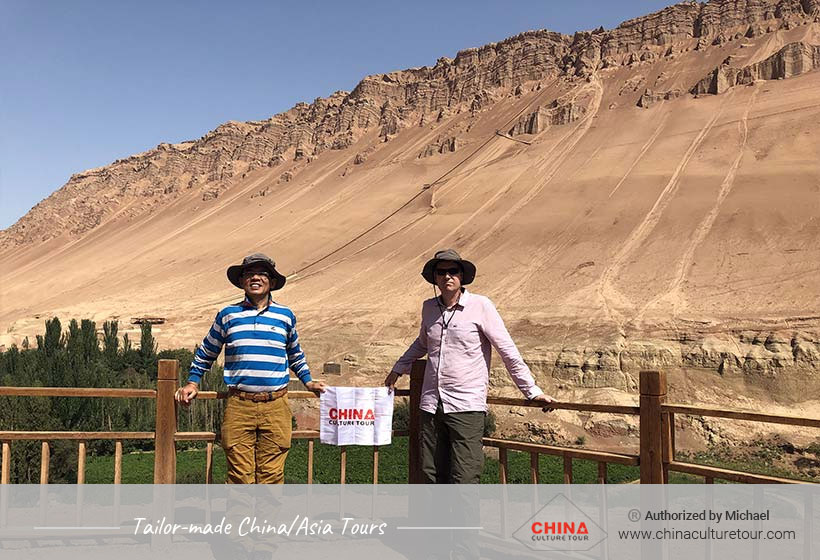
Hong Kong, Guilin, Sichuan, Xi'an, Xinjiang, Gansu, Inner Mongolia, and Beijing
Day 1-2: hong kong.
Explore the city's bustling streets, try local street food, and visit iconic landmarks like Victoria Peak and The Big Buddha. Take a ferry to Lantau Island and spend a day at Disneyland or Ocean Park. Visit the Hong Kong Museum of History and learn about the city's past.
Day 3-6: Guilin
Take a scenic boat ride along the Li River and marvel at the towering karst mountains and picturesque villages. Explore the Reed Flute Cave and its stunning stalactites and stalagmites. Visit the Longji Rice Terraces and hike through the stunning landscape. Spend a day in Yangshuo, a charming town with lively markets and scenic countryside.
Day 7-12: Sichuan
Visit Chengdu and see the pandas at the Chengdu Research Base of Giant Panda Breeding. Try local Sichuan cuisine, known for its spicy flavors and numbing sensations. Visit the Leshan Giant Buddha, a towering statue carved into the side of a cliff. Hike through the stunning Jiuzhaigou Valley National Park, with its crystal-clear lakes and waterfalls. Visit the Mount Emei Scenic Area, a UNESCO World Heritage Site with stunning views and ancient temples.
Day 13-14: Xi'an
Visit the Terracotta Warriors, a UNESCO World Heritage Site and one of China's most iconic attractions. Walk or bike along the ancient city walls of Xi'an and admire the views. Visit the Great Mosque of Xi'an and explore the Muslim Quarter.
Day 15-19: Xinjiang
Visit the Kashgar Sunday Bazaar, one of the largest and most vibrant markets in the region. Explore the stunning Karakoram Highway, one of the world's highest roads. Visit the Id Kah Mosque, the largest mosque in China, located in the city of Kashgar. Visit the Tianshan Mountains and go on a hike or take a cable car to enjoy the stunning views. Visit the Karez irrigation system, an ancient underground irrigation system that is still in use today.
Day 20-23: Gansu
Visit the Mogao Caves in Dunhuang, a UNESCO World Heritage Site with stunning Buddhist art and architecture. Explore the Labrang Monastery in Xiahe, one of the largest Tibetan Buddhist monasteries in China. Visit the Yellow River Stone Forest and marvel at the unique rock formations. Explore the Zhangye Danxia National Geological Park, with its colorful sandstone formations.
Day 24-29: Inner Mongolia
Visit the grasslands of Hohhot and experience the nomadic way of life. Visit the Ordos Desert and go on a camel ride or sandboarding adventure. Explore the stunning Xilamuren Grassland and go on a horseback ride. Visit the Gegentala Grassland and experience traditional Mongolian culture, including horseback riding and archery.
Day 30-33: Beijing
Visit the iconic Great Wall of China, one of the world's most famous landmarks. Explore the Forbidden City, the former imperial palace of the Ming and Qing dynasties. Visit the Temple of Heaven, a stunning temple complex and UNESCO World Heritage Site. Take a walk through the hutongs, the narrow alleyways that are a window into traditional Beijing life.
You Might be Interested in Private China Tours and Tailor-made Travel Itineraries

We specialize in Tailor-made Tours, providing personalized 1-on-1 service. You can explore our exclusive private China tours or create a custom tour of China and even design a unique tour across Asia .

- 5 Days China Itinerary »
- 7 Days China Itinerary »
- 10 Days China Itinerary »
- 12 Days China Itinerary »
- 14 Days China Itinerary »
- 3 Weeks in China »
- 4 Weeks in China »
- 30 Days China Itinerary »
- 5 Weeks in China »
- 2 Month China Itinerary »

Hi, I’m Eunice Tang, if you like my article, please share it with your friends. Any sugguestions on this article, please contact me . Thanks!
Want to plan a private China tour? CREATE NOW
CONTENT DIRECTORY

Panorama of China : 30 Days Beijing, Xian, Chengdu, Lhasa, Shangri-La, Lijiang, Dali, Kunming, Yangtze, Shanghai, Huangshan, Guilin and Hong Kong tour
CREATE MY TRIP
FABULOUS TOUR COMPANY
CHINA OCTOBER - NOVEMBER 2019 We researched several companies and studied reviews on Trip Adviser before contacting who did a very China Culture Tour with an initial query. Right from the outset Grace who owns the company was excellent. She emailed detailed with pictures information and a suggested… read more details
Karen from US
Ready to Create a Unique Dream Travel?
Create My Vacation
- CHINA CULTURE TOUR: OUR CULTURE, YOUR TOUR!
- Best Tailor-made Classic China Tours
- Cultural Experiences for a China Tour
- WOW Seasonal China Tours
- Our Best Tour Ideas for You
Top Itineraries for Touring Different Parts of China
:max_bytes(150000):strip_icc():format(webp)/EBC_pose-591232dc5f9b586470fb3268.jpg)
The following itineraries are perfect starting places for traveling in China. You can tailor them to your own needs or put them together to create a complete China Travel plan for your trip.
When planning a trip to China, visitors should ask themselves what they want out of a trip.
- Do you just want to go to China and see the big sights?
- Are you more adventurous and want to get into nature?
- Were you hoping to mix cuisine into your travel?
- Do you want to see the countryside and avoid big cities?
- Are you active and want to include some trekking in your trip?
The answers to these kinds of questions will help you choose an itinerary that is perfect to what you are interested in and what you'd like to see and do.
Seeing the "Big Five" - A Ten-Day China Itinerary
This is a ten-day itinerary that takes visitors to China to the main "big five" sights that are on every first-time traveler's list. You'll see Beijing (the Forbidden City and the Great Wall), then on to Xi'an (the Terracotta Warriors). You'll then move on to the Yangtze River for the Three Gorges Dam cruise and wind up in Shanghai for the historic Bund and then some amazing food and city life.
This is a very basic itinerary and can be used as a starting point for China Travel.
Chengdu Travel Itineraries
Chengdu is a big draw for first-time visitors to China. Answering the call of the Giant Panda , many China travelers want to visit Chengdu and Sichuan Province .
There is a lot to see and do in the city of Chengdu and its surroundings.
Explorations in China's Northwest Gansu Province
Gansu Province has so much to offer travelers to China it would be easy to spend an entire trip just exploring the province from north to south .
In the north, visitors can travel the ancient Silk Road routes on the edges of the Gobi Desert, visit UNESCO-listed Mogao Caves and ride camels through the dunes. From there, travel the Silk Road's famous Hexi Corridor to visit the westernmost reaches of the Great Wall and other famous sights.
In the center of Gansu, visitors can tour more Buddhist caves in Bingling and visit the fabulous provincial museum to see excavated Silk Road treasures.
Farther south, one travels through largely Muslim counties until one reaches the Tibetan Autonomous Counties where Labrang Monastery is located.
Yellow Mountain Itinerary From Shanghai
The Yellow Mountains (or Huangshan in Mandarin) are incredibly famous in China for the mountain and pine tree landscape. Going to the Yellow Mountain area is an easy addition to any itinerary, especially if you're going to be in Shanghai.
Yunnan Province Travel Itineraries
Yunnan Province in the south of China is another place that should be on every traveler's list if they've got the time and inclination to do some exploring.
Incredibly diverse, travelers can experience various cultures: Tibetan culture in the northwest , Dai ethnic culture in Lijiang, Bai culture in Xizhou and many other ethnic minorities that populate the lush mountains and fertile valleys of this tea-producing region.
Great Activities for Kids Visiting China
A Visitor's Guide to Touring Yunnan Province - Itineraries and Sights
The 15 Biggest Chinese Cities
Your Trip to Shanghai: The Complete Guide
What You Can See and Do in Gansu Province
20 Best Things to Do in Shanghai
Maps of China's Mainland Provinces
Your Guide to Hiking China's Tiger Leaping Gorge
The World's Highest Places and Attractions That You Can Visit
The 10 Best Hikes in China
Visitor's Guide to the Terracotta Warriors Museum in Xi'an
A Visitor's Guide and Itinerary for a Two-Day Trip to Huangshan
6 Historical Journeys You Can Still Take Today
Choosing Between Shanghai's Puxi and Pudong Neighborhoods
Weather in Northwest China: Climate, Seasons, and Average Monthly Temperature
The Best Countries in the World for Adventurous Travelers
How Long to Spend in China: Itineraries from 1 Week to 1 Month
China is an expansive destination with colorful culture, rich history, diverse landscapes, cute giant pandas, and exquisite cuisine… You might be wondering how to arrange an itinerary to suit your needs and make the most of your holiday in China: How many days do I need in China? Etc.
Here are some suggestions for designing your China itinerary based on our extensive trip planning experience.
Content Preview
How many days do you need in china, 1-week china itineraries, 10–12-day china itineraries, 2-week china itineraries, 3-week china itineraries, 1-month+ china itineraries.
A classic China itinerary for first-timers is about 10–14 days , covering Beijing, Xi'an, and Shanghai with one more city: usually Guilin (for more varied and relaxing activity options), Zhangjiajie (exciting mountain experiences), or Chengdu (for pandas).
If you want to try some off-the-beaten-path routes, you may need 3 or 4 weeks . You could explore remote areas like Tibet (5–8 days), Yunnan (6–9 days), and the Silk Road (5–10 days).
If you have limited time, you could go with an essential itinerary of 7 to 9 days . You would just visit the "golden triangle cities" - Beijing, Xi'an, and Shanghai.
If you would like our help when planning your China trip, feel free to contact us . Our travel consultant will listen to and answer your inquiries carefully and promptly and make the best tour plan for you.
China Highlights, Asia Highlights , and Global Highlights collaborate to provide families and couples with personalized and stress-free experiences in diverse destinations.
If you have one week to explore China, you are recommended to consider the golden triangle route: Beijing–Xi'an–Shanghai.
Or you could consider exploring one area in depth, such as Shanghai and its surrounding area (Hangzhou, Suzhou, and/or Huangshan).
Option 1: Beijing, Xi'an, and Shanghai (The Golden Triangle)
- Days 1–4: Beijing sightseeing, including the Great Wall and the Forbidden City
- Days 5–6: Xi'an with the Terracotta Warriors and a hands-on experience, museum visiting, and a food tour
- Day 7: Shanghai with the Bund and free time to explore
The golden triangle route is a time-smart way for first-timers to see the most iconic landmarks and quickly learn about China's culture and history.
Beijing, being the capital city, is usually the starting point for a China trip. There you could see the top attractions of China, including the Great Wall and the Forbidden City. You could also have some cultural interactive experiences like visiting a local family in Beijing's hutongs.
In Xi'an, the Terracotta Warriors is a must. The hands-on experience of making your own clay warrior would make the visit more interesting. We can arrange it for you.
The Bund is the most famous attraction in Shanghai, where you can see its past and present. Most Shanghai tour plans leave some free time to explore by yourself.
Option 2: Shanghai, Suzhou, and Hangzhou (Visa-Free)
- Days 1–2: Shanghai exploration with the Bund and Yu Garden
- Day 3: Hangzhou (West Lake and tea experience)
- Day 4: Suzhou (classical gardens and water towns)
- Day 5: Back to Shanghai (free-time exploration)
With this itinerary, you would explore the famous Yangtze River Delta (Shanghai and its surrounding area).
You would see and learn about some of the top Chinese cultural elements like classical Chinese gardens, water towns, and tea culture:
- Walk around the ancient water towns and visit the most famous classic garden in Suzhou.
- Enjoy magnificent mountain views and enjoy some quiet moments in a quaint village in Huangshan.
- Learn about Chinese tea culture in Hangzhou. You can see how farmers pick tea leaves, learn the process for making tea, and talk to the local tea growers.
You can also take advantage of the convenience of the area - its 6-day visa-free policy permits visiting Shanghai, Hangzhou, and Suzhou.
If you are interested in Huangshan for its mountain views and quaint villages, you can check out this combination: 2-Day Shanghai Old-and-New Collision + 5-Day Dynamic Huangshan Tour .
An itinerary ranging from 10 to 12 days allows you to add one city to the golden triangle route (Beijing–Xi'an–Shanghai).
If you like natural beauty, we recommend Guilin (for varied and relaxing countryside activity options) or Zhangjiajie (for exciting mountain experiences). If you or your kids love pandas, Chengdu is recommended.
A Classic 10-Day Itinerary: Beijing–Xi'an–Guilin–Shanghai
- Days 1–3: Beijing exploration, with must-sees including the Great Wall and the Forbidden City
- Days 4–5: Xi'an sightseeing, with a visit to the Terracotta Army and clay-warrior-making experience
- Day 6–8: Guilin, with a Li River cruise and outdoor activities like biking
- Days 9–10: Shanghai exploration, with a visit to the Bund and some free time
Our top recommendation for a 10–12-day itinerary covers Beijing, Xi'an, Shanghai, and Guilin - the most-chosen route for first timers. Guilin features picturesque rural scenery and leisurely countryside activities.
It's a great place for outdoor pursuits with children, like kayaking and biking, as well as for couples to enjoy nature and create romantic memories, such as a walk around the karst-cradled paddy fields and a candlelit dinner by a rustic river.
If you have your own preferred destinations, you can also contact us . We would like to help you arrange a tour plan you'll love based on your interests and needs.
If you want a richer experience for your China tour , including culture, nature, pandas, and some outdoor activities, 2 weeks is an ideal duration.
A Popular 2-Week Itinerary: Golden Triangle, Chengdu, Yangtze Cruise
- Days 1–4: Beijing arrival and exploration, with must-sees including the Great Wall and the Forbidden City
- Days 5–6: Xi'an sightseeing, with a visit to the Terracotta Army and a clay-warrior-making experience
- Days 7–8: Chengdu panda tour with a keeper program - make panda cakes, see pandas being fed at close quarters, and clean their enclosures.
- Days 9–11: Yangtze River cruise with excursions
- Days 12–14: Shanghai exploration, with a visit to the Bund and some free time
With a 2-week trip in China, we recommend Beijing, Xi'an, Shanghai, Chengdu, and a Yangtze cruise.
Few people would say no to cute pandas, especially kids. We can arrange a panda keeper program for you to observe and learn about pandas up close.
A leisurely cruise would allow you to enjoy magnificent views of the Three Gorges and really relax, which is especially welcomed for multi-generation family trips and senior couple trips.
For more options for a 2-week itinerary in China, see:
- 2-Week Beijing, Xi'an, Zhangjiajie, Guilin, and Shanghai Tour
- 2-Week Beijing, Xi'an, Lhasa, and Shanghai Tour
- 2-Week Beijing, Xi'an, Chengdu, Guilin, and Hong Kong
Number in your group
Adults number
65+ yrs old
41-64 yrs old
18-40 yrs old
Children number
10-17 yrs old
3-9 yrs old
0-2 yrs old
When would you travel?
Select your travel date and trip length (days).
United States +1 United Kingdom +44 Australia +61 Canada +1 France +33 Germany +49 Italy +39 Mexico +52 Netherlands +31 Singapore +65 Afghanistan +93 Albania +355 Algeria +213 American Samoa +1684 Andorra +376 Angola +244 Anguilla +1264 Australia +61 Antigua and Barbuda +1268 Argentina +54 Armenia +374 Aruba +297 Ascension Island +247 Austria +43 Azerbaijan +994 Bahamas +1242 Bahrain +973 Bangladesh +880 Barbados +1246 Belarus +375 Belgium +32 Belize +501 Benin +229 Bermuda +1441 Bhutan +975 Bolivia +591 Bosnia and Herzegovina +387 Botswana +267 Brazil +55 British Indian Ocean Territory +246 British Virgin Islands +1284 Brunei +673 Bulgaria +359 Burkina Faso +226 Burundi +257 Cambodia +855 Cameroon +237 Canada +1 Cape Verde +238 Caribbean Netherlands +599 Cayman Islands +1345 Central African Republic +236 Chad +235 Chile +56 China +86 Christmas Island +6189164 Cocos Islands +6189162 Colombia +57 Comoros +269 Congo (DRC) +243 Congo (Republic) +242 Cook Islands +682 Costa Rica +506 Côte d'Ivoire +225 Croatia +385 Cuba +53 Curaçao +599 Cyprus +357 Czech Republic +420 Denmark +45 Djibouti +253 Dominica +1767 Dominican Republic +1809 Ecuador +593 Egypt +20 El Salvador +503 Equatorial Guinea +240 Eritrea +291 Estonia +372 Eswatini +268 Ethiopia +251 Falkland Islands +500 Faroe Islands +298 Fiji +679 Finland +358 France +33 French Guiana +594 French Polynesia +689 Gabon +241 Gambia +220 Georgia +995 Germany +49 Ghana +233 Gibraltar +350 Greece +30 Greenland +299 Grenada +1473 Guadeloupe +590 Guam +1671 Guatemala +502 Guernsey +441481 Guinea +224 Guinea-Bissau +245 Guyana +592 Haiti +509 Honduras +504 Hong Kong +852 Hungary +36 Iceland +354 India +91 Indonesia +62 Iran +98 Iraq +964 Ireland +353 Isle of Man +44 Israel +972 Italy +39 Jamaica +1876 Japan +81 Jersey +44 Jordan +962 Kazakhstan +7 Kenya +254 Kiribati +686 Kosovo +383 Kuwait +965 Kyrgyzstan +996 Laos +856 Latvia +371 Lebanon +961 Lesotho +266 Liberia +231 Libya +218 Liechtenstein +423 Lithuania +370 Luxembourg +352 Macau +853 Macedonia +389 Madagascar +261 Malawi +265 Malaysia +60 Maldives +960 Mali +223 Malta +356 Marshall Islands +692 Martinique +596 Mauritania +222 Mauritius +230 Mayotte +262 Micronesia +691 Moldova +373 Monaco +377 Mongolia +976 Montenegro +382 Montserrat +1664 Morocco +212 Mozambique +258 Myanmar +95 Namibia +264 Nauru +674 Nepal +977 New Caledonia +687 New Zealand +64 Nicaragua +505 Niger +227 Nigeria +234 Niue +683 Norfolk Island +6723 North Korea +850 Northern Mariana Islands +1670 Norway +47 Oman +968 Pakistan +92 Palau +680 Palestine +970 Panama +507 Papua New Guinea +675 Paraguay +595 Peru +51 Philippines +63 Poland +48 Portugal +351 Puerto Rico +1787 Qatar +974 Réunion +262 Romania +40 Russia +7 Rwanda +250 Saint Barthélemy +590 Saint Helena +290 Saint Kitts and Nevis +1869 Saint Lucia +1758 Saint Martin +590 Saint Pierre and Miquelon +508 Saint Vincent and the Grenadines +1784 Samoa +685 San Marino +378 São Tomé and Príncipe +239 Saudi Arabia +966 Senegal +221 Serbia +381 Seychelles +248 Sierra Leone +232 Sint Maarten +1721 Slovakia +421 Slovenia +386 Solomon Islands +677 Somalia +252 South Africa +27 South Korea +82 South Sudan +211 Spain +34 Sri Lanka +94 Sudan +249 Suriname +597 Svalbard and Jan Mayen +47 Sweden +46 Switzerland +41 Syria +963 Taiwan +886 Tajikistan +992 Tanzania +255 Thailand +66 Timor-Leste +670 Togo +228 Tokelau +690 Tonga +676 Trinidad and Tobago +1868 Tunisia +216 Turkey +90 Turkmenistan +993 Turks and Caicos Islands +1649 Tuvalu +688 U.S. Virgin Islands +1340 Uganda +256 Ukraine +380 United Arab Emirates +971 United Kingdom +44 United States +1 Uruguay +598 Uzbekistan +998 Vanuatu +678 Vatican City +379 Venezuela +58 Vietnam +84 Wallis and Futuna +681 Western Sahara +21228 Yemen +967 Zambia +260 Zimbabwe +263 Åland Islands +35818
I prefer to be contacted via:

With a 3-week trip in China, you would have the chance to go to some off-the-beaten-path destinations like Tibet or Yunnan besides the top tourist cities.
Tibet is a destination on many people's bucket lists . Its mysterious Tibetan culture, pure plateau scenery, and unique festival experiences are all incredibly enticing.
Yunnan is a colorful land with many things to do , whether you're with your kids or your partner. There are beautifully-scenic mountains and lakes, old towns, diverse ethnic cultures, and adventure activities like hiking in one of the world's deepest canyons.
Or, if you prefer a laid-back option, you could consider exploring deeper into a certain area like Shanghai's environs (the Yangtze Delta), Chengdu's vicinity (Western Sichuan), etc.
Option 1: A 3-Week Itinerary including Tibet
- Days 1–4: Beijing (The Great Wall, the Forbidden City, the Temple of Heaven)
- Days 5–6: Xi'an (the Terracotta Warriors with a related hands-on experience, food tour, City Wall)
- Days 7–11: Tibet (the Potala Palace, monasteries, local-life experience)
- Days 12–13: Chengdu, with a panda volunteer program
- Days 14–17: Guilin, with nearby towns (river cruise, biking, bamboo rafting)
- Days 18–19: Shanghai sightseeing
On a 3-week six-city trip, the number of days spent in Tibet would be about four or five. You would be able to go to Lhasa to see the iconic Potala Palace, watch devout Buddhists praying in Barkhor Street, and enjoy a picnic on the shore of a holy lake. Contact us if you are interested in this itinerary.
If you want to explore Tibet further, for example including Everest Base Camp, you would need more than 3 weeks or fewer cities.
If you are interested in visiting Yunnan during a 3-week trip, you can find an itinerary suggestion on our How to Plan a 3-Week Itinerary in China (Best 3 Options & Costs) .
Option 2: A 3-Week In-Depth Shanghai Area Exploration
- Days 1–4: Beijing exploration (the Great Wall, the Forbidden City, hutongs, Peking duck)
- Days 5–6: Xi'an sightseeing, with the Terracotta Warriors
- Days 7–8: Chengdu panda tour with a keeper program
- Days 9–11: Guilin, with nearby towns (river cruise, biking, bamboo rafting)
- Days 12–13: Hangzhou (West Lake and tea experience)
- Days 14–16: Suzhou (classical gardens and water towns)
- Days 17–19: Huangshan (the Yellow Mountains and villages)
- Days 20–21: Shanghai (the Bund and free time)
With this 3-week itinerary, you would visit Hangzhou, Suzhou, and Huangshan together with Shanghai and plus Beijing, Xi'an, Chengdu, and Guilin. This option has a greater focus on South China , particularly the Yangtze Delta.
With 1 month or a longer holiday to spend in China, you could explore further still into some off-the-beaten-track destinations .
For example, in Tibet, besides the usual visit to its capital Lhasa, you could explore more remote destinations like Everest Base Camp, Mt. Kailash, and Shigatse. Get inspired with our 8-Day Lhasa to Everest Base Camp Private Tour or 14-Day Tibet Tour with Mt. Kailash and Lake Manasarovar
You could also visit Yunnan and Tibet in one trip , which would enable you to know more about the minority cultures of China and see a variety of natural landscapes.
The Silk Road is also a good choice for a longer trip , where you could see vast deserts, ancient grottoes, Uygur culture, and much more. See our 12-Day Tour from Xi'an to Kashgar .
You can contact us for a more detailed and personalized itinerary arrangement if you are planning a one-month or longer China trip.
Tour China with Us!
We offer a personalized tour service. We would create a unique itinerary according to your flight times, interests, and any other requirements you have.
Just contact us, and we'll create your ideal China trip . Our consultants will listen to and answer your inquiries carefully and promptly and prepare the best tour plan for you.
Here are some popular options that you could base your trip on:
- 8-Day Beijing–Xi'an–Shanghai Highlights Tour - the classic Golden Triangle trip
- 11-Day Beijing–Xi'an–Guilin–Shanghai - our top itinerary for families
- 2-Week Beijing–Xi'an–Zhangjiajie–Guilin–Shanghai Tour - a top choice for nature lovers
- 2-Week Beijing–Xi'an–Chengdu – Yangtze Cruise – Shanghai Tour - the choice for panda fans and cruise fans
Related Articles
- Top 5 China Itinerary Options in 10 Days (for First Timers)
- 5 Days in China: Top 10 Itinerary Ideas
- 2 Weeks in China: 3 Top Itinerary Ideas for Couples, Families, and More
- How to Plan a 3-Week Itinerary in China (Best 3 Options & Costs)
- 8-Day Beijing–Xi'an–Shanghai Private Tour
- 13-Day A Broad Taste of China
- 11-Day Family Happiness
- 12-day Panda Keeper and Classic Wonders
- 13-Day Beijing–Xi'an–Dunhuang–Urumqi–Shanghai Tour
- 14-Day China Natural Wonders Discovery
- 14-Day Classic China Photo Tour
- 2-Week Riches of China
- 3-Week Must-See Places China Tour Including Holy Tibet
- How to Plan Your First Trip to China 2024/2025 — 7 Easy Steps
- Best (& Worst) Times to Visit China, Travel Tips (2024/2025)
- 15 Best Places to Visit in China for First-Timers, Families, Couples...
- The 15 Most Beautiful Places in China (#7 Will Impress You)
- One Week in China - 4 Time-Smart Itineraries
- How to Plan a 10-Day Itinerary in China (Best 5 Options)
- Top 4 China Itinerary Options in 12 Days (for First Timers) 2024/2025
- 17-Day China Itineraries: 4 Unique Options
- How to Spend 19 Days in China in 2024/2025 (Top 5 Options and Costs)
- China Itineraries from Hong Kong for 1 Week to 3 Weeks
- China Weather in January 2024: Enjoy Less-Crowded Traveling
- China Weather in February 2024: Places to Go, Costs, and Crowds
- China Weather in March 2024: Destinations, Crowds, and Costs
- China Weather in April 2024: Where to Go (Smart Pre-Season Pick)
- China Weather in May 2024: Where to Go, Crowds, and Costs
- China Weather in June 2024: How to Benefit from the Rainy Season
- China Weather in July 2024: How to Avoid Heat and Crowds
- China Weather in August: Tips for Family Travel
- China Weather in September: a Quieter Month in the Peak Season
- China Weather in October: Where to Go, Crowds, and Costs
- China Weather in November: Places to Go, Costs, and Crowds
- China Weather in December: Places to Go, Costs, and Crowds
Get Inspired with Some Popular Itineraries
More travel ideas and inspiration, sign up to our newsletter.
Be the first to receive exciting updates, exclusive promotions, and valuable travel tips from our team of experts.
The China Highlights Experience
Where can we take you today.
- Top 10 Tours
- Panda Tours
- Family Tours
- Nature Tours
- Photography Tours
- Visa-free Tours
- Hiking Tours
- Biking Tours
- Festival Tours
- Top Asia Tours
- Beijing Tours
- Chengdu Tours
- Chongqing Tours
- Great Wall Tours
- Guilin Tours
- Guizhou Tours
- Harbin Tours
- Hangzhou Tours
- Huangshan Tours
- Hong Kong Tours
- Inner Mongolia Tours
- Jiuzhaigou Tours
- Pingyao Tours
- Shanghai Tours
- Suzhou Tours
- Silk Road Tours
- Tibet Tours
- Taiwan Tours
- Tours from Hong Kong
- Tours from Shanghai
- Xinjiang Tours
- Xiamen Tours
- Yunnan Tours
- Yangtze River Tours
- Zhangjiajie Tours
- Thailand Tours
- Vietnam Tours
- Cambodia Tours
- Japan Tours
- Indonesia (Bali) Tours
- India Tours
- Myanmar Tours
- Central Asia Tours
- Egypt Tours
- Morocco Tours
- Turkey Tours
- Travel Agents
- Loyalty & Referral Program
- Privacy Policy
China Highlights uses cookies to give you the best possible service. If you continue browsing, you agree to the use of cookies. More details can be found in our privacy policy .
- Backpacking Guide to China - 1 Week, 3 Week, 1 Month and 2 Month Itineraries
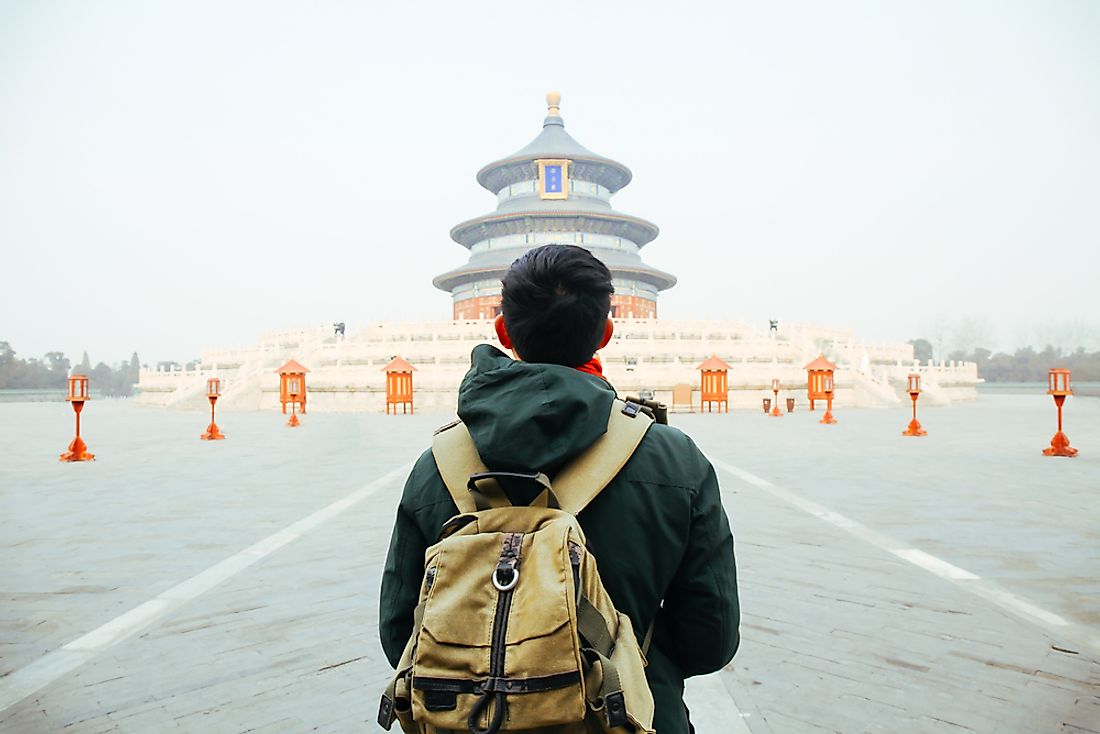
China is a large East Asian country that has become increasingly popular with tourists over the last decade or so. It encompasses a wide range of geographic landscapes, from hot and humid subtropical forests in the south to vast and arid deserts in the north. It has a long Pacific coastline and tall mountain ranges. All of this is crisscrossed by coursing rivers and remains of the ancient Silk Road. Besides all of this natural beauty, China also offers travelers a look at its complex and diverse culture that has evolved over 5,000 years.
This uniqueness makes China a particularly attractive tourist destination. Deciding what to do during a trip to this country, however, can be overwhelming. To make it a little easier, here are several possible travel itineraries, created with the backpacker in mind.
4. 2 months - Beijing - Xi'an - Chengdu - Guilin - Yangshuo - Guangzhou
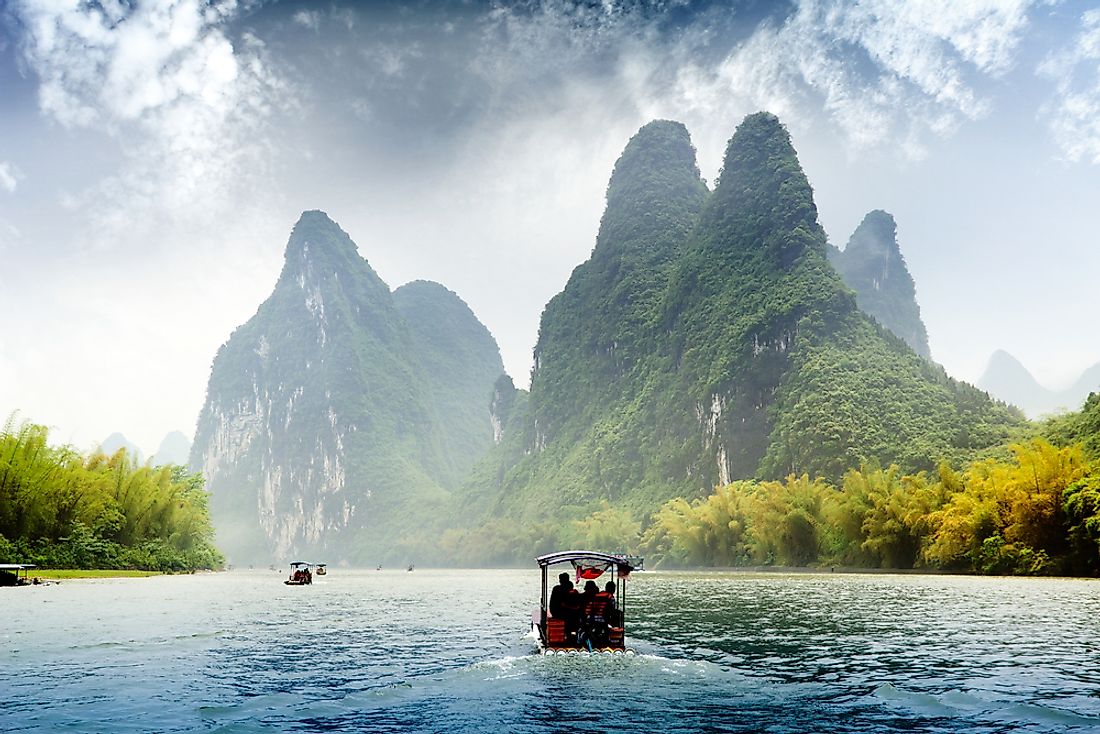
Fortunate is the person who has 2 months to explore China. As with most trips, the adventure begins after flying into Shanghai. Spend a few days getting to know this city. From the airport, take the Maglev train, which can travel up to 267 miles per hour, into the city and head to the Shanghai Museum. Its exhibits give a look into 5,000 years of history, which is a great way to start any trip to China. Soup dumplings are a typical dish in Shanghai and generally served at lunchtime. After a full day of exploring, many visitors like to head down to the edge of the river in the evening to catch a glimpse of the brightly lit cityscape. The skyline here is home to Shanghai Tower, the tallest building in the world. On day 2, an early morning walk through the Bund district offers a sharp contrast to the modern skyline from the night before. This neighborhood is home to 1920’s Neoclassical-style architecture all along the Huangpu river. An excellent place to spend the late afternoon is on Dongtai Road to explore the many used bookstores and antique shops here. Visiting the French Concession area and strolling along Ruijin Road to see the mansions and ornate gardens is a good way to spend the morning of day 3.
Take a train to Beijing on the evening of day 3. In the morning, the first visit should be to the Forbidden City, or Palace Museum, in the center of the city. It can take all day to walk through and discover this palace complex. Other sites in Beijing include: Tiananmen Square, the Great Wall, the Temple of Heaven, and Hutong and Courtyards. To truly enjoy these sites, allowing for an entire afternoon is best. Outside of the city is the Summer Palace and the Ming Tombs, which can be enjoyed on separate day trips. Given the size of this city, a week to a week and a half here is recommended.
From Beijing take an overnight train to Xi’an, which can take anywhere from 5 to 13 hours depending on the line. Perhaps the most famous thing to check out here is the Army of Terracotta Warriors, located about 12.5 miles outside of the city. Within Xi’an, visitors often visit the city wall. It is the largest in the world, standing at 39.3 feet tall and 16.4 feet wide at the top, and walking along the top takes between 4 to 5 hours. Allow a day to simply roam around the city and try various snacks from street vendors.
From here, a flight to Chengdu, the capital of Sichuan, is a great next step. For people who love pandas, a visit to the Giant Panda Breeding Research Base is a must. Other attractions here include: the Wenshu Buddhist Temple, the Wuhou Ci burial grounds, and the Jinsha Museum. Chengdu can also be a good place to catch up on some much needed relaxation. It is located along Jin River and has a beautiful Ginkgo tree-lined walkway. This city is also home to a number of traditional tea houses. Outside of the city, the sacred mountain Emeishan offers a number of hiking trails, temples, and statues.
Next is a 1 hour and 35-minute flight from Chengdu to Guilin. Guilin and the surrounding area offer an abundance of outdoor activities and is a great place to go after spending so much time in the previous cities. One should plan to spend about 1 week here. On day 1, walking around the city and enjoying the sights and sounds is a good way to pass the time. After that, a cruise along the Li river gives travelers a chance to spend the next couple of days in Yangshuo. Here, visitors can ride bikes around the rice paddies, visit fruit orchards, and climb the famous Moon Hill. Another day trip (or 2) is necessary to see the rice terraces of Longji, complete with ancient walking trails and local folk performances. Before going on to the next location, a few days in the countryside of Xingping offers some excellent photography opportunities.
For the final leg of this 2-month journey, Guangzhou offers an excellent array of tourist activities. Trains are available from Guilin to this city. Some of the most popular things to do include visiting the: Sacred Heart Cathedral, Botanical Garden, Chimelong Paradise “Water Park, and the Huangsheng Mosque.
3. 1 month - Shanghai - Beijing - Xi'an - Chengdu - Guilin
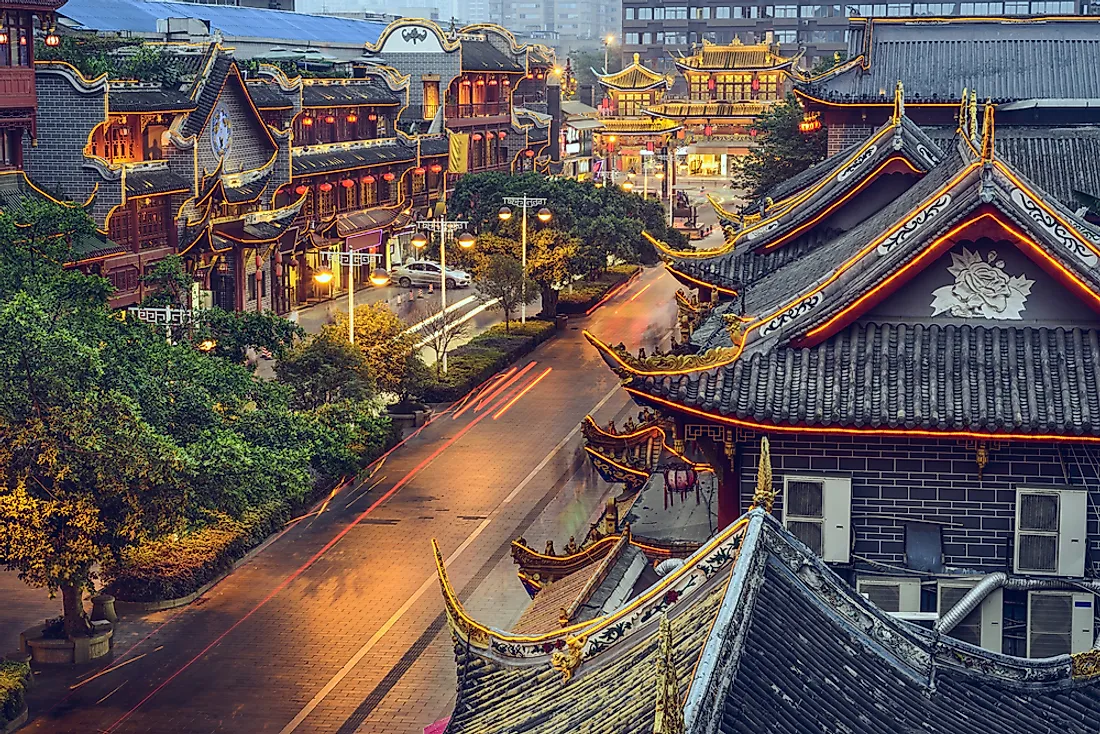
The 1 month itinerary is very similar to the 2 month, except it replaces the visits to Guilin and Guangzhou with a visit to Chongqing. With 1 month in China, travelers can spend 3 days in Shanghai, take a train to Beijing and stay for 3 days, take an overnight train to spend 1 week in Xi’an, from there fly to Chengdu for 1 week, and then take a train to Guangzhou and stay for 1 week. All of the tips for Shanghai, Beijing, and Xi’an remain the same as mentioned in the 2-month itinerary.
The train from Chengdu to Guangzhou takes approximately 11.5 hours, giving weary travelers a chance to rest. After arriving, one of the most popular things to do here is arrange a river cruise through the Three Gorges Dam area of the Yangtze river. Many visitors enjoy walking along Foreigner Street within the city limits, which has a number of attractions, including: the largest public restroom in the world, an upside down church, and an Australian bar. Another interesting site is the Zha Zi Dong, a prison used during the 1940’s. Guangzhou is also a great base from which to check out the Dazu Rock Carvings UNESCO World Heritage Site, about 3 hours away.
2. 3 weeks - Shanghai - Hangzhou - Beijing - Xi'an
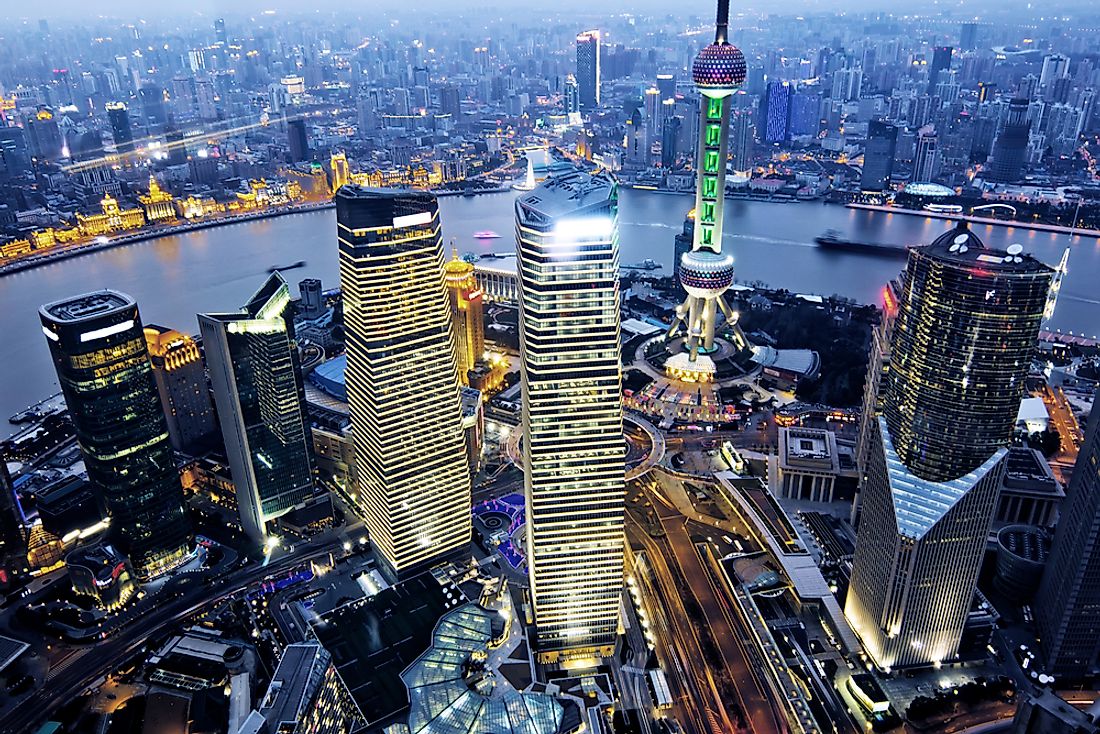
With 3 weeks in China, the best course of action is to take a 1 hour train trip to Hangzhou after spending around 3 days in Shanghai. Spend roughly 6 days or so in Hangzhou and from here, take an 8-hour train ride to Beijing. After a 3-day stay in Beijing, taking an overnight train to spend 1 week in Xi’an can help avoid the cost of another night in a hotel. Below is a look at how to spend a week in Hangzhou.
Hangzhou is surrounded by mountains covered in tea plantations. This city offers a look at traditional Chinese architecture and landscaping, complete with bridges, floating water lilies, and perfect island gardens. After spending a few days in the hectic urban setting of Shanghai, visitors to Hangzhou might enjoy renting a bike to cycle around the large West Lake located here. It is also home to the Grand Canal, which is the longest artificial waterway in the world and dates back to around 2,500 years ago. After a day of cycling, the 7:30 p.m. boat tour that leaves from Wulinmen Wharf is the perfect way to wind down the day.
The Xixi Wetland National Park is also located here. It covers 2,800 acres and offers several sights, including: the Plum and Bamboo Manor, where writers met during the Qing Dynasty; the Hazy Fisher Village, so named for the smoke emitted from chimneys; the Autumn Snow Temple; and the Deep Pool Mouth, which is the starting point for yearly dragon boat races. Just outside of the city are a number of tea plantations and the Imperial Tea Garden in the Longjing Village is a nice place to enjoy a cup. For those interested in learning more, the Tea Museum in the city offers a more in-depth look at the history of cultivating and enjoying tea.
1. 1 week - Shanghai and Beijing
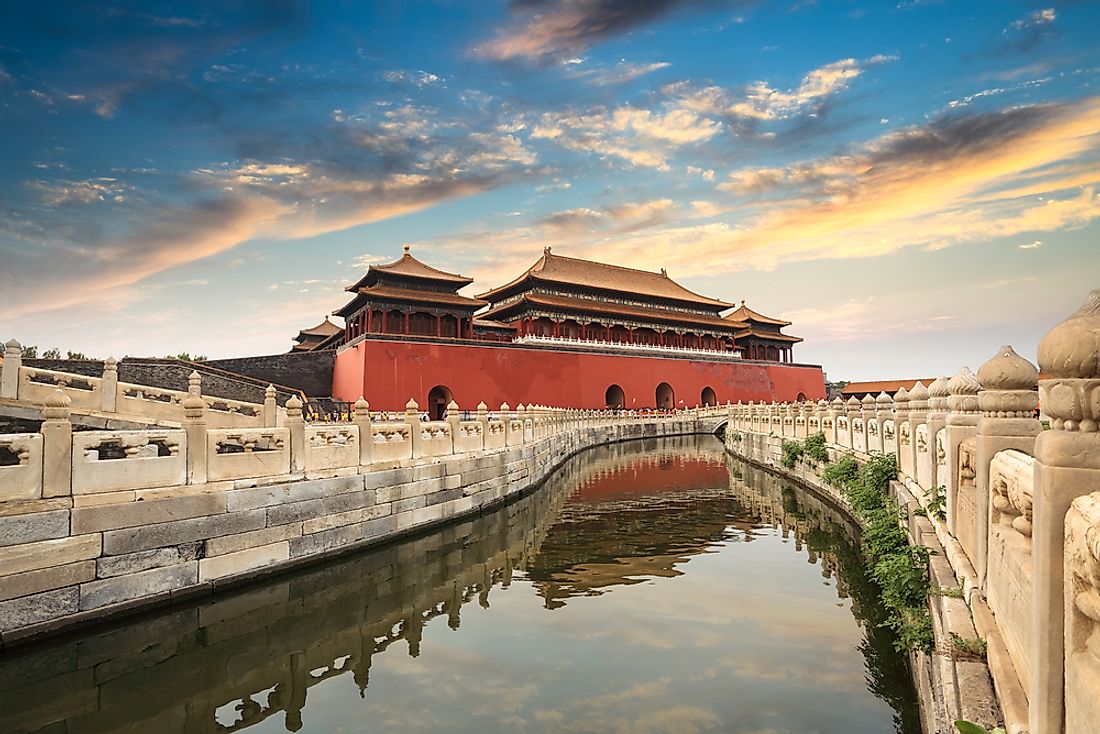
For people on a tight, 1 week schedule, the best way to enjoy China is to stay in the two largest cities: Shanghai and Beijing. For Shanghai, the best schedule is to follow the 2-month itinerary plan for day 1 and day 2. On day 3 in Shanghai, however, the best bet is to get out of the urban setting before heading to Beijing. A trip to Anji Bamboo Forest gives visitors a look at some of the natural landscape that China has to offer. This forest is just around 4 hours from the city, with the earliest bus leaving at 7:10 a.m. from the South Railway Station. The Anji Bamboo Forest has a number of hiking trails, a self-controlled train car ride, and plenty of stone paths crossing the lakes. It is a wonderful place to spend the afternoon. To head back to Shanghai the same evening, tourists need to take a bus to Hangzhou and then a train or taxi back to Shanghai.
Once back in Shanghai, the best way to get to Beijing is on a high-speed train, which takes around 5 hours. In Beijing, visitors need a few days to check out the most popular attractions: the Great Wall and the Forbidden City Palace Complex.
More in Travel

13 Most Underrated Towns In New York To Take A Trip To

Tales in Transit: The Twists & Turns of World Travel

13 Most Underrated Towns In Massachusetts To Take A Trip To

9 Most Underrated Towns In Washington To Take A Trip To

Riding The Rails Across Europe: A Haphazard Adventure

An American's Guide for the Camino de Santiago

13 Most Underrated Towns In Upstate New York To Take A Trip To

Explore The Most Charming Spots To Visit Around Lake Constance
Tourist Itineraries in China for Trips of 1, 2 or 3 Weeks
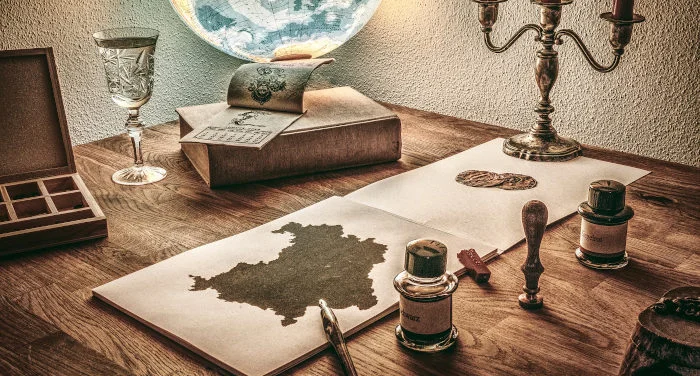
Tourist Itineraries in China – Index
Itineraries (the complete list), itineraries from 6-8 days.
- Itinerary of 12-15 Days
- Itinerary of 18-21 Days
Frequently asked questions
In this article you’ll find a collection of itineraries for visiting China . Keep in mind that China is extremely vast and diverse, so trying to visit it all in just a few weeks makes no sense.
This is why we have divided the itineraries into three main sections; something for those planning a trip of 6-8 days, those planning to stay 12-15 days or, why not, 18-21 days.
For each section, we have also specified if it is a “historic” itinerary (or designed for visiting mainly sites of archaeological interest, such as Xi’an for example), “natural” (or designed for those who want to be immersed in nature, such as Jiuzhaigou), or “contemporary” (or designed for visiting modern realities such as Shenzhen or recurring festivals, like the Ice and Snow Sculpture Festival of Harbin).
Moreover, for each itinerary we have also added a difficulty rating based on the necessary movements to complete it and the best time to visit each zone or province.
Lastly, for more general information on traveling in China I recommend that you also read the following articles:
- Traveling in China: The complete guide
- Tours in China: Advice and agencies
- How to book a hotel in China
- Health insurance for travelers
- Flights to China: The complete guide
- How to travel by train in China
Click on one of the links on the table below to directly see the itinerary that interests you the most:
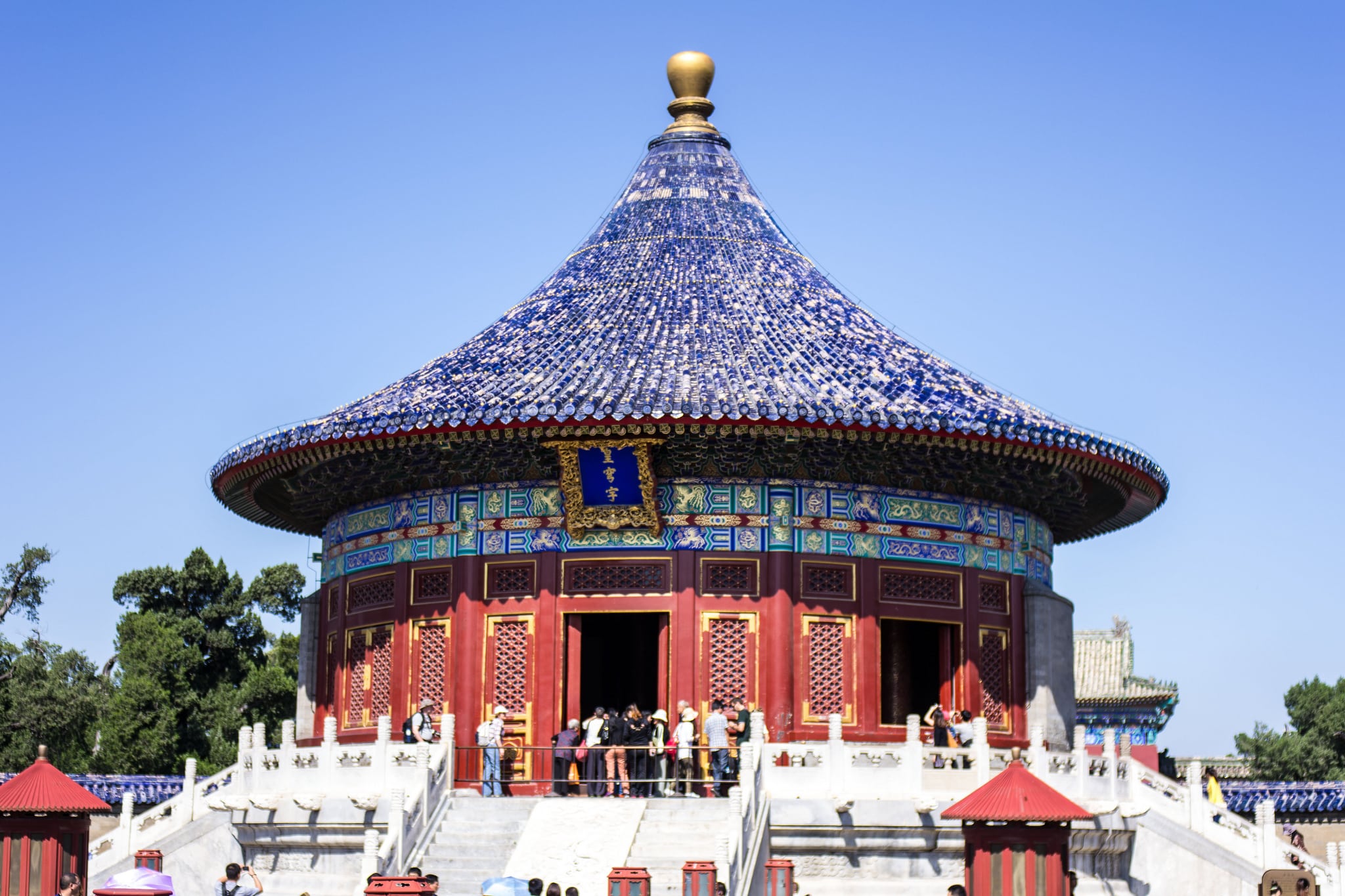
Note that, even if the majority of the itineraries in this section can be completed in about 6 days, if you’re one of those people that likes to take one or two afternoons free just to lose themselves in a city or sit and observe people passing by (one of my favorite hobbies), then I recommend that you figure on at least 8 days.
Beijing – Discover the appeal of Imperial China
- Itinerary Type : Historic.
- Movement difficulty : Very low, since you can land directly in the city, get around mainly by subway and leave the city just to visit the Great Wall of China .
- Best time to travel : The best time to visit is the autumn when the weather is dry and temperate. That said, it’s possible to visit Beijing at almost any time of the year .
- Recommended hotels : Click here to read our reviews on the best luxury & budget hotels in Beijing.
- Tour operator : If you’re interested in an organized your, as a group or in private, click here to learn more and get a free estimate.
Itinerary :
Day 1: Arrive in Beijing and visit the Summer Palace and the university area of Haidian;
Day 2: Visit the Ming Tombs and the Great Wall at Mutianyu , or the “Wild” Great Wall at Gubeikou ;
Day 3: Visit the Temple of Heaven and the shopping area of Wangfujing;
Day 4: Visit Tian’An Men Square, the Forbidden City and Coal Hill;
Day 5: Visit to the Temple of the Lama, Temple of Confucius, the Bell Tower, Drum Tower, in the Gulou neighborhood and the few Hutong left in the city;
Day 6: Walk in the international quarters of Sanlitun and Dongzhimen.
- Other attractions that might interest you : Silk Market at Guomao, Street of Artisans (Liu Li Chang), Beijing Opera, Olympic Stadium, shopping area of Xidan, Beihai Park, Lake Houhai, Lake Xihai, Beijing Zoo.
- Visits outside the city : If you want to get our of the city for 1/2 days, I recommend a day trip to Tianjin , 2 two days of Trekking on the Great Wall of Simatai at Jinshanling , or a visit, still for 2 days, to the Ice and Snow Festival of Harbin (which is only open in late winter).
Beijing-Xi’An – Discovering ancient China
- Movement difficulty : Medium, if you decide to take the Beijing-Xi’An night train; low if you decide to take a direct flight.
- Best time to travel : The best time to visit is the autumn when the weather is dry and temperate. That said, it’s possible to visit the two cities at almost any time of the year.
- Hotel consigliati :Click on the links below to read our reviews on the best luxury and budget hotels in Beijing e Xi’An .
- Tour operators : If you’re interested in an organized tour, as a group or in private, click here to learn more and get a free estimate.
Day 4: Visit Tian’An Men Square, the Forbidden City and Coal Hill; Beijing-Xi’An night train;
Day 5: Visit the archaeological site of the Terracotta Warriors and the Xi’An city center (Muslim quarter and old city walls);
Day 6: Excursion to Mount Hua ;
Day 7: Return to Beijing with the fast train and visit the a Gulou neighborhood;
Tibet: Lhasa-Lake Namtso-Shigatse – Visit to the roof of the world
- Itinerary Type : Historic/Natural.
- Movement difficulty : High. Besides getting to Tibet (which is 45 hours by train or 4 hours by air from Beijing), unless you want to stay in Lhasa you’ll be forced to spend long hours on a bus, with the greatest problems due to the altitude. Click here to read our guide on traveling in Tibet.
- Best time to travel : The best time to visit Tibet is the autumn, when the weather is dry and relatively mild. Avoid the winter, when many passes are closed due to the snow. You should also make sure that Tibet is open to foreign travelers during the period you intend to travel, since the Province is often closed to tourists.
- Recommended Hotels : This will be handled by the tour operator you go with (see below).
- Tour operators : To visit Tibet, it is mandatory to be accompanied by an authorized tourist guide. Click here to learn more and get a free estimate.
Days 1 and 2: Train Beijing-Lhasa. If you have the time, I recommend that you arrive in Tibet by train. Not just because it’s a unique experience, but also so that your body can gradually acclimate to the change in altitude. If you only have six days, then it’s best to arrive by air: it would be a sin to go all the way to Tibet to stay only 4 days!
Day 3: Visit Potala Palace, the Jokhang Temple, Barkhor Street and the historic center of Lhasa;
Day 4: Visit Lake Namtso ;
Day 5: Visit Lake Yamdrok, at the Kharola Glacier, and the city of Shigatse (staying the night in Shigatse);
Day 6: Visit the Monastery of Tashilhunpo (near Shigatse) and the Palcho Monastery, situated in the city of Gyantse, or way back to Lhasa.
Day 7: Visit the Monasteries of Drepung and Sera, near Lhasa.
Yunnan: Kunming-Dali-Lijiang-Shangri-La – Multi-ethnic China at the foot of the Himalayas
- Itinerary Type : Natural.
- Movement difficulty : Medium; once you’ve arrived in Kunming, where flights coming from all major Chinese cities land, the other cities are well connected both by train (except for the Stone Forest and Shangri-La) and bus. Considering Lijiang’s popularity among Chinese tourists, finding train tickets is often complicated which means that you may have to settle for the bus.
- Best time to travel : Despite not being an extremely vast province , the climate in Yunnan varies from sub-tropical in the southern area to alpine in the region of Shangri-La. In my opinion there isn’t one specific time to visit that’s better than others; besides of course not going during Chinese holidays when the Province is invaded by Chinese tourists.
- Recommended Hotels :Click on the links below to read our reviews on the best luxury and budget hotels in Kunming , Dali and Lijiang .
- Tour operator : If you’re interested in an organized tour, as a group or in private, click here to learn more and get a free estimate.
Day 1: Arrive in Kunming and visit the city;
Day 2: Get up very early to visit the Stone Forest before the hordes of Chinese tourists arrive; bus for Dali;
Day 3: Visit the Old City of Dali;
Day 4: Excursion to Mount Cang (you can get there on foot from the Old City of Dali), and bus for Lijiang;
Day 5: Visit the Old City of Lijiang, then take a bus for Shangri-La;
Day 6: Visit the village of Shangri-La and the Tibetan Monastery of Songzanlin, near Shangri-La (even though Shangri-La geographically speaking is located in Yunnan, the local population are ethnic Tibetans and the monastery has no reason to envy those geographically found in Tibet);
Day 7: Return to Kunming.
- Recommended trekking : 2 day excursion to Tiger Leaping Gorge , located between Lijiang and Shangri-La.
Shanghai-Suzhou-Nanjing-Hangzhou – The Cities on the Yellow River Delta
- Itinerary Type : Historic/Modern
- Movement difficulty : Low; the four cities are connected by fast trains.
- Best time to travel : As is often the case in China, the best time is in the autumn, or the dry and mild season. That said, the area can be visited in any time of year.
- Recommended Hotels :Click on the links below to read our reviews on the best luxury and budget hotels in Shanghai , Hangzhou , Suzhou and Nanjing .
Day 1: Arrive in Shanghai ; visit the Yuyuan Gardens, the Shanghai Museum, the Bund, and Nanjing Road;
Day 2: Visit the Oriental Pearl TV Tower financial district of Lujiazui (where you’ll find all of Shanghai’s major skyscrapers);
Day 3: Arrive in Suzhou and visit the city; overnight there;
Day 4: Arrive in Nanjing and tour the city , overnight there;
Day 5: Visit Nanjing (morning) then the Nanjing-Hangzhou train in late afternoon;
Day 6: Arrive in Hangzhou and tour the city ( West Lake is not to be missed!);
Day 7: Return to Shanghai; visit the Old French Concession.
- Recommended trekking : 2 day excursion to the Yellow Mountain (or Huang Shan).
Hong Kong-Macau-Shenzhen – Modern and Colonial China
- Itinerary Type : Modern, since Hong Kong and Macau are two relatively “modern” cities (compared to Beijing or Nanjing), while Shenzhen up until a few decades ago was little more than a fishing village.
- Movement difficulty : Low; Hong Kong and Shenzhen are linked by metro, while all you have to do get to Macau is take the ferry from Hong Kong (the crossing lasts about an hour).
- Best time to travel : The best season for visiting Guangdong Province and the cities of Hong Kong and Macau is the winter, when there isn’t too much heat (it’ll be about 15-20 degrees C) with little rainfall.
- Recommended Hotels :Click on the links below to read our reviews on the best luxury and budget hotels in Hong Kong , Macau and Shenzhen .
Day 1: Arrive in Hong Kong, visit Central, Causeway Bay and Victoria Peak ;
Day 2: Visit Landau Island(for the Giant Buddha and village of Tai-O ); dinner at Lan Kwai Fong (LKF);
Day 3: Visit Kowloon peninsula; don’t miss the free show “A Symphony of Lights” on the Avenue of Stars, which takes place at around 8 every evening;
Day 4: Visit Macau on day trip (you can catch the ferry from Hong Kong Island);
Day 5: Arrive in Shenzhen; visit the Nanshan District ;
Day 6: Visit the Districts of Futian and Luohu, still in Shenzhen;
Day 7: Return to Hong Kong.
Guangxi: Guilin-Yangshuo-Longsheng – The karst hills on the shores of the Li River
- Movement difficulty : Low, since almost all hotels can help you arrange transport either by bus or boat.
- Best time to travel : The best time to travel is May if you want to see the newly watered rice paddies of Longsheng. That said, it is possible to visit Guilin and the rest of Guangxi Province in almost any time of the year.
- Recommended Hotels :Click on the links below to read our reviews on the best luxury and budget hotels in Guilin, Longsheng and Yangshou .
Day 1: Arrive in Guilin and tour the city;
Day 2: Cruise on the Li River and arrive in Yangshuo ; visit the city center;
Day 3: Take a ride on the Yulong River and return by bicycle ; fishing with cormorants show;
Day 4: Transfer to Longsheng (by bus) and visit the terraced rice paddies ;
Day 5: Return to Guilin and visit “Reed Flute Cave” and “Elephant Trunk Hill”.
Sichuan: Chengdu-Emei Shan-Leshan – Visit the heart of Sichuan
- Movement difficulty : Low, since all destinations can be easily reached by bus from Chengdu.
- Best time to travel : Summer is very hot while the winter is cold, so the best times are the Spring and autumn.
- Recommended Hotels : Click here to read our reviews on the best luxury and budget hotels in Chengdu.
Day 1: Arrive in Chengdu and tour the city center;
Day 2: Visit the Chengdu Panda Research Base of Giant Panda Breeding and get to Mount Emei, or Emei Shan, by bus;
Day 3: Climb Emei Shan with an overnight stay in one of the many monasteries that can be found along the way;
Day 4: Arrive at the top of Emei Shan and descend (by bus); arrive in Leshan by bus;
Day 5: Visit the Giant Buddha of Leshan and the surrounding park;
Day 6: Return to Chengdu.
Sichuan: Chengdu-Jiuzhaigou-Huanglong – The most spectacular parks of China
- Itinerary Type : Natural
- Movement difficulty : Medium, considering that in the Jiuzhaigou region, public transport is virtually nonexistent (which is why it’s much simpler to visit this region of China with an organized tour).
- Best time to travel : The autumn, when it’s not too hot and the leaves of the trees turn breathtaking colors. That said, Sichuan can be visited anytime of the year (but winters in Jiuzhaigou are very rough).
Day 2: Visit the Chengdu Panda Research Base of Giant Panda Breeding and get to Jiuzhaigou (by bus or plane);
Days 3-4: Visit Jiuzhaigou National Park (spending just one day would be a sin);
Day 5: Visit Huanglong National Park;
Day 6: Return to Chengdu or, directly to Beijing from the airport in Huanglong.
- Recommended trekking : 2 day horseback excursion to Sonpang, near Jiuzhaigou.
Henan: Luoyang-Tempio Shaolin-Xi’An – Visit the birthplace of Kung Fu
- Movement difficulty : Medium, because unless you visit with an organized tour, you’ll have to get around by train and/or bus in Henan Province where the use of English is not very widespread.
- Best time to travel : The best time is the autumn, as is the case with the majority of China.
- Recommended Hotels : Click here to read our guide on Henan Province, where we indicate a few hotels in all areas of interest to tourists; and here to read reviews of the best hotels in Xi’An.
Day 1: Arrive in Luoyang (by air or fast train from Beijing) and visit the Cave of Longmen;
Day 2: Visit the Temple of Baima and the Luoyang Museum;
Day 3: Arrive in Dengfeng, visit the Shaolin Temple and the Mount Song National Park;
Day 4: Return to Luoyang, and move on to Xi’An by fast train; visit the Xi’An Muslim Quarter;
Day 5: Visit the archaeological site of the Terracotta Warriors and the old city walls of Xi’An;
Day 6: Excursion to Mount Hua .
- Recommended activity : Kung Fu lessons in Dengfeng.
Hunan and Guangxi: Zhangjiajie-Fenghuang-Guilin-Yangshuo
- Movement difficulty : Medium, since you will always have to take a bus or train to reach various destinations.
- Recommended Hotels : Click here to read our guide to hotels in China.
Days 1 & 2: Arrive in Zhangjiajie by air or fast train and visit Zhangjiajie National Forest Park (it would be a sin to spend only one day);
Day 3: Excursion to Mount Tianmen, near Zhangjiajie;
Days 4 e 5: Visit the city of Fenghuang; train or bus for Guilin;
Day 6: Cruise on the Li River and arrive in Yangshuo ; visit the city center;
Day 7: Ride on the Yulong River and return by bicycle ; fishing with cormorants show.
- Recommended trekking : 1 or 2 day excursion to the terraced rice paddies of Longsheng .
Itineraries from 12-15 days
In this section, I will illustrate various itineraries for trips of about two weeks. Obviously, you can create a different itinerary by simply combining two of the one-week itineraries I laid out in the previous section.
Beijing-Luoyang-Dengfeng-Xi’An-Shanghai
- Itinerary Type : Historic/Modern.
- Movement difficulty : Medium, considering that unless you travel on an organized tour, you’ll have to get around by train and/or bus through Henan, or the Luoyange Dengfeng Province, where English is not widely spoken.
- Best time to travel : Autumn, when the weather is dry and mild. However this itinerary can be traveled any time of year.
- Recommended Hotels : Click on the links below to read our reviews on the best luxury and budget hotels in Beijing , Xi’An and Shanghai .
Day 1: Arrive in Beijing and visit the Summer Palace and Haidian university area;
Day 5: Visit the Temple of the Lamas, the Temple of Confucius, the Bell Tower, the Drum Tower, Gulou quarter and the few remaining Hutongs left in the city;
Day 6: Walk through the international quarters of Sanlitun and Dongzhimen; arrive in Luoyang (by air or fast train);
Day 7: Visit the Cave of Longmen, visit the Baima Temple and Luoyang Museum;
Day 8: Arrive in Dengfeng, visit Shaolin Temple and Mount Song National Park;
Day 9: Return to Luoyang, then travel on to Xi’An by fast train; visit the Xi’An Muslim Quarter;
Day 10: Visit the archaeological site of the Terracotta Warriors and the ancient city walls of Xi’An;
Day 11: Excursion to Mount Hua ;
Day 12: Arrive in Shanghai (by train); visit Yuyuan Gardens, Shanghai Museum, the Bund, and Nanjing Road;
Day 13: Visit the Oriental Pearl TV Tower and Lujiazui financial district (where you’ll find all of Shanghai’s major skyscrapers);
Day 14: Visit the Old French Concession.
Beijing-Pingyao-Datong-Xi’An-Guilin-Yangshuo
- Movement difficulty : Medium if you travel by train since you’ll have to cross half of China! Lower if you decide to get around by air.
- Best time to travel : The best season is the fall, when the weather is dry and mild. You can however visit the destinations listed at any time of year.
- Recommended Hotels : Click on the links below to read our reviews on the best luxury and budget hotels in Beijing , Datong , Pingyao , Xi’An , Guilin and Yangshuo .
- Tour operator :If you’re interested in an organized tour, as a group or in private, click here to learn more and get a free estimate.
Day 2: Visit the Ming Tombs and the Great Wall at Mutianyu , or the “Wild” Great Wall of Gubeikou ;
Day 3: Visit the Temple of Heaven and the shopping district of Wangfujing;
Day 6: Walk through the international quarters of Sanlitun and Dongzhimen; arrive at Datong (by air or fast train);
Day 7: Visit the Yungang Cave and Hanging Temples of Datong ;
Day 8: Arrive in Pingyao (by train); visit the walls of the Old City, visit the residences of the Wang ande Qiao families;
Day 9: Arrive in Xi’An (by train) and tour the city center of Xi’An (Muslim quarter and ancient city walls);
Day 10: Visit the archaeological site of the Terracotta Warriors ; arrive in Guilin (by air);
Day 11: Cruise in the Li River and arrive at Yangshuo ; tour the city center;
Day 12: Ride on the Yulong River and return by bike ; fishing show with cormorants;
- Recommended trekking : Excursion to Mount Hua (near Xi’An) and/or the terraced rice paddies of Longsheng , near Guilin.
Beijing-Xi’An-Chengdu-Chongqing-Cruise on the Yangtze-Yichang
- Recommended Hotels : Click on the links below to read our reviews on the best luxury and budget hotels in Beijing , Xi’An and Chengdu .
Day 6: Walk through the international quarters of Sanlitun and Dongzhimen; arrive in Xi’An (by air or train);
Day 7: Visit the archaeological site of the Terracotta Warriors ;
Day 8: Visit the city center of Xi’An (Muslim quarter and ancient city walls); arrive in Chengdu (by air or train);
Day 9: Visit the Chengdu Panda Research Base of Giant Panda Breeding and the city center;
Day 10: Arrive in Chongqing and depart on a Yangtze River Cruise (or Blue River);
Day 11: Cruise on the Yangtze;
Day 12: Arrive, via cruise, in Yichang, where you’ll find the Three Gorges Dam ( Three Gorges Dam ).
Beijing-Zhangjiajie-Fenghuang-Guilin-Yangshuo
- Movement difficulty : Medium since you’ll be crossing half of China, and especially in the regions of Zhangjiajie and Guilin, where you’ll have to get around by train, bus or boat.
- Recommended Hotels : Click on the links below to read our reviews on the best luxury and budget hotels in Beijing , Guilin and Yangshuo .
Day 6: Walk through the international quarters of Sanlitun and Dongzhimen; arrive in Zhangjiajie (by air or fast train);
Days 7 and 8: Visit Zhangjiajie National Forest Park (it would be a sin to only spend one day there);
Day 9: Excursion to Mount Tianmen, near Zhangjiajie;
Days 10 and 11: Visit the city of Fenghuang; train or bus for Guilin;
Day 12: Cruise on the Li River and arrival in Yangshuo ; visit the city center;
Day 13: Ride on the Yulong River and return by bike ; fishing show with cormorants.
Beijing-Tianjin-Qingdao-Mount Tai-Qufu
- Movement difficulty : Medium, because in Shandong Province (or the second half of the trip), you can only get around by train or bus.
- Recommended Hotels : Click on the links below to read our reviews on the best luxury and budget hotels in Beijing , Tianjin and Qingdao .
Day 6: Walk through the international quarters of Sanlitun and Dongzhimen; arrive in Tianjin (by fast train);
Day 7: Tour the city center of Tianjin ;
Days 8-9: Arrive in Qingdao (by train) and tour the city ;
Day 10: Arrive on the slopes of Mount Tai (or Taishan, by train), climb Mount Tai and spend the night up top;
Day 11: Descend Mount Tai and arrive in Qufu, the birth city of Confucius;
Day 12: Visit the Confucius Family Mansion.
- Recommended activity : Beer Festival in Qingdao, if you go in August.
Tibet: Lhasa-Lago Namtso-Shigatse-Everest Base Camp-Kathmandu
- Movement difficulty : High. Besides having to get to Tibet (which is 45 hours by train or 4 hours by air from Beijing), unless you stay in Lhasa you’ll be forced to spend long hours on buses, with the greatest problems due to the altitude. Click here to read our guide to traveling in Tibet. Note that besides a Chinese visa and Tibet Permit, if you intend to arrive in Kathmandu you will also need a Nepalese visa.
- Best time to travel : The best time to visit Tibet is in the fall, when the weather is dry and relatively mild. Avoid the winter when many passes are closed due to the snow. Furthermore, make certain that Tibet will be open to foreign tourists in the period you intend to visit, since the Province is often closed to tourists.
- Recommended hotels : This will be handled by your tour operator (see below).
- Tour operator : To visit Tibet, you are obligated to be accompanied by an authorized tour guide . Click here to learn more and get a free estimate.
Days 1 and 2: Train Beijing-Lhasa. If you have the time, I recommend that you get to Tibet by train. Not only is it a unique experience, but you can also acclimate your body to the gradual change in altitude.
Day 3: Visit Potala Palace, Jokhang Temple, Barkhor Street and the historic center of Lhasa;
Day 5: Visit the Monasteries of Drepung and Sera, near Lhasa;
Day 6: Visit Lake Yamdrok, Kharola Glacier, and Palcho Monastery, situated in the city of Gyantsee ; arrive in Shigatse and overnight there;
Day 7: Visit the Tashilhunpo Monastery (near Shigatse), visit Sakya Monastery, arrive in Lhatse and overnight there;
Day 8: Arrive in Rongbuk and visit the “highest”, in terms of altitude, monastery in Tibet. Trekking at Everest Base Camp (about 6 Km and two hours of walking); overnight in Rongbuk, in a tent;
Day 9: After admiring the sunrise from the Base Camp, move on to Zhangmu via Old Tingri and Nyalam; overnight there;
Day 10: Arrive at Kodari, at the border between Tibet and Nepal; walk the border and arrive at Kathmandu; overnight there;
Days 11 and 12: Visit Kathmandu, in Nepal.
Xinjiang: Urumqi-Kashgar-Tashkurgan-Kanas
- Movement difficulty : High if you get around by train or bus, since Xinjiang is the vastest province in China. Medium if you take flights for the largest sections, since several locations can only be reached by bus or in the case of Karakorum, only with a private car and driver (see the details in the itinerary).
- Best time to travel : The best time is the fall, when the weather is dry and mild and you can taste the seasonal fruits (grapes, figs, melons and more). Winter is not recommended since some parts of the itinerary can not be traveled due to the snow.
- Recommended Hotels : Click on the links below to read our reviews on the best luxury and budget hotels in Urumqi and Kashgar .
Day 1: Arrive in Urumqi, capital of the province, by air; move on to Kashgar by overnight train (about 20 hours of traveling) or by air;
Day 2: Visit the Mosque of Id Kah and the Old City of Kashgar ;
Day 3: Visit the tomb of Abakh Khoja and the night market of Jie Fang Bei Road;
Day 4: Visit the Desert of Da Wa Kun (with camel ride) by bus;
Days 5 and 6: Excursion Kashgar-Tashkurgan along the Karakorum Highway , the highest paved international highway in the world – in terms of altitude – which connects Pakistan and Cina. Note that there are no bus lines here; I recommend that you ask at your hotel about renting a private car and driver (cost: about 1,500 Yuan);
Day 7: Return to Urumqi then a night bus to Burjin, a city found at the feet of the Altai Mountains, north of Urumqi;
Days 8 and 9: Bus for Hemu, visit the village (“cowboy” style) and beautiful nearby hills; overnight there;
Days 10 and 11: Bus for the Tourist Complex of Kanas and a visit to the park;
Day 12: Return to Urumqi.
- Recommended trekking and activities : Excursion to Lake Tianchi, 110 Km from Urumqi; visit the Kashgar livestock market (open only on Sundays); excursion from Hemu to Kanas, in the Altai Mountains.
Kunming-Dali-Lijiang-Lake Lugu-Emei Shan-Leshan-Chengdu
- Movement difficulty : Medium; once you arrive in Kunming, where flights arrive from all teh major cities of China, the other cities are well connected by train and bus lines. Considering the popularity of Lijiang among Chinese tourists, often finding train tickets in Yunnan is complicated and you’ll have to settle for the bus.
- Best time to travel : Despite not being an extremely vast province , the climate in Yunnan varies from sub-tropicale in the south to alpine in the region of Shangri-La. In my opinion there’s no one period when it’s better to visit than another; with the obvious exception of not going during Chinese holidays when the Province is invaded by Chinese tourists. For Sichuan, on the second part of the trip, the best time to visit is without a doubt the fall.
- Recommended Hotels : Click on the links below to read our reviews on the best luxury and budget hotels in Kunming , Dali , Lijiang and Chengdu .
Day 1: Arrive in Kunming and tour the city;
Day 2: Get up very early to visit the Stone Forest before the crowds of Chinese tourists; bus for Dali;
Day 4: Excursion to Mount Cang (you get there on foot from the Old City of Dali), and bus for Lijiang;
Day 5: Visit the Old City of Lijiang; overnight there;
Days 6-7: Bus for Lugu Lake , homeland of the almost matriarchal tribe of the Mosuo ; visit the various places around the lake ; overnight in the Village of Lige;
Day 8: Bus from Lugu to Xichang; night train from Xichang to Emei Shan;
Day 9: Climb Emei Shan with an overnight in one of the many monasteries along the route;
Day 10: Arrive at the top of Emei Shan and descend (by bus); arrive in Leshan, by bus;
Day 11: Visit the Giant Buddha of Leshan and the surrounding park; bus for Chengdu;
Day 12: Visit the Chengdu Panda Research Base of Giant Panda Breeding and the city center of Chengdu;
- Recommended trekking : 2 day excursion to Tiger Leaping Gorge .
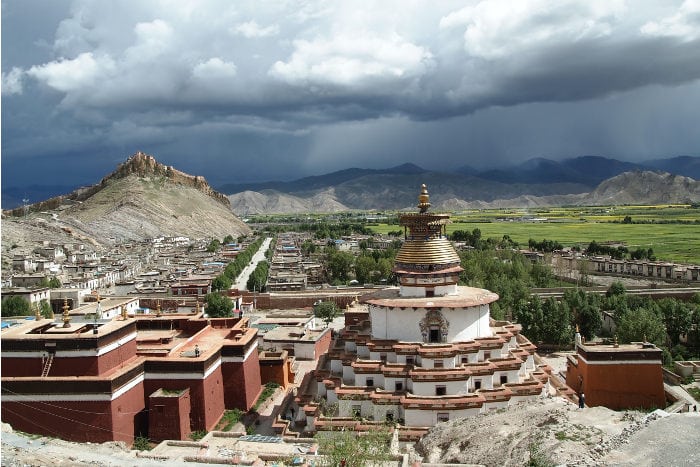
Itineraries of 18-21 days
In this section I will illustrate several itineraries suitable for trips of about three weeks. Obviously, you can create a different itinerary by simply combining itineraries of one and two weeks from the previous sections.
Beijing-Luoyang-Dengfeng-Xi’An-Shanghai-Xiamen-Shenzhen-Hong Kong-Macau
- Movement difficulty : Medium, because unless you travel with an organized tour, you’ll have to get around by train and/or bus through Henan, or the Province of Luoyange Dengfeng, where English is not widely spoken.
- Recommended Hotels : Click on the links below to read our reviews on the best luxury and budget hotels in Beijing , Xi’An and Shanghai , Xiamen , Shenzhen , Hong Kong and Macau .
Day 7: Visit Longmen Caves, Baima Temple and the Luoyang Museum;
Day 9: Return to Luoyang, move on to Xi’An by fast train; visit the Muslim Quarter of Xi’An;
Day 10: Visit the archaeological site of the Terracotta Warriors ancient city walls of Xi’An;
Day 12: Arrive Shanghai (by train); visit the Yuyuan Gardens, Shanghai Museum, the Bund, and Nanjing Road;
Day 13: Visit the Oriental Pearl TV Tower financial district of Lujiazui (where you’ll find Shanghai’s major skyscrapers);
Day 14: Visit the Old French Concession; train for Xiamen;.
Day 15: Visit the city center of Xiamen train for Shenzhen;
Day 16: Arrive in Shenzhen; visit the Nanshan District ;
Day 17: Visit the Futian and Luohu Districts; pass the border and arrive in Hong Kong;
Day 18: Visit Central, Causeway Bay and Victoria Peak in Hong Kong;
Day 19: Visit Landau Island (or the Giant Buddha and the village of Tai-O ); dinner at Lan Kwai Fong (LKF);
Day 20: Day trip to Macau (you can take the ferry from Hong Kong Island);
Day 21: Visit Kowloon peninsula; don’t miss the free show “A Symphony of Lights” on the Avenue of Stars, which is held every day at around eight in the evening;
The Silk Road: Beijing-Xi’An-Dunhuang-Urumqi-Kashgar
- Movement difficulty : High if you intend to get around by train and/or bus, since Xinjiang is the largest province in China. Medium if you take flights for the largest portions, though some places can only be reached by bus or in the case of Karakorum, only with a private car and driver (see details in the itinerary).
- Best time to travel : The best season is the fall, when the weather is dry and mild. Winter is not recommended since some parts of the itinerary – especially in Xinjiang, cannot be reached due to the snow.
- Recommended Hotels : Click on the links below to read our reviews on the best luxury and budget hotels in Beijing , Xi’An , Dunhuang and Urumqi e Kashgar .
Day 4: Visit Tian’An Men Square, the Forbidden City and Coal Hille; night train Beijing-Xi’An;
Day 5: Visit the archaeological site of the Terracotta Warriors and the city center of Xi’An (the Muslim Quarter and ancient city walls);
Day 7: Air or train Xi’An-Dunhuang (by train it takes about 24 hours);
Day 8: Visit Mogao Caves and the Dunhuang Museum;
Day 9: Train Dunhuang-Jiayuguan (about 6 hours) and and visit the westernmost part of the Great Wall of China ;
Day 10: Train Jiayuguan-Urumqi (about 7 hours); visit the Xinjiang Uighur Autonomous Region Museum;
Day 11: Visit Turpan (or Turfan) and return to Urumqi;
Day 12: Travel by auto from Urumqi to Korla (about 6 hours) through Tianshan mountain;
Day 13: Travel by auto from Korla to Kuqa (about 3 hours) and visit the ruins of Subash;
Day 14: Travel by auto from Kuqa to Aksu (about 5 hours) with a stop at the Cave of the Thousand Buddhas of Kizil;
Day 15: Travel by auto from Aksu to Kashgar (about 6 hours);
Day 16: Visit the Mosque of Id Kah and the Old City of Kashgar ;
Day 17: Visit the tomb of Abakh Khoja and the night market of Jie Fang Bei Road;
Day 18: Visit the Desert of Da Wa Kun (with camel ride) by bus;
Days 19 and 20: Excursion Kashgar-Tashkurgan along the Karakorum Highway , the highest paved international road in the world- in terms of elevation – which connects Pakistan and Cina. Note that there are no bus lines; I recommend that you ask at your hotel for help in arranging a private car and driver (cost: about 1,500 Yuan);
Day 21: Return to Beijing (by air).
If you want to explore the bigger cities and see some of China’s old history, you can visit Beijing and Xian over a period of 7 days. If you want to see most of the East coast, including cities like Beijing, Hangzhou, Suzhou, and Shanghai, you’ll need at least 10-14 days.
If you want to experience China’s beautiful nature and visit minority groups, the Southern and Southwestern parts should be on the top of your list. Set aside at least 14 days if you visit Guilin and Yunnan. Add a week if you plan going to Tibet as well.
About The Author
Sapore di Cina
Related posts.

The Stone Forest and the legend of Ashima

From Lijiang to Lugu Lake: Chronicle of a Hectic Trip

Gubeikou: Hiking on the Wild Great Wall
3 thoughts on “tourist itineraries in china for trips of 1, 2 or 3 weeks”.
How much do you think will I spend if I do that 12-15 day itinerary?
Hi, it really depends on the itinerary, the way you travel (moving by plane and sleeping in 5 stars hotels will be more expensive than moving by train and sleeping in a Youth Hostel), etc
Leave a Comment Cancel Reply
Your email address will not be published. Required fields are marked *
Save my name, email, and website in this browser for the next time I comment.
Privacy Overview
Get 3 Months FREE with EXPRESS VPN
+ Best VPN For China + 30-Day Money-Back Guarantee + 24/7 Live China Customer Support + 3 Months Free on 12 Months Package
Travel, Hiking, Food
1 Week in China: A 7 Day China Itinerary and Travel Guide

Wondering where to go in China when you only have 1 week in China? This 7 day China itinerary shows you how to see the most famous sights!
Having lived in China for more than a decade and also visited numerous times after moving away, I often take it for granted how much there is to see and do in China. China can be difficult to plan and visit, especially for people who don’t speak Chinese.
If you are thinking about going to China, you must have a lot of questions on where to go, when’s the best time to go, how you can get around, if you need to speak Chinese, etc.
This 7 day China itinerary will provide all the information you need to plan your 1 week in China vacation. In addition, check out my China planning guide to help with your China vacation planning. If you are staying more than 1 week in China (let’s say 3 weeks), check out my 3 Week China itinerary .
This blog contains occasional affiliate links, where I receive a small commission on sales of the products/hotels that are linked at no additional cost to you. In addition, as an Amazon Associate, I earn from qualifying purchases .

7 Day China Itinerary Overview
Having 1 week in China is quite short considering how big and diverse China is. You will need to prioritize where to go in China based on what you want to see.
Best places to visit China for a first time visitor include Beijing, Shanghai and Xi’an. In this China itinerary I am not including Hong Kong or Macau since they alone will need at least 3-4 days and worth a trip alone for that region.
This one week China itinerary will be structured like this: – 3 Days in Beijing – 2 or 3 days in Shanghai – 1 or 2 additional days in Xi’An or day trips from Shanghai
The itinerary below is simply a sample of how you can plan your one week in China and you should feel free to change things around and customize as you like.
Practical Things to Know Before Visiting China
- China Visa : You most likely will need a China visa (L visa for tourists), especially if you are visiting from the US, UK, Australia, India, etc. You can read more about visa requirements and documents you need to apply for the visa on the official government website .
- Chinese Currency : The currency in China is RMB (or CNY). You cannot use USD or Euros in China, nobody will accept them. You can exchange money at the airport and banks in China. You can also take out money from ATMs. If you are exchanging money at a bank, bring your passport.
- Carry your passport with you : You should be carrying your passport with you at all times. They checked my passport even when I was entering a train station (they also checked everyone else’s ID).
- China Sim Cards : You can get a sim card when you land from the Beijing or Shanghai airport. If you are in the city already, you can buy sim cards from authorized retailers. You need your passport with you to register regardless of where you buy the Sim Cards. The good news is that there is wifi everywhere in China!
- Esim Cards in China : eSim is not a thing in China because Chinese phones (including iPhones) cannot use eSim. But if you are visiting from outside of China, you can actually set up eSim on your phone before entering China. My friend used this and she got it before she got to China. If you don’t want to go through the trouble of getting a physical sim card, you can try this eSim.
- Credit Cards are not a thing : China is so advanced that people use QR codes to pay for everything. Nobody really uses or takes credit cards (you probably can at large hotels, with a fee). If you can, set up Alipay and WeChat pay before you go to China. You can use cash as people are obligated to accept cash, but they might not have changes to give back to you since, again, everyone uses Alipay or Wechat Pay.
- Get WeChat : WeChat is life, you can do everything on WeChat, from paying to booking tickets to communicating with tours and hotels.
- Don’t use Uber or Google Maps : those do not work in China. For Uber, you need to download Didi app (calls local taxis), and instead of Google Maps, use Baidu Map or 高德地图
- Be prepared for the Great Fire Wall : You can’t get access to many western apps like Facebook, Instagram, etc. If you really want to get those, you will need to get a VPN on your phone, Astrill is a popular one, other ones include Lets VPN, shadowsocks, etc.
- Public transportation is amazing in Beijing and Shanghai: subways are clean, fast and take you everywhere.
- This is the best booking website for China for hotels and trains and attraction tickets.
- China is extremely safe : I used to walk around at 2am in Beijing, super safe. You never have to worry about violent crimes in China.
Day 0 of 1 Week in China – Travel Day, Arrive in Beijing
Start your 1 week in China in either Shanghai or Beijing, it really doesn’t matter. Both Shanghai and Beijing have international airports with direct flights from major cities around the globe.
During this 7 day China itinerary you will end up flying in and out from different cities to save time. Generally speaking if you fly Air China (flag carrier airline in China) then most likely you will land in Beijing for a direct flight. If you fly China Eastern , you will land in Shanghai as they are based in Shanghai. This 7 day China itinerary assumes you land in Beijing and leave from Shanghai.
After landing in Beijing and going through immigration, take either a subway or shuttle bus or taxi to check into your hotel in Beijing.
Transportation Between Beijing International Airport and Beijing City Center
Just so you are aware, there are multiple international airports in Beijing! The two major ones you should know about are:
- PEK : otherwise known as Beijing Capital International Airport. About 20 miles (32 km) from Beijing.
- PKX : known as Beijing Daxing International Airport. It is about 30 miles from Beijing. It is currently the largest and most modern airport in the world.
Like any major city around the world, transportation in Beijing is quite convenient and people mostly rely on public transit unless you want to splurge on Taxis or private transfers .
PEK (Beijing Capital International Airport) to Beijing City Center
There are several options to transfer from PEK to Beijing, including:
- Private Transfers
- Airport Express Train
- Airport Shuttle Bus
PEK Airport Express Train
The Airport Express Train is the fastest way to get to Beijing city Center from the Capital International Airport. It runs every 10 minutes and costs RMB 25 (~4 USD) one way.
The airport express train runs every 10 minutes and the journey takes about 20-25 minutes. Visitors can get on the Beijing Airport Express Train from Terminal 2 and Terminal 3.
From the terminals, the Beijing airport express train stops at 2 stations in Beijing, Sanyuanqiao Station and Dongzhimen Station . Sanyuanqiao Station connects to Subway Line #10 and Dongzhimen Station connects to Subway Line #2 and subway Line #13. Note that the RMB25 ticket is only between the terminals and these 2 stops. If you need to transfer to other subway lines you will need to pay the subway fare.
Read more about the PEK Capital International Airport Express Train here .
PEK Airport Shuttle Bus
Another option from Beijing Airport to the city center is to take the airport shuttle bus . The shuttle buses have destinations at Fangzhuang, Beijing South Railway Station, Beijing Railway Station, Olympic Village, Beijing West Railway Station, Wangfujing, etc.
The price for a one way ticket varies between RMB20 to RMB50, depending on your final destination. Usually the journey is between 75 to 90 minutes depending on traffic. These shuttle buses generally stop running around 8pm.
I would recommend taking the shuttle bus if your hotel is close to the drop off point or if you are a single traveler with a lot of luggage since you will need to take the luggage onto the subway if you take the express train.
Read more about the airport shuttle here .
PEK Beijing Capital Airport Taxi
In terms of ease and convenience, taxis would probably win this battle. There are taxis outside of every terminal at Beijing Airport.
The minimum charge is RMB 13 covering the first 3km, the rest of the trip will be charged at RMB 2.3/km. There are some other charges such as fuel surcharge, low-speed charge and stand-by charge.
Taxis are pretty much your only option if you land late at night. Read more about it here .
PKX (Beijing Daxing International Airport) to Beijing City Center
There are several options to transfer from PKX to Beijing City Center, including:
- Airport Subway
- Airport Railway
- Airport Taxi
Beijing Airport Subway
The easiest and cheapest way to go from Beijing Daxing Airport to city center is by the Airport Subway. There are only 2 stations on this line. It costs RMB35 (5 USD) and you will need to transfer to other subway lines at Caoqiao Station to reach your hotel. You need to pay extra for the subway when you transfer.
The subway takes 19 minutes from the airport to Caoqiao Station.
Beijing Airport Railway
Another option to get from the Beijing Airport to Beijing City Center is to take the bullet train. It takes about 20-35 minutes to the Beijing West railway Station, from which you need to transfer to other subway lines to reach your hotel.
The bullet train costs 30 RMB (4USD) one way.
Beijing Airport Shuttle Bus
Another option from Beijing Airport to the city center is to take the airport shuttle bus . There are 6 bus lines to central Beijing and it takes about 80 minutes. It costs 40 RMB (USD 5.5) for a one way ticket. You have to buy tickets through WeChat App or at WeChat vending machines .
Beijing Daxing Airport Taxi
Airport taxis run 24/7 and taxis will be metered. The estimated cost from this airport to Beijing city center is 220+ RMB (30 USD+). If you are stuck in traffic it will cost more, and can take up to 90 minutes!
Where to Stay in Beijing
Beijing is a huge city and there are several areas you can stay in. For a first time visitor in Beijing I would recommend staying at one of the more touristy areas for ease of traveling and commuting.
Ultra Luxury Hotels in Beijing
Waldorf Astoria Beijing : This hotel is not only luxurious but also located in a really convenient location. It’s about 5 minute walk from the famous Wangfujing Pedestrian street, 10 minute drive from Tiananmen Square and the Forbidden city and also lose to the subway line #5 station.
Bulgari Hotel, Beijing : This hotel is super luxurious but also extremely close to Sanlitun, where nightlife happens.
Medium Range Hotels in Beijing
Novotel : I stayed at Novotel and loved it. The hotel had an amazing location and it took me no time to get to Tiananmen Square as well as Wangfujing. I would highly recommend staying here
New World Beijing Hotel : This hotel also has an amazing location: 15 minute walk to the Temple of Heaven and 10 minute walk to the subway station! If I were glad I stayed at Novotel last time, I would love to stay at this hotel next time.
Courtyard Hotels in Beijing
Part of the charm of old Beijing is the courtyard residences otherwise known as Siheyuan. Siheyuan is a historical type of residence in Beijing that used to host multiple families. In modern Beijing many of these Siheyuan became museums but many still are owned by private families with lots going on sale now (at a high price).
If you are interested in staying at one and explore Hutong then be sure to check out the following hotels:
Beijing Double Happiness Courtyard Hotel : Boasting ancient layouts and decorative pieces, this courtyard hotel is centrally located and offers an unique experience for anyone visiting Beijing.
Kelly‘s Courtyard Hotel : Located near Xidan, a vibrant and commercial area and they also offer bike hire.
How to Get Around Beijing
Beijing has an amazing and massive public transportation system, including the subway and bus. As a foreign tourist, it is probably easier to take the subway than the bus around Beijing.
You can pay for the subway, bus and train ticket using the “Yikatong card”, a transport card .
This transportation card is similar to the Oyster card in London, the Metrocard in NYC and the Octopus card in HK where you put money into the card and refill as necessary.
If you are spending 3 days in Beijing, you can get a 3 pay pass for 10 CNY for 18 rides. At the time of purchase, you need to pay a deposit of CNY20 but it is refundable.
Day 1-3 of 7 Days in China – Beijing
When you think about where to go in China I’m sure Beijing is probably No.1 on your list. To be honest, 3 days in Beijing doesn’t do it justice but if you only have 1 week in China and would like to see as much as possible, then it would be difficult to spend more than 3 days in Beijing.
In the following 3 day Beijing itinerary, I will include both VERY TOURISTY sites as well as less touristy and more trendy/local places in Beijing that you should visit. I don’t believe that just visiting the world famous places in Beijing gives you a good view into the lives of Chinese people.
Day 1 in Beijing Overview:
Tiananmen -> Mausoleum of Mao Zedong (optional) -> National Museum of China (optional) -> Forbidden City (Closed on Mondays) -> Jingshan Park -> Hutong -> Bell Tower and Drum -> Nan Luo Gu Xiang -> Hou Hai Bar Street
Start your first day of your 1 week in China adventure in Beijing, the modern capital city of China.
Beijing is the political center of China and it is so important that in China, the only time zone in China is Beijing time (there is only 1 time zone in China). Beijing became the capital of China in 1421 by the Ming dynasty even though it had been the capital of China prior to that on and off.
Morning: Tiananmen (天安门) + Flag Raising Ceremony
Metro Station : Qianmen Station (Line 2) / Tian’anmen East Station (Line 1)
Looking at the map of Beijing, you might notice that Tian’anmen is pretty much in the center of the city so I suggest that you start your day as well as your 3 day Beijing adventure there.
Tiananmen Square is world famous for many reasons. The square is one of the biggest in the world. Visitors generally walk around Tiananmen square and take photos of the Tiananmen Rostrum , with a portrait of Mao Zedong right in the middle.
Every morning exactly at sunrise, there is a flag raising ceremony at Tiananmen where uniformed guards will march to the flagpole.
The whole flag raising ceremony lasts about 3 minutes and you want to get there about 10-15 minutes before it starts. There is also a flag lowering ceremony everyday at sunset. See the link here for the Tiananmen flag raising ceremony.
You can of course visit Tiananmen without the flag raising ceremony. Just remember that it is ALWAYS crowded at Tiananmen with both domestic and international visitors so going there early might work in your favor.

Mausoleum of Mao Zedong 毛主席纪念堂 (optional) (Closed on Mondays)
Hours : 8am – 12pm
The Mausoleum of Mao Zedong is where you can see the body of Mao preserved perfectly. There is usually a very long line to get in which is why I’ve never actually been.
If you decide to visit the mausoleum then you need to keep your bag/camera in the locker before you line up otherwise you won’t be able to get in. But you must have your passport with you otherwise you won’t be getting in either (yes China has a lot of very strict rules).
National Museum of China (optional) (Closed on Mondays)
Hours: 9am – 5pm
Situated at Tiananmen Square, the National Museum of China is perhaps one of the most important museums in China and in the world. It’s the 2nd most visited museum in the world after the Louvre in Paris.
The National Museum of China displays art pieces covering the span of Chinese history and many of the artifacts are not found anywhere else in China or in the world. I personally think it’s pretty cool to see the exhibitions if you are interested in Chinese history.
Afternoon: Forbidden City (Closed on Mondays)
Hours: 8:30am to 5pm (summer) or 4:30pm (winter)
Forbidden City is the most famous imperial palace complex in China and located right behind the Tiananmen Rostrum.
Since 1925, Forbidden City has been under the charge of Palace Museum and is now open to the public as a museum and it also has been declared a World Heritage Site. You will see collections of artifacts and art work through the palace museum as well as ancient Chinese architecture.

Budget at least 2-3 hours as Forbidden City is quite large and is usually very crowded. I also recommend that you buy your tickets online ahead of time and bring your passport with you during your visit.
There is a limit of 80,000 tickets a day issued for the Forbidden City. If you are visiting during peak season you really should buy tickets ahead of time to avoid disappointments.

There is a very nice afternoon tea cafe inside the Forbidden City. You have to go get a number and get a “return time”. I suggest you go as early as possible! The pastries all look super royal and unique. This is an experience not to be missed.

Jingshan Park
Hours: 6am (or 6:30am in the winter) to 9pm (or 8pm in the winter)
Jingshan Park is an imperial garden directly north of Forbidden City. Generally visitors visit Jingshan Park after they exit through the North Gate of Forbidden City. Jingshan Park has a hill that gives you a bird’s eye view of Forbidden City.
If you can spare 30 minutes to an hour during your day in Beijing, then I highly recommend you stop by this park. There is a small fee (2RMB) to visit this park but I seriously think this is the best view of Forbidden city in Beijing.

Hutongs in Beijing
Beijing is known for well preserved Hutong (alleys) and there are several famous ones in Central Beijing. Most of them are either south of the Mausoleum or near the Bell Tower and Drum area. See map above for locations of the famous Hutongs (I will also mention some in the sections below).
You can do a Hutong Walking Tour if you want to fully explore them, learn more about the history and why they are significant.
Bell Tower and Drum Tower (Gulou and Zhonglou)
Metro Station : Gulou Street Station (Line 2 & 8) or Shichahai Station (Line 8) Bus Line : 5, 60, 107 Hours : 9am – 5pm Entrance Fee : RMB 20 for Drum Tower & RMB 15 for Bell Tower

The Bell Tower and Drum Tower were used for instruments back in the ancient times and later on they were used by the government to actually tell time. Each building has 2 stories and you need to buy an entrance ticket to visit and go upstairs.
In the Drum Tower on the 2nd floor there used to be 25 drums (24 small ones and 1 large one) but now there is only 1 large one remaining.
If you are visiting the Bell Tower and Drum Tower from Jingshan Park, you can technically walk there in about 30 minutes (blocks are very long in Beijing).
Evening: Nan Luo Gu Xiang
Nanluoguxiang (南锣鼓巷) is a Hutong near in the Drum and Bell Tower district. The alley is about 800m long and in recent years this alley has become a very popular tourist (and local) destination with restaurants, bars, shops, coffee shops, etc.
Apparently this Hutong now is the third most popular bar street in Beijing after Sanlitun and Houhai. Ideally you will visit Nanluoguxiang at night and have your dinner there (both western and Chinese restaurants available) and grab some street food and drinks along the way.
I really loved visiting this when I was in Beijing and I can’t wait to go back again. There is also a hostel situated near this Hutong called Beijing Downtown Travelotel that I would recommend checking out.
Houhai Bar Street (后海酒吧街)
Not too far away from Nanluoguxiang (~10-15 min walk) is the famous Houhai Bar Street. The Houhai Bar Street is situated next to the Shichahai Lake and a bunch of Hutongs.
This particular bar street combines both western and Chinese restaurants, bars, Karaoke, coffee shops and tea houses. It is said that there are more than 120 bars on the Houhai Bar Street and the most popular ones include Zone Bar, East Shore Live Jazz Cafe, Houhai #5 Bar Club, Sex and da City, Buddha Bar, etc.
Day 2 in Beijing Overview:
Temple of Heaven -> Summer Palace -> Yuanmingyuan Park -> National Stadium -> Wangfujing and Wangfujing Pedestrian Street
Morning: Temple of Heaven (天壇)
Metro Station : Tiantan East Gate Station (Line 5) & numerous bus lines Hours : 8am – 5pm or 6pm depending on the month Entrance Fee : 10 – 15 RMB

Temple of Heaven was a sacred place where the emperors of China during the Ming and Qing dynasties worshiped the god of heaven and prayed for good harvest. It’s also one of my favorite places in Beijing because the architecture (including the colors and details) is just so pretty.
Temple of Heaven gets packed so I would recommend you either go extremely early or go near the closing time to avoid crowds.
When you go to Temple of Heaven early in the morning you actually will see a lot of old Chinese people playing Chinese chess, chatting or doing tai-chi along the Long Corridor (next to the East Gate) which showcases the authentic daily life of the local Chinese people.
Photography tip at Temple of Heaven : If you go early go to the back of The Imperial Vault to take photos. Since the place is circular you will still get a nice photo and all the other visitors will be too busy taking photos in the front of the circular vault.
Summer Palace (颐和园)
Metro Station : Beigongmen Station (Line 4) and numerous bus lines Hours: 6:30am to 6pm (or 5pm) depending on the season Entrance Fee : RMB30 (peak season) and RMB20 (low season). Book here .

Summer Palace is about 15km outside of the Beijing City Center and it is the largest royal park in China.
It was constructed in 1750 as a garden as a birthday gift to the emperor’s mother and later the Palace was enlarged by the Empress Dowager Cixi.
Unfortunately during the Anglo-French Allied Force invasion of China during the Second Opium War, Summer Palace was burned down and later restored. The park next to Summer Palace, Yuanmingyuan , shows the post-fire ruin due to the invasion.
You should plan at least a couple of hours to see most of Summer Palace; some of the most famous attractions at Summer Palace include Kunming Lake (you can boat on it), the Long Corridor and Longevity Hill.
There are restaurants and food vendors inside Summer Palace but of course the price is much higher than what you would pay for outside of the palace.

Yuanmingyuan Park (圓明園 Old Summer Palace)
Metro Station : Yuanmingyuan Station (Line 4) and numerous bus lines Hours : 7am to 6:30pm (or 5pm)
Yuanmingyuan Park is what’s known as the Old Summer Palace in Beijing. It was originally constructed in 1707 as an imperial garden and then expanded as the main imperial residence of Qianlong Emperor of Qing dynasty.
The Old Summer Palace was a combination of Western style and traditional Chinese style architecture and it was made up of 3 gardens, Garden of Perfect Brightness, Garden of Eternal Spring and Elegant Spring Garden.
However during the second Opium War in the early 1800s the British forces burned the Old Summer Palace (took 3 days) as a retaliation for the murder of some British soldiers. Even to this day, the burning of Yuanmingyuan is a tragic historical event that most Chinese people can never forget.
After the burning of the old Summer Palace, attempts were made to restore the Old Summer Palace but due to insufficient funding this was never accomplished except the restoration of the present day Summer Palace.
Tsinghua University & Peking University (Optional)
Tsinghua University and Peking University are the top two universities in China. Since China has so many people, it’s probably harder to get into one of these two universities compared to getting into the top universities in the US.
Both universities have a huge and beautiful campus. Since both are located relatively close to Summer Palace and Yuanmingyuan Park, if you have time during your 3 days in Beijing you should visit one of these two campuses to see what university and student life is like in China.
National Stadium (鸟巢 Bird Nest) & National Aquatics Center (水立方 Water Cube)
Metro Station : Beitucheng (Line 8 & 10) and Olympic Sports Center (Line 8)

The Olympic Sports Center (the stadium, National Aquatics Center, etc) were either constructed or renovated for the 2008 Olympics. There is pretty tight security when you try to get into the proximity of the building so be prepared to have your bag scanned and checked.
You don’t have to pay to see the outside of either building but will need to pay to go inside. I’ve done a tour of the Bird Nest stadium and it was quite informative and fun but I’ve never been inside the Water Cube.
If you go at night the Water Cube will be lit up which is quite amazing. Overall if you have time (and energy) to visit I would say go for it as the architecture is fully impressive.
Evening: Wangfujing Street (王府井大街)
Metro Station : Wangfujing Station (Line 1) and numerous bus lines
Wangfujing Street is a very busy commercial street with tons of Depart Stores, small shops, restaurants, bars and cafes.
If you are looking to eat Peking Duck in Beijing, one of the most famous (and touristy) restaurants is called Quanjude Roast Duck Restaurant .
There are many branches of Quanjude in Beijing and it is one of the most established duck restaurants in China since it opened its doors in 1864.
A typical meal per person is about USD 30 and you should order both the Duck and the side dishes (made using part of the duck not used in the main Peking Duck preparation so you can order duck stir fry and duck soup, etc).
Note that most restaurants in China close pretty early, and this particular branch closes at 830pm.
If you want to try Chinese hot pot, there is a chain called Haidilao (海底捞) that is quite famous and popular in China on Wangfujing Street. Alternatively many visitors go to the Wangfujing Snack Street to try Chinese street food (some may involve fried insects). There are also pizza hut and McDonalds on Wangfujing Street.
Day 3 in Beijing Overview:
Great Wall of China -> Sanlitun
Half Day to Full Day – Great Wall of China
The Great Wall is one of the Seven Wonders of the World and you simply cannot say you’ve been to Beijing without visiting the Great Wall.
The Great wall was built in 220-206 BC by Qin Shi Huang, the first Emperor of China (who also united China). Many people died during the construction of the Great Wall, and over the years the Great Wall pretty much was destroyed by nature but many parts have been rebuilt.
Since the Great Wall is so long, there are different parts of the wall you can visit from Beijing and I will mention a few below:
Badaling is the most popular section of the Great Wall because it’s the closest section from Beijing. Many tour buses go to Badaling (I would not recommend the tours).

Since it is the closest section of the Great Wall to Beijing, Badaling is where most of the crowd end up at. If you don’t want to battle through crazy crowds I would advise against going to this part of the Great Wall.
However if you have limited time and would like to visit Badaling, you can take a high speed train or local bus from Beijing to Badaling:
- High speed trains take about 20 to 40 minutes, cost around 25 RMB (3- 4 USD). You take it from Qinghe Railway Station to Badaling Great Wall Railway Station.
- Bus Line 877 from Deshengmen Bus Terminal, bus ticket is 12 RMB Travel time is about 1.5 hours (non-stop).
- Tourist Bus from Qianmen to Badaling, takes about 90 minutes and costs 80 RMB round trip (or 50 RMB one way).
- Bus Line 919 from Deshengmen Bus Terminal, bus fare is 13 RMB and it takes 2 hours (13 stops).
Mutianyu (Great Wall)

Mutianyu is the most “pretty” and tourist friendly part of the Great Wall thanks to the restoration efforts. Mutianyu is slightly farther from Beijing than Badaling, making it less crowded and a better experience.
There is a cable car at Mutianyu that takes you up to Tower 14 and from there you can walk up or even hike to the Jiankou section of the Great Wall in 4 hours (10km/6 miles). The cable car costs RMB120 for a round trip and RMB100 for a one way trip.
You can take a local bus from Beijing to Mutianyu but it is not the most straightforward. For this reason, I would recommend taking a tour to Mutianyu instead and that is what I did.
Jiankou part of the Great Wall is by far a more dangerous and wild part of the Great Wall because it has not been maintained or restored. Because of the danger, this part of the Great Wall is not officially open to tourists although you technically can hike from Jiankou to Mutianyu in 4 hours .
Jiankou is also 3 hours from Beijing by public transit and requires several transfers. If you are very fit and want an unforgettable experience to have pretty much the entire Great Wall to yourself, read this guide and also this article to see the experience of one hiker.
Jinshanling
Jinshanling part of the Great Wall is one of the most popular place to visit for hikers and photographers. This part of the Great Wall is about 2-3 hours from Beijing, half of it is restored and the other half is wild so it’s a perfect blend.
You can hike from Jinshanling to Simatai , the only part of the Great Wall that is open for tourists at night. However there are some recent articles saying that the hike is closed.
There is also a cable car that can take you up to Jinshanlin. What’s more special about Jinshanling is that every year there is a “ Run the Great Wall” marathon organized in this part of the wall and participants can run a full Marathon, half Marathon or 10K.
Evening: Sanlitun (三里屯)
Metro Station : Tuanjiehu Station (Line 10)
After you come back from the Great Wall and shower at your hotel, spend your evening in the popular Sanlitun district of Beijing.
Sanlitun is an area full of restaurants, bars, clubs, and international brandy name shops. The Sanlitun Bar Street is in the east side of North Sanlitun Street covering over half of all bars in Beijing.
Some bars are open 24 hours in Sanlitun and there are also nightclubs in the area where you will see tons of Ferraris and Lambos parked outside.
Other Things to Do in Beijing:
798 art zone.
If you have additional time in Beijing during the day and you are an art lover, then you wouldn’t want to miss a visit to the 798 Art Zone.
798 Art Zone is an area with contemporary art galleries, bookstores, museums, restaurants and cafes that used to be factories during the Mao-era. Most galleries in 798 Art Zone are closed on Monday and they also generally close around 6pm.
Some things not to be missed in the 798 Art Zone include 798 Photo Gallery, Ullens Center for Contemporary Art, Chinese Contemporary, Springs Center of the Arts, Zhu Bingren Art Museum and Faurschou Foundation Beijing.
- teamLab Massless
View this post on Instagram A post shared by teamLab (@teamlab)
You may be familiar with teamLab as they are all the rage in Tokyo . But did you know that there is also one in Beijing?
This beautiful immersive art experience includes over 500 beautiful artworks displayed in a 3D space, where you can fully forget the outside world and immerse yourself in art.
You can expect to spend at least 1-2 hours at this teamLab. Purchase tickets to reserve your spot.
What to Eat During 3 Days in Beijing
Peking duck.
As mentioned earlier, Peking Duck is a Chinese delicacy. The duck is crispy on the outside and soft on the inside and you eat it by putting sliced skin and meat, together with slices of cucumber and scallion with bean paste inside a thin crepe.
Famous Peking Duck restaurants in Beijing include Quanjude , Bianyifang Roast Duck , Da Dong (super expensive/ high end Peking Duck restaurant), Siji Mifu , Li Quan Kaoya Dian , etc. In general each duck is between 150 – 300 RMB depending on which restaurant you choose.
View this post on Instagram A post shared by julunamx (@julunamx)
Hot Pot in Beijing
Similar to Fondue, Hot Pot is a popular Chinese cuisine where you put beef, lamb, veggies and noodles (sometimes) into a boiling pot and cook the food yourself. You eat the cooked food with a bowl of sauce generally made with Satay Sauce, Soy Sauce, Sesame Paste, etc.
Hot Pot is especially popular for bigger dining parties as well as during the winter when it’s cold outside. Popular places for Hot Pot in Beijing include Donglaishun, Haidilao (mentioned above in Wangfujing), Hongyuan Nanmen Hot Pot .
Other Local Cuisine that you should try include Black Bean Paste Noodle, Jianbing, dumplings, Baozi (pork Buns), Breakfast from street vendors (Chinese donuts, etc).
Day 4 – 5 of 7 Days in China: Xi’An
After spending 3 days in Beijing, it’s time to move to the next city Xian on Day 4 of your 1 week in China. Xian is the terminus of the Silk Road and also the old capital city of China throughout Chinese history therefore it’s not surprising that Xian has many historical sites to visit.
Traveling from Beijing to Xian
Travel from Beijing to Xian first thing in the morning either by train or by plane.
There are over 20 direct flights from Beijing to Xian everyday and the entire journey takes about 2 hours. If you don’t want to fly, you can also take the high speed train from Beijing to Xian which takes about 4.5-6 hours.
Alternatively, to save time and money, I can also recommend taking the overnight train from Beijing West Railway Station at 8:40pm to arrive at Xi’an Railway station at around 8:30 am the next morning.
To book train tickets within China, I highly recommend using trip.com as it is one of the largest travel booking websites and even locals use it to book train tickets and hotels.

Where to Stay in Xian
There is a famous historical area of Xian where you probably will spend most of your time, therefore I recommend that you stay in that area for easy access.
Medium Range Hotel in Xian
Xi’an is not very expensive compared to Beijing and Shanghai so you can stay at very nice hotels for a good price.
Grand Park Xi’an : Grand Park Xi’an is located right by Yongningmen, the Southern Gate of the Xian City Wall and a 15 minute walk from the Drum Tower and Bell Tower. It’s also close to the subway station making it super convenient to go anywhere.
Howard Johnson Ginwa Plaza Hotel : Very close to the Grand Park Xi’an, great location and price.
Eastern House Boutique Hotel : Located within the historical center of Xian, great price and location.
Budget Hotels & Hostels in Xi’An
Ancient City International Youth Hostel : Located within the historical center, close to the North Gate of the Xi’an City wall as well as the Muslim Street (for food).
Xi’an See Tang Hostel : Within the historical center, close to the South Gate of the city wall.
Day 4 Xi’An Overview
Terracotta Army -> Huaqing Gong -> Xi’An
Terracotta Army ( 兵马俑 )
Tickets : purchase here
Many people come to Xi’An to see the world famous Terracotta Army, a collection of life-size Terracotta sculptures depicting the army of Qin Shi Huang, the first emperor of China in his tomb.

The sculptures depict army and scholars of various heights, facial structures and clothing in great detail as well as chariots and horses. Terracotta Army is located about an hour outside of Xi’an city center.
How to get to Terracotta Army from Xi’an
Bus 5 (306) : Take bus 5 (regular bus 306) from Xi’an Railway Station from 7am to 5pm for RMB7 per person each way. Journey takes about an hour. Buy a ticket after you get on the bus. Don’t pay anything for anything before you get on as there are many “fake” Tourist Bus Number 5 in that area.
Free Shuttle Bus from Xi’an North Railway Station from 8am to 4pm to Terracotta Army. This is great for people who get off the high speed train in Xi’an. To get on the Free Shuttle, you will need to show the entrance ticket and railway ticket to get on.
Tour : you can book a tour that will take you to Terracotta Army, saving you the trouble of navigating public transit.
Huaqing Gong (华清宫)
Bus Stop: 306, 914, 915 Hours: 7:30am – 8pm
If you are visiting Terracotta Army and have time for a side trip along the way, then you can consider visiting Huaqing Gong (Palace), the ancient hot spring resort for the imperial family. There are numerous gardens, relics of hot spring, historical Chinese architecture and artificial lake at Huaqing Gong.
There is a love story between one of the Chinese emperors and his concubine at Huaqing Gong. There is a show every evening that depict their love story. If you don’t plan to stay to watch the show, then a couple of hours at Huaqing Gong should be enough. You can take Bus 306, 914 and 915 between Huaqing Gong and Terracotta Army.
Day 5 Xi’An Overview
Giant Wild Goose Pagoda -> Small Wild Goose Pagoda -> Xi’an City Wall -> Historical Center + Muslim Quarter + Yongxingfang
Giant Wild Goose Pagoda (大雁塔)
Metro Station : Xiaozhai Station (line 2) and walk 10 minutes or Dayanta Station (Line 3) Bus : Numerous bus lines and tourist bus 6, 8, 9 Hours : 8am – 5pm Entrance : RMB 60 to enter Da Ci’en Temple and RMB30 to go up the Pagoda
One of the most famous Pagodas in China, Giant Wild Goose Pagoda is located in the Da Ci’en Temple complex.
The pagoda was built during the Tang dynasty to collect Buddhist materials and study Buddhist scriptures from India. It had gone through numerous renovation and reconstruction due to war, earthquake and gradual decay.
During one period of time the Giant Wild Goose Pagoda had 10 stories but after the earthquake the Pagoda was reconstructed to the current 7 stories. There is a giant fountain (largest in Asia) in the North Square of Giant Wild Goose Pagoda that has a free synchronized performance with classical music everyday at certain times.
If you have time during your 7 days in China itinerary then definitely check out this Pagoda and the music fountain.
Small Wild Goose Pagoda
Bus Stop: Line 21, 402 etc Hours: 8am – 6pm (Closed on Tuesday)
Similar to the Giant Wild Goose Pagoda, the small wild Goose Pagoda was built for similar purposes and also had to be reconstructed after the earthquake to its current 13 stories. It was named the Small Wild Goose Pagoda because it is smaller than the Giant Wild Goose Pagoda and built after it.
The Small Wild Goose Pagoda is also part of the Xi’an Museum which you can visit if you have time. However if you don’t have time during your 2 days in Xi’an then you can skip this.
Xi’An City Wall
Metro Station : Yongningmen Station (Line 2) for South Gate & Anyuanmen (Line 2) for North Gate Bus Station : Multiple bus lines to all 4 gates Hours : 8am to 10pm or 8pm depending on the season Entrance Fee: RMB54

The Xi’An City Wall is one of the largest and most well preserved city wall in China. It was a fortification back in ancient City to protect the city center within it. The Xi’An City Wall has 4 main gates where visitors can enter and there is also a moat surrounding the city wall.
The best way to see the Xi’An City Wall is to rent a bike to go through the entire wall, it takes about an hour. It costs about RMB 45 for a 2 hour rental. During the evening time the lanterns will be lit up and you will see many locals walking the wall to exercise.
Xi’An Drum Tower and Bell Tower
Located inside the Xi’An historical center (inside the city wall), the Drum Tower and Bell Tower are historical architectures similar to the one in Beijing. If you stay nearby, you can take photos of the towers from the outside.
Muslim Quarter
Xi’An has a large Muslim population due to its history. During the Tang dynasty, many Muslim merchants came to Xi’an (the then capital of China) via the Silk Road.
They mostly lived within the City Wall in the present day Muslim Quarter, which has now become a famous tourist attraction. Many people come to the Muslim quarter for its street food. The Muslim quarter is located behind the Bell Tower and many of the streets I outlined on the map are famous for street food.
If you don’t know what to eat, be sure to do a food walking tour of the Muslim Quarter!
View this post on Instagram A post shared by Xi'an,Shaanxi (@insta.xiancity)
View this post on Instagram A post shared by Crystal Wilde (@crystal.wilde)
View this post on Instagram A post shared by Mark Adamowicz (@markadamowicz)
Yongxingfang
If the Muslim quarter were popular among tourists, then the locals would actually spend more time in Yongxingfang, located near the east gate of the Xi’an City Wall. Similar to the Muslim Quarter, there are plenty of restaurants and street food in Yongxingfang one can choose from.
View this post on Instagram A post shared by @fzfzfz.fzfz
What to Eat in Xi’An
One of the best things to do in Xi’An for most tourists is actually to eat. Being the old capital of China, Xi’An cuisine is not only one of the oldest cuisines in China but also is a mixture of various influences such as Muslim influence.
The main types of Xi’An food include Halal food, dominated by noodles, breads and dumplings with strong flavors like spicy and sour.
Meat Burgers

The Xi’An meat burger is a very simple made of bread and pork (Muslim Quarter ones use beef instead of Pork).
This burger may look simple but the meat is generally cooked with 10-20 different types of spices. The meat is also chopped up into much smaller pieces when served with the bread which is slightly crispy on the outside. Cost of the burger is generally less than RMB 10 each.
Rice Noodle (cold noodle)
The Rice Noodle dish has a long history dating back to the first dynasty of China. Generally the noodle is made from rice flour and cut into thin but wide slices mixed with cucumber, garlic, cilantro, soy sauce, red pepper and other sauces.
Occasionally you can find one that’s mixed with sesame paste. You usually will find the rice noodle dish from shops that also sell meat burgers.
Lamb Soup with Flatbread
The Lamb Soup is perhaps the most famous food of Xi’An. The soup is made from Lamb and the customers (sometimes the restaurant does it) can tear apart the flatbread and put it in the soup to eat together. Besides lamb, some restaurants also offer beef soup, seafood soup, etc.
BiangBiang Noodle
The name “Biang” comes from the sound of making and eating the noodles. Unlike normal noodles, Biangbiang noodle is as wide as a belt and extremely long (1 noodle can fill a bowl). The noodle is often served with potato, carrot, tofu, etc with hot chili pepper oil.
There are so many other famous dishes Xi’An is known for, this CNN article summarizes all the dishes quite well.
Day 6 – 7 of 7 Days in China: Shanghai
Shanghai is the largest city in China by population and perhaps the most prosperous and modern city in China. If Beijing was the political center of China then Shanghai would be the economic center of China.
2 days in Shanghai is barely enough to see and experience it and if you have more than 1 week in China I would actually recommend staying at least 3-4 days if not a whole week in Shanghai to properly explore.
Day 6 Shanghai Overview:
Arrival in Shanghai & Check in -> YuYuan Garden & Bazaar -> Lujiazui Area -> The Bund & Nanjing Road
Take the earliest flight from Xi’An to Shanghai to make the most out of your second to last day of your 7 days in China. There are over 20 direct flights from Xi’an to Shanghai everyday and the flight takes about 2 hours.
Alternatively, you can take an overnight train from Xi’an to Shanghai but the arrival time is usually around 11am and the overnight train can take up to 15 hours for RMB200. There is a high speed train that costs about RMB500 that takes 7 hours, therefore flying is probably the best option.
There are 2 airports in Shanghai: Pudong International Airport is a bit further from the city center and mainly serves international flights; Hongqiao International Airport serves more domestic flights and is slightly closer to Shanghai City Center.
How To Get to Shanghai City Center From Airports
From Pudong International Airport , you can either take subway line 2 all the way to the city or take the more expensive MagLev train toLong Yang Road station (龙阳路) then transfer to subway line 2.
From Hongqiao International Airport, you can take subway line 2 or subway line 10 depending on which terminal you land in.

Once you get to the city center, check into your hotel and freshen up, it is time to explore Shanghai.
YuYuan Garden & Bazaar (豫园)
Metro Station : Yuyuan (Line 10 & 14) Hours : Bazaar pedestrian area is open all day
YuYuan or Yu Garden is a famous garden inside the City God Temple. Even though the garden itself is famous, the surrounding area is a huge Bazaar with tons of stalls for food, restaurants and shops that attract both tourists and locals.

If you want to go into Yu Garden, the ticket price is RMB 30-40 depending on the season.
I personally think that you can skip the garden if you are tired of seeing Chinese architecture at this point. I highly recommend spending some time walking around the area instead. However, since there is a ticket needed to enter Yu Garden, it tends to be less crowded than the outside area.
Lunch in City God Temple Area (城隍庙)
If you haven’t already eaten, I recommend exploring the Bazaar in the City God Temple area and eating some local Shanghainese food.
Shanghai is known for soup dumplings (among other things) and the shop that every tourist visits at least once is called Nanxiang Soup Dumpling. Even though there are many soup dumpling shops in Shanghai, Nanxiang has been around for a very long time and there is always a line to buy soup dumplings.

There are many other street vendors selling drinks, sweets, etc in the Bazaar so spend at least an hour here to explore.
Lujiazui (陆家嘴)
Lujiazui is the financial center of Shanghai and it’s located on the other side of Huangpu River. When you see photos of the skyline in Shanghai from the Bund, you are looking at all the buildings in Lujiazui.

The Oriental Pearl Radio and Television Tower (Oriental Pearl Tower) is one of the most famous buildings in Lujiazui. However in recent years there are many new skyscrapers in Lujiazui and many of these new buildings have an observation deck.
I recommend going up to one of the observation decks in either the Oriental Pearl Tower , Shanghai World Financial Center , Shanghai Jinmao Tower or the Shanghai Tower (currently the highest one) for a panoramic view of Shanghai and the Bund. There are also shops and hotels in most of these skyscrapers.

Besides the skyscrapers, the Lujiazui area also has a number of restaurants near the river. You will see families and tourists hanging out in the Lujiazui Green Space area on a nice day or on the weekend.
The Bund (外滩)
The Bund is perhaps the most famous area in Shanghai and an area that you would see in any movies featuring Shanghai. The Bund used to be the financial center of Shanghai with a number of banks and trading houses located there.

However now the Bund is a tourist attraction with a feel of colonial relics the government decided to keep. During the day and night, both locals and tourists walk along the waterfront to enjoy the skyline view of Lujiazui.
Things To Do at the Bund:
Walk along the Bund : I personally think this is the best way to enjoy the Bund. There are numerous high end restaurants and hotels along the Bund.
The Bund Cruise Tour : There are 2 types of cruises you can take from the Bund. 1 type of cruise is from the Bund to Zhujiajiao cruise. RMB 2 min, takes 10 min. This is not really a tourist cruise but it is a cheap way to see the Bund from the Huangpu River.
The other type of Bund cruise is a tourist boat that leaves from Pier 16, RMB 80-150 for an hour.
Sightseeing Tunnel : Underwater tunnel between Lujiazui and the Bund with multimedia experience. However reviews online are not good.
Look at the Bund from Above: as mentioned above, a great way to have a panoramic view of the Bund is from above and this includes both observation decks and rooftop bars and restaurants such as Flair from Ritz Carlton, New Heights, House of Roosevelt, M ON THE BUND, Bar Rouge, etc

Nanjing Road (南京路)
Nanjing Road is a commercial street near The Bund. There are a lot of shops on the road and it’s perfect for walking around when you visit the Bund.
Keep in mind this is perhaps one of the most crowded roads in Shanghai, especially if you visit during a Chinese national holiday. Keep an eye on your belongings, watch your kids closely and brave the crowds.
Night River Cruise and Dinner
Finish your evening in Shanghai with a cruise tour to see the amazing architecture and historical structures on both sides of the Huangpujiang. You will also be fed a nice dinner on this cruise! You can check out the cruise here .
Day 7 in Shanghai Overview
Former French Concession -> Tianzifang -> Xintiandi
Former French Concession
Start your day in the Former French Concession area of Shanghai. This was a part of Shanghai that was given to France between 1849 to 1943.

This area was expanded in the 1900s and basically doubled in size. Even to this day, the former French concession area is a nice residential area with tons of cute restaurants, cafes and shops . One hallmark of the Former French Concession area is wide roads lined with London plane trees.
The buildings in the Former concession area are either colonial styled buildings or traditional Shanghainese buildings called Shikumen – old brickworks and big stone doorways.
Tianzifang (田子坊)
Tianzifang is one of the most touristy areas of the Former French Concession with lots of cute cafes, restaurants, and shops. There are several alley ways that make up this area and it has been redeveloped in recent years.
The architecture at Tianzifang is the traditional Shanghai shikumen housing with narrow alleys. Tianzifang became famous because several artists took up residence there and opened galleries and studios.
Afternoon Tea at Yongfoo Elite (雍福会)
There are several amazing afternoon tea places in Shanghai but my favorite is the afternoon tea at Yongfoo Elite in the Former French Concession.
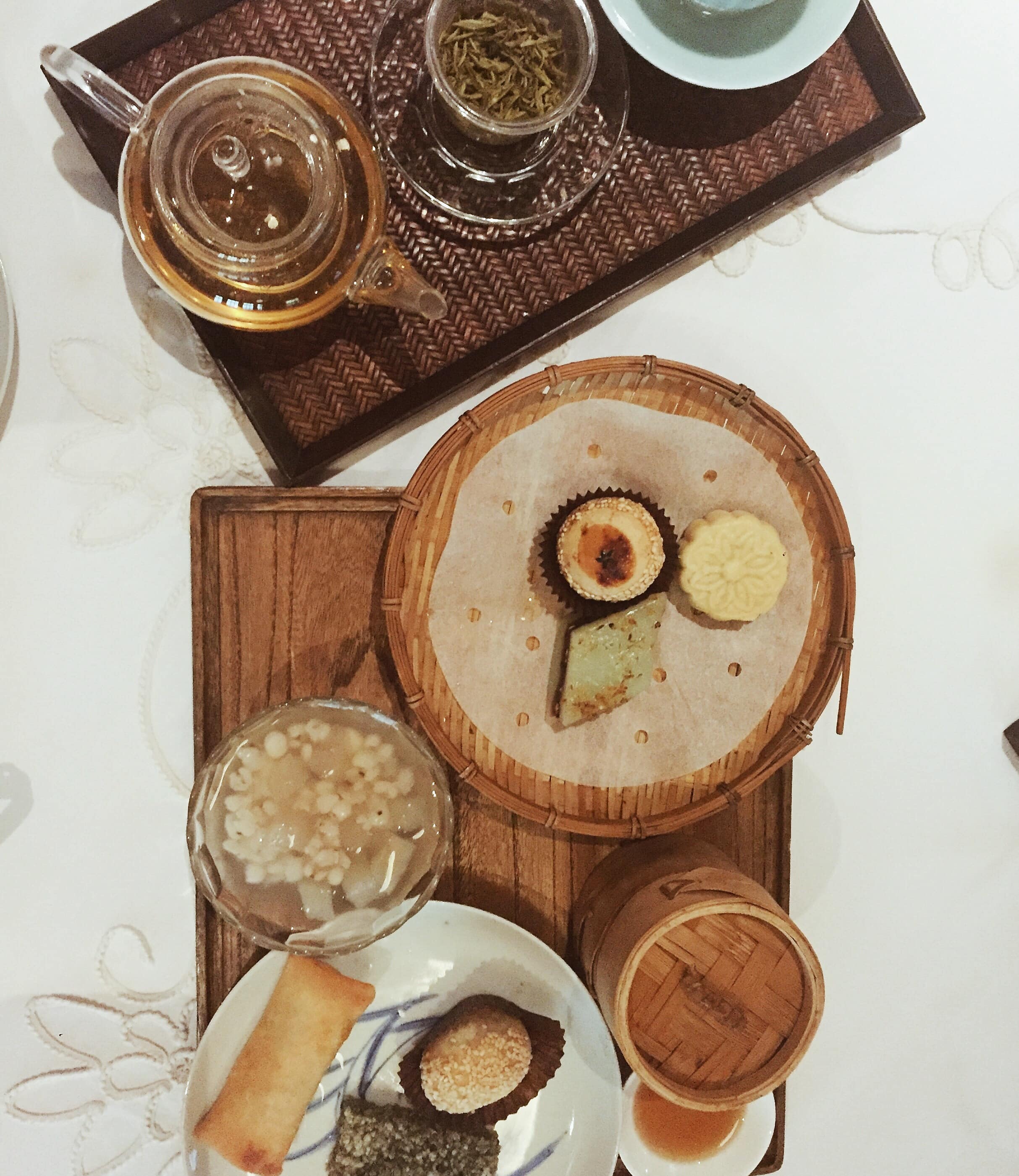
This Michelin Star restaurant itself is in the former British consulate so the setting is beautiful and shows the classic style of old Shanghai. They have both a western afternoon tea and Chinese afternoon tea. If you have time and want to experience what traditional Chinese afternoon tea is like, be sure to stop by.
Xintiandi (新天地)
Another famous and trendy area of Shanghai called Xintiandi is also located in the Former French Concession.
Unlike Tianzifang, Xintiandi has been developed into a modern and trendy shopping and dining center. The prices at most restaurants, bars and shops are rather high and this area attracts many expats as well as posh local residents.
Other noteworthy things to see in the Former French Concession include Fuxing Road, Fuxing Park, Site of the first National congress of CPC, Zhou Enlai’s former residence, Sun Yat-sen’s Former residence, Shanghai Propaganda Poster and Art Center, etc.
Other things to do in Shanghai:
As you may have noticed, I didn’t pack your last day in China with a ton of things, because I want you to have the flexibility to pick and choose what you want to do.
- Check Out Museums in Shanghai : There are a number of art museums and spaces in Shanghai, so if you are into art, you should check out China Art Museum 中华艺术宫, Shanghai Museum 上海博物馆, Museum of Contemporary Art Shanghai 上海当代艺术馆 (inside People’s Park), etc.
- Do a Food Tour : Shanghai has amazing street food and without a local, it is hard to know where to go. Even as a Chinese person, I need to do a lot of research on Chinese websites to figure out where to eat in Shanghai. Therefore, I highly recommend doing a local food tour to try some of the best dishes Shanghai is known for.
- Kids’ Activities in Shanghai : If you are traveling with kids to China, you would be delighted to know that Shanghai is a great place to take kids. You can check out Shanghai Ocean Aquarium (上海海洋水族馆), Shanghai Science and Technology Museum (上海科技馆), free swimming pool at BFC (The Bund Financial Center), Century Park (世纪公园) with boat rowing, playground, etc.
- teamLab Borderless : I am a big teamLab fan and if you can’t make it to Tokyo, you can still go to Borderless in Shanghai! This immersive digital art experience is really worth seeing at least once.
- Shanghai Disneyland Park : Disneyland needs no introduction. Again, if you are traveling with children, this is definitely a must do (unless of course, you are from Florida or California, then just go to the ones there, although definitely more expensive than the one in Shanghai).
Optional Day Trip: Zhujiajiao Old Town (朱家角) or Xitang (西塘) From Shanghai
If you have more time during your 7 day China itinerary and want to get out of the city, then you should not miss Zhujiajiao.
Zhujiajiao is a well preserved ancient water town located a little under 50 km from Shanghai and can be easily reached by bus from several locations in Shanghai.
Known as the Venice of Shanghai, Zhujiajiao is beautiful with its canals and bridges and traditional Chinese architecture. I suggest going early to avoid crowds since it’s an easy day trip from Shanghai.
You can check out this tour to visit Zhujiajiao from Shanghai.

Another beautiful water town near Shanghai that I would recommend if you have more than 7 days in China is Xitang . Xitang is where one of the Mission Impossible movies was filmed. It’s a really nice place to explore, especially at night when all the lanterns are lit.
Check out my complete guide on how to visit Xitang from Shanghai .
Where to Stay in Shanghai
Shanghai is a big city but as a first time visitor, I recommend staying in the following area:
The Bund : The Bund is perhaps the most famous and visited area in Shanghai but it is also very convenient. If you want a beautiful view of the Shanghai skyline, I recommend staying at the Fairmont if you want a luxurious experience or Les Suites Orient for a more budget friendly option.
Xintiandi : Packed with shopping, bars and restaurants, Xintiandi is a great choice for anyone really. A few places to consider: URBN Boutique Shanghai , The Langham , Andaz .
Where to Eat Soup Dumplings in Shanghai
Soup dumplings and fried pork buns are perhaps the most famous food in Shanghai. Soup dumpling, as the name implies, is a small bun with meat and soup (gelatin) steamed on bamboo steamers.
Fried pork dumplings are much bigger versions of buns with pork fillings pan fried to perfection. The best places to get soup dumplings and fried pork buns in Shanghai include Xiaoyang Shengjian, Nanxiang, Da Hu Chun , and the Taiwanese chain Din Tai Feng . All of these restaurants are marked on my Google Map above.
If you want to read more about street food in Shanghai, be sure to check out GirlEatWorld’s Shanghai blog . One restaurant she mentioned on her blog is Old Jesse , it’s a Shanghai style restaurant located in the Former French Concession. GO THERE! The food is very authentic and delicious, the location is also marked on my Google Map above.
This should conclude your 7 day China itinerary!
Best Tours to Consider For this 1 Week China Itinerary
You can totally travel through China without any tours. But if you are the type that likes things to be organized for you, then here are a few tours you can consider. Many of these are mentioned already in this itinerary, but to make things even more organized for you, here is the list:
Best Tours in Beijing
- Mutianyu Great Wall : Mutianyu is one of the best preserved sections of the Great Wall in Beijing. This tour provides transportation service, a cable car to go up to the wall, and Toboggan.
- Private Forbidden City Tour : Forbidden City is huge and it is the most important royal palace in China. There is a lot to know and see in Forbidden City, there are also many artifacts and historical gardens you should see.
- Beijing Hutong Tour : Want to see those famous historical courtyards in Beijing? Take this tour to see the Hutongs as well as Bell and Drum Tower.
- Beijing Airport Private Transfer : If you are landing late at night or just simply don’t want to navigate public transportation with large suitcases and kids, or if you have a large party, book a private transfer.
Beijing Attraction Entry Tickets
Places like Forbidden City cap the number of visitors every day, so it is essential to book tickets early. In addition, if you don’t have Alipay or WeChat pay, then you definitely want to book all the attractions before so you have less things to worry about paying.
- Forbidden City Ticket
- Temple of Heaven
- Summer Palace
- Yuanmingyuan (Old Summer Palace)
Best Xi’An Tours
- Terracotta Tour from Xi’an
- Full day Xi’an tour to see Terracotta Army, City Wall, Pagoda and Muslim Quarter
- Xi’an Muslim Quarter Food Tour
Best Shanghai Tours
- Shanghai local food tour
- One day Shanghai Highlights Tour , great for those who are short on time and just want to see the most famous sights.
- Shanghai Night River Cruise and Dinner Tour
- Zhujiajiao Water Town Half Day Tour
- Suzhou Day Trip from Shanghai
Tips On Planning A Trip To China
China is not the easiest place to visit if you don’t speak Chinese. However this shouldn’t stop you from visiting China because it is truly interesting, historical and people are friendly. The only concern you should have while visiting China is where to go in China since it’s so big and diverse.
It doesn’t matter whether you are spending 7 days or 3 weeks in China , here are a few tips to help you plan your trip:
Decide what type of things you want to see in China. Is it the Great Wall? Is it the rice terrace? Is it the mysterious Tibet? Answering this question will help you decide where to go in China and when to go.
The best time to visit China is April to May and October to mid November when the temperature is more mild and it’s not crazy humid.
The worst time to visit China is during the summer and during national holidays like May 1 Labor Day, October 1 National Day, and Lunar New Year. During these holidays the entire country is off for at least a week to 10 days, and everyone will be traveling, making things extremely crowded.
You will most likely need a tourist visa to visit China
You will not have access to Facebook, Instagram, Google, Google Map, Gmail, Snapchat , etc. To access those websites and apps you use your foreign sim card with international roaming or get a VPN.
You should bring cash with you as most restaurants and shops still only take cash (or We chat/Alipay but you don’t have that).
Write down places you want to visit in Chinese on your phone or paper so in case you get lost, people can help you find the way.
Learning some basic Chinese phrases can make locals very happy and make things easier for you. But worst case, get a translation app!
Try street food , especially those with locals waiting in line. If you only see tourists waiting, it’s probably not that good!
You might get stared at but it’s normal, people are just curious about you and they are actually friendly.
Lastly, you probably need more than 7 days in China. In fact I think you need at least 2 to 3 months in China to see the most famous places. China is HUGE and a week or two can barely scratch the surface.
For more information on how to plan your trip to China , check out my detailed blog post here, including what apps to download, etc.
Like this post? Pin this China 7 Day Itinerary to Pinterest!

Read my privacy policy .
- Kale by LyraThemes.com.

The Ultimate 2 Week China Itinerary
China is a massive country, and with only two weeks, it can be hard to know where to start when planning your China itinerary.
Many visitors stop by the main cities: Beijing, Shanghai, and maybe Xi’an, with a few opportunities to get off the beaten path and to experience the beautiful nature of China.
After five years of living in China, I’ve had plenty of experience planning itineraries and showing my friends and family around. Today I’m going to share with you the perfect two week itinerary for China.
The 2 week China itinerary I’ve put together will show you some of the best things to do in mainland China and help you explore the major sights, while also spending some time on the Tibetan Plateau.
Let’s take a look!
Hike the Great Wall
Wander the hutongs, tiananmen square, forbidden city, and jingshan park, where to stay in beijing.
- Bike the Xi'an City Wall
Explore the Huiminjie Muslim Market
Terracotta army.
- Where to stay in Xi'an
Where to stay in Jiuzhaigou
Day 9: horse trek in songpan, leshan buddha day trip, the panda reserve, where to stay in chengdu, day 13: beijing, where to stay in shanghai, getting around china, tips for visiting china, pin this to share on pinterest, 2 week china itinerary.
So, where to go in China? If you only have two weeks at your disposal, you’re going to need to be ok with missing out on a few places.
You will see the most iconic cities such as Beijing and Shanghai, as well as visit some bucket list places such as the Great Wall of China, but you’ll have to save Hong Kong and the southern provinces of China for another trip – there simply isn’t enough time.
Below is the ultimate 14 day China itinerary for those who want to get off the beaten path and see some of the best places to visit in China.
Days 1-3: Beijing
It’s not a trip to China without stopping by the capital city of Beijing.
After a solid two-years of living in Beijing, I might be a bit biased, but there are so many incredible things to do in this city.
From hiking the Great Wall of China to wandering the Forbidden City, and exploring Beijing’s hutongs, you could spend your full two-weeks here and not see everything.
I’m a bit of a Great Wall of China fanatic, and I’ve hiked NINE different sections of the wall. (Yeah, I know I’m a bit obsessed.)
If you want to see the Great Wall the right way, my biggest advice is to get off the beaten path and visit the Wild Wall , a section of the wall not officially open to tourists.
Either that, or visit a part of the great wall that is tourist-friendly, but un-restored. Check out a section like Huanghuacheng, Gubeikou, or Jinshanling.
Whatever you do, I definitely recommend skipping Badaling, the most famous and touristy section of the Great Wall.
If you want a section that’s easy to visit, take a public bus to Mutianyu instead. While you won’t have the wall all to yourself, you’ll avoid the crowds and have incredible views!
Related Reading: Things to know before you go to Beijing
I’m in love with Beijing’s hutongs, a network of traditional alleyway streets and courtyard houses that used to cover all of Beijing.
I’ve shown so many people around the hutongs that I’ve developed my own little hutong-day tour route that covers the Lama Temple, Wudaoying Hutong, the Bell and Drum Towers, and Houhai Lake.
But in my opinion, the best way to visit the hutongs is to simply get lost on your way from A to B.
I also recommend taking a tour of the hutongs to learn more about Beijing’s culture and history.
Viator, a Trip Advisor company, has a hutong and food tour.
You can’t go to Beijing without seeing the iconic Tiananmen Square with the giant Mao Portrait over the top of the entrance to the Forbidden City.
Spend about 30-minutes wandering around Tiananmen Square, then head into the Forbidden City, where you can explore for about 2 hours.
The Forbidden City is GIANT, and you could easily spend all day there, but for me and most of my family and friends, two hours is just enough to see all of the main sights without getting overwhelmed.
Once you’re finished with the Forbidden City, head to Jingshan Park, where you can catch a view of the Forbidden City (and the rest of Beijing) from above!
If you have more time, then be sure to take a trip out to see the Summer Palace for a quiet retreat from the capital.
If you don’t want to do it on your own, here are a few tour options for you. Click each link to see more details including price, availability and reviews.
- Mutianyu Great Wall and Summer Palace Private Tour
- 2-Hour Summer Palace Walking Tour
- Tian’anmen Square and Forbidden City Walking Tour
Related Reading: Things to Do in Beijing
- For sightseers, the area east of the Forbidden City is full of cheap accommodation .
- For hostels, there’s the well located YHA Peking International Youth Hostel .
- For a budget hotel, friends have enjoyed the modern Hotel Kapok , again right next to the Forbidden City.
- A couple of blocks east you come to Wangfujing where the high-end hotels are clustered.
- The Mandarin Oriental is a personal favourite, and towers over DongHuaMen night market (due to reopen n 2016). Alternatively, look for a family-run traditional courtyard hotel in the same area.
- If you’re going to be spending every night in the bars, it would be more convenient to be over by Sanlitun , where you’ll find most of the expats and backpackers hanging out in Bar Street.
Days 4-6: Xi’an
Xi’an is one of my favorite cities in all of China.
This ancient capital is a must-see on your China itinerary and is very easy to get to from Beijing. While it’s tempting to take a quick flight, I actually recommend riding the 4.5 hour high-speed train instead.
Once you factor in arriving at the airport 2 hours early, and how far the airports are from both cities (and the fact that Chinese flights are always delayed), the train ends up being both faster and cheaper than flying!
Bike the Xi’an City Wall
Biking around the ancient city wall is a must on your trip to Xi’an.
You can rent bikes at many of the main gates on the wall, but personally, I recommend starting at the South Gate.
A bike trip around the wall can take anywhere from 1-2 hours depending on how often you stop for photos. Not only will you get to explore this ancient site by bike, you’ll have a view of all of downtown Xi’an from the wall!
Once you get off the wall I definitely recommend exploring the art and caligraphy district near the South Gate.
There are so many shops and souvenirs in the area, and it’s a beautiful neighborhood to photograph.
The best time to head to the Muslim Market is just before dinner.
Eat your heart out at the many food stalls, and wander through the souvenir area to bargain for things to take home.
While you’re here, be sure to try local lamb kebabs and liangpi noodles!
You can’t go all the way to Xi’an without taking a day-trip to the Terracotta Warriors – plan time for it on your China itinerary.
This ancient army dates back to the first emperor of China, Qin Shihuang, and is China’s equivalent to the pyramids.
Here you can see row upon row of life-size terracotta warriors in giant pits.
Altogether, with the bus ride and visiting the site, you’ll want to budget your morning and afternoon for this day-trip.
See all the tour options and availability for the Terracotta Warriors her e.
If you can manage to squeeze in a day-trip to Hua Shan, then I 100% recommend it!
Take a harrowing cable car up the side of the mountain, to embark on the “world’s most dangerous” hike.
Here you can find the infamous Hua Shan plank walk , where you’ll strap yourself into a harness and walk along a plank embedded into the side of a cliff.
The view down is enough to make your heart beat out of your chest, it’s one of the craziest things to do in China, but the experience is worth it!
Where to stay in Xi’an
- The highly rated Eastern House Boutique Hotel offers oriental-style guestrooms in Xi’an downtown, around a 5-minute walk from Xi’an City Wall. See rates and availability.
- Hantang Inn Hostel Xi’an is located in the center of Xi’an. It combines Chinese and Western designs. See rates and availability.
- Located besides Tang Paradise, a 9-minute drive from Giant Wild Goose Pagoda, Gran Melia Xian offers accommodations in Xi’an, featuring private gardens, a lake and an international brand shopping mall, indoor pool and spa center. See rates and availability.
Day 7-8: Jiuzhaigou and Huanglong
Jiuzhaigou in northern Sichuan province is one of the most beautiful places I’ve ever been, and one of the best places to visit in China.
Hike all day through crystal-clear lakes and rivers that reflect the bright blue sky.
Here you’ll be able to see all the way down to the bottom of each lake, and capture photographs most people could only dream of.
The next morning head to Huanglong, which is known for its colorful calcite deposit pools. These sky-blue mushroom-cloud pools make it obvious why many Chinese people call Huanglong a “fairyland”.
- Located near the Jiuzhaigou Nature Reserve, InterContinental Resort Jiuzhai Paradise is about 35 minutes’ drive from Jiuzhaigou Valley National Park, a UNESCO World Heritage site. See rates and availability.
- Jiuzhai morning hotel is a 10 minute walk from the entrance to Jiuzhaigou. See rates and availability.
- Located in Jiuzhaigou, Rissai Valley, the more lux Ritz-Carlton Reserve features a garden, terrace, bar, and free WiFi throughout the property. See rates and availability.
If you love riding horses, you’ll definitely want to put this on your China itinerary and take a one-day horse trek on the Tibetan plateau.
The cute mountain town of Songpan, just near Jiuzhaigou, is home to day and overnight trips on horseback.
Travel with a local Tibetan guide, and explore parts of China that most tourists will never see.
Day 10-12: Chengdu
After a quick flight or a 4-6 hour bus ride down to Chengdu, you’re going to want to spend the afternoon exploring the beautiful gardens and teahouses in this scenic city.
For your first evening, I also highly recommend going for hot pot, a famous eating experience from Sichuan and Chongqing.
Don’t worry, they have non-spicy broth for those who can’t handle the heat!
When in Chengdu, you’ll need to take a trip to the Leshan Buddha, the largest carved stone Buddha in the world.
You can easily hop on a day trip from your hotel, or take one of the many tourist buses there and back.
This Buddha is definitely worth the two-hour trip to see its massive scale. I’m about the size of one of his smaller toes!
If you visit Chengdu, you definitely can’t miss the Panda Reserve, it’s one of the best things to see in China.
Be sure to head there in the morning, when the giant pandas are most active. Catch them eating bamboo, playing with one another, and sleeping in trees. Who knew little pandas love to sleep in trees?
You’ll also need to head to the baby area, where they have the youngest pandas playing with toys and rolling around.
Trust me, the Panda Reserve will definitely be a highlight of your trip. You can take a private tour here.
- Ascott Raffles City Chengdu offers luxurious apartments with free Wi-Fi throughout the property. The apartments all feature upscale amenities and some units are fully equipped kitchen. See rates and availability.
- Located along the historic Qintai Path, Chengdu Wenjun Mansion Hotel (Kuanzhai Xiangzi Branch) is decorated in a traditional Chinese style, a 5-minute walk from Tonghuimen Subway Station (Line 2). See rates and availability.
- Set in Chengdu, ideally located next to Jinjiang River, Shangri-La Chengdu offers well-equipped guest rooms with stunning city views, elegant restaurants and a luxurious ballroom. See rates and availability.
For your last day in Beijing, I recommend visiting the Temple of Heaven, my favorite imperial site in the country and one of the top China tourist attractions. You can take a guided tour here if you want to go deeper into the history of this fascinating UNESCO World Heritage site.
Afterwards, you can head over to the Pearl Market, one of my favorite bargaining markets in Beijing.
Stock up on sunglasses, electronics, silk, pearls, and a new suitcase to get all of your shopping home!
I know what you’re probably thinking. Wait… no Shanghai on this list of places to go in China?!
Personally, I’m not a huge fan of Shanghai as a tourist city.
My decision to skip it might be pretty controversial, but I honestly think there’s much more to do and see for a traveler in Beijing, than in Shanghai.
Besides, it’s always much cheaper to get a round-trip flight in and out of the same city.
However, if you really want to visit Shanghai before you leave, I have an optional Shanghai ending in this itinerary as well.
Just keep in mind, you’ll only want to head to Shanghai if you can actually sightsee on day 14, instead of using day 14 to fly home.
Day 13-14: Shanghai
If you really want to spend some time in Shanghai, make sure you have two full days at the end of your trip to China to give this mega city justice.
Of course, you’ll need to see the Bund.
You may want to stop by a few other famous sites like the Yu Yuan Gardens and surrounding area, Jing’an Temple, and the French Concession.
I also highly recommend slurping on a plate of soup dumplings while in Shanghai.
Many people say that the best soup dumpling place is just outside the Yu Yuan Gardens (you’ll find the line without even trying), but personally, I recommend going to a small local place outside of a touristy area to get an authentic experience.
Finally, if you want a great view of the city you can go up in one of Shanghai’s iconic buildings.
I’ve only been up in the JinMao Tower, but I’m dying to visit the Shanghai World Financial Center because they have a glass-bottom floor!
From either of these skyscrapers, you can see all of the surrounding city, and the world-famous Pearl Tower right next door.
Related Reading: Best things to do in Shanghai
- If you’re on a budget, I recommend the Shanghai Hidden Garden Hostel . The location in Pudong is right where everything is happening, as well as being opposite the Bund.
- On the high end, the Langham Hotel in Xintiandi is a great choice. Their service is great and they are right by all the nice shopping and dining venues.
Navigating China can feel overwhelming, but it’s pretty easy to get from place to place.
The best way to get around China is by China’s extensive high-speed train network, connecting major cities with comfort and convenience. 12Go is a good resource for ticketed travel in China.
For shorter distances within cities, you can find small local buses, or within cities, there is usually a metro. Taxis are plentiful and cheap, though the drivers rarely speak English.
Alternatively, hail a “Didi,” China’s answer to Uber.
Before you start booking attractions and hotels, here are a few things you need to know before you go…
- Get a VPN ! China is famous for having the Great Firewall over the country, which means social media apps such as Whatsapp, Facebook and Instagram are blocked, as well as most Google products – Google Maps, Google Translate, Gmail…everything. You will struggle to use the internet without a VPN.
- Get train tickets in advance . There is usually a long line for tickets at the station and when traveling between cities, good seats get booked up in advance.
- Plan to visit in April or October, these are the quieter months and have good weather.
- Be prepared for the language barrier. Have important addresses written down in Chinese characters to show taxi drivers or ask for directions.
- Carry your own essentials. Items like toilet paper, napkins, and hand sanitizer may not always be readily available, so it’s wise to have them on hand.
- Be prepared for the squatty potty.
- You can also get really cheap eSims from Airalo. You can set it up so it’s ready to go as soon as you arrive. That way you don’t have to worry about finding a local sim card. See prices and availability here.
Get your vPN with NordVPN here . It’s what we use and is fantastic for China.
Final Thoughts
Obviously, with a country as large as China, there are so many options for where you should spend your two weeks.
If you prefer nature, substitute Sichuan with a week in Yunnan and experience the Longji Rice Terraces or hike the Tiger Leaping Gorge, one of the world’s deepest gorges known for its incredible mountain views and scenes of the Yangtze River.
Or end your trip in Guilin and Yangshuo, where you can simply rent a bike and cycle through the countryside .
There are far too many incredible places to visit in China, and the unfortunate reality is that it’s impossible to see everything in a few months, let alone two weeks!
However, this China itinerary will create an incredible trip around China and is designed to give you a great introductory visit.
You’ll get a peek at China’s politics, history, culture, pandas, cuisines, and natural beauty.
You’ll explore the biggest cities, and smallest countryside towns, all while following a schedule that gives you time to appreciate each place.
Traveling to China can be daunting, and while there is no such thing as a perfect two week China Itinerary, in my opinion, this one is as close as it gets!
Related Reading: Things to know before you visit China
I hope this two-week China itinerary helps you plan your own China trip. If you have any China travel tips, please share in the comments.

One Week in China - 4 Time-Smart Itineraries
One week may be a bit short for a tour to cover China's rich history, vibrant culture, and breathtaking natural wonders. However, with our well-planned itineraries, you can cover China's highlights in around three cities at a comfortable pace.
Whether it's your first time visiting China, or a business trip concentrating on specific regions, our itineraries offer tangible inspiration. See below our suggestions for 4 time-efficient itineraries for a one-week trip through China.
Discover real reviews of Highlights Travel Family 's best-rated service across trusted platforms.
1) The Classic China 1-Week Itinerary for Families, Couples...
This is the most classic tour itinerary for one week's travel in China . Following this itinerary, you will discover the top highlights of China, including the Great Wall in Beijing, the Terracotta Army in Xi'an, and the Bund in Shanghai.
- Days 1-3: Beijing
- Days 4-5: Xian
- Days 6-7: Shanghai
Beijing : The capital of the exotic 'Middle Kingdom' is full of unique flavors. Discover the main features that China is known for around the world in Beijing.
Explore the Great Wall , and let its immensity wow your heart. Every brick could tell you a story of its history (our guide would tell you about Great Wall bricks and their inscriptions).
For a special experience, we will arrange a tour to visit the Simatai Great Wall section at night . Enjoy the enchanting scenery of the illuminated restored wall under the starry sky together.
Do you want to have an authentic experience on the original wall? We can arrange a Great Wall hike on the unrestored section from Jinshanling to Simatai.
If you are traveling as a family , you might like to take part in some interesting tai chi exercises with a master. Your kids would really enjoy it!
In Xi'an , Discover the intricate facial details of the Terracotta Warriors , and learn the history behind them. We understand that you not only want to visit the Terracotta Army but also to truly experience it. You will make a terracotta warrior of your own with a local artisan's guidance, and take it home as a souvenir. Stroll on Xi'an City Wall and immerse yourself in the atmosphere of how the city was in the Ming Dynasty (1368–1644).
Shanghai : Stroll around the Bund and discover Shanghai's interesting 20th-century history. Our guide will lead you to take a "secret" route that travelers seldom see. He will explain you vivid history of the Bund in the 1920s.
We understand you may need some free time to explore on your own. The rest of your time in Shanghai is flexible to finish the tour on an individual note: just relax, experience Chinese fashion, go shopping, visit a street market, or take a visit to one of Shanghai's impressive skyscrapers.
2). A Relaxing 1-Week China Itinerary in Beijing and Shanghai
If you want to have a more relaxing China trip using 7 days , this itinerary may be best for you. You would have the opportunity to explore the rich history, culture, and modernization of two of China's most important and influential cities at a more relaxed pace.
- Days 4-5: Shanghai
- Days 6-7: side trip to Suzhou
Beijing : Discover the main features that China is famous for around the world in Beijing. Explore the Great Wall at Mutianyu , its most authentically restored section. For a special experience, visit the Great Wall at night and view the sweeping Milky Way and the Wall by starlight.
Discover the Forbidden City where the last 24 Chinese emperors lived. We would help you avoid the crowds, and take you to visit some hidden halls. With us, you would see more features of the palace, which is the largest in the world. Discover its impressive buildings and rooftops.
Shanghai : Experience a blend of old and new in Shanghai. Stroll along the Bund and marvel at its architectural styles with a harmonious blend of East and West. Learn the interesting stories behind them.
Have a panoramic view of Shanghai's ambitious skyline from Shanghai Tower, the tallest building outside Dubai.
Check out our Best Beijing and Shanghai Itinerary : 6-day Beijing and Shanghai Tour
Side Trip to Suzhou
Take a side trip to Suzhou. Wander around the beautiful Lingering Garden .
Explore tranquil Tongli Water Town near Suzhou. Relax in a rowing boat on the canal, admire well-preserved buildings, and experience local life along the waterways.
3). 1-Week Itinerary in Bustling-Yet-Tranquil East China
If you would like to focus your travel time around Shanghai , East China, this one-week itinerary could be the best option for you. It features an enticing mix of the best bustling city life, breathtaking natural wonders, historical water towns, and serene landscapes in East China.
- Days 1-2: Shanghai
- Days 3-5: Huangshan
- Day 6: Wuzhen
- Day 7: Hangzhou
Shanghai : Visit Shanghai Urban Planning Exhibition Hall to get an overview of Shanghai's development, including its history, present, and future. Walk on the Bund to marvel at its unique architectural vista, and learn about 1920s Shanghai in the French Concession.
Huangshan : Huangshan has long been called 'the most beautiful mountain in China'. Take in its breathtaking natural scenery of imaginatively named pines, oddly shaped rocks, and seas of clouds. Don't miss a sunrise over the mountains.
Visit one of the most beautiful old villages in China — Hongcun . Enjoy a relaxing stroll in the village, and explore its old mansions, water channels, and ancestral hall. Take some memorable photos at its serenely scenic village pond.
Wuzhen : Uncover the charm of Wuzhen, a captivating water town. Discover its stone bridges, walk on the century-old pathways along the canal, and explore the traditional wooden buildings of this pretty water town. To fully appreciate the picturesque scenery and unwind in this serene environment, stay overnight there for beautifully-lit nighttime scenery and a relaxing vibe.
In Hangzhou , take a small boat on the stunning West Lake , and enjoy the breathtaking natural scenery around the lake: lush hills, ancient temples, and picturesque gardens.
Visit Meijiawu Tea Village , explore a Chinese tea farm, savor its renowned Hangzhou Dragon Well Tea (Longjing Tea), and pick some yourself. Drive uphill to wander amidst the verdant tea plantations, the very birthplace of authentic Longjing Tea.
Our best tour to explore China's East : 7-day Shanghai, Huangshan, Hangzhou and Wuzhen tour
4) 1-Week China Itinerary with Scenic Guilin
If you want to see China's natural scenery and serene rural life in your first 1-week China tour, this itinerary would be a perfect option to you.
This carefully planned itinerary will take you through China's diverse landscapes and rich history: the imperial majesty of Beijing, the breathtaking beauty of Guilin's karst mountains, and the dynamic urban life of Shanghai.
- Days 4-5: Guilin
In Beijing , visit the Great Wall at Mutianyu. See the awesome scene of the wall snaking along the mountain tops. Explore the grand Forbidden City, the largest palace complex in the world.
In Guilin, Immerse yourself in the awe-inspiring natural beauty of Guilin for two days. Enjoy a half-day Li River cruise, giving you time to relax and take in the stunning views around you. Marvel at the striking limestone peaks and take in the quaint countryside scenes, including farmers working in the fields and water buffalos grazing on the lush meadows.
Have a tranquil walk along the picturesque lakes in Guilin City. Soak in the peaceful atmosphere of this history-themed manmade parkscape with traditional Chinese bridges, pavilions, and pagodas.
In Shanghai , visit the Bund and learn about the city in the 1920s. Have a bird-eye's views of its impressive skyline and take in the vibrant cosmopolitan atmosphere of Shanghai.
How to Travel Around China
Traveling around China can be an enriching experience, with various transportation options to suit your needs. Major cities are connected by an extensive high-speed rail network that offers comfort and convenience, allowing you to traverse the country quickly and efficiently.
For longer distances, domestic flights provide time-saving connectivity.
When booking with us, let us know your travel preferences, and we will arrange the best travel routes for you, seamlessly booking the flight/train tickets you need.
Creating Your Ideal 1-Week China Itinerary
We are here to create a special tour itinerary just for you. Just tell us your ideas, and our traveler advisor will work 1:1 with you to help create your dream China trip.
Get Inspired with Some Popular Itineraries
More travel ideas and inspiration, sign up to our newsletter.
Be the first to receive exciting updates, exclusive promotions, and valuable travel tips from our team of experts.
Why China Highlights
Where can we take you today.
- Southeast Asia
- Japan, South Korea
- India, Nepal, Bhutan, and Sri lanka
- Central Asia
- Middle East
- African Safari
- Travel Agents
- Loyalty & Referral Program
- Privacy Policy
Address: Building 6, Chuangyi Business Park, 70 Qilidian Road, Guilin, Guangxi, 541004, China
China’s Golden Week Holiday: What’s Driving Outbound Travel
Peden Doma Bhutia , Skift
April 24th, 2024 at 3:30 AM EDT
Understanding what Chinese travelers want is crucial for stakeholders in the tourism industry to tailor offerings and experiences that match these changing preferences.
Peden Doma Bhutia
Destinations in the Middle East are emerging as favorites for China’s upcoming May Day holiday, commonly known as Golden Week.
Overall outbound travel from China during this year’s holiday is still lagging behind 2019 levels by 13%. But travel to the United Arab Emirates (UAE) has surged by 66%, and Turkey has experienced a significant growth of 56%, according to ticket sales data from ForwardKeys.
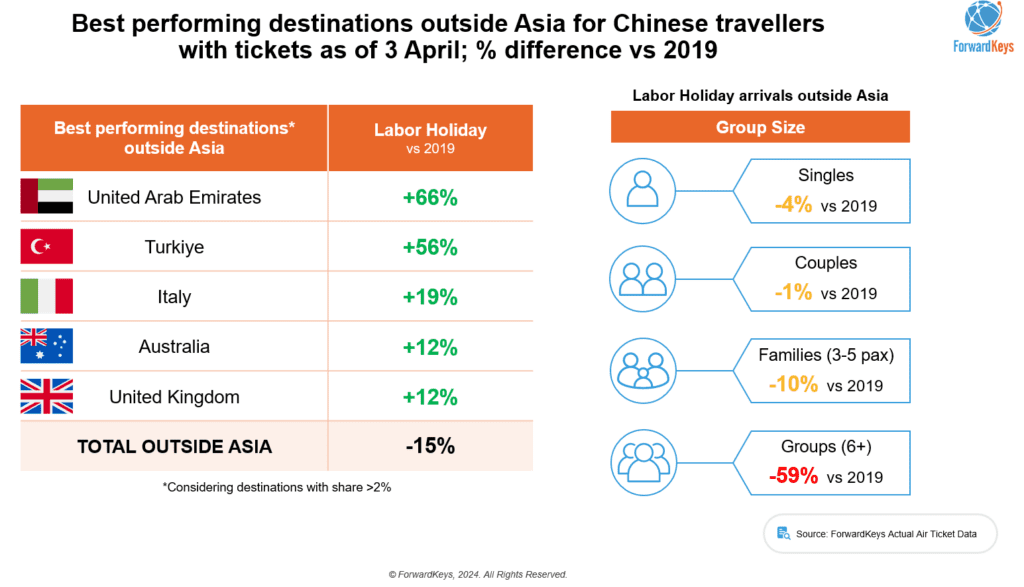
Increased seat capacity from Africa and the Middle East, which is set to expand by 75% in the second quarter, has led to this surge in travel.
Corresponding increases in seat capacity to China have backed the travel growth rates of 56% to Turkey, 19% to Italy, and 12% to the UK.
Last month, Trip.com, China’s biggest online travel agency, announced record bookings in Abu Dhabi, exceeding 57,000 room nights over the past 12 months. From 2022 to 2023, outbound travel orders across all products from Chinese travelers to the UAE surged by more than threefold.
Chinese outbound travel to Middle East had already reached pre-pandemic levels during the Chinese New Year period in February.
Pre-Pandemic Travel Patterns
ForwardKeys anticipates that the May holiday will witness notable travel peaks around April 27 and May 1, closely resembling pre-pandemic travel patterns.
In the Asian region, Malaysia has emerged as the top-performing destination for Chinese travelers, with flight bookings currently 42% ahead of 2019 levels. Because of more lenient visa policies, including visa-free travel to Malaysia and Singapore, and streamlined procedures for South Korea, travel to these destinations is expected to surpass 2019 levels in May.
These findings align with insights from Dragon Trail’s Chinese Traveler Sentiment Report , releasing later on Wednesday. According to the report, visa-free policies, direct flights, and simplified application procedures are also making outbound travel more appealing and accessible.
According to ForwardKeys, a notable shift in passenger profiles is the decrease in group travellers, which has dropped by 53% compared to 2019 levels. In contrast, solo travellers are showing a strong interest in exploring Asian destinations, with a 9% increase.
The Dragon Trail report also highlights growing preference for independent travel among Chinese tourists. Travelers also prefer, semi-self-guided travel and boutique groups of 6-10 people, which offer flexibility and convenience.
Value-Oriented Approach
Along with flexibility and convenience, Chinese travelers are also seeking relaxation and comfort in their trips.
Amidst the challenges posed by the Covid-19 pandemic and China’s economic downturn in 2023, Chinese travelers are prioritizing relaxation and comfort in their trips.
The economic pressures have led to a value-oriented approach to travel planning, with a majority carefully considering their spending to maximize value and opting for affordable travel options.
Around 20% of respondents who said they would not travel outbound in 2024 cite limited income as a barrier. Only a small percentage (11%) are willing to pay a premium for superior products and services.
Most travelers allocate less than 20% of their income for travel, with budgets typically ranging from RMB10,000 to RMB30,000 for upcoming trips.
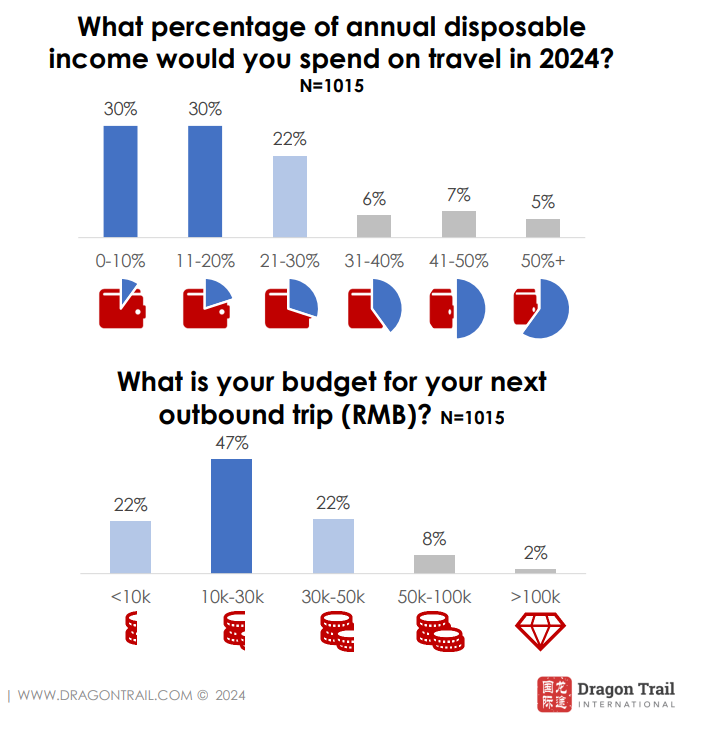
Despite budget-consciousness, shopping remains an integral part of outbound travel, with more than two-thirds of travelers spending a minimum of RMB2,000 (US$276) per trip. Local foods and souvenirs are the primary shopping categories, followed by cosmetics, clothing, shoes and bags.
The Daily Newsletter
Our daily coverage of the global travel industry. Written by editors and analysts from across Skift’s brands.
Have a confidential tip for Skift? Get in touch
Tags: asia monthly , budget travel , china , china outbound , golden week , middle east , shopping , turkey , uae
Photo credit: Overall outbound travel from China during this year's May holiday is 13% behind 2019. Florence Lo / Reuters
We've detected unusual activity from your computer network
To continue, please click the box below to let us know you're not a robot.
Why did this happen?
Please make sure your browser supports JavaScript and cookies and that you are not blocking them from loading. For more information you can review our Terms of Service and Cookie Policy .
For inquiries related to this message please contact our support team and provide the reference ID below.

IMAGES
VIDEO
COMMENTS
Hong Kong. It's a very packed one-month itinerary for China, but it is feasible. If you have more time in China, I'd also recommend the following places that I have since visited: Yunnan: Travel in Yunnan takes you through a diverse landscape that shifts from dramatic snow-capped mountains to sprawling rice terraces.
A classic China itinerary for first-timers is about 10-14 days, covering Beijing, Xi'an, and Shanghai with one more city: usually Guilin (for more varied and relaxing activity options), Zhangjiajie (exciting mountain experiences), or Chengdu (for pandas). If you want to try some off-the-beaten-path routes, you may need 3 or 4 weeks.
A backpacker's guide to China: a one-month itinerary. Tower in the market in Pingyao, an ancient city in China. Photograph: Alamy. The country's epic scale adds further adventure to this route ...
Here's some top things to know for first timers to China: Currency: The official currency of China is Renminbi (RMB) but is often referred to as Yuan (CNY). Hong Kong uses the Hong Kong Dollar and Macau's currency is called the Pataca. Currently, £1 will get you 8.81 Yuan or 9.57 Hong Kong Dollar or 9.85 Pataca.
To discover more of China, like charming Guilin and lovely Chengdu pandas, you would need a few more days. See our 11-Day Classic Wonders tour of Beijing, Xi'an, Guilin/Yangshuo, and Shanghai. See How Long to Spend in China: Itineraries from 1 Week to 1 Month. Tibet is also open again for international visitors now [March 2023].
Sample 1 Month in China Itinerary. Assuming you spend about a month in China, the following would be a good place to start building out your trip: Beijing and the Great Wall (2-4 days) Shanghai and Vicinity (2-4 days) Hong Kong and the Pearl River Delta (3-5 days) Chengdu, Chongqing and Sichuan (5-7 days)
Are you looking for a suitable China travel itinerary, which matches your vacation time? Here, we offer the top 10 China travel itineraries including lengths of 1 week, 10 days, 2 weeks, 3 weeks, and more. Read on to find which is best for you. 1. 1-Week in China (Beijing-Xi'an-Shanghai) Spending 1 week in China has a basic itinerary.
China is a land of contrasts, where ancient traditions coexist with modern developments. Its cities are bustling metropolises, while its countryside is dotted with picturesque villages and breathtaking natural landscapes. With a rich cultural heritage and a wide variety of things to see and do, China is a destination that offers something for everyone.
One month backpacking china itinerary. Week 1 - Guilin, China. Week 2 - Longji, Xingping, and Yangshou. Week 3 - Hunan/Yunnan or Xian. Week 4 - Beijing. Let me know in the comments: Guilin was one of my favourite spots while I was backpacking China. But first FAQs,
A one-month itinerary for China, starting in Hong Kong and ending in Kunming, and covering destinations like Beijing, Xi'an, Huashan and Zhangjiajie National Park. ... The summer months fall in rain season, and it can get too hot to travel around. In the winter months, it will get extremely cold in the north. It is absolutely not recommended to ...
This article highlights must-visit destinations in China for a one-month travel itinerary, including Beijing, Shanghai, Xi'an, and Guilin. Blog; Contact; English. Deutsch; The Ultimate China Travel Itinerary: Explore the Best of China in One Month! August 12, 2023 | In china, china | By Max.
The south west: Yunnan (2 to 3 weeks) The wild west: Qinghai & Xinjiang (3 weeks) The Great Wall: East to west (3 weeks to one month) The classic: Hong Kong to Beijing (2 to 3 weeks) Central China: The Yellow River (3 weeks) 1. The south-west: Yunnan. Jade Spring Park, Lijiang, Yunnan province, China (Shutterstock)
The good news is that even in China's big cities, it's possible to get by on a budget of $40-50 a day. Public transport is cheap (around $0.50 to $2 for bus and subway tickets), and you can easily find a bed in a dorm for $10-15. Street food is delicious and cheap in China. Photo: Sasha Savinov.
A 4-Week China Itinerary Days 1 to 21: Same as above. Follow the 3-Week itinerary for the first part of your month in China. Hong Kong (Days 22-25) Hong Kong needs no introduction - it's a massive, globalized city that one could spend a lifetime in and not finish exploring it. Hong Kong feels very different from the rest of China due to its ...
China is a huge country and you need at least one month to experience the main sights from it. I mostly travelled by train, that is the fastest and cheapest way to move around in long distances. I flew in into Shanghai and flew out from Hong Kong. I payed 90 USD in a low cost flight from Osaka (Japan) to Shanghai (China) with Spring Airlines ...
Longmen Grottoes, Luoyang. Day 1: Arrive in Beijing - Airport to hotel transfer. Day 2: Beijing - Tiananmen Square, Forbidden City, Jingshan Park, Hutong Tour. Day 3: Beijing - Temple of Heaven, Mutianyu Great Wall, Peking Duck for dinner. Day 4: Beijing - Summer Palace, Lama Temple, and Confucius Temple.
Peter Adams / Getty Images. This is a ten-day itinerary that takes visitors to China to the main "big five" sights that are on every first-time traveler's list. You'll see Beijing (the Forbidden City and the Great Wall), then on to Xi'an (the Terracotta Warriors). You'll then move on to the Yangtze River for the Three Gorges Dam cruise and wind ...
A classic China itinerary for first-timers is about 10-14 days. If you want to try some off-the-beaten-path routes, you may need 3 or 4 weeks. If you have limited time, 7 to 9 days is ok..
1. 1 week - Shanghai and Beijing. The Forbidden City in Beijing. For people on a tight, 1 week schedule, the best way to enjoy China is to stay in the two largest cities: Shanghai and Beijing. For Shanghai, the best schedule is to follow the 2-month itinerary plan for day 1 and day 2. On day 3 in Shanghai, however, the best bet is to get out of ...
Itinerary: Day 1: Arrive in Chengdu and tour the city center; Day 2: Visit the Chengdu Panda Research Base of Giant Panda Breeding and get to Mount Emei, or Emei Shan, by bus; Day 3: Climb Emei Shan with an overnight stay in one of the many monasteries that can be found along the way;
Itinerary #1: China's Ancient Capitals & River Cruise. Not only does this two-week itinerary include visits to China's historic capital cities of Beijing, Zhengzhou, Luoyang, & Xi'an, but you'll also take a stroll along the Great Wall and round out the trip with a cruise down the Yangtze River. Enjoy a cruise down the Yangtze.
In this China itinerary I am not including Hong Kong or Macau since they alone will need at least 3-4 days and worth a trip alone for that region. This one week China itinerary will be structured like this: - 3 Days in Beijing. - 2 or 3 days in Shanghai. - 1 or 2 additional days in Xi'An or day trips from Shanghai.
2 Week China Itinerary. Days 1-3: Beijing. Hike the Great Wall. Wander the Hutongs. Tiananmen Square, Forbidden City, and Jingshan Park. Where to stay in Beijing. Days 4-6: Xi'an. Bike the Xi'an ...
This is the most classic tour itinerary for one week's travel in China. Following this itinerary, you will discover the top highlights of China, including the Great Wall in Beijing, the Terracotta Army in Xi'an, and the Bund in Shanghai. Days 1-3: Beijing. Days 4-5: Xian. Days 6-7: Shanghai.
Peden Doma Bhutia. Destinations in the Middle East are emerging as favorites for China's upcoming May Day holiday, commonly known as Golden Week. Overall outbound travel from China during this ...
Similarly, Craft Travel has organized a busy, 15-day itinerary for a family of four, including two teenagers, from New York. Among the exclusive experiences is a private concert at the Palais ...
Its passenger traffic increased 36.1%. China Eastern Airlines Corp.'s passenger traffic rose 55.9%. Although those year-on-year growth rates are slower than in February, that's not surprising ...